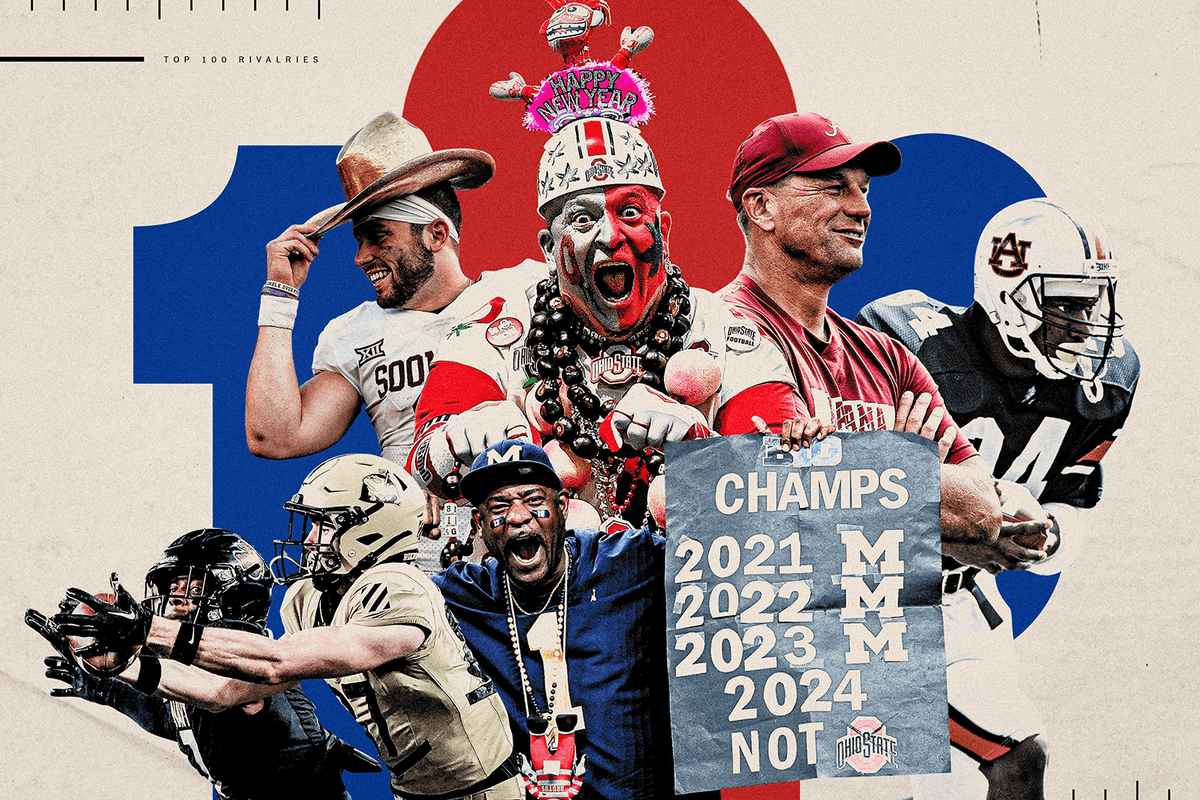To understand what a college football rivalry means, walk into any bustling office building in Birmingham, Salt Lake City or Des Moines the Monday after the Iron Bowl, Holy War or Cy-Hawk. You’ll find half the employees smiling and gloating. The other half are miserable and evasive.
Before kickoff, rivalries bring families, friends and colleagues closer together. The outcome instantly divides those same people. In each of those communities — and thousands like it across the country — emotions swirl around rivalry games. But if passion is comparable for in-state rivalries, how can one differentiate among them?
That’s what I attempted to do below in ranking college football’s top 100 rivalries. I peeled back the layers of reputation and examined each one’s attributes, then compared them with objective measurements and the help of input from my colleagues at The Athletic. A few choices are perhaps controversial, but this list is a snapshot taken with a wide lens, not a selfie-stick at a tailgate. Several quality rivalries didn’t make the top 100, and I’ll break those down later Monday along with deeper rationale behind the rankings.
So, take a gander at the list below, and remember that rivalries are fun. Which one was too low? Which was too high? Which one should have made the list and why? Let’s have a debate. But in the process, hopefully we can all agree that the only thing worse than losing to a rival is not playing them.
Click each rivalry below to expand for more information. What do you think are the best rivalries? Vote here.

Loading
Try changing or resetting your filters to see more.
What to know: The longevity of this SEC series merits inclusion despite its lopsided nature. LSU has played Mississippi State more than any other opponent, and the series ranks second for the Bulldogs behind the Egg Bowl.
- From 1926-2023, the teams faced off every season but one (1943), which was canceled amid World War II.
- From 1934-81, the teams played 39 of their 47 games, including 23 straight, in Baton Rouge and eight times in Jackson, Miss. In 1982, the teams’ first game in Starkville since 1923, Mississippi State upset unbeaten LSU 27-24.
- Despite the longevity, they cycled off one another’s schedule in 2024 when the SEC expanded and eliminated divisions.
Biggest game: Top-ranked LSU stood two wins from an undefeated 1958 campaign as it faced lowly Mississippi State in Jackson. It was the first time in 25 years the teams played outside of Baton Rouge, and for most of the game the Tigers failed to match the Bulldogs’ home-state energy. Both teams scored one touchdown, but LSU hit its extra point to win 7-6 as it inched toward its first national title.
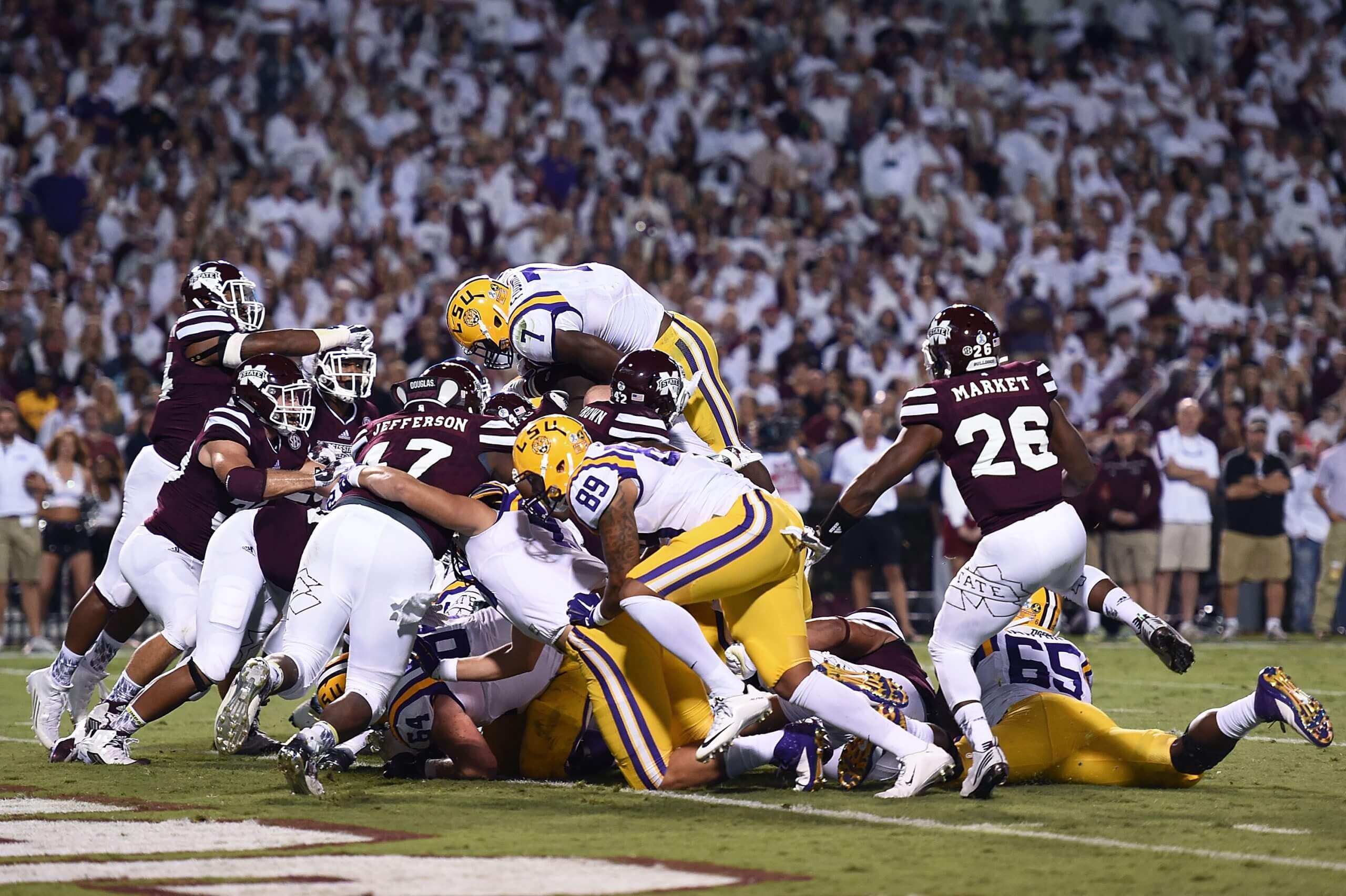

What to know: WKU-MTSU has lasted through three conferences and several years of independent status to become Conference USA’s most-played series. The teams consider one another their top rival, with the series unofficially known as “100 Miles of Hate.”
- WKU’s first game against a college opponent came against the Blue Raiders, who won 47-0. Although MTSU played football starting in 1911, the Hilltoppers are their only foe still playing D-I football from its first four seasons.
- The teams were longtime members of the Ohio Valley Conference and moved to FBS at different times (MTSU in 1999, WKU in 2007). They resumed their series in 2007 and have played every year but 2013.
- Four times from 2010-17, the games went into OT, and twice they became triple-OT thrillers.
Biggest game: WKU and MTSU battled into a second OT in 2016. Both teams scored TDs, but the Hilltoppers blocked the Raiders’ PAT attempt to pull out a 44-43 win. The win propelled WKU to a division title, the Conference USA championship and an 11-3 season.
Photo:
Shaban Athuman/Getty
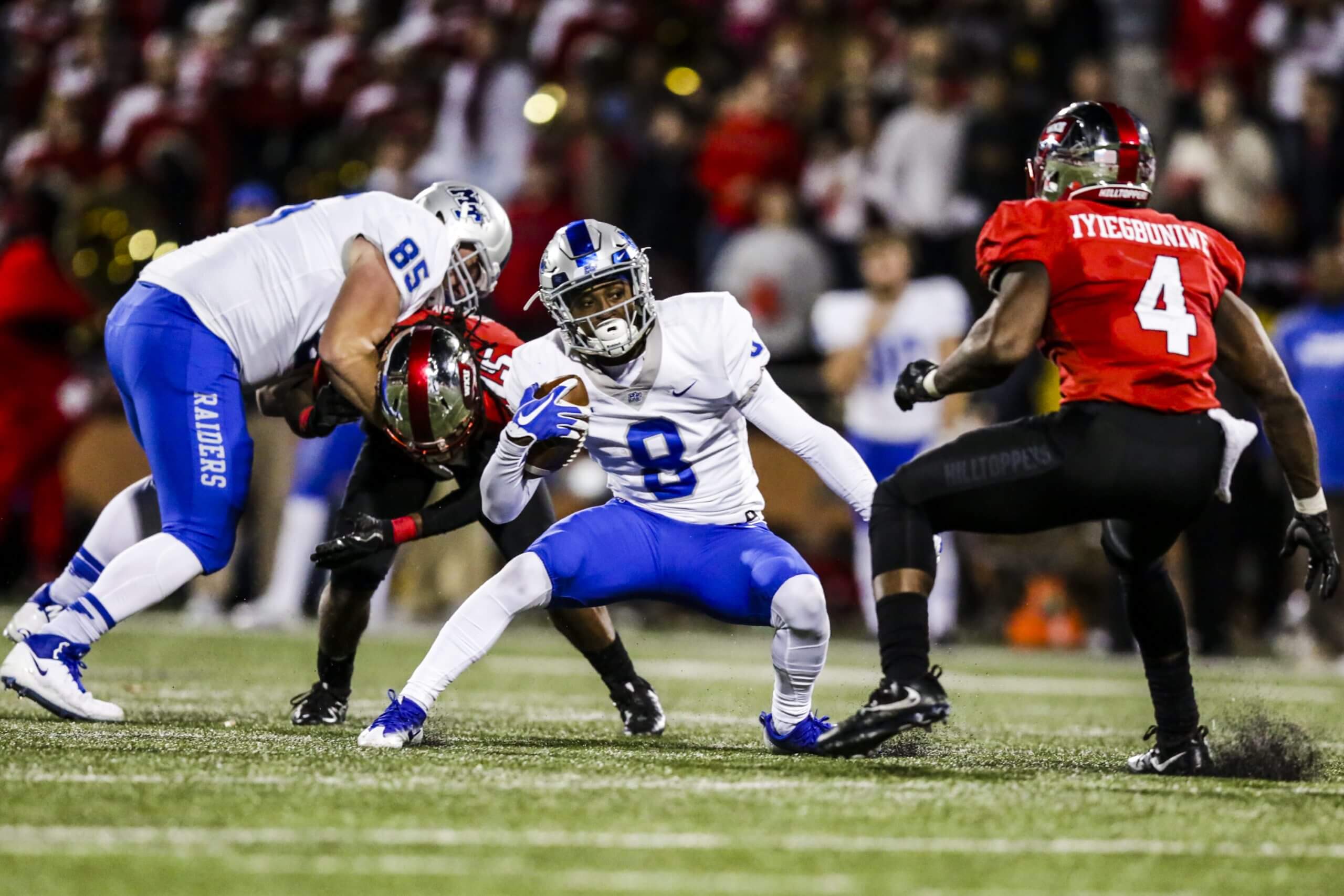

What to know: In one of the newer series spawned by realignment, the schools have completed the regular season against one another every year on Black Friday, save for 2020. It became an established annual SEC series in 2014.
- Despite their proximity (313 miles), they played only five times before Missouri left the Big 12 for the SEC in 2012. Arkansas played in the Southwest Conference until 1992.
- In 2015, the schools added the Battle Line Trophy, which has roots in previously disputed borders between the states. The trophy weighs 180 pounds.
- Missouri has dominated the series in recent years, winning eight of the past nine.
Biggest game: In their inaugural SEC matchup in 2014, Missouri needed to beat Arkansas to claim its second straight SEC East crown. Trailing 14-6 entering the fourth quarter, the Tigers outscored the Razorbacks 15-0 in the final period, capped by running back Marcus Murphy’s 12-yard run for the 21-14 win.
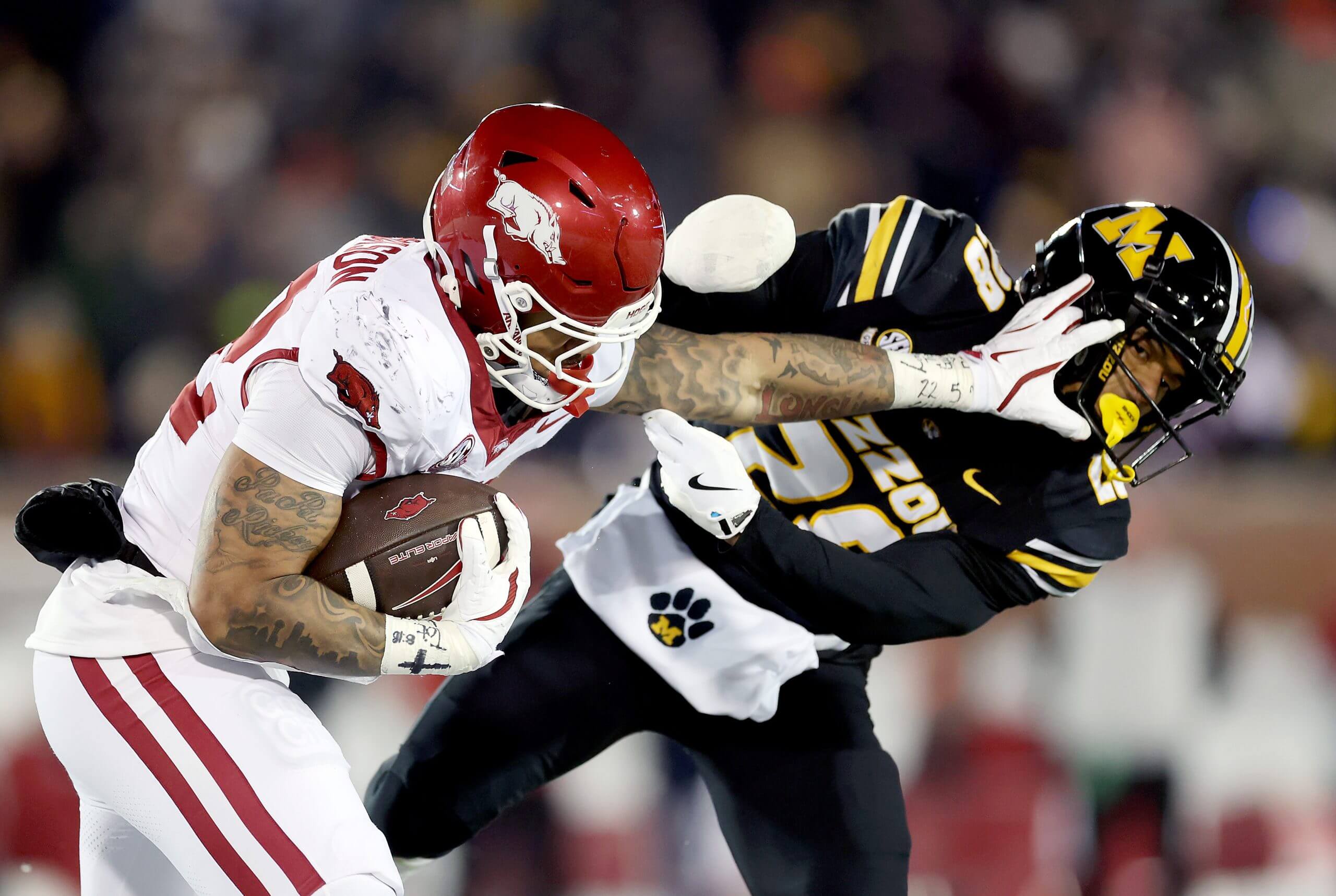

What to know: UCF and USF have engaged in several high-profile battles in a relatively short period of time. Although they’re no longer annual opponents, “The War on I-4” feels like it has another era ahead of it.
- The programs are FBS newcomers with UCF moving up in 1996 while USF started a team in 1997 and shifted to FBS in 2000.
- USF joined the Big East in 2005, and in January 2011, it was accused of blocking UCF’s entry into the same league. Later that year, following multiple Big East exits, UCF joined USF in what became the AAC.
- The teams ended their regular seasons against one another every year from 2013-22, with seven of those games coming on Black Friday and another on Thanksgiving.
Biggest game: With the AAC East title and a New Year’s Six bowl bid at stake, No. 13 UCF and No. 22 USF met on Black Friday in 2017 and waged one of the most exciting games this century. In a 53-second span in the final three minutes, the teams combined for three TDs, including a 83-yard pass followed immediately by a 95-yard kick return. UCF forced a late fumble, won 49-42 and finished 13-0.
Photo:
Al Messerschmidt/Getty
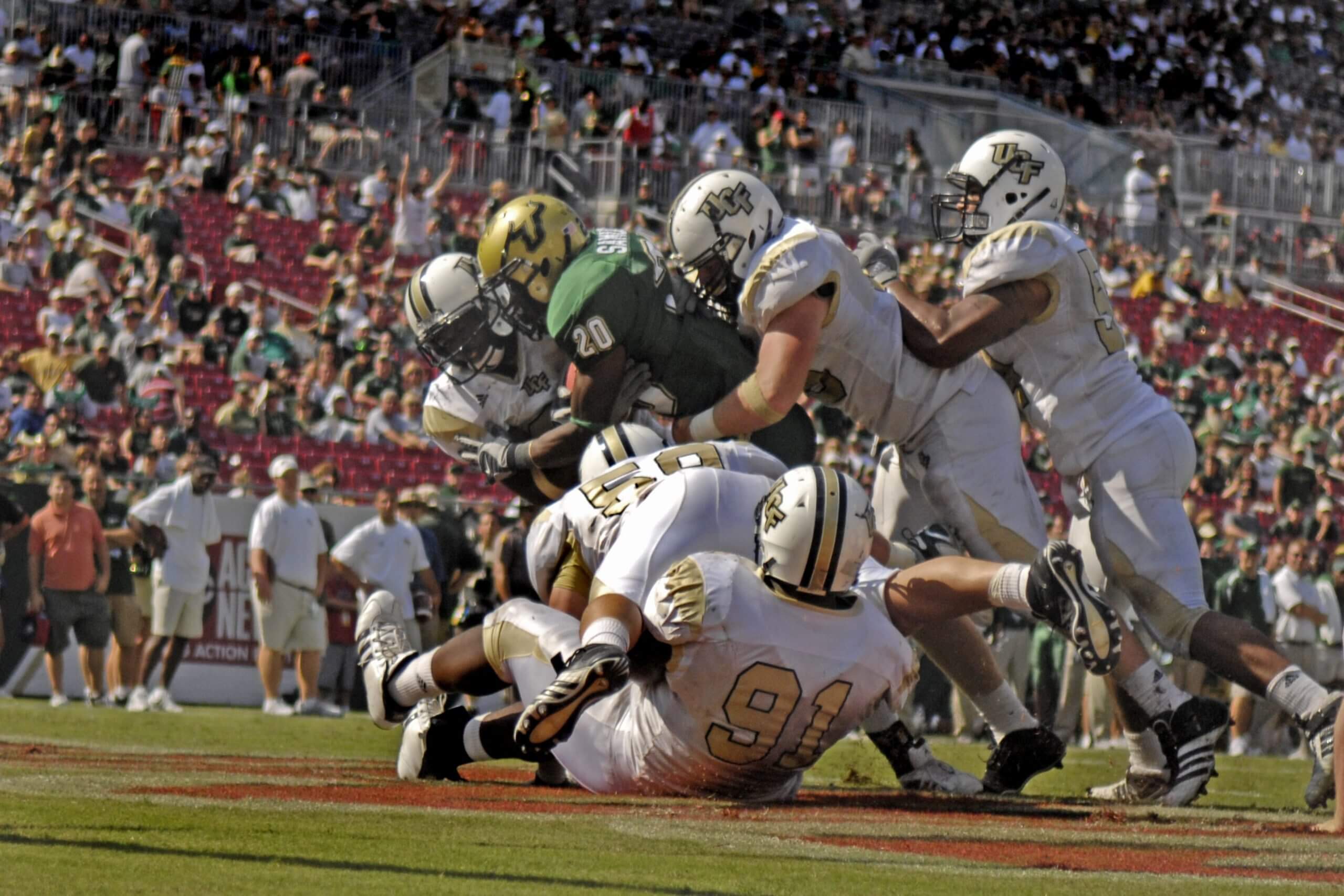

What to know: Like all in-state rivalries, this one has its share of heated moments. The wildest came in 2023 when then-NMSU quarterback Diego Pavia appeared in an offseason video urinating on New Mexico’s logo in its indoor practice field. Later that year, the Aggies qualified for the New Mexico Bowl, held at the Lobos’ stadium. The host school allegedly tried to keep the Aggies away from their practice facilities in the bowl’s buildup, leading to scathing responses from then-NMSU coach Jerry Kill.
- The schools have two nicknames for their series. New Mexico labels it the “Rio Grande Rivalry,” while New Mexico State calls it the “Battle of I-25.”
- The teams competed six times as a territorial rivalry; New Mexico didn’t become a state until 1912
- Although the teams have played annually since World War II (except in 2020), they have not competed in the same conference since 1950.
Biggest game: New Mexico’s 6-2 victory against New Mexico State in 1938 not only handed the Aggies their only Border Conference loss, but it caused a conference vote for its Sun Bowl representative. The Aggies (4-1) had one fewer conference loss than the Lobos (4-2), but the league’s other schools voted for New Mexico because of its head-to-head victory.
Photo:
Marc Piscotty/Getty
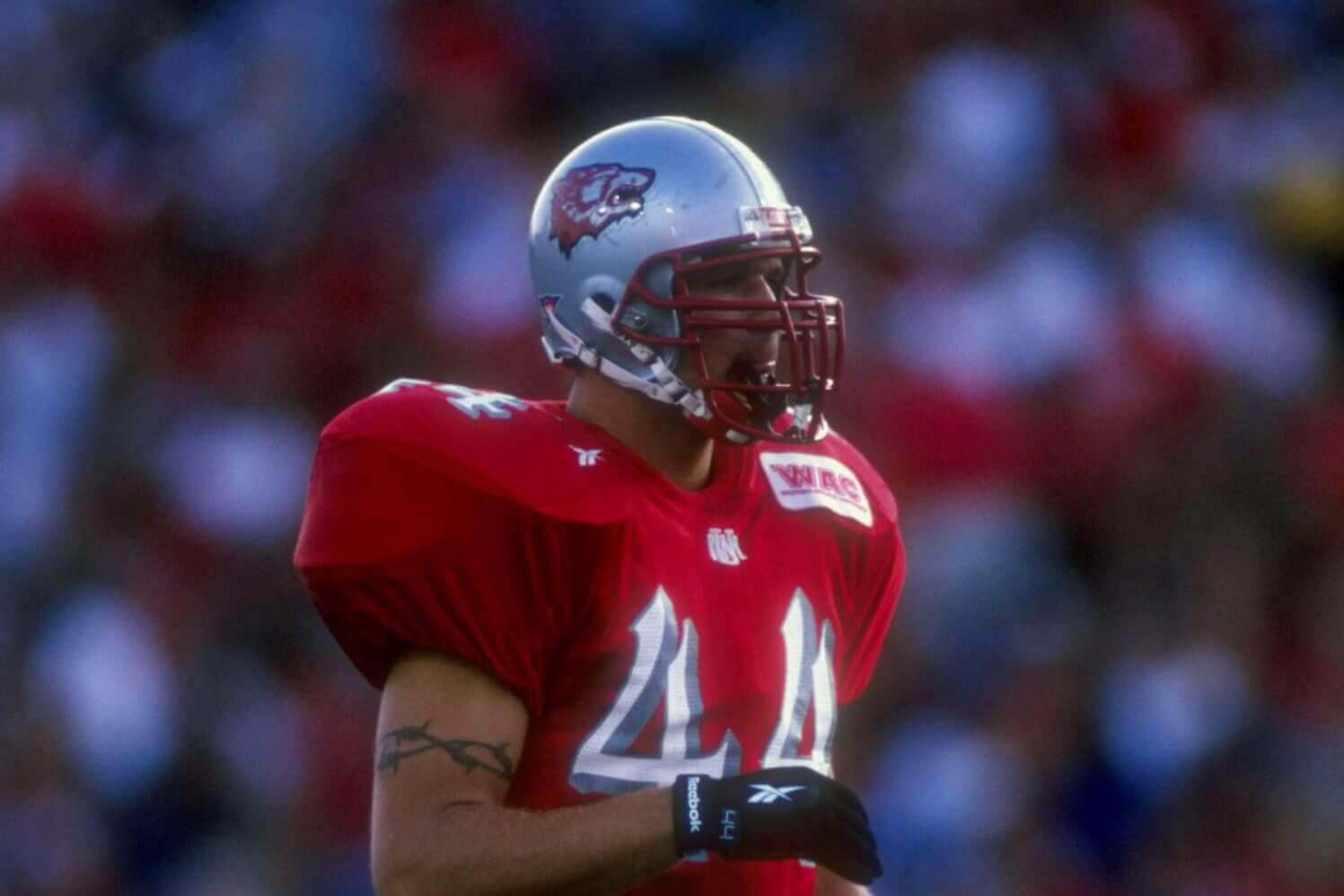

What to know: The Virginia-based FCS foes compete in “The Capital Cup.” With 135 meetings, it ranks No. 4 among Division I series in total games.
- Also known as “The Oldest Rivalry in the South,” the series is more accurately described as the South’s most-played rivalry. They played 21 times between 1905 and 1917.
- They have played every season but 1943 since 1902.
- The programs will compete as nonconference foes this fall with Richmond joining the Patriot League while William & Mary stays in the CAA. The Tribe will join the Patriot League in 2026.
Biggest game: With an FCS playoff bid at stake in 2008, No. 6 Richmond led 20-0 at halftime. Despite throwing six INTs, William & Mary rallied with 17 fourth-quarter points to force OT. The Tribe had their field-goal attempt blocked, while the Spiders hit their 37-yarder for a 23-20 win. Richmond went on to win the FCS national title.
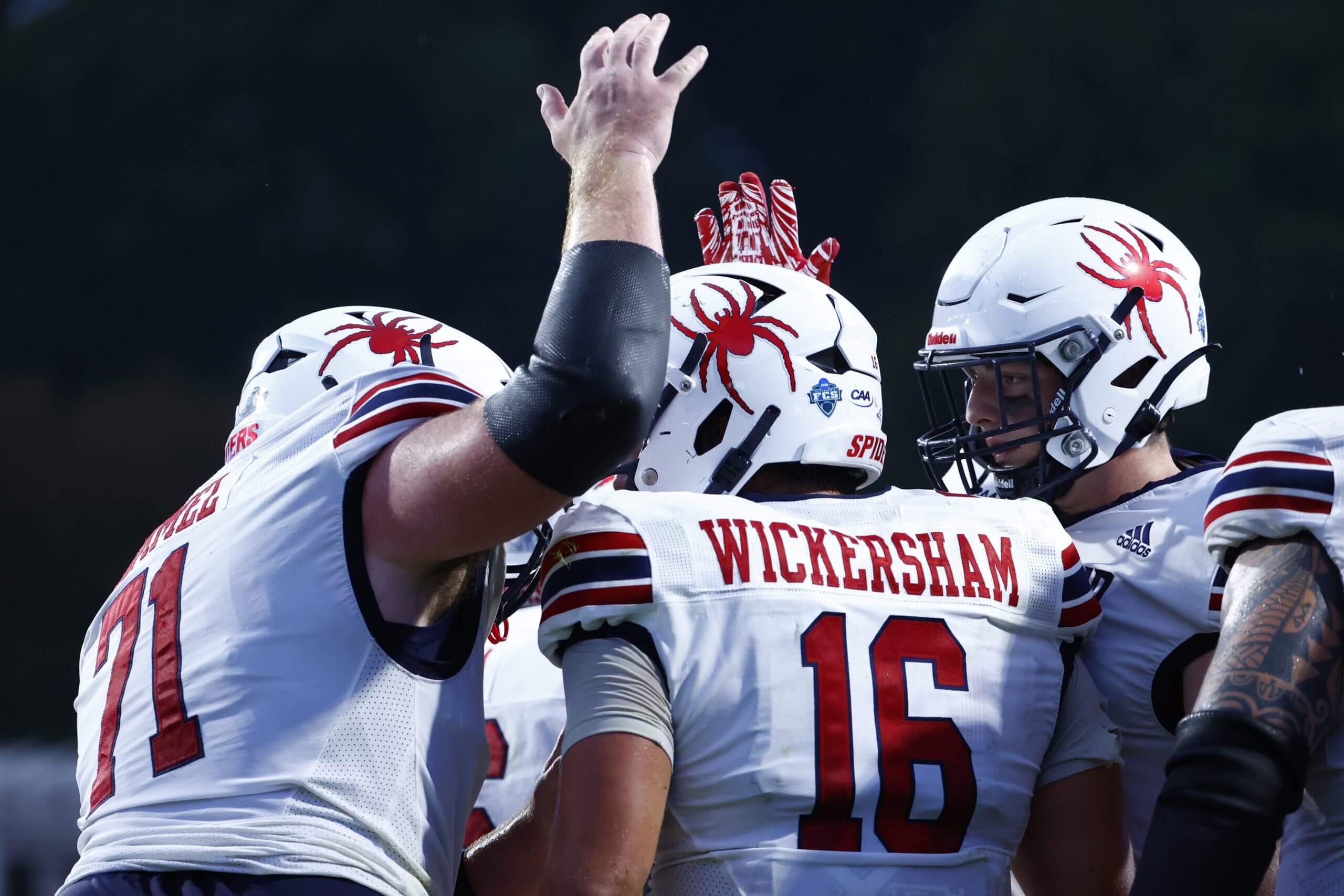

What to know: The conference debuted in 1947 with four teams: Cincinnati, Case Western, Butler Reserve and Ohio. By 1955, only Ohio remained and it was joined by Bowling Green, Kent State, Toledo, Western Michigan, Miami (OH) and Marshall. A major expansion in 1975 provided the backbone of what the MAC is today. It’s impossible to rank one MAC rivalry above another, but collectively they are worthy of special mention because of the similarities between schools and the parity in the conference.
- Five of the eight most-played Group of 5 rivalries belong to MAC teams. Eastern Michigan-Central Michigan (102) and Ohio-Miami (OH) (100) have the most meetings.
- Some of the greatest coaches have led MAC programs, but there were few overlaps. Bowling Green’s Don Nehlen (a Hall of Fame coach at West Virginia) was the exception. He faced Miami’s Bo Schembechler once, Kent State’s Don James four times and Central Michigan coach (and future SEC commissioner) Roy Kramer twice. Nick Saban, Urban Meyer and Brian Kelly all coached in the MAC later but never at the same time.
- Among the series with more than 80 contests, the closest is Bowling Green-Toledo, which is 43-42-4 in favor of the Falcons. The schools are just 30 miles apart.
Biggest game: No game has defined MACtion like Toledo’s 66-63 win against Western Michigan on a Tuesday in 2011. The teams, who have 79 career matchups, combined for MAC records in total yards (1,439) and points in a non-OT contest (129). Each side scored at least one TD in each quarter and combined for 18 TDs, which also was a high for a non-OT contest.
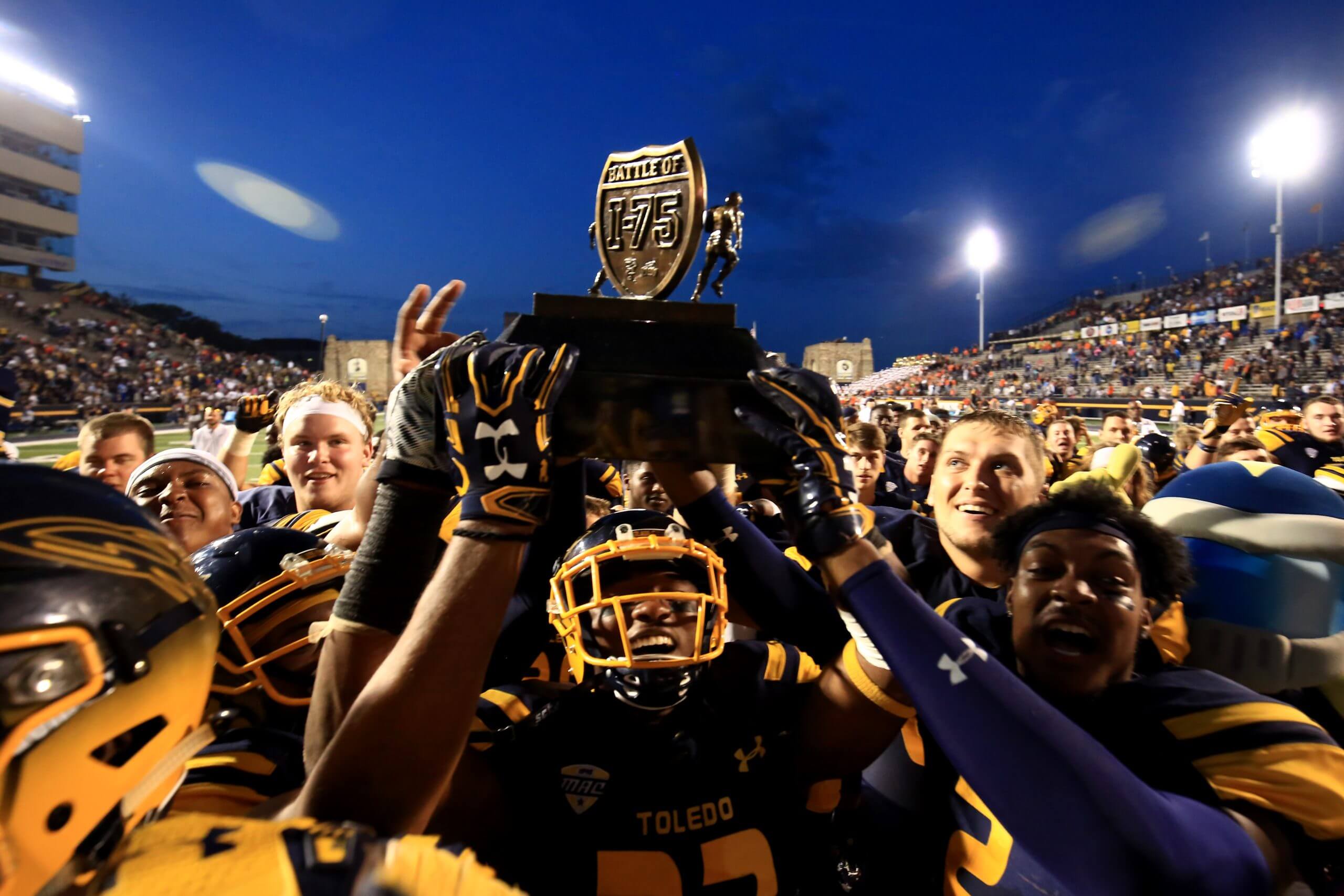

What to know: Amherst was founded by a Williams professor who brought (or stole, depending on your perspective) some materials and faculty with him in 1821. The schools transitioned their feud to the football field 63 years later.
- These New England squads have combined for 139 meetings, ranking No. 4 in NCAA history and the most in Division III.
- In “The Biggest Little Game in America,” the rivals met twice a season from 1884-86 before settling into an annual series. Williams and Amherst have missed playing just six years since 1884 (1902-03, 1943-45, 2020).
- In 2007, Williams’ campus hosted ESPN’s “College GameDay,” a first for Division III.
Biggest game: In 2001, both teams entered their meeting 7-0 for the first time. Amherst led by 10 points in the second half, but Williams rallied to force OT. After an Amherst field goal, Williams fullback Tyler Shea burst in from the 1-yard line to secure a 23-20 victory.
Photo:
Frank Ward/Amherst College
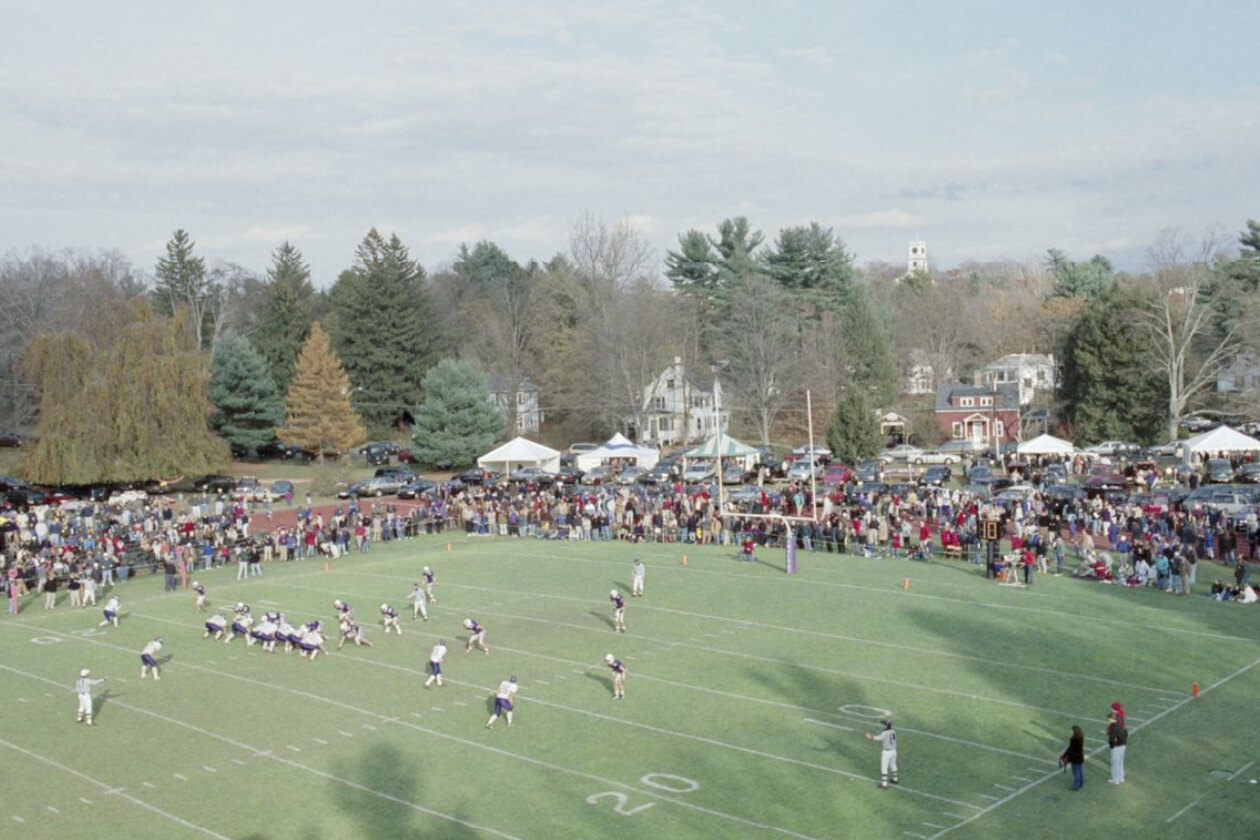

What to know: This series ranks second in ACC games played when matching teams from different states. They played 27 times before becoming ACC charter members in 1953.
- NC State-Clemson is known as the “Textile Bowl,” with both universities known for offering a world-class textile education.
- They have played annually since 1971, save for 2020. It no longer is a protected series, however, and it rotates off the schedule beginning this fall.
- NC State and Clemson have met six times as ranked opponents, including three times in the past seven. Clemson won all three of those meetings.
Biggest game: In a battle that decided the ACC Atlantic, No. 6 Clemson outlasted No. 20 NC State 38-31 in 2017. The Wolfpack led at halftime before the Tigers twice built 10-point second-half leads. In the final two minutes, NC State drove to the Clemson 28 before a fourth-down INT.
Photo:
Streeter Lecka/Getty
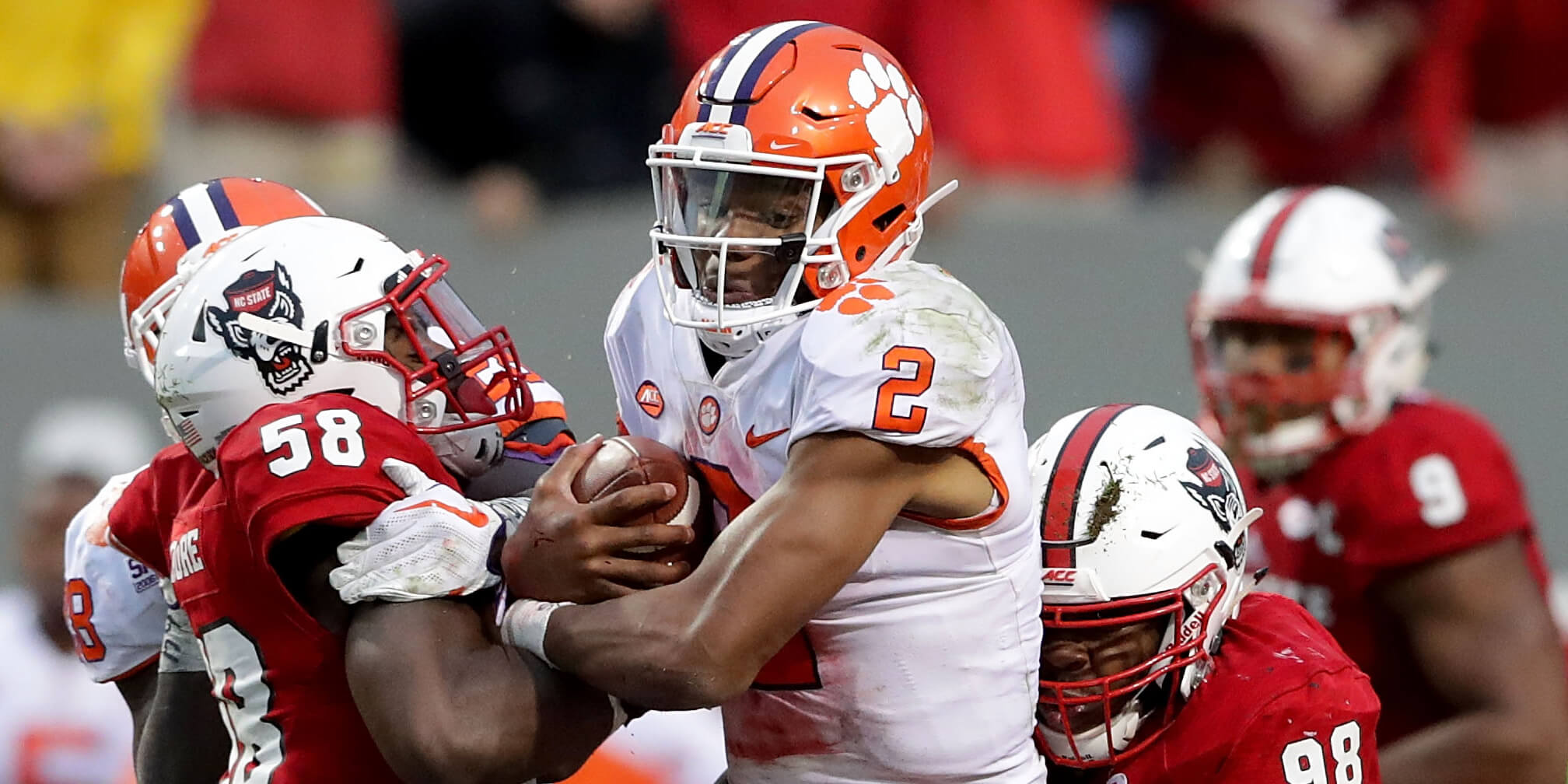

What to know: Although others are joining the ranks, this is the only long-term rivalry pitting one team in a power conference against a rival from a mid-major league. It has become feisty in recent years and has a history of high-level competitions.
- In what is known as the “Rocky Mountain Showdown,” Colorado and Colorado State first faced off on a February Saturday before it became a regular rivalry. It is Colorado’s most-played series and ranks second for Colorado State.
- The rivalry took a hiatus from 1959 (a 15-14 Colorado State win) until 1983 after Oklahoma State joined Colorado in the Big Eight.
- The teams mostly competed at the Denver Broncos’ home stadium from 2001-19. When the series restarted in 2023, it shifted to campuses. The Rams haven’t beaten the Buffaloes in Fort Collins since 1955.
Biggest game: Every year from 1989-2003, at least one team was ranked entering their matchup. But the sizzle from their late-night 2023 double-OT battle boasted more than 9 million television viewers. Colorado QB Shedeur Sanders’ 45-yard TD pass with 36 seconds forced OT. After both teams scored in the first OT, Sanders fired his fourth TD pass and a 2-pointer to give the Buffaloes a 43-35 lead that held up after a defensive stand.
Photo:
Michael Madrid/Imagn
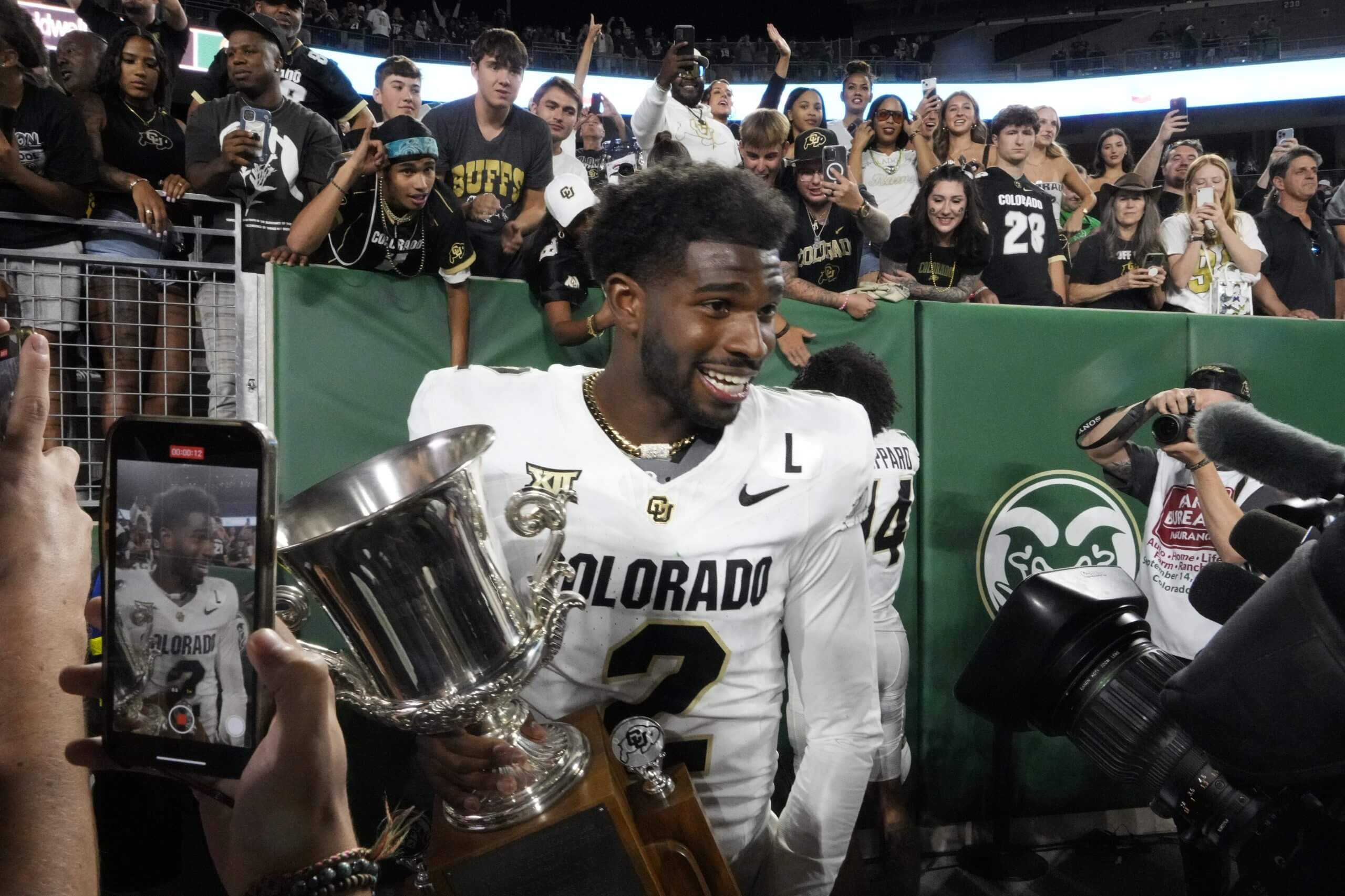

What to know: Historical frequency and proximity form the backbone of most rivalries, especially in lower-division football. This one exists solely on prominence. Over an 11-year period from 2005-15, the teams met nine times for the Division III national championship and once in a semifinal.
- All their championship battles took place in Salem, Va. Mount Union’s Larry Kehres won 11 Division III titles and finished 332-24-3 after 27 years at his alma mater and claimed three head-to-head titles. Whitewater’s Lance Leipold, now at Kansas, won six of those battles. Leipold was 109-6 in eight seasons.
- Only three of the nine title-game battles had a one-score margin of victory. Five of them came by double digits.
- The teams met only twice in the regular season in 2002-03.
Biggest game: Although selecting the most important game among nine championships is semi-futile, 2011 had legacy ramifications. Whitewater was going for its third straight title, all of which came at Mount Union’s expense. The game’s most important play came midway through the third quarter when Whitewater recovered a fumble on a sack at the 1-yard line. Whitewater punched in its only TD on the next play and held on 13-10.
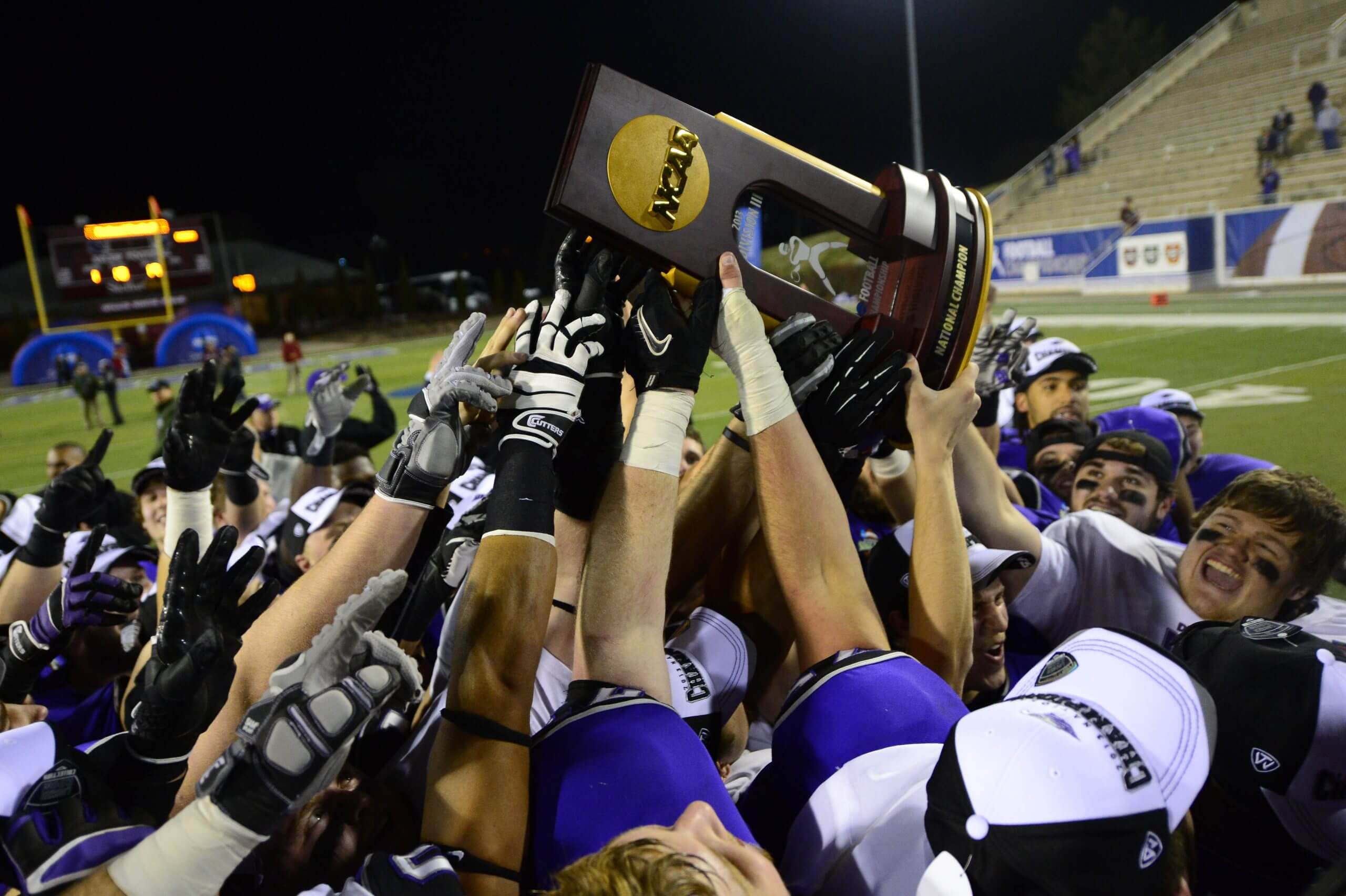

What to know: Separated by just 130 miles, Maryland and Virginia had a strong all-sports rivalry in the ACC and still recruit heavily against one another. The Cavaliers remain Maryland’s most-played opponent and the Terrapins rank third for Virginia.
- The border rivals helped form the ACC in 1953 (Maryland as a charter member, Virginia joined six months later) and played annually from 1957 until the Terps left for the Big Ten in 2014.
- Virginia and Maryland concluded ACC play against one another 28 times, including twice on Black Friday in 1985-86.
- Each school had a hand in thwarting Florida State’s early ACC dominance. In 1995, the Cavaliers handed the Noles their first ACC loss after 29 consecutive wins. After FSU claimed at least a share of an ACC title in its first nine seasons, Maryland won the title outright in 2001.
Biggest game: With a share of the ACC title at stake for Virginia, the Cavaliers (9-4) rallied from an 11-point deficit to win at Maryland 21-18 in 1995. Maryland blocked a punt late, which pulled the Terps within three points, but Virginia RB Tiki Barber ran out the clock to clinch the win. The loss kept the Terps from the postseason despite a 6-5 record.
Photo:
Ryan M. Kelly/Getty
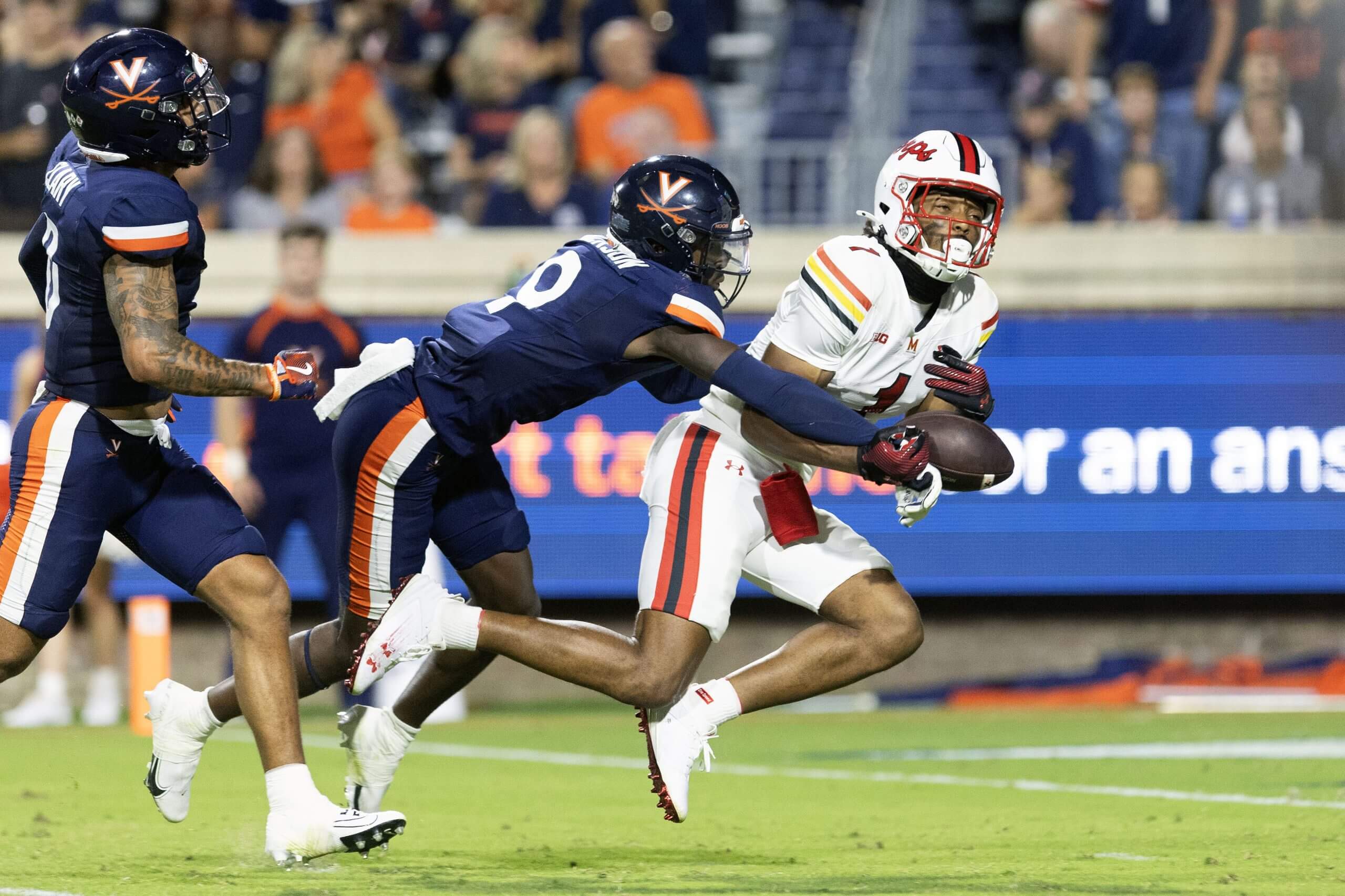

What to know: It may not have the sizzle of Pitt-West Virginia or the historical impact of Pitt-Penn State, but among long-term eastern rivalries, Pitt-Syracuse is the one that has survived through multiple rounds of realignment.
- The teams have played every season since 1955, which includes their histories as independents and with the Big East. The schools accepted ACC membership on the same day, Sept. 18, 2011.
- This is the Orange’s most-played rivalry, and it ranks third for the Panthers.
- The teams have produced 19 members of the Pro Football Hall of Fame with Pitt (10) ranking sixth and Syracuse (9) seventh. That number will grow when Pitt DT Aaron Donald and WR Larry Fitzgerald become eligible.
Biggest game: The first of three times the teams met as ranked foes was on Sept. 29, 1956. No. 10 Pitt held All-American running back Jim Brown to 52 yards rushing to upset No. 7 Syracuse 14-7. It was the Orange’s only regular-season loss.
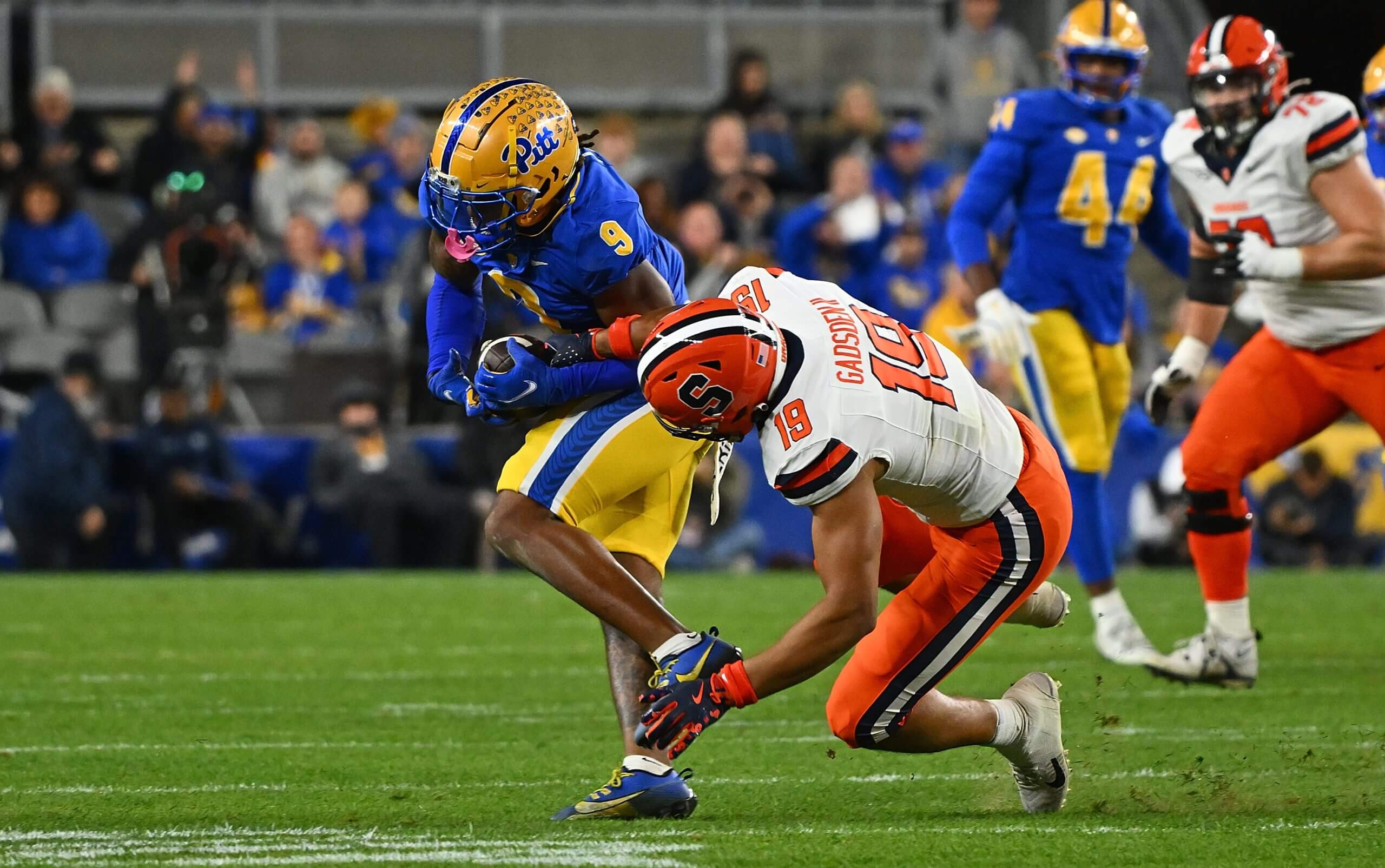

What to know: This rivalry spans their mutual transition from the FCS Southern Conference to the FBS in 2014. It was one of the biggest FCS rivalries, with the programs combining for nine national titles, and it has become a featured clash in the Sun Belt.
- With 40 meetings, they are one another’s most-played series among FBS opponents. They have played annually since 1993.
- Twice during FCS title runs (1999 for Georgia Southern, 2007 for App State), the national champion lost in the regular season to the other team.
- The teams met twice in FCS quarterfinals, with App State winning in 1987 and Georgia Southern exacting revenge in 2001.
Biggest game: Only the winner could earn a bowl bid in the 2022 finale, and the teams put on a show in Statesboro. An App State field goal gave the Mountaineers a three-point lead at the midpoint of the second overtime, but Georgia Southern QB Kyle Vantrease connected with Ezrah Archie for 25 yards to lift the Eagles to a 51-48 win and a Camellia Bowl berth.
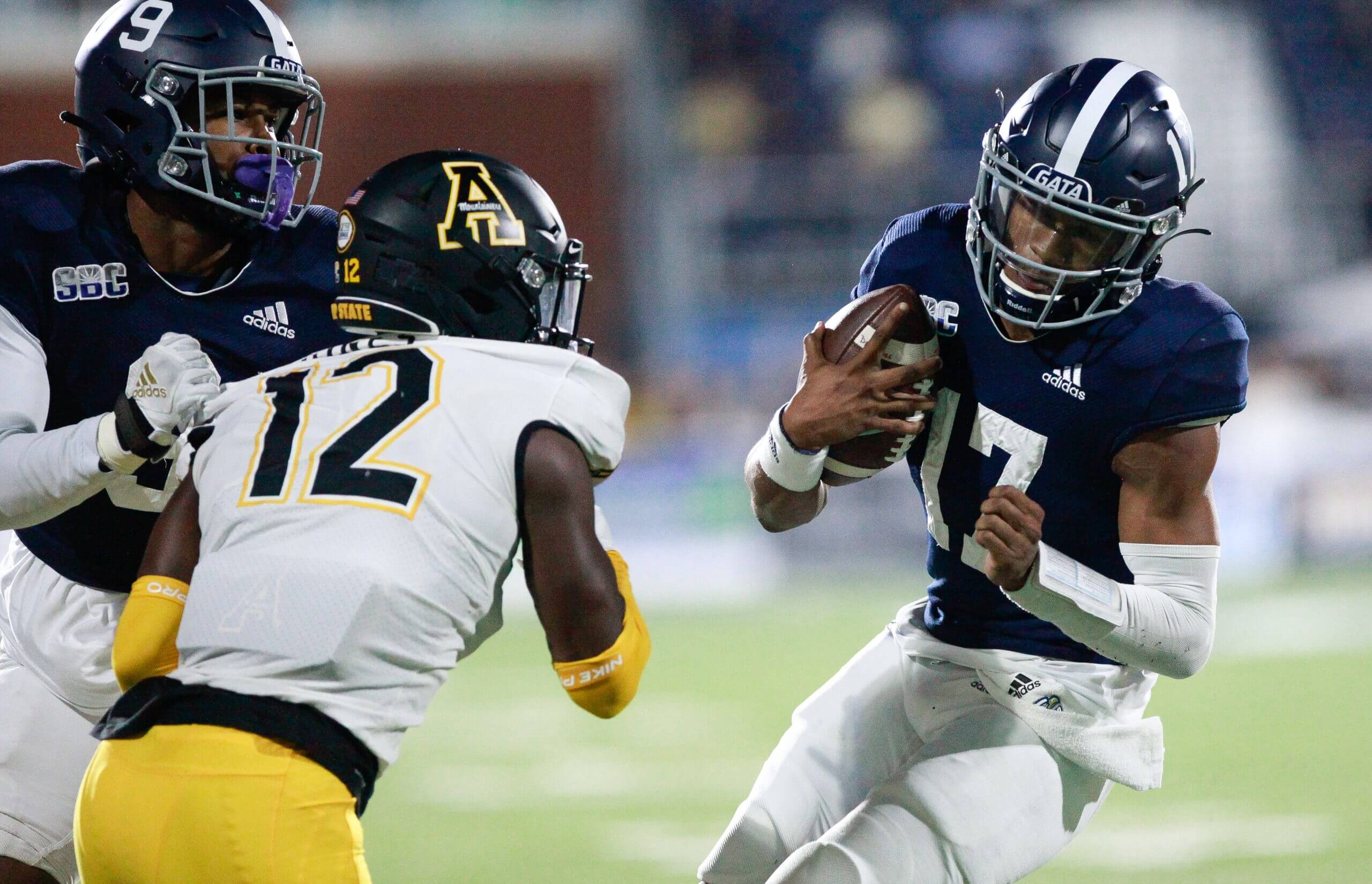

What to know: The Wolfpack and Demon Deacons have played annually since 1910, the second-longest FBS streak. Despite constant realignment and conference changes, the longtime foes have found ways to meet.
- They nearly rotated off one another’s schedule after a 2022 plan in which the ACC protected three rivals per school, and Wake-NC State wasn’t saved. That was corrected in 2023 amid another round of expansion.
- Only three times have the Wolfpack and Demon Deacons met as ranked opponents (1992, 2021, 2022).
- NC State has a decisive edge in victories, but the teams have split their past 28 meetings dating to 1997. No team has won more than three straight over that 28-year span.
Biggest game: A ranked shootout in 2021 decided the ACC Atlantic crown. In a back-and-forth battle with the teams combining for nearly 900 total yards, No. 13 Wake Forest held off No. 21 NC State 45-42.
Photo:
Grant Halverson/Getty
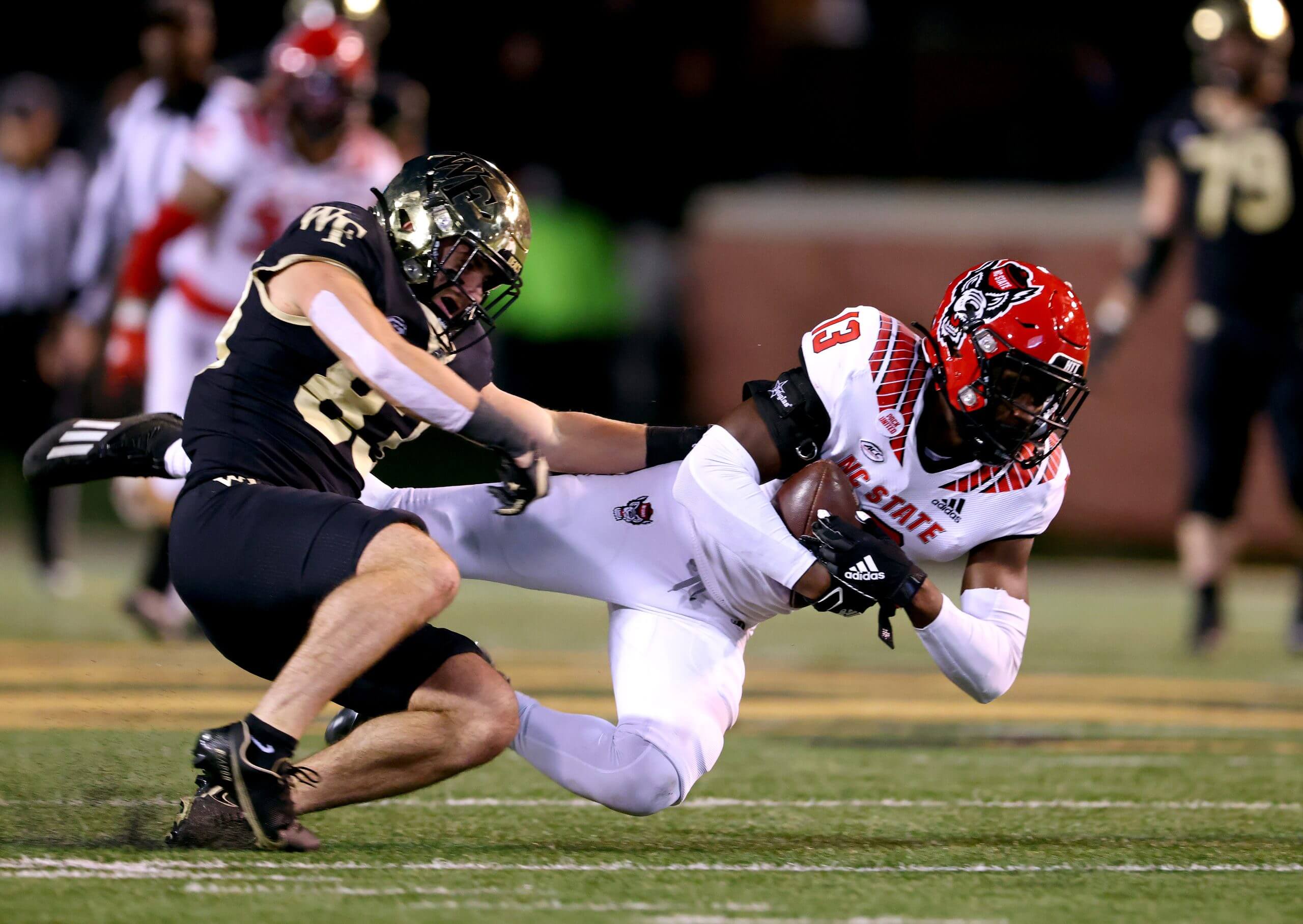

What to know: The rivalry’s competitiveness belies the series record. The campuses are separated by just 164 miles, and both sides have inflicted some pain on the other.
- The series is a continuation of a rivalry established well before the Gamecocks joined the SEC in 1992. The teams met 44 times when South Carolina was either in the ACC or an independent. In the SEC, the Bulldogs lead 22-10.
- Before the Bulldogs’ recent four-game winning streak, the teams split their previous 10. Of South Carolina’s wins, three came against Georgia teams ranked in the top six.
- For nearly five decades, Georgia-South Carolina served as an early-season test for both squads. Since 1974, they have met 42 times in September and just six times in October and November.
Biggest game: In one of the rivalry’s few November meetings, the nation’s top two running backs clashed at Sanford Stadium on Nov. 1, 1980. Heisman Trophy winner George Rogers rushed for 168 yards, but freshman Herschel Walker’s 219 yards, including a 76-yard TD on a draw, boosted the eventual national champion Bulldogs to a 13-10 win.
Photo:
Jamie Squire/Allsport/Getty Images
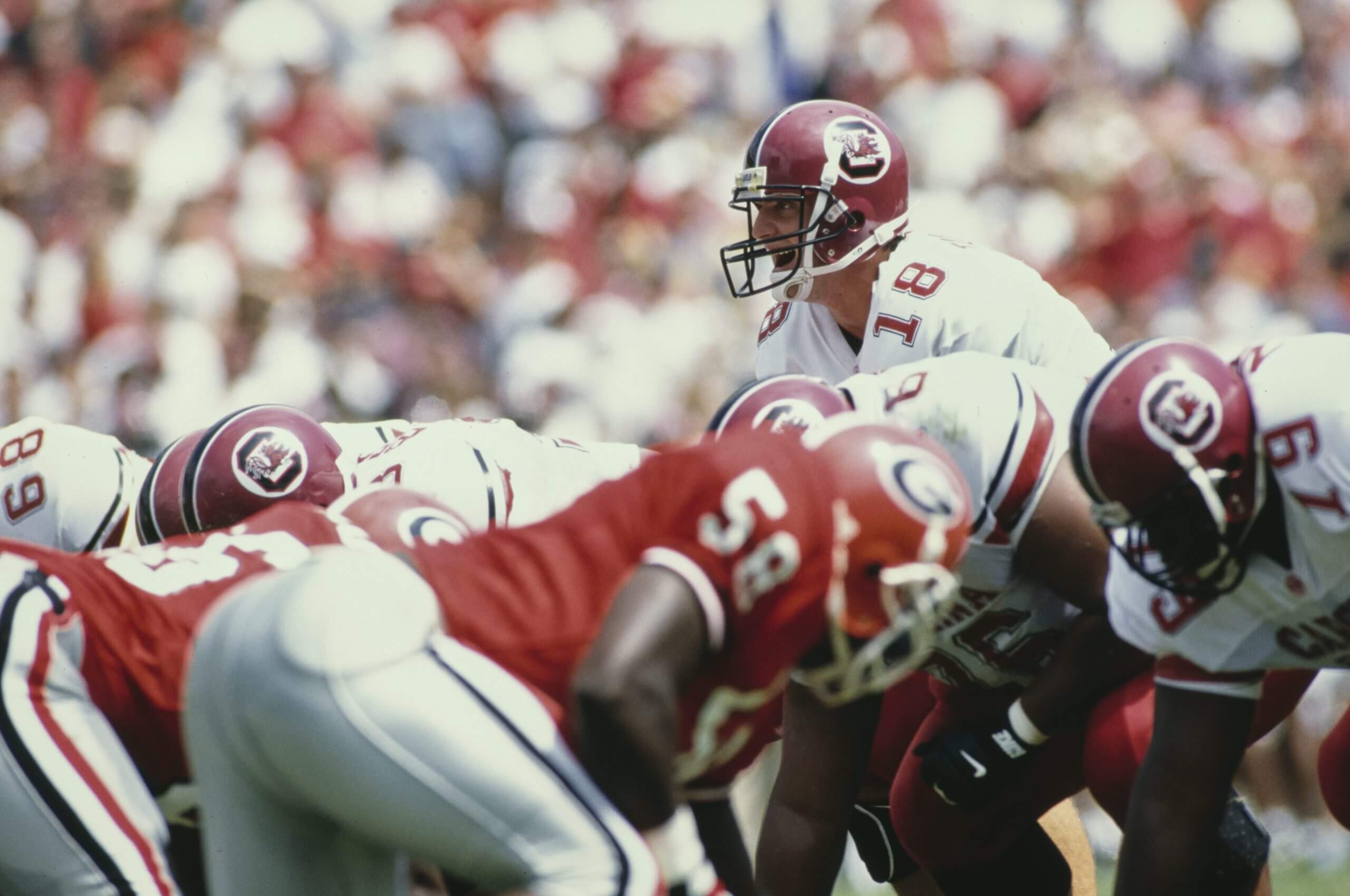

What to know: Although it has been diminished over time, Ohio State-Illinois is the 10th most-played rivalry in Big Ten history. Every so often, the ferocity would come to the forefront and make this one of the league’s signature games — especially in the 1980s and 1990s, when Illinois won five straight from 1988-92.
- Illinois and Ohio State played every year from 1914 until 2002 when a Big Ten scheduling change put this series on a rotation. It’s the second most-played rivalry for both teams, but this fall will be their first meeting since 2017.
- They compete for the Illibuck Trophy, which is tied for the second-oldest among Big Ten schools. It debuted in 1925 as a live turtle, then shifted to wooden turtle in 1926.
- The last time Illinois claimed the Illibuck was in 2007 when the Rose Bowl-bound Illini upset No. 1 Ohio State 28-21.
Biggest game: In a game that decided the Big Ten title, Ohio State’s ground game outlasted Illinois’ high-flying passing in a 34-27 shootout in 1981. It featured five lead changes, and a roughing-the-passer call allowed Ohio State to score the game-winning TD. The Buckeyes tied for the league title with a 6-2 record, while the Illini finished a half-game back at 6-3.
Photo:
David Maxwell/Getty


What to know: This rivalry is a relic between one program that has steadily risen to power-conference status and another that is staunchly a MAC program. It is tied as the fourth most-played series in FBS, and other than 2020, it was played annually from 1945-2024. The teams, separated by less than 40 miles, will not meet this year but will in 2026.
- The teams met just five times as conference foes. Cincinnati was a charter member of the MAC in 1947, while Miami joined a year later. The Bearcats dropped out after the 1952 season.
- The rivalry is called the “Battle for the Victory Bell,” a tradition that began in the 1890s when Cincinnati students stole a bell from one of Miami’s academic halls. A replica was created in 1946, which is still used as a traveling trophy.
- In 1923, Cincinnati’s Jimmy Nippert died following a deep cut caused by a cleat in the teams’ Thanksgiving tilt. His grandfather, Jimmy Gamble (Procter & Gamble company), donated $250,000 toward the Bearcats’ stadium to memorialize his grandson. It was then named Nippert Stadium, and it remains Cincinnati’s home field a century later.
Biggest game: In 2003, Ben Roethlisberger threw for 377 yards to give the RedHawks a 42-17 lead in the fourth quarter, then Cincinnati staged a furious comeback with 20 straight points. In the final two minutes, the Bearcats stopped the RedHawks to seemingly get the ball back, but a fumbled punt on the next snap allowed Miami to hold on, 42-37, en route to a 13-1 record and No. 10 final ranking.
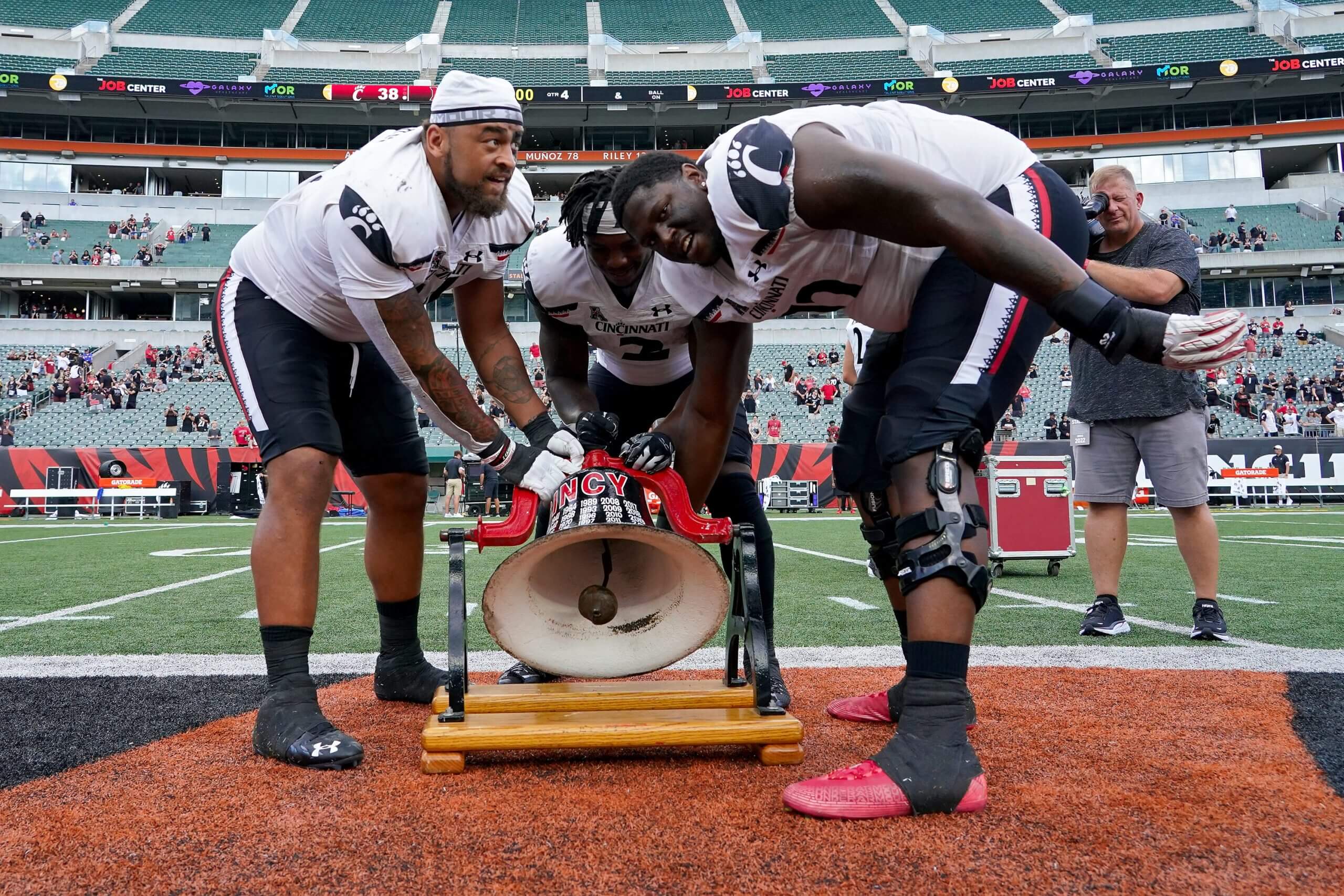

What to know: While it doesn’t match the number of meetings of Baylor’s former Southwest Conference foes, Bears-Red Raiders has developed into one of the most important series for both programs. The series has no shortage of entertainment over the years.
- The teams are survivors in a chaotic Texas college football landscape. They were among four Southwest schools to create the Big 12 in 1996. The Big 12 since has lost six schools (with one returnee) but Baylor and Texas Tech have remained in place.
- Baylor and Texas Tech have played annually since 1956, four years before the Red Raiders joined the Bears in the SWC.
- As part of a wave of neutral-site games, the programs moved their series to the Dallas-Fort Worth Metroplex from 2009-18 before bringing it back to the campuses in 2019.
Biggest game: On Black Friday 2014, Baylor needed a win to keep pace with TCU for a Big 12 championship, and it led Texas Tech 45-20 with 17 minutes to play. Texas Tech QB Patrick Mahomes then torched Baylor the rest of the game with four TDs passes — all beyond 40 yards — to pull the Red Raiders within 48-46 with 1:42 left. Mahomes’ 2-point run fell short, and the Bears prevailed despite Mahomes’ 598 yards and six TDs.
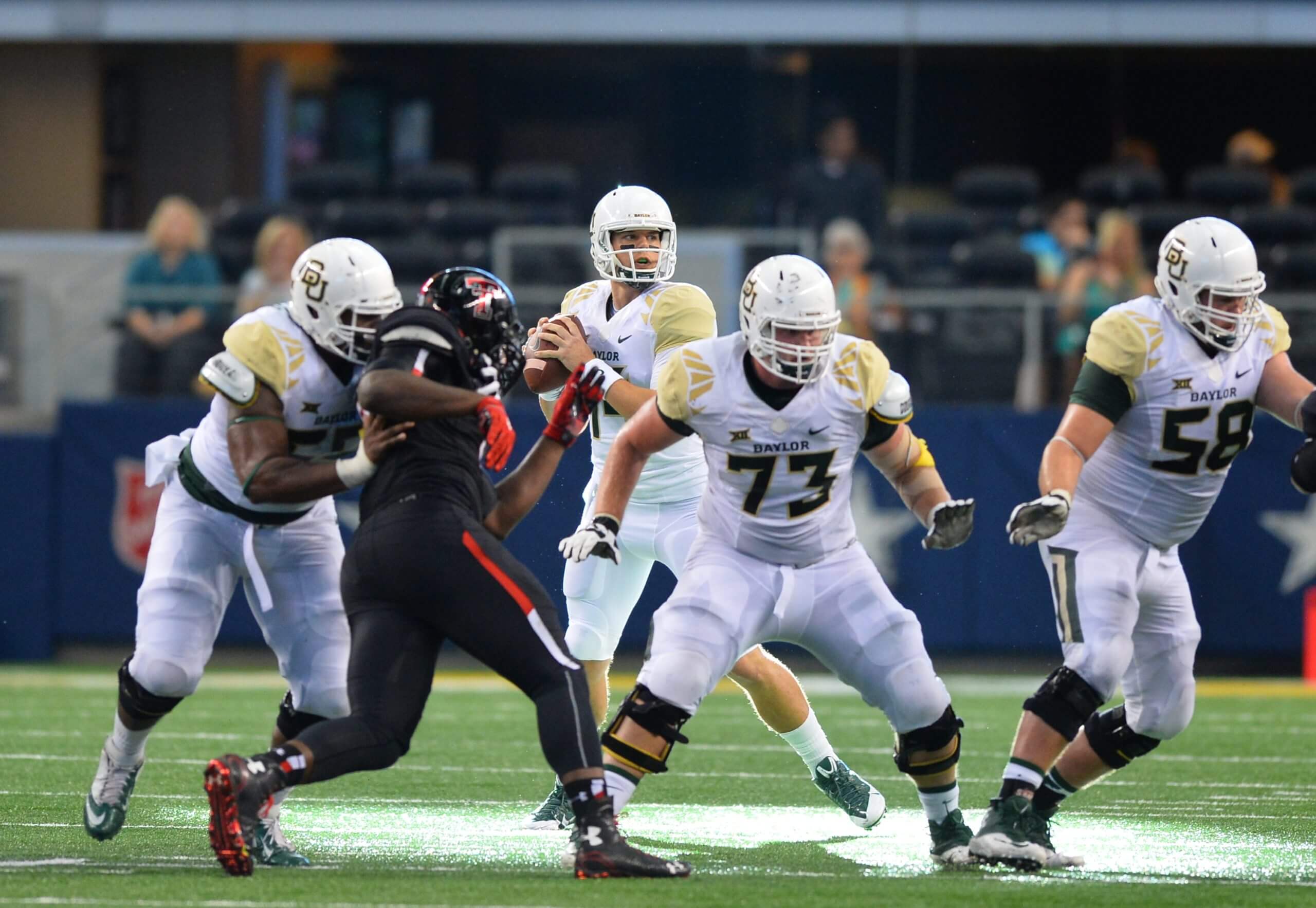

What to know: Of the many historic HBCU rivalries, Southern and Grambling share the most prominent series. Its history includes one of the greatest coaches in collegiate sports history in Grambling’s Eddie Robinson (408 wins) and the programs have combined for 47 SWAC titles and 26 Black College National Championships.
- In “The Bayou Classic,” the Louisiana-based HBCU programs have met every year in New Orleans since 1974, save for 2006 (Hurricane Katrina) and 2020 (game moved to Shreveport in spring 2021).
- While the annual football game is important, there’s nothing like the halftime battle between the Southern University Human Jukebox Marching Band and the World Famed Tiger Marching Band. NBC, which has aired the game live since 1991, also shows the halftime show.
- The programs have combined for seven members of the Pro Football Hall of Fame.
Biggest game: With the SWAC West title on the line, the 2003 Bayou Classic featured a combined 961 passing yards and five lead changes. Southern’s 22-point fourth-quarter barrage held off three-time divisional champ Grambling 44-41. The Jaguars then won the SWAC title and claimed the Black College National Championship.
Photo:
Stephen Dunn/Allsport/Getty
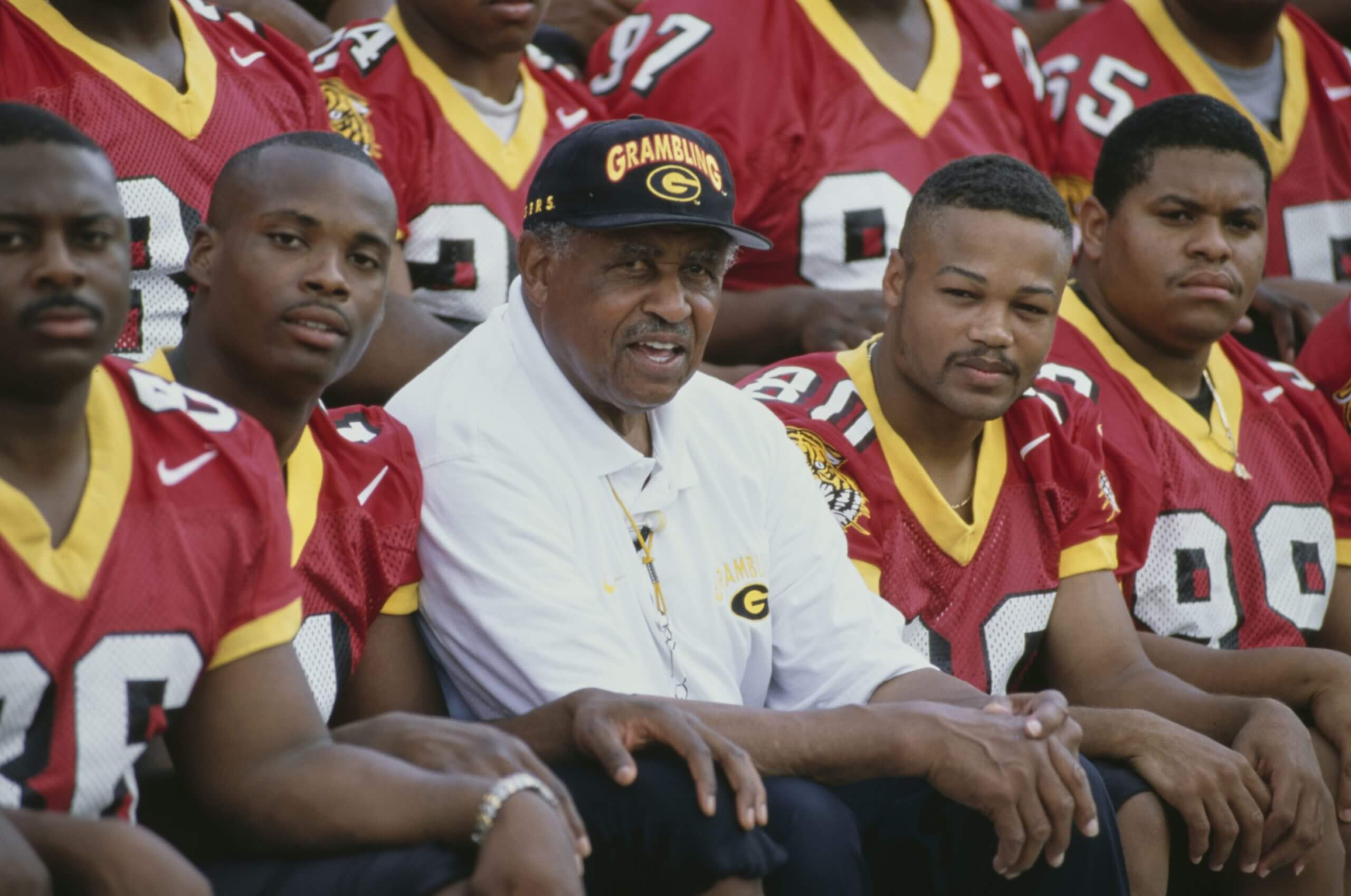

What to know: The in-state aspect and total number of games put this series in the top 80. But if both teams weren’t located in Tennessee, it might not crack the top 100. From 1965 to 2004, Tennessee was 37-2-1. The series has become more competitive in recent years with Vandy winning five of 13 to give it some more flavor.
- In true rivalry fashion, the teams can’t agree on the total number of games. Vandy lists 119 while Tennessee has 118. It all stems from Vanderbilt counting a 76-0 win against Tennessee in 1918, while the Vols suspended varsity football in 1917-18 during World War I and fielded two unofficial teams.
- Vandy won 18 of the first 22 games, which also included two ties. The Vols have compiled a 79-14-2 mark since 1928.
- Separated by 180 miles along I-40 from Knoxville to Nashville, the teams have played 65 times on the season’s final weekend.
Biggest game: Both clinched bowl bids by their 1982 finale, but Vanderbilt was seeking its first home win against Tennessee since 1964. Commodores QB Whit Taylor was brilliant in passing for 391 yards and engineering a 28-21 win. Vanderbilt fans stormed the field and tore down the goal posts. The next time Vandy beat Tennessee at home was in 2012, 30 years later.
Photo:
Doug Pensinger/Getty
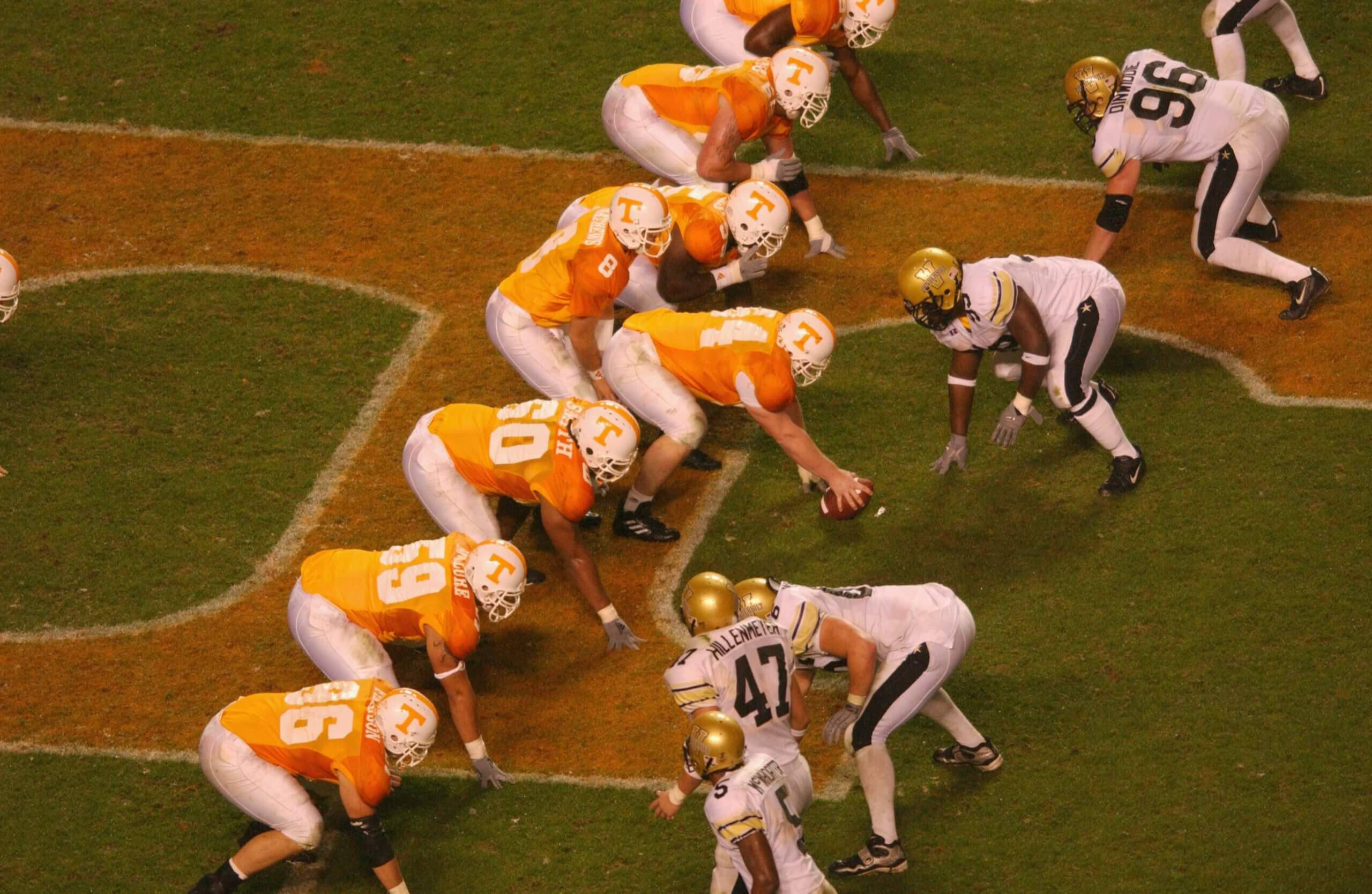

What to know: The men’s basketball version of the Governor’s Cup is the best nonconference rivalry in that sport. This one has become a solid annual tradition, but it’s one of the least-played in-state series and hasn’t quite spilled over into mutual pain.
- The programs went 70 years without playing, a streak that started after their 1924 game and ended in 1994.
- Once the rivalry restarted, they have played every year except 2020. Since 2014, they have met on Thanksgiving weekend.
- Running QBs have become a focus in this series. Kentucky’s Lynn Bowden rushed for 284 yards in 2019, while Louisville’s Lamar Jackson combined for 513 rushing yards in his three games against the Wildcats.
Biggest game: In 2023, Louisville had sewn up a spot in the ACC title game, and Kentucky had qualified for a bowl game. They went score-for-score until Kentucky took a 38-31 lead on a 37-yard run from Ray Davis with 56 seconds left. The Cardinals zoomed up the field before an end-zone INT with two seconds left allowed the Wildcats to prevail for their fifth straight rivalry win.
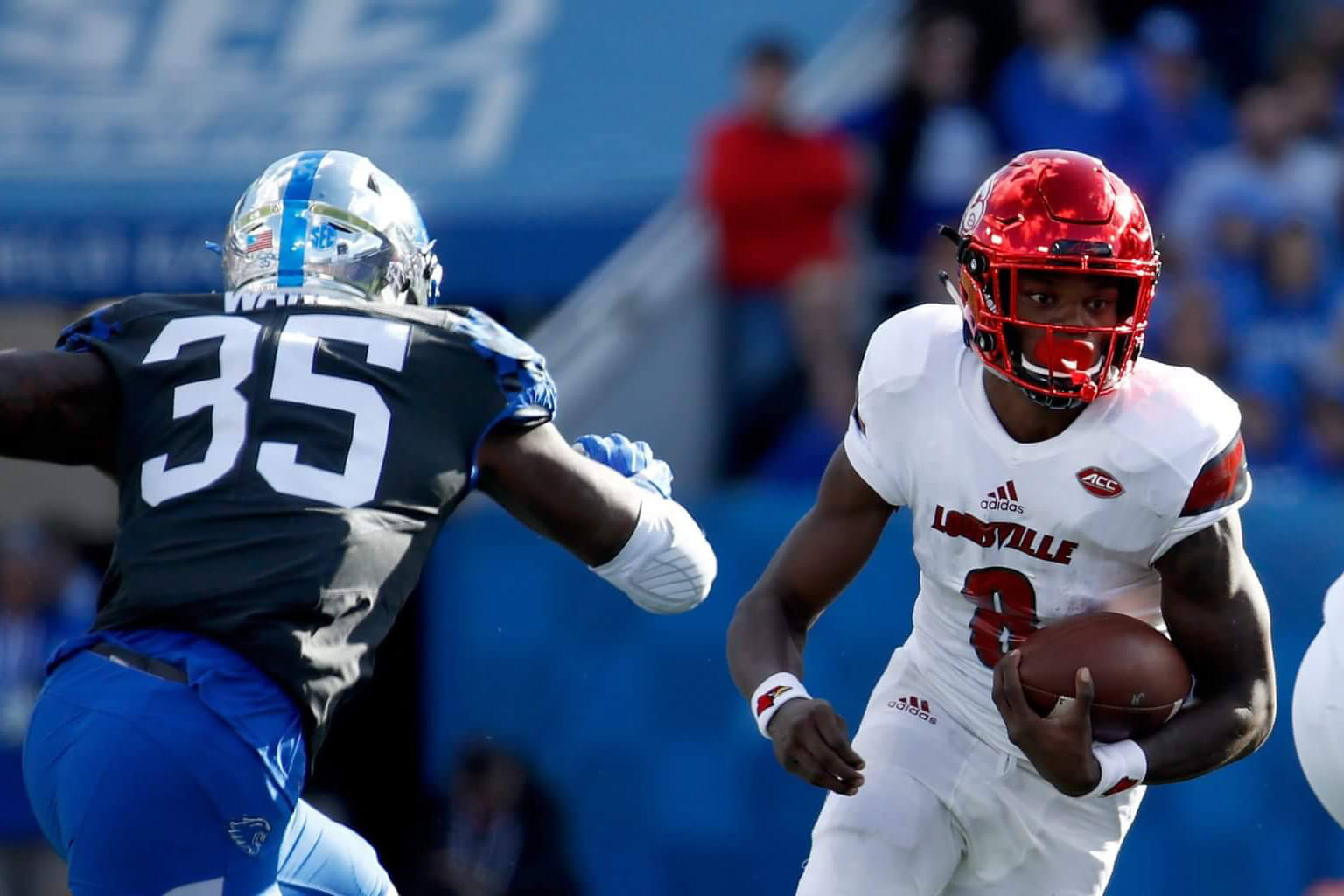

What to know: This long-standing in-state rivalry transferred into the ACC when Virginia Tech joined in 2004. They play annually for the Commonwealth Cup, which extends to other sports.
- If it weren’t for Virginia, Virginia Tech would not have joined the ACC two decades ago. Initially, the league planned to invite Miami, Boston College and Syracuse, but Virginia Gov. Mark Warner applied political pressure to UVa brass, who voted against ACC expansion until Virginia Tech was included.
- The schools have been scheduled to play every year since 1970. They did not compete in 2022 after a campus shooting killed three Virginia players in mid-November.
- Virginia Tech has dominated the series the past two decades, winning 19 of 20. The Hoos’ only win in that streak came in 2019.
Biggest game: In 1995, No. 13 Virginia and No. 20 Virginia Tech met as co-champions of the ACC and Big East, respectively, with a major bowl at stake for the winner. Trailing 29-14 in the fourth quarter, the Hokies rallied to take a 30-29 lead. With Virginia nearing field-goal range, Virginia Tech’s Antonio Banks’ 65-yard INT return — in which he appeared to be nearly tripped by a UVa trainer on the sideline — provided the clinching score in a 36-29 win.
Photo:
Dave Knachel/Virginia Tech Athletics


What to know: Widely regarded as college basketball’s best rivalry, UNC-Duke in football is critical to both schools but its importance beyond both campuses pales in comparison to hoops.
- The “Battle for the Victory Bell” began in 1948 when head cheerleaders from both schools agreed on a bell, which was obtained from an old railroad train.
- Both began playing football in 1888. Duke, then known as Trinity, played its first game against North Carolina. UNC’s first game was against Wake Forest and its second was against Duke.
- The campuses are separated by 10 miles, the shortest distance between schools in power-conference football.
Biggest game: When they met at midseason in 2022, it seemed like a traditional rivalry game. Ultimately, their encounter determined the ACC Coastal championship. In a game with seven lead changes, No. 22 UNC pulled out a 38-35 win when Drake Maye connected with Antoine Greene for the winning score with 16 seconds left.
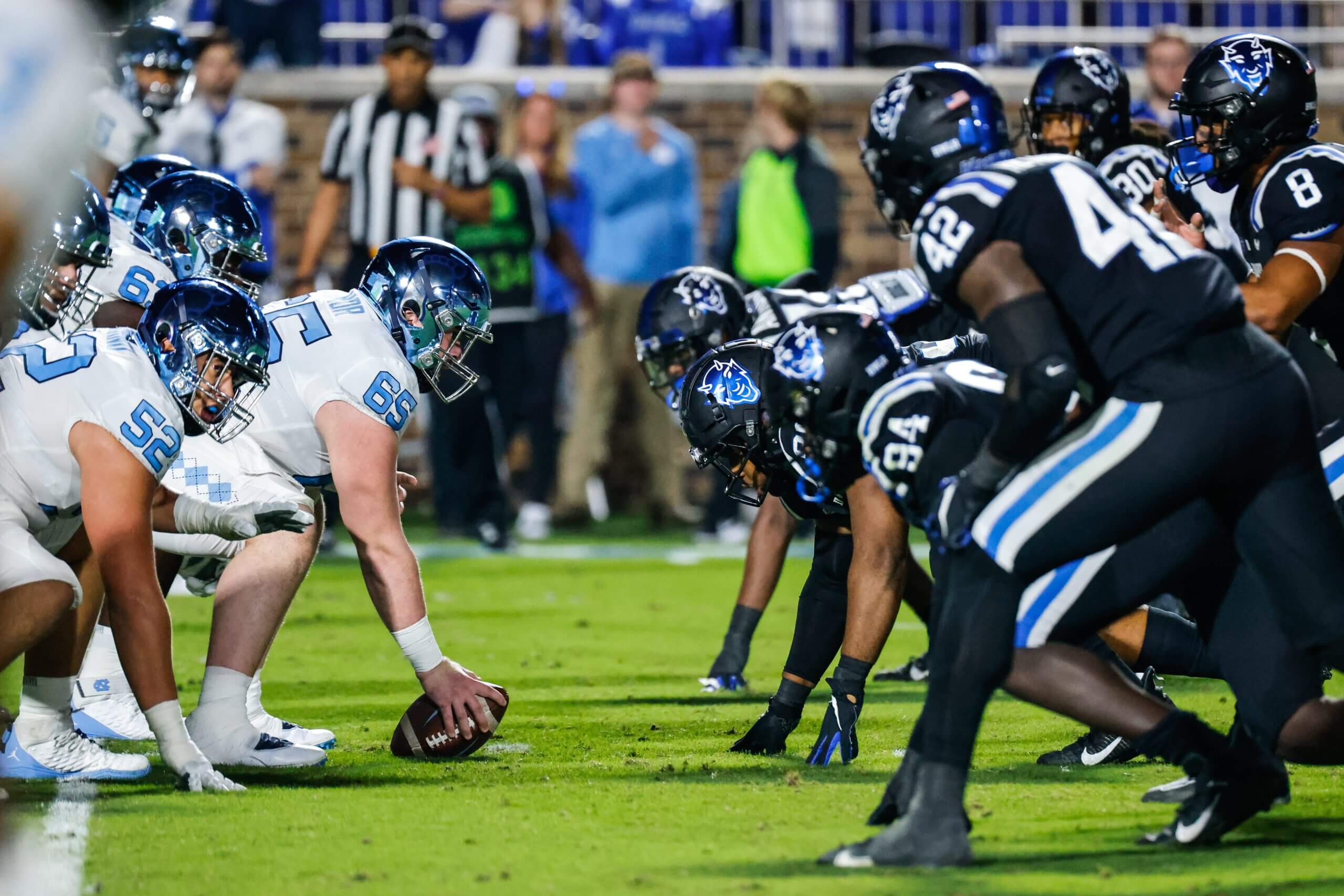

What to know: These teams’ success, historical ties and proximity (70 miles) suggest they should be bitter foes. They compete regularly for top recruits in the same footprint, but it’s strange they’ve never lined up in high-stakes football games. Since 2014, Clemson has seven CFP appearances and Georgia has four, but they haven’t met in the postseason.
- Their 66 games make this the most-played nonconference series for both schools outside of their in-state rivalries.
- Since 1980, each team has won three national titles, and they met in the regular season in three of those years. Georgia won 20-16 in 1980 and 10-3 in 2021, while Clemson won 13-3 in 1981. The Bulldogs also claimed the 2022 title, while Clemson earned titles in 2016 and 2018.
- Georgia’s Kirby Smart and Clemson’s Dabo Swinney are two of just three active FBS coaches with national titles, joining Ohio State’s Ryan Day. Smart and Swinney both have two.
Biggest game: Defending national champion Georgia entered their 1981 meeting at Clemson ranked No. 4 with a 15-game winning streak. Clemson was unranked, but that changed after forcing nine turnovers in a 13-3 upset. A second-quarter INT set up the game’s lone TD, and the victory propelled the Tigers to their first national title.
Photo:
Doug Pensinger/Allsport
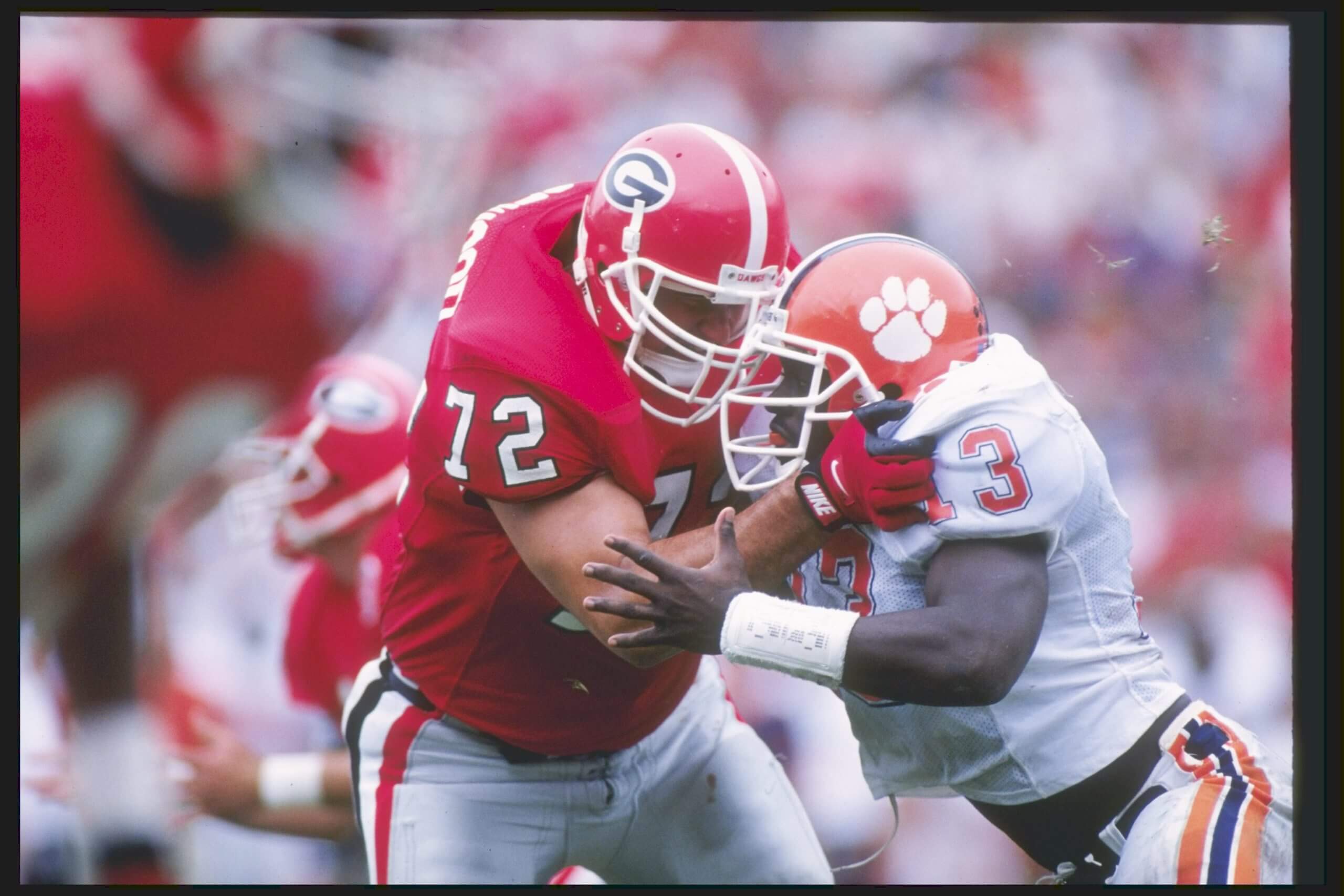

What to know: Results matter in rivalries, but so do proximity, longevity and other factors. There’s a sizzle between the fan bases that belies Tennessee’s lopsided advantage. It spills over to other sports, too.
- They once competed annually for the Beer Barrel from 1925-97. Painted orange on one side, blue on the other with white separating the colors, it was started by Kentucky students who labeled it “ice water” because of Prohibition at the time. It was discontinued after a fatal alcohol-related car accident involving Kentucky players in 1998.
- The win disparity (59) ranks ninth among power-conference series and second in SEC history behind Alabama-Mississippi State (71).
- The Vols and Wildcats are tied for third among SEC programs in games played. Only Auburn-Georgia (129) and Ole Miss-Mississippi State (121) have competed more often.
Biggest game: The hammer-vs.-nail history doesn’t leave much for great games, but their 2007 edition was a classic. The Wildcats featured one of their best teams and Tennessee was in position to claim the SEC East crown with a win. Kentucky QB Andre’ Woodson threw six TDs to erase a 17-point deficit. Trailing 52-50 in the fourth OT, Woodson’s 2-point run fell short and the Vols — behind QB Eric Ainge’s seven TDs — held on.
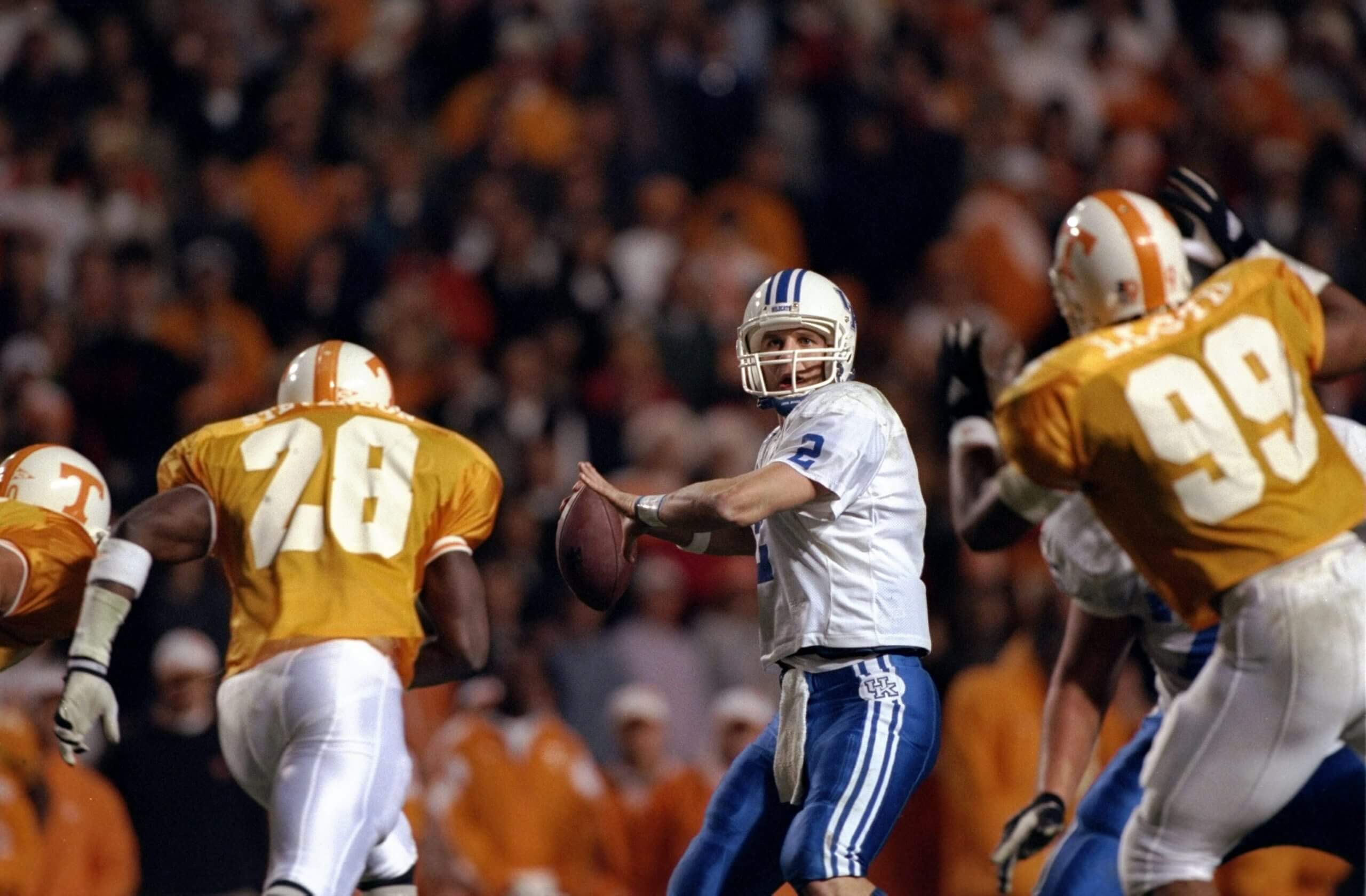

What to know: The “Battle of the Brazos” escalated from rivalry to feud in 2011 when Baylor threatened to sue departing conference member Texas A&M and the SEC for destabilizing the Big 12. Ultimately, the sides reached an agreement, but each day was filled with drama that fall.
- During a halftime show in 1926, female Baylor students were driving a car on the field in Waco when an A&M cadet rocked the vehicle and injured one of the students. Students from both sides joined in a melee that left one A&M student dead.
- With only 93 miles separating the campuses, there were plenty of hijinks involved between the schools over the years. One incident led to future Republican House Majority Leader Tom DeLay’s expulsion from Baylor in the late 1960s for painting an A&M building green.
- In 2011, for just the eighth time in their 108-game series, both teams were ranked in their final meeting — a 55-28 A&M win over Heisman winner Robert Griffin III.
Biggest game: In what ultimately determined the 1986 Southwest Conference title, Texas A&M QB Kevin Murray — Kyler Murray’s father — threw three TDs passes to rally the No. 11 Aggies from a 17-point deficit to edge No. 20 Baylor 31-30. Both teams finished the season ranked in the top 15, but A&M earned the Cotton Bowl spot.
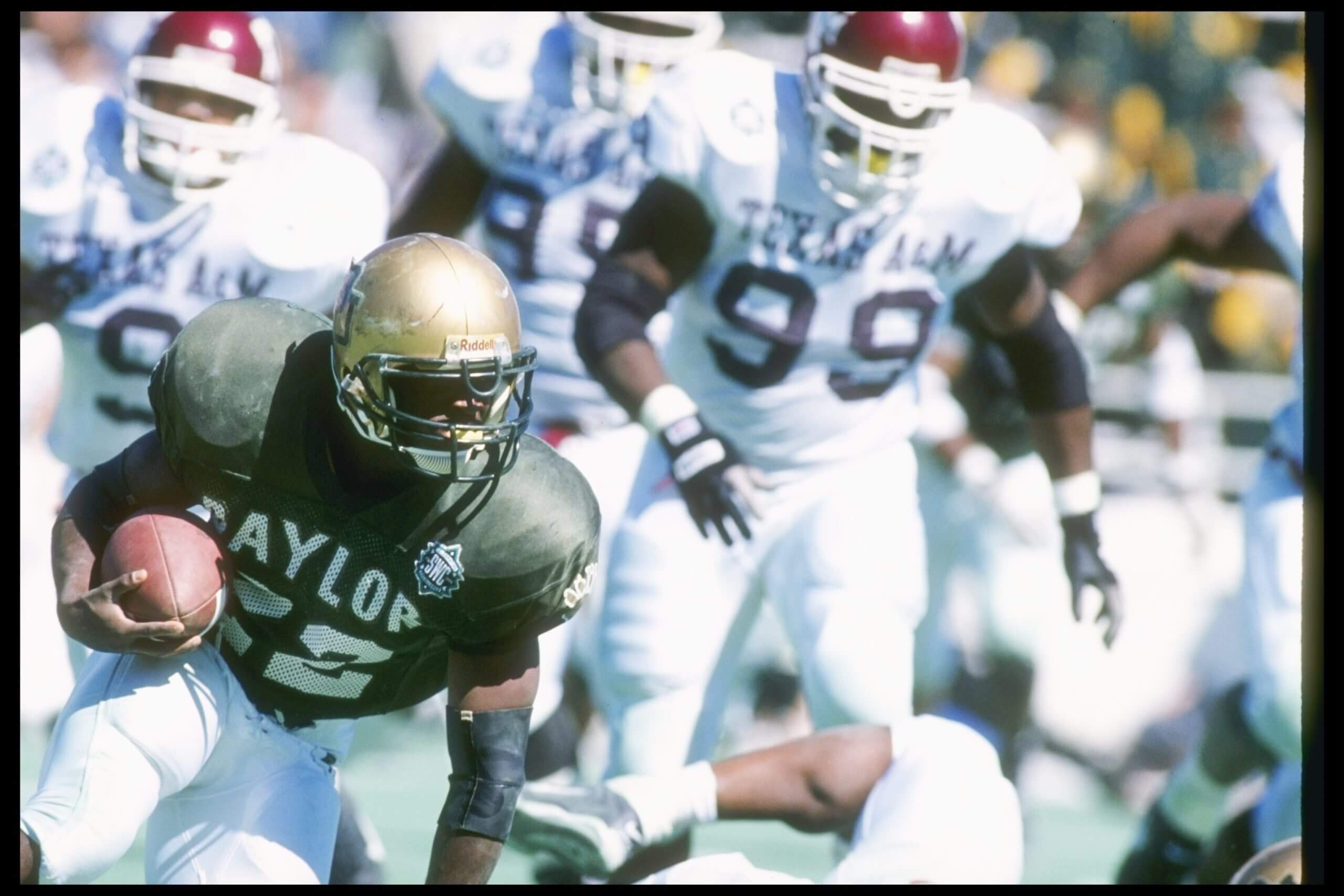

What to know: A nice regional game for 120 years, this series has escalated in importance for both teams after they were left behind in the most recent round of realignment.
- Oregon State and Washington State remain the only teams in the Pac-12 after 10 members bolted for the Big Ten, Big 12 and ACC in 2024. The Beavers and Cougars chose to keep the league intact with five former Mountain West teams and Texas State to join them in 2026.
- Oregon State and Wazzu will play twice this November because of their difficult scheduling situation.
- In 13 of the past 17, the winning team scored at least 38 points, including Wazzu pulling out a 54-53 win in 2019 after the teams combined for 48 points in the fourth quarter.
Biggest game: In 2023, the only time the teams met as ranked opponents nearly produced one of the Pac-12’s greatest comebacks. QB Cam Ward threw four TDs and rushed for another to give No. 21 Washington State a 35-14 fourth-quarter lead. Then No. 14 Oregon State rallied with three TDs to cut its deficit to 38-35 with 1:12 left. But the Beavers failed to recover an onside kick to preserve the Cougars’ win.
Photo:
Craig Strobeck/Imagn
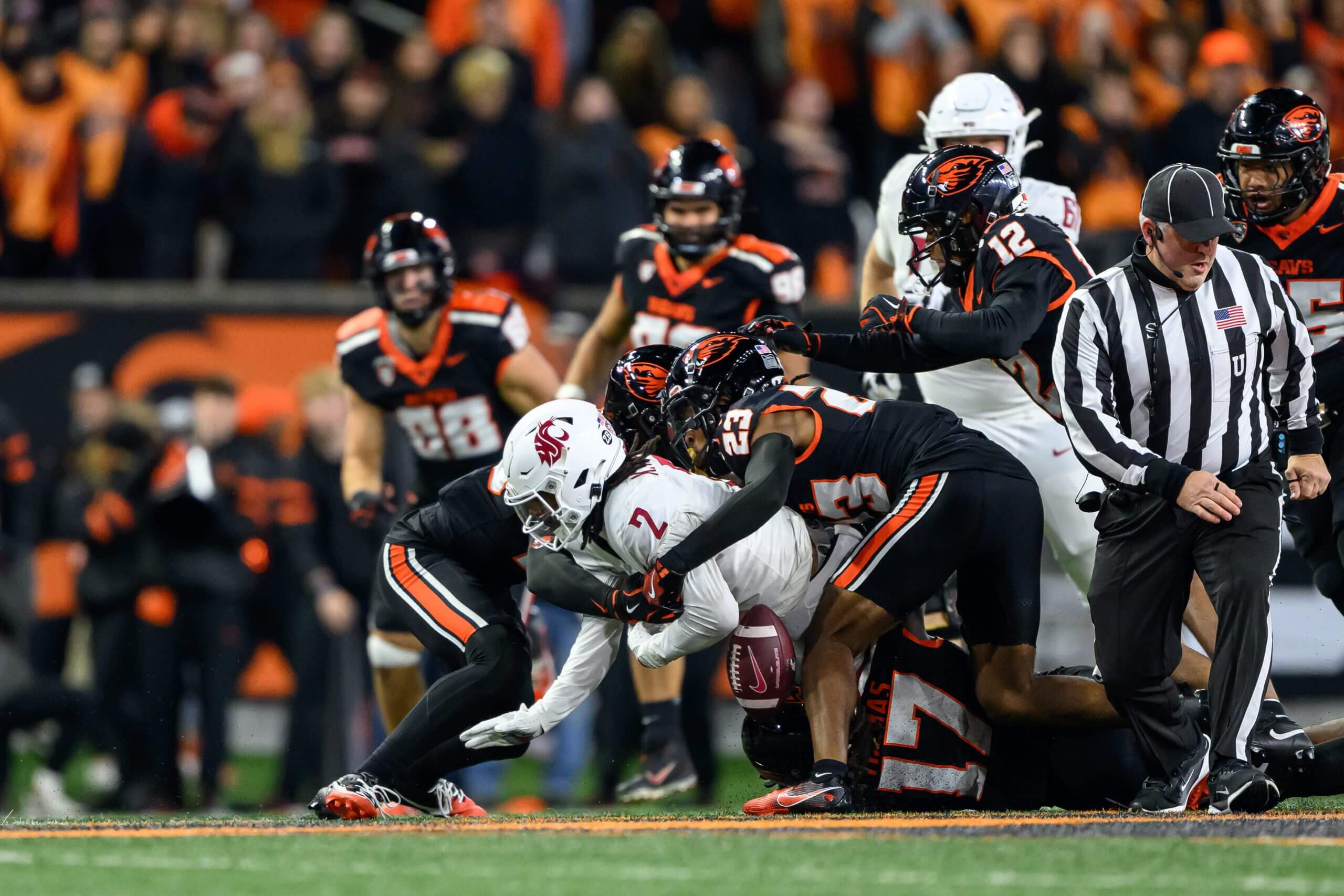

What to know: One of the four California games on hiatus after the Pac-12 breakup, the teams played 12 ranked matchups over their 95 meetings.
- One of the series’ most important games is so obscure that media guides for both schools list the wrong date. The duo played Oct. 12, 1935 (not Oct. 19) in a game that decided the Pacific Coast crown. UCLA pulled out a 7-6 win against Stanford, but the latter earned the Rose Bowl slot and beat SMU.
- The teams rarely matched up at similar competitive levels over their final decade in the Pac-12. At least one had a losing record every year from 2016 onward.
- The first time the schools played, Stanford won 82-0. UCLA exacted some revenge in its national-title season of 1954 with a 72-0 shellacking.
Biggest game: In 2012, they met for the Pac-12 title a week after facing off during the regular season. No. 17 UCLA led by a TD in the fourth quarter, but No. 8 Stanford rallied with 10 straight points to take a 27-24 lead. The Bruins reached Cardinal territory twice afterward, but a 52-yard field goal fell short, and Stanford claimed the league title and a Rose Bowl bid.


What to know: Texas A&M’s entry into the SEC turned this into an annual affair, and it became one of the top organic rivalries from recent conference realignment.
- Although they weren’t in the same conference until 2012, the schools had stretches when they played annually from 1960-75 and 1986-95.
- They have matched up nine times as AP-ranked opponents with LSU holding an 8-1 advantage.
- LSU and Texas A&M have met twice in bowl games. The first followed the 1943 season (Orange) and the second was after 2010 (Cotton). LSU won both.
Biggest game: If college football ever had a “hold my beer” moment, it took place on Nov. 24, 2018, in College Station. Texas A&M sent the game into OT with a 19-yard TD pass with no time remaining. The ensuing seven overtimes didn’t have a play clock, and neither defense could stop the other. It mercifully ended with Kellen Mond’s third 2-point conversion (after his sixth touchdown pass) in a 74-72 A&M victory.
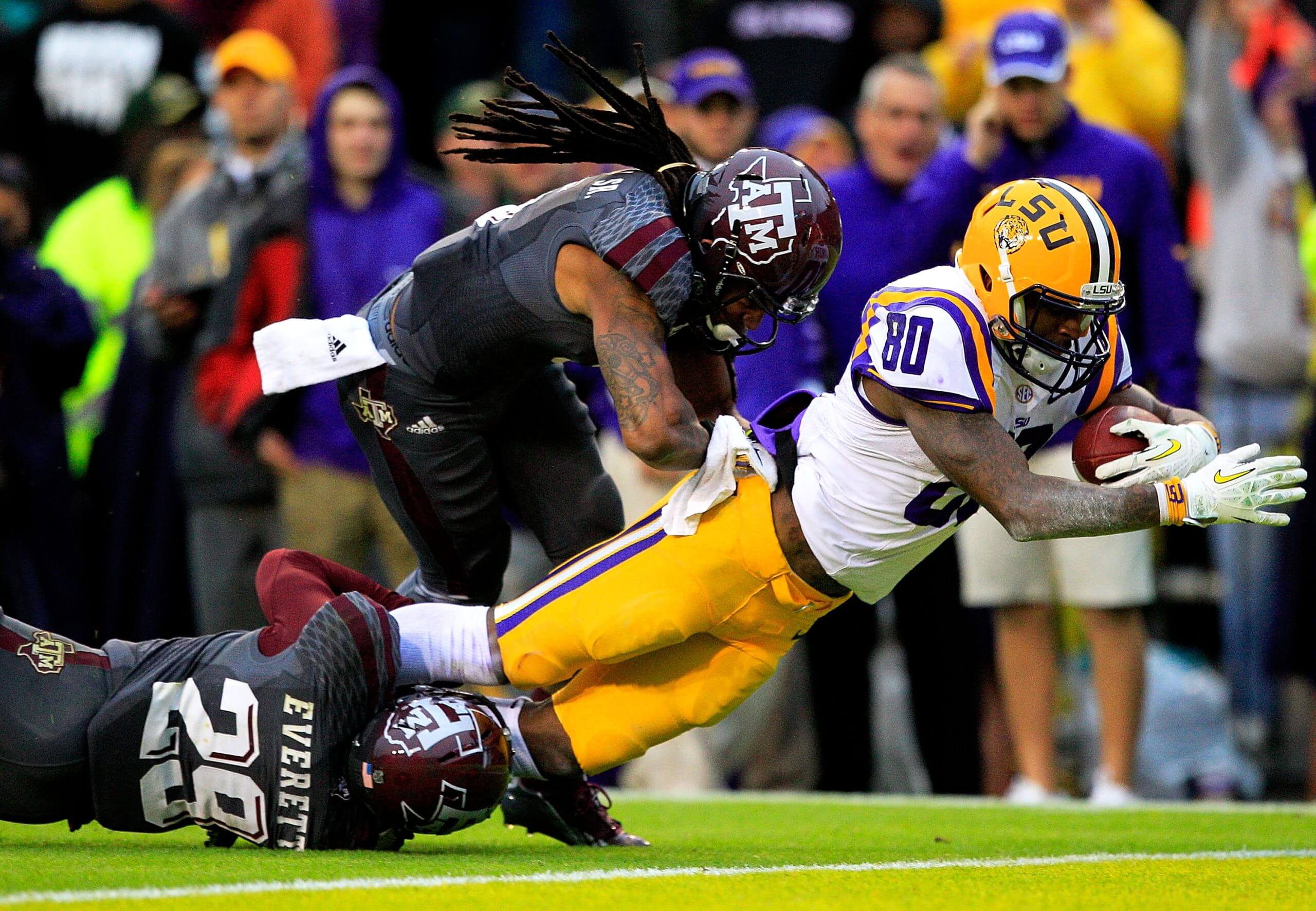

What to know: They have played 118 times but are rarely good concurrently. It’s a close, competitive series historically and it’s definitely a rivalry, but it doesn’t get circled on the calendar the way other in-state rivalries do.
- The Illini and Wildcats have played for a trophy every year since 1945. They met for the Sweet Sioux Tomahawk until 2008. Since 2009, they have competed for the Land of Lincoln Trophy.
- It’s tied for fourth among the Big Ten’s most-played series, but they have never met while both ranked in the AP poll. The Wildcats were ranked fourth in 1963 when Illinois won 10-9, and then the eventual Big Ten champion Illini burst into the rankings two weeks later.
- The teams faced off on Thanksgiving at Memorial Stadium in 2001 when the Illini last secured a Big Ten championship in a 34-28 victory.
Biggest game: Every game was “the story of the season” for the 1995 Wildcats and this was no exception. Illinois’ staunch defense helped build a 14-0 lead before Northwestern chipped away at its deficit. Facing fourth-and-goal at the 1-yard line in the fourth quarter, Northwestern QB Steve Schnur changed from a sneak to a pitch, and Darnell Autry walked into the end zone for a 17-14 win. The Wildcats made their first bowl game in 47 years and won the Big Ten title.
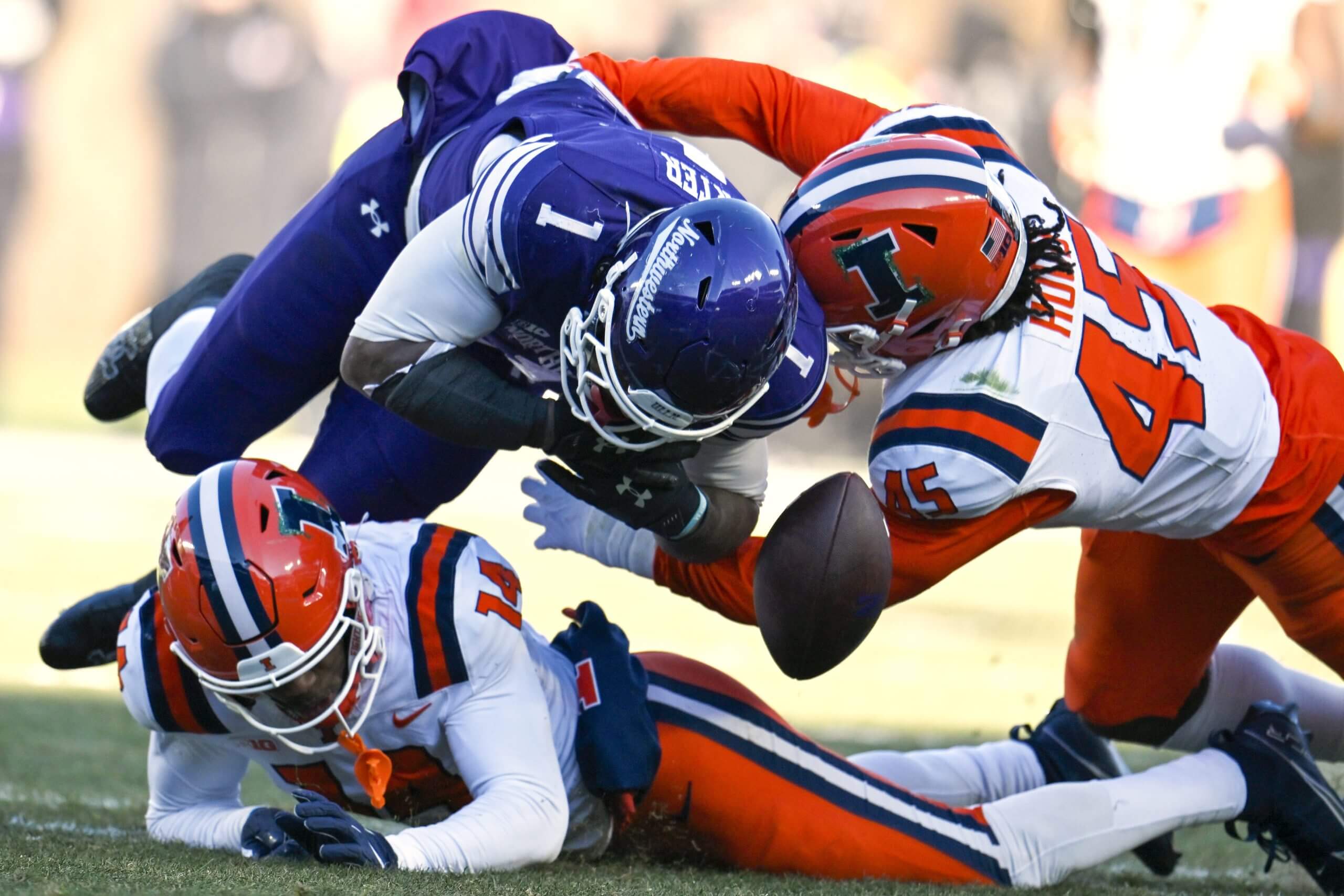

What to know: With 116 meetings spanning three centuries, the “Border War” is the most-played FBS rivalry outside of power-conference teams. The teams are located just 64 miles apart along Highway 287.
- The teams play for the Bronze Boot, which was established in 1968 from an actual boot worn in Vietnam by Dan Romero, a Colorado State ROTC instructor.
- There is a dispute over the inaugural meeting, which ended in a forfeit. Colorado State does not count the outcome (which it won), but Wyoming does count it.
- The schools will separate into different conferences in 2026 — Colorado State heads to the Pac-12 while Wyoming stays in the Mountain West — but they agreed to extend their series through 2035.
Biggest game: In 1996, the rivals faced off in a winner-take-all season finale for the WAC Pacific title at Fort Collins. Colorado State led 24-13 midway through the fourth and by five points when Wyoming took over at its 4-yard line. A 14-play, 96-yard drive culminated in a 6-yard Marques Brigham TD run to give the Cowboys a 25-24 win and a WAC title game invite.
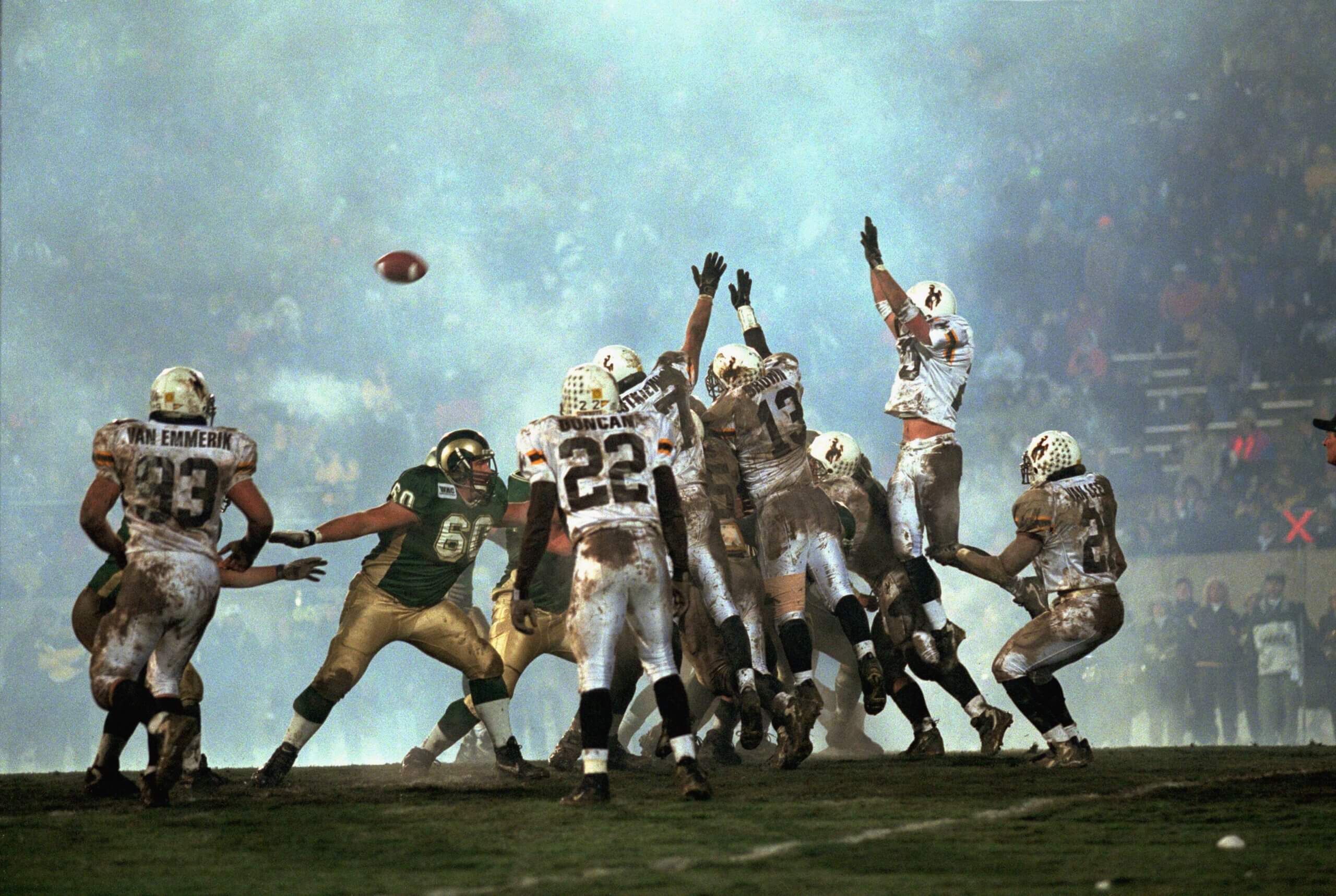

What to know: With 110 meetings, Cal-USC ranks second in games played among the California universities behind Stanford-Cal.
- Cal and USC have faced seven times while one or the other team is ranked No. 1. The Trojans are 5-0 as the top-ranked team, although their 2005 victory was vacated because of NCAA sanctions. The Bears are 1-1 with No. 11 USC pulling a 21-14 upset in 1951.
- The series went uninterrupted from 1921 until 2020. It’s now on hiatus after USC joined the Big Ten and Cal moved to the ACC.
- The rivalry was at its peak in the 2000s when they had five ranked matchups in six years, all won by USC.
Biggest game: With Heisman winners Reggie Bush and Matt Leinart competing for top-ranked USC and No. 7 Cal boasting future NFL stars Marshawn Lynch and Aaron Rodgers, their 2004 clash had the makings of a classic. Rodgers completed his first 23 passes, but the Trojans led 23-17 entering the final two minutes. Rodgers drove the Bears inside the USC 10-yard line, but Cal couldn’t punch it in. USC won the BCS title, while Cal finished 10-2.
Photo:
Donald Miralle/Getty
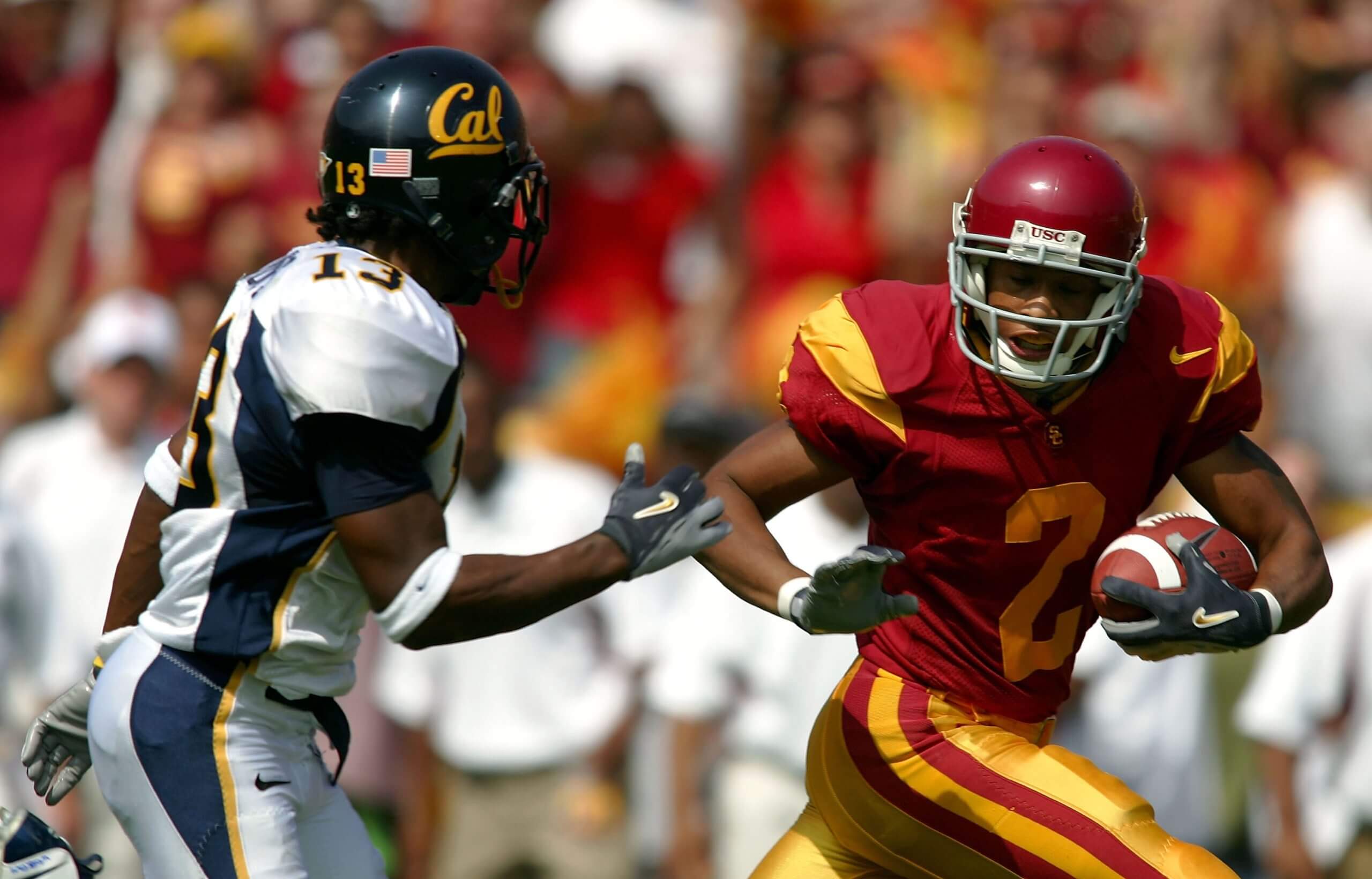

What to know: From 1993-2010, these schools served as the Big Ten’s geographic outposts, but perhaps no organic Big Ten series has featured more classic finishes and upsets over the past three decades.
- Penn State has winning streaks of six, five and four games in three different decades while Iowa won eight of nine from 2000-10. That stretch included four victories against ranked Penn State squads.
- In their 2017 night battle at Kinnick Stadium, Penn State RB Saquon Barkley put up 358 all-purpose yards in the No. 4 Nittany Lions’ 21-19 final-second win.
- Penn State coach James Franklin and Iowa coach Kirk Ferentz engaged in a fiery war of words following No. 3 Iowa’s 23-20 comeback against No. 4 Penn State in 2021 with accusations of Nittany Lions defenders faking injuries and booing by Hawkeyes fans.
Biggest game: No. 3 Penn State sat 9-0 with a chance to earn a BCS title bid when it traveled to unranked Iowa on Nov. 8, 2008. The Nittany Lions led by nine points midway through the fourth quarter, before the Hawkeyes rallied with a touchdown, then a 31-yard field goal with 1 second left to end Penn State’s title hopes. The 24-23 upset propelled Iowa to a 13-game winning streak.
Photo:
Jonathan Daniel/Allsport
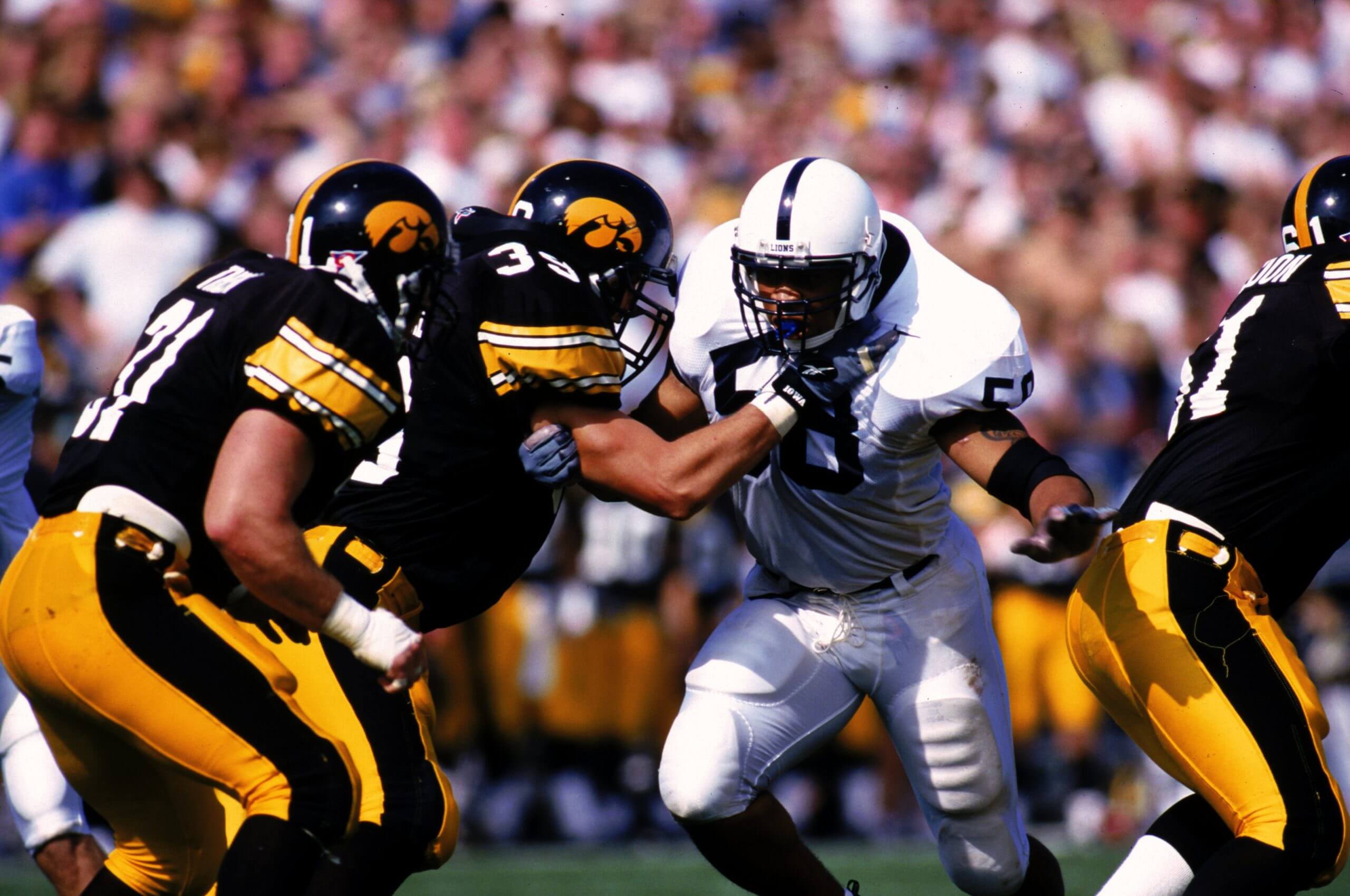

What to know: As public universities under the same board of regents, UCLA and Cal became the athletic tentpoles for the state of California. The teams played every season from 1933-2023 until the Pac-12 disintegrated.
- The breakup became bitter between the programs with UCLA securing a more lucrative future in the Big Ten, while Cal took a reduced share to join the ACC. It prompted the board of regents to install $10 million “Calimony” payments annually for three years from UCLA to Cal.
- When the Pac-12 expanded by two teams in 2011, UCLA and Cal were placed in opposite divisions, which meant their series would cycle out. The schools joined USC and Stanford in demanding that all four California schools play each year. Instead of changing the division structure, the league agreed.
- Over the final seven meetings, UCLA and Cal ended their regular seasons against one another five times.
Biggest game: Both UCLA and Cal were unbeaten and in the top 20 in their clash at the Rose Bowl in October 2005. No. 10 Cal led 40-26 in the fourth quarter. Spurred by RB Maurice Jones-Drew’s 299 all-purpose yards and five TDs, the No. 20 Bruins staged a furious rally with three late TDs to win 47-40 en route to a 10-2 season.
Photo:
Reuben Canales/Getty
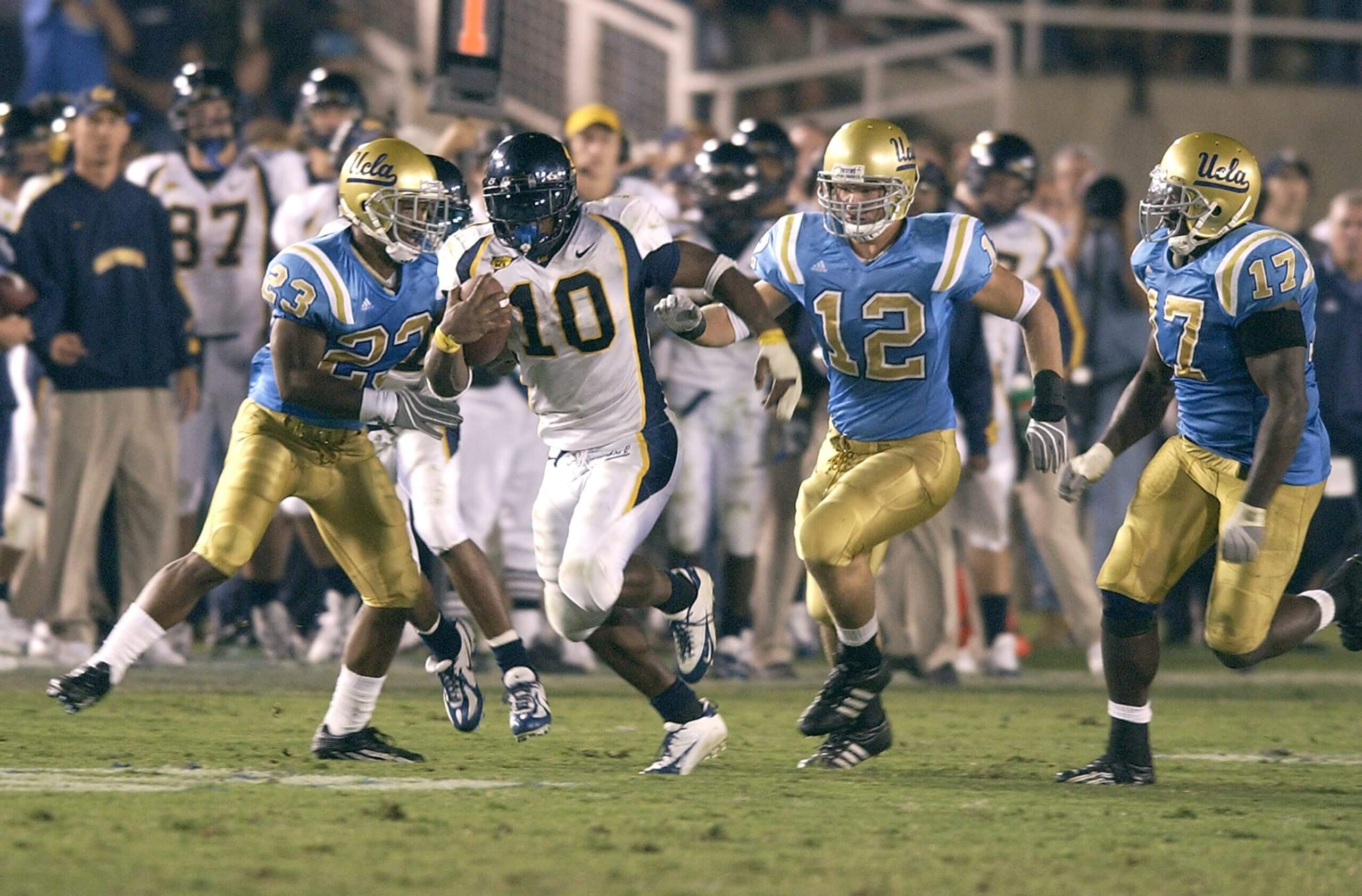

What to know: This is the Big Ten’s best non-rivalry “rivalry.” The teams play for a trophy, they have competed on the final weekend 24 times since 1994 and their games consistently matter in the Big Ten standings. Yet it’s not a series that either chooses to protect and now is on a rotation.
- When Penn State joined the league in 1993, they began playing for the Land Grant Trophy, which resembles a large vertical dresser. The land-grant institutions were born 10 days apart in February 1855.
- The Big Ten put together a scheduling rotation in 1995 in which each team had two protected opponents. Michigan State and Penn State received one another as rivals, a system that lasted until 2010.
- The teams have faced off five times with the chance to claim a Big Ten conference or divisional title and all five times the favorite won.
Biggest game: In 2008, they engaged in a winner-take-all showdown for a share of the Big Ten title in Happy Valley. The result did not match the stakes. Behind QB Daryll Clark’s five combined TDs, No. 7 Penn State rolled through the No. 17 Spartans 49-18 to earn a Rose Bowl trip.
Photo:
Matthew OHaren/Imagn
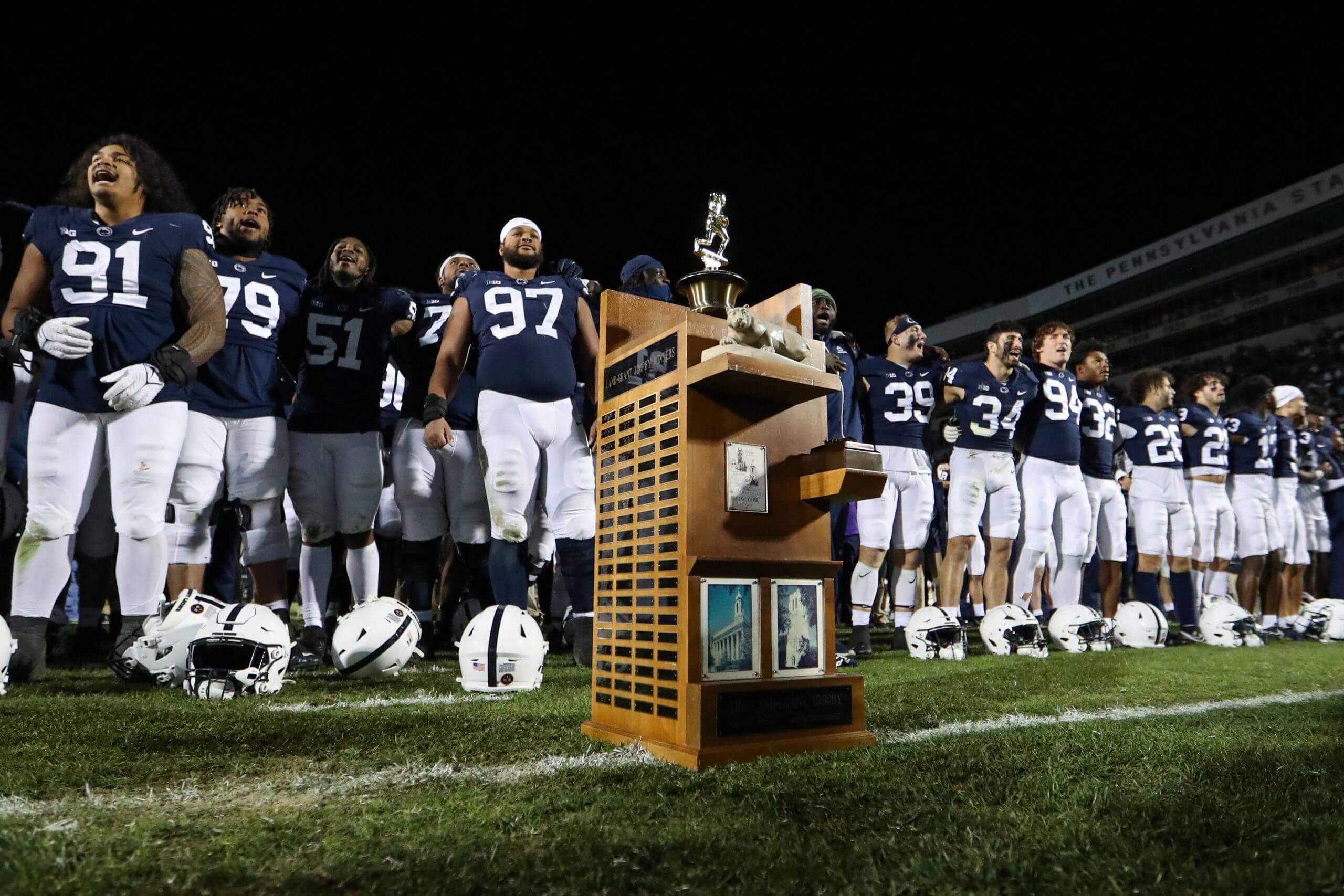

What to know: It doesn’t have the lore or regional appeal of other SEC rivalries, but each of these programs has won two national championships over the past 20 years. This is the annual rivalry that neither side really wants, but it’s too good for the SEC to let it expire.
- The Gators and Tigers have played every year since 1971 and they became permanent crossover opponents in the old SEC divisional alignment. It remains undetermined whether it will continue as the SEC explores its future scheduling model.
- The teams have battled 25 times as ranked opponents, which is tied for seventh in FBS history. Only Alabama-LSU have played more games with both teams ranked in SEC history.
- Top-10 upsets play a key role in this rivalry with Florida beating LSU five times and the Tigers reversing the fortunes four times. The most prominent upset occured in 1997 when No. 14 LSU beat top-ranked Florida, the defending national champion.
Biggest game: Their 2007 battle in Baton Rouge stands out as first among equals. Top-ranked LSU trailed No. 9 Florida 24-14 with 10:15 left in the game before rallying for two TDs to take a 28-24 lead. Florida moved into LSU territory but Heisman winner Tim Tebow’s final pass attempt fell incomplete, and the eventual BCS champion Tigers — who went 5-for-5 on fourth downs — held on for the win.
Photo:
Scott Halleran/Allsport/Getty
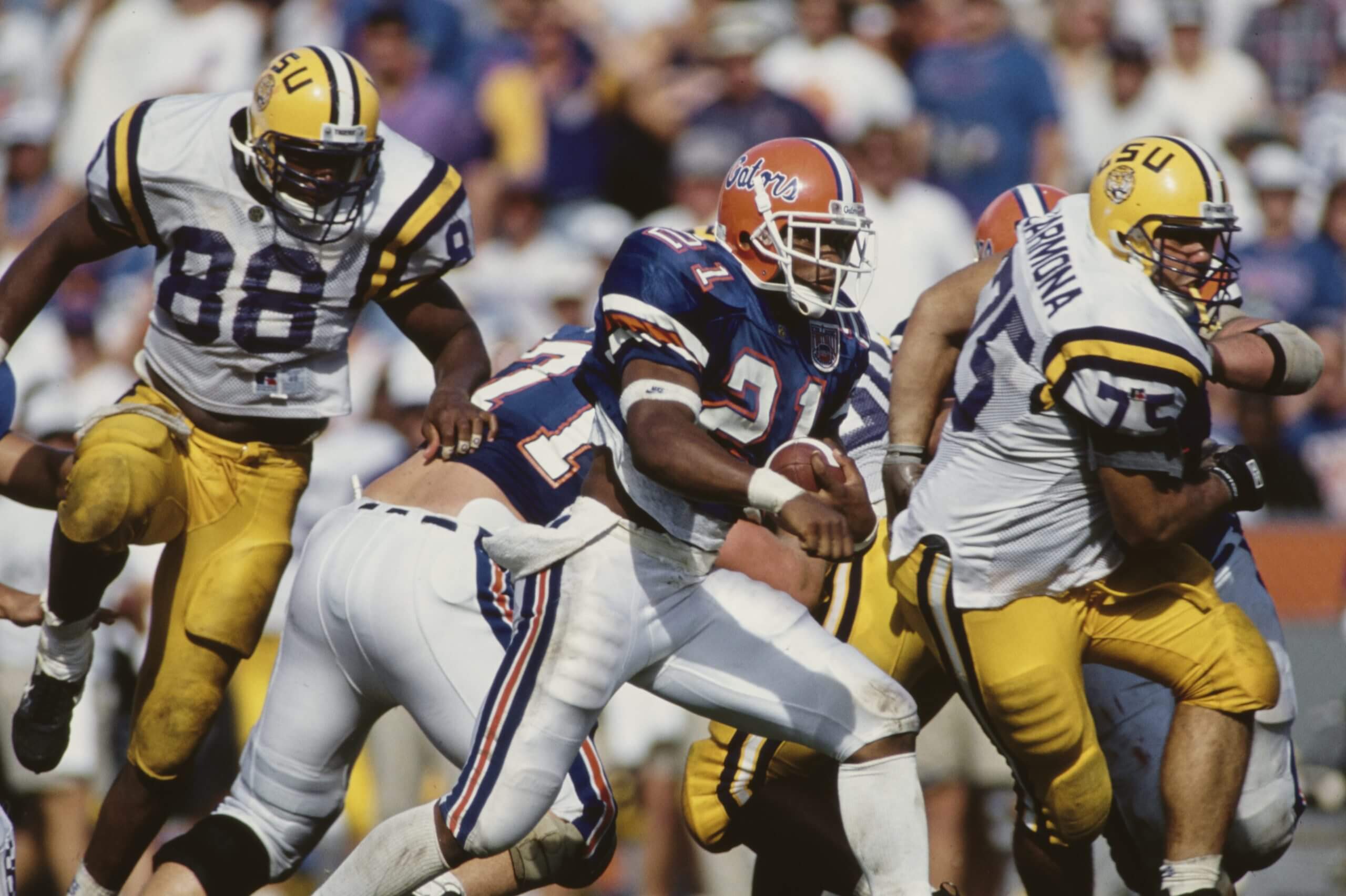

What to know: For much of their mutual existence, these programs battled over who could stay out of last place. But over the past few decades, that has changed. They now rank among the best programs in the new-look Big 12.
- Few, if any, rivalries have a better nickname than “Farmageddon,” a nod to their prowess as world-class agricultural institutions. A Kansas State fan site applied the moniker before their series shifted to Arrowhead Stadium in 2009-10.
- The rivals have competed against one another for 108 consecutive years. That streak is set to expire in 2027 when they rotate off one another’s Big 12 schedules.
- After closing out the regular season the past two seasons, the game moves to Dublin, Ireland, to kick off the 2025 season.
Biggest game: No. 19 Kansas State had hopes of a Big 12 title game appearance when it faced 11.5-point underdog Iowa State in the 2023 finale in Manhattan. As more than 6 inches of snow fell, which christened the game as “Snowmageddon,” the Cyclones outran and outpaced the Wildcats 42-35. Both teams finished 6-3 in Big 12 play and a game out of the Big 12 championship.
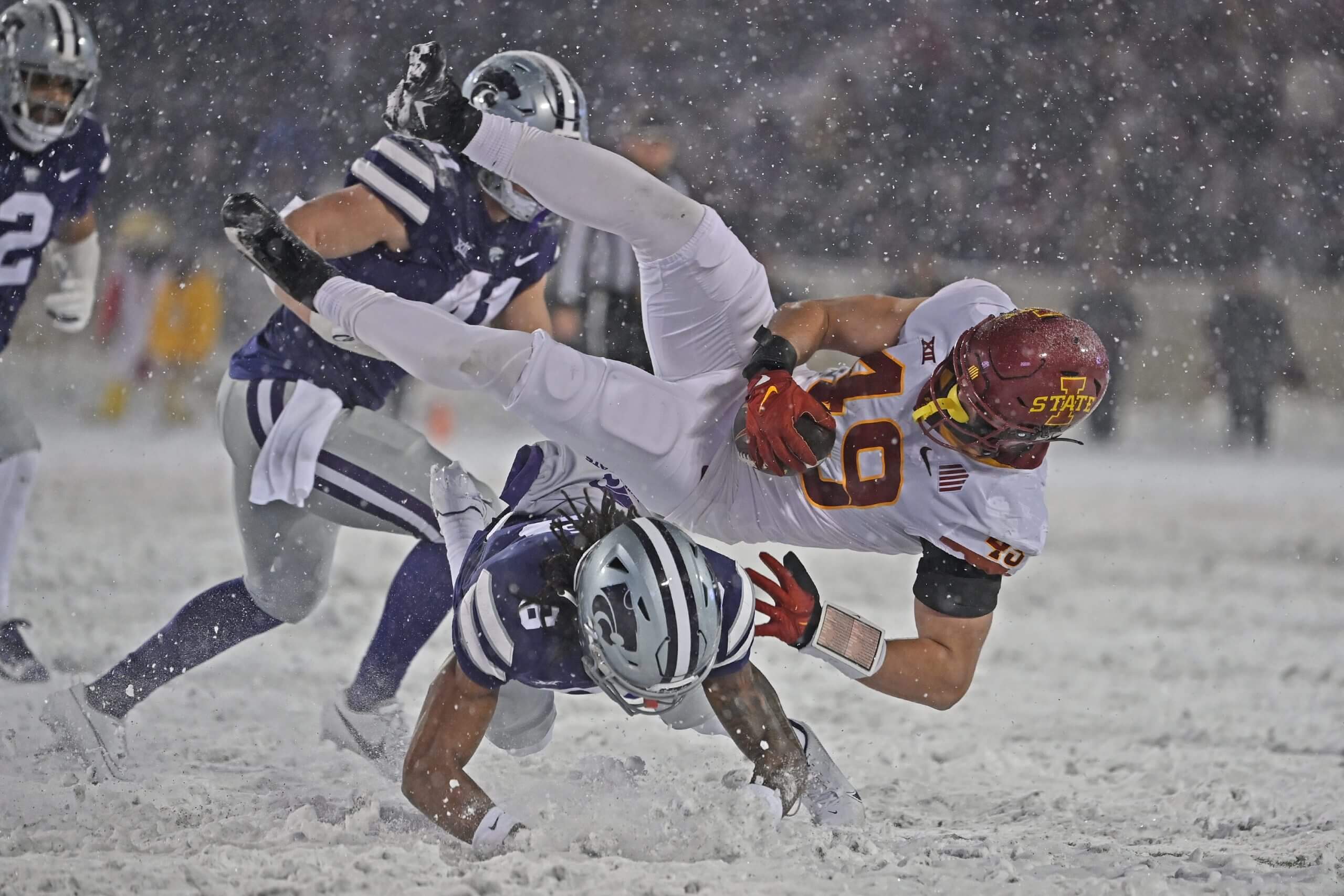

What to know: The best of the NoCal-SoCal rivalries, the Pac-12’s private school tandem combined for 10 Pac-12 titles from 2003-17 and waged several epic battles during that time.
- In their final 23 meetings, at least one team was ranked. Both teams were ranked eight times over that span.
- Twice, the teams met in the Pac-12 championship game. The Cardinal won in 2015, while the Trojans prevailed in 2017.
- Stanford historically is a thorn in USC’s side with six wins when the Trojans are ranked in the top six, including two when USC was ranked No. 2 (2007, 2012), plus a tie against the top-ranked Trojans in 1979. Stanford’s 24-23 upset in 2007 ranks as one of the biggest in college football history. The Trojans were favored by 40.5.
Biggest game: The teams engaged in one of the great shootouts in Pac-12 history in 2011 at the Coliseum with No. 4 Stanford scoring a TD with 36 seconds left to force OT against No. 20 USC. Both teams scored TDs in the first two OTs, and Stanford added another TD to open the third. USC seemed poised to score just two plays into its series, but a fumble at the 1-yard line ended the game in a 56-48 Stanford victory.
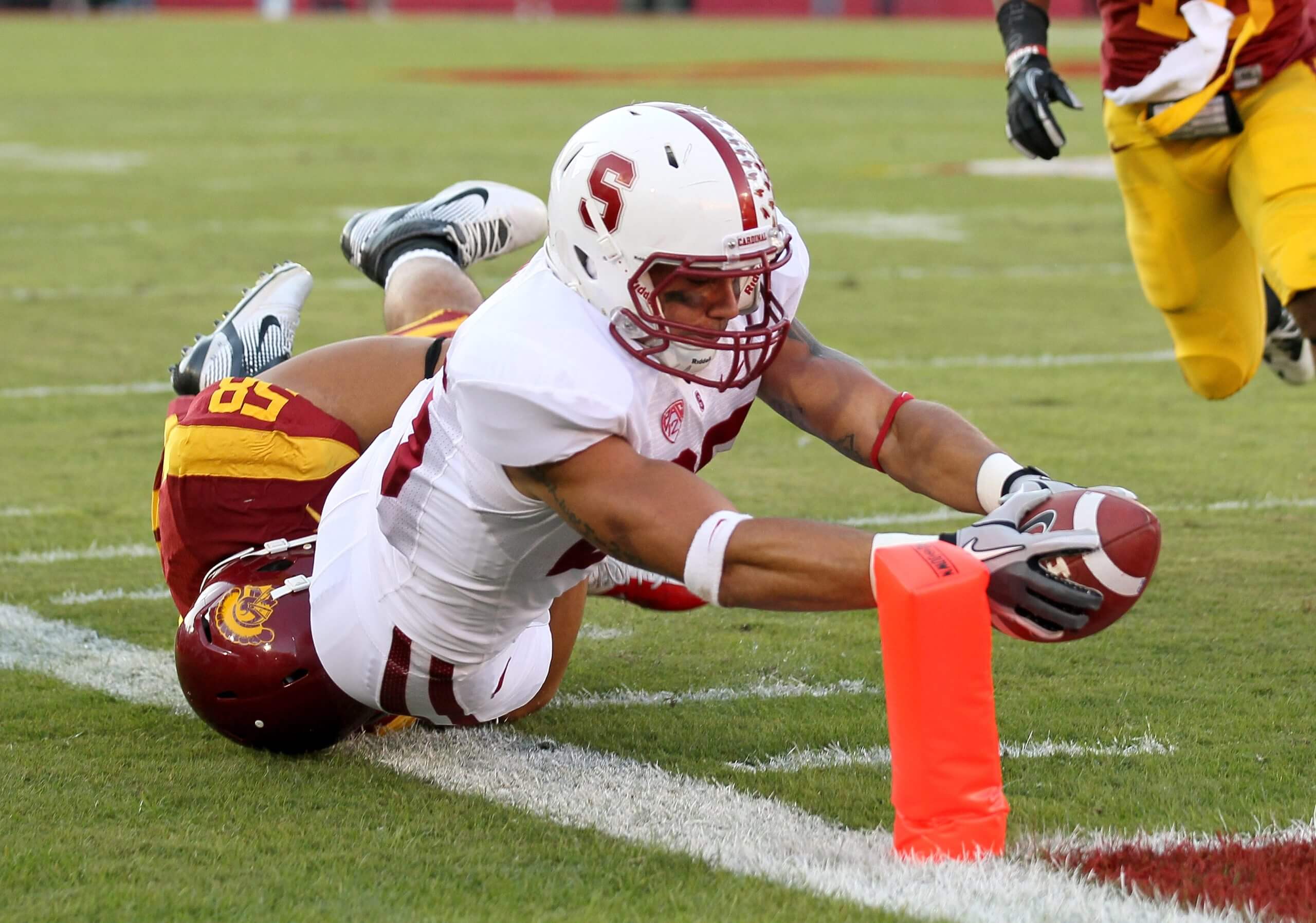

What to know: This series has waned in recent years with Purdue’s fortunes, but this once was a circled game on the calendar for both programs. There were several impactful games and perhaps more upsets in this in-state nonconference series than any other.
- Purdue has beaten top-ranked Notre Dame four times (1950, 1954, 1965, 1967) and won twice when the Irish were No. 2 (1968, 1974).
- Only 110 miles separate the Indiana campuses, and this was an annual battle from 1946 until 2014. They met again in 2021 and 2024 and play again this fall.
- Purdue and Notre Dame have played for the Shillelagh Trophy since 1957. The Shillelagh was donated by Joe McLaughlin, a merchant seaman and a Notre Dame fan who brought the club from Ireland.
Biggest game: In 1968, No. 1 Purdue traveled to South Bend to face the No. 2 Irish. It was the fourth straight season the teams met in a top-10 matchup. Big Ten MVP Leroy Keyes rushed for 90 yards and two TDs, plus threw another one, and the Boilermakers rolled 37-22.
Photo:
Jonathan Daniel/Getty
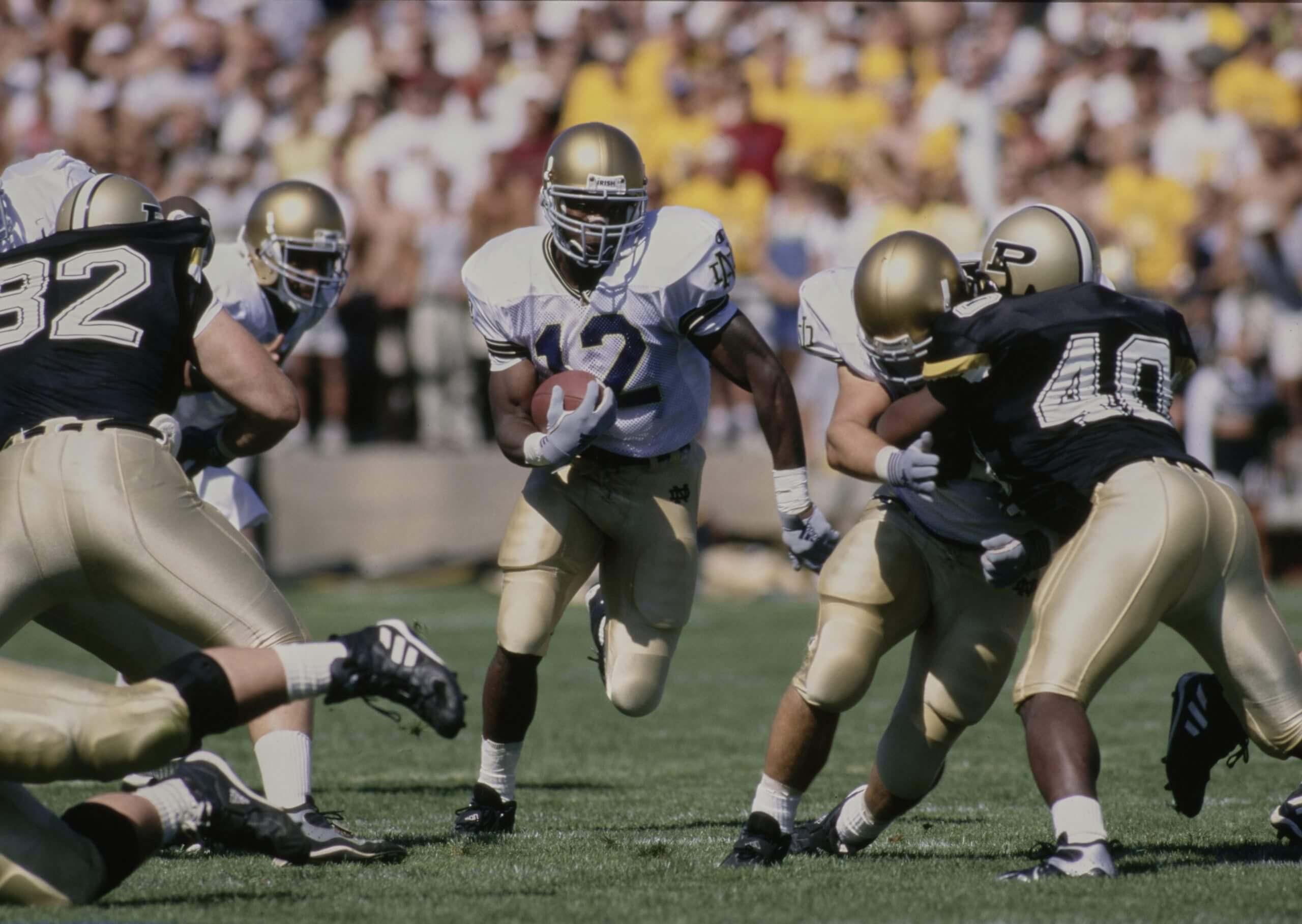

What to know: As one of the premier FCS rivalries, Montana-Montana State often has national implications. One of the two has competed in the FCS title game three of the past four years and 11 times overall.
- This series may have the best nickname — “Brawl of the Wild” — and the teams compete for the Great Divide Trophy. They reside on different sides of the Continental Divide.
- With 122 meetings, this is the seventh most-played FCS series and first among schools outside the Eastern time zone. Outside of a three-year hiatus during World War II plus 2020, the rivals have battled every year since 1925.
- The programs have combined for 39 conference titles and 42 FCS playoff appearances but haven’t met outside the regular season.
Biggest game: In the 2018 season finale, both entered 6-4 with the winner earning an FCS playoff invitation. Montana led 22-7 in the fourth quarter, then Montana State rallied to take a 29-25 lead. With 14 seconds left, the Grizzlies had scored a winning TD from the 1-yard line, but officials waved it off for a Montana State timeout. On the next play, Montana fumbled and the Bobcats recovered to preserve the lead and the win.
Photo:
Steph Chambers/Getty
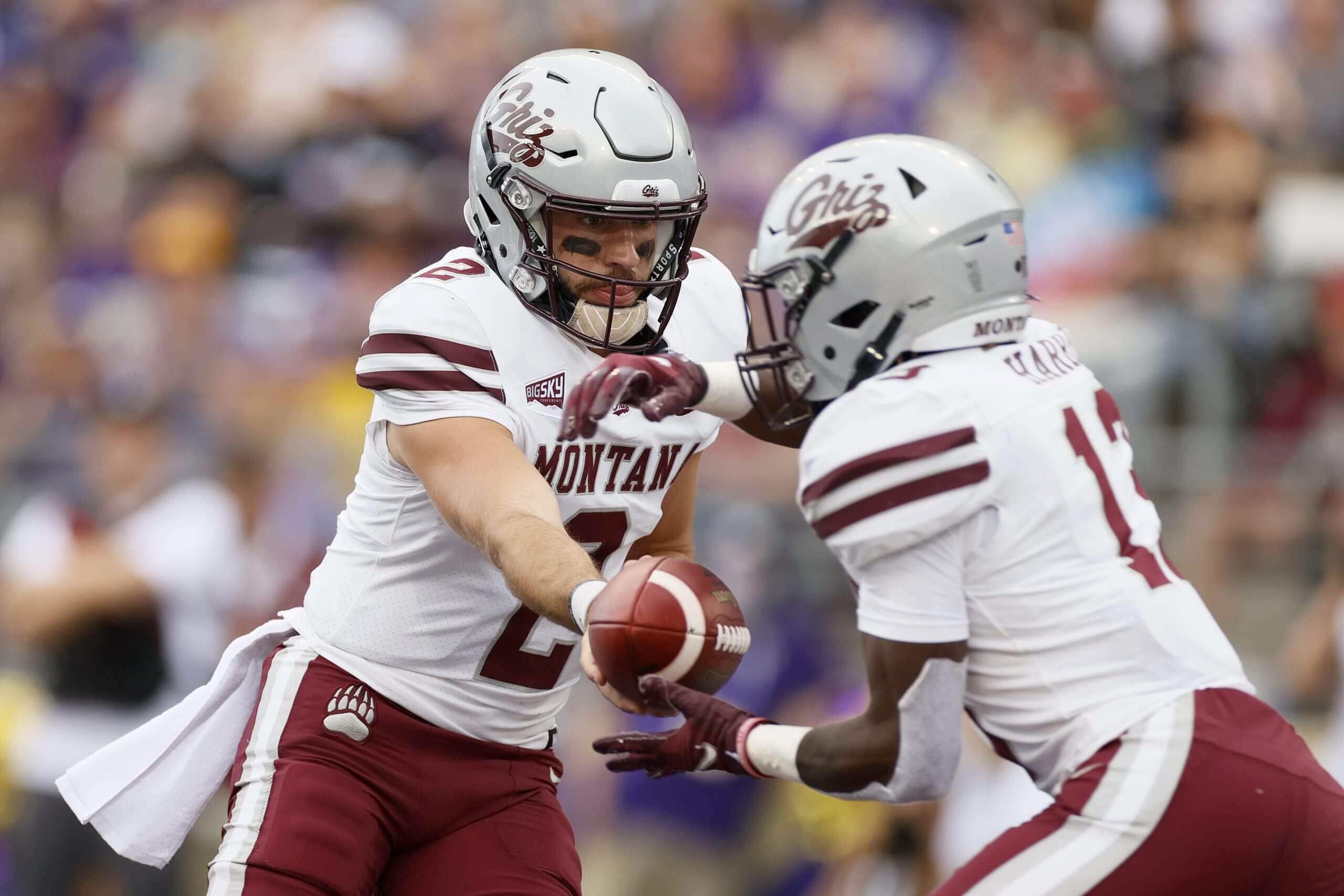

What to know: The longevity is a testament to the schools competing in the same league for more than a century. It’s one of only four protected Big 12 rivalries and matters equally to both fan bases, but outside of Kansas, it doesn’t involve big-picture ramifications the way other in-state series do.
- The Sunflower Showdown ranks third among FBS’ longest uninterrupted rivalries with the schools playing every year since 1911. Only Minnesota-Wisconsin (1907) and NC State-Wake Forest (1910) have longer streaks. With 122 meetings, Kansas-Kansas State sits ninth among the most-played FBS rivalries.
- Kansas State has been ranked 17 times and Kansas six times in their matchup but only once did an unranked team beat a ranked opponent (Kansas’ 30-24 upset in 2007). Only once were both teams ranked (1995).
- In one of college football’s most infamous games, their 17-17 tie in 1987 allowed Kansas State to finish 0-10-1 and Kansas wound up 1-9-1. Neither team beat an FBS opponent.
Biggest game: No. 6 Kansas entered the 1995 Sunflower Showdown unbeaten (7-0) while No. 14 K-State’s only blemish came to eventual national champion Nebraska. But that’s where the competition ended. The Wildcats scored a safety a minute into the game on a bad snap, then blocked a punt and rolled to a 355-19 rushing advantage in a 41-7 victory.
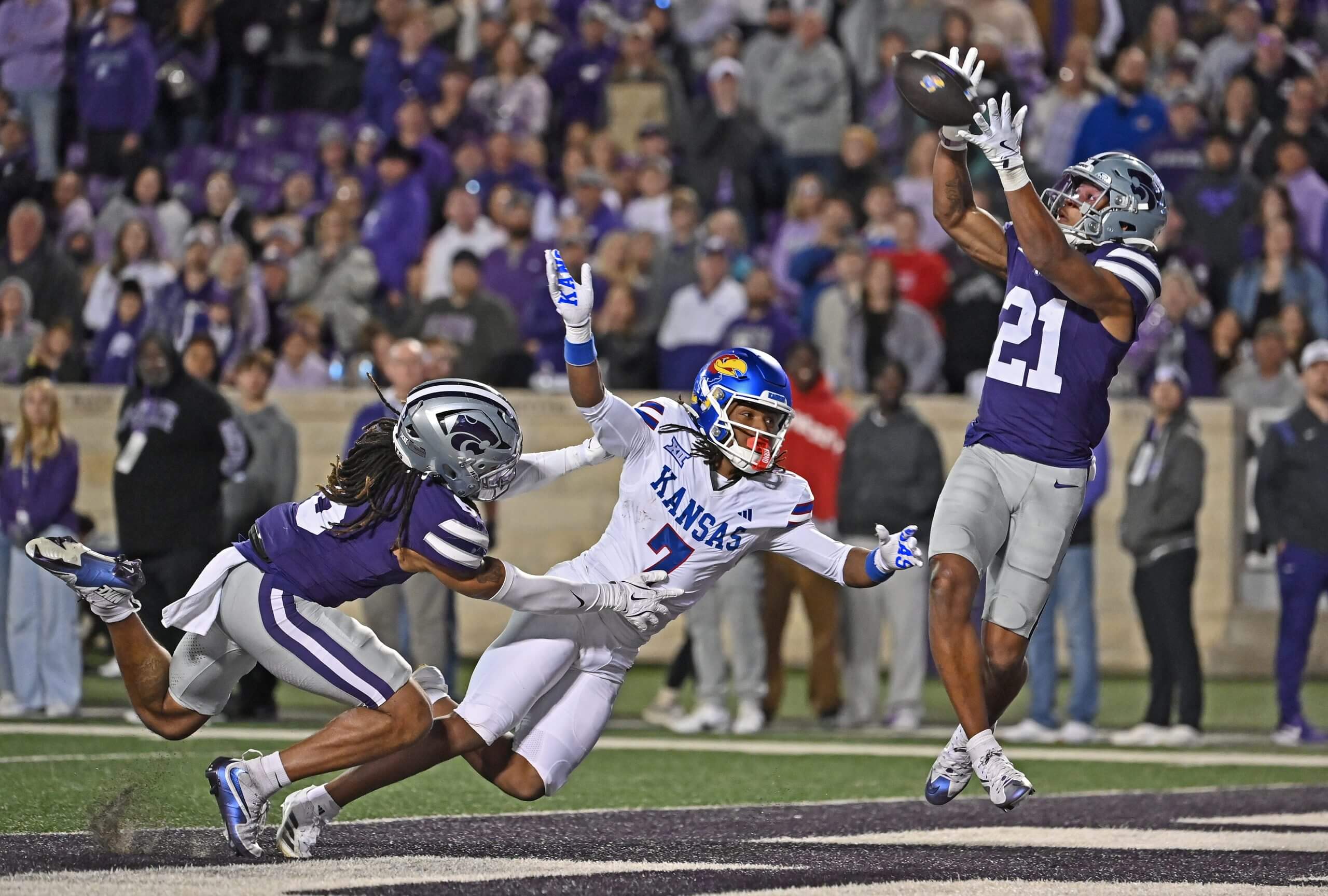

What to know: There’s plenty of feistiness between these two programs when they take the field. But their meetings have become so sporadic that the rivalry doesn’t measure up to their in-state feuds with Florida State.
- The schools played every year but one from 1938-87. They formerly competed for the Seminole War Canoe Trophy, which is on display in Miami.
- Both teams were ranked in nine matchups, including in two of Miami’s national title seasons (1987, 2001). Neither Miami nor Florida was ranked in 1983 when the Gators won 28-3 in the opener, only for the Hurricanes to go on to win their first national title.
- Although Florida was blamed for ducking Miami when the series went on hiatus, SEC schedule expansion from six to seven games was the primary culprit. Counting their upcoming September game, they will have played eight times since 1987.
Biggest game: Following the 2000 season, the teams met in the Sugar Bowl with the SEC champion Gators facing the Big East champion Canes. No. 7 Florida led early in the third quarter, but a combination of penalties, turnovers and special teams errors propelled No. 2 Miami to 24 second-half points in a 37-20 win.
Photo:
Eliot J. Schechter/Getty
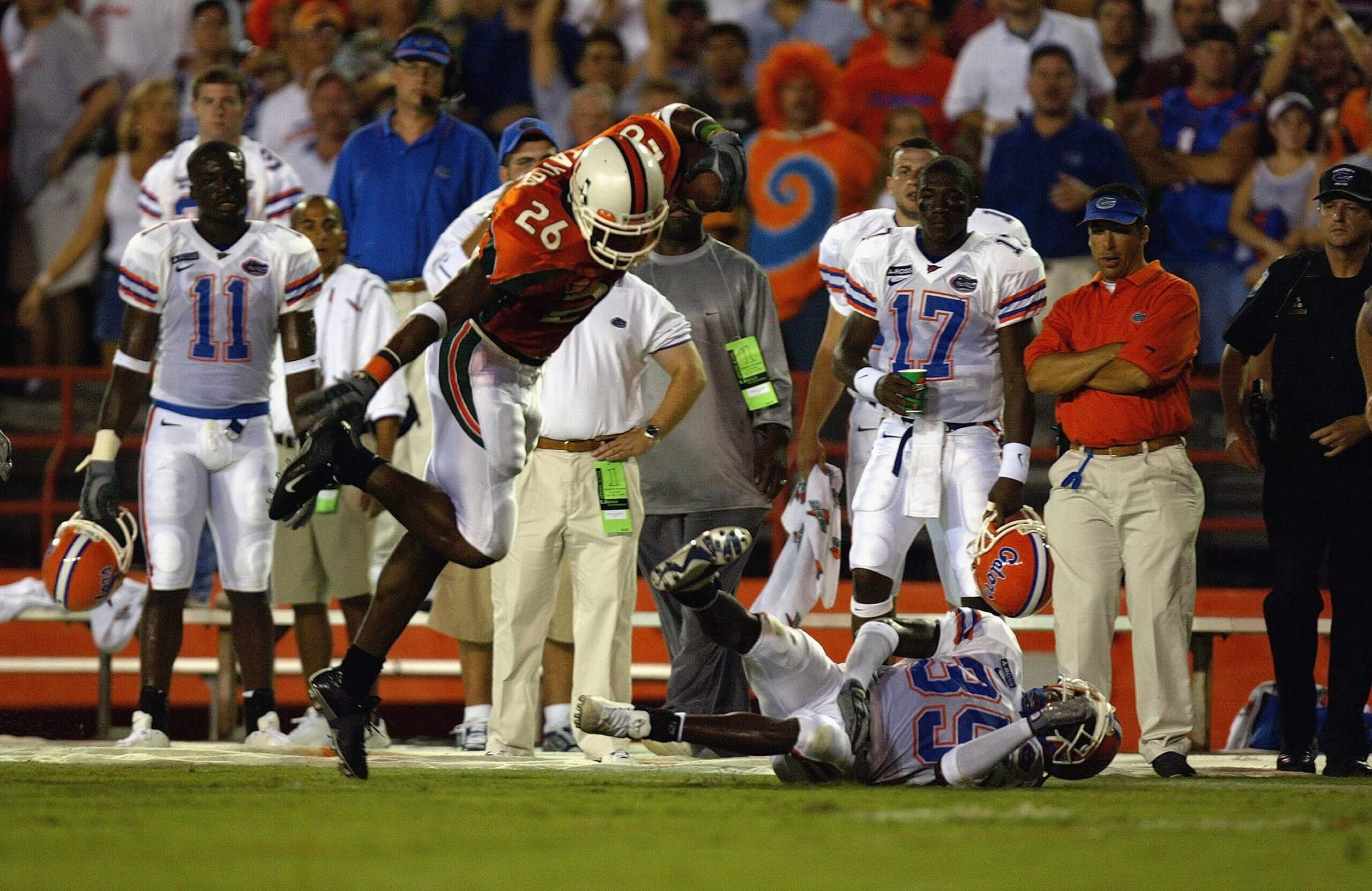

What to know: Both teams have strong rivalries with in-state foes Duke and Wake Forest, while North Carolina competes with Virginia in the second most-played FBS series. But their most heated football rivalry is this one.
- They’ve had three matchups when both teams were ranked in the AP poll (1979, 1993, 2020) and North Carolina won all three.
- UNC built a 31-5-6 series lead before the schools became ACC charter members in 1953. Since then, the Tar Heels lead 37-35.
- Only 28 miles separate Chapel Hill from Raleigh, which contributes to the intensity.
Biggest game: In 2022, No. 18 North Carolina already had locked up the ACC Coastal while NC State was jostling for bowl positioning. With the Wolfpack leading by seven, UNC’s Drake Maye tossed a 4-yard TD pass with no time left to send the game into OT. The Wolfpack prevailed 30-27 in double OT.
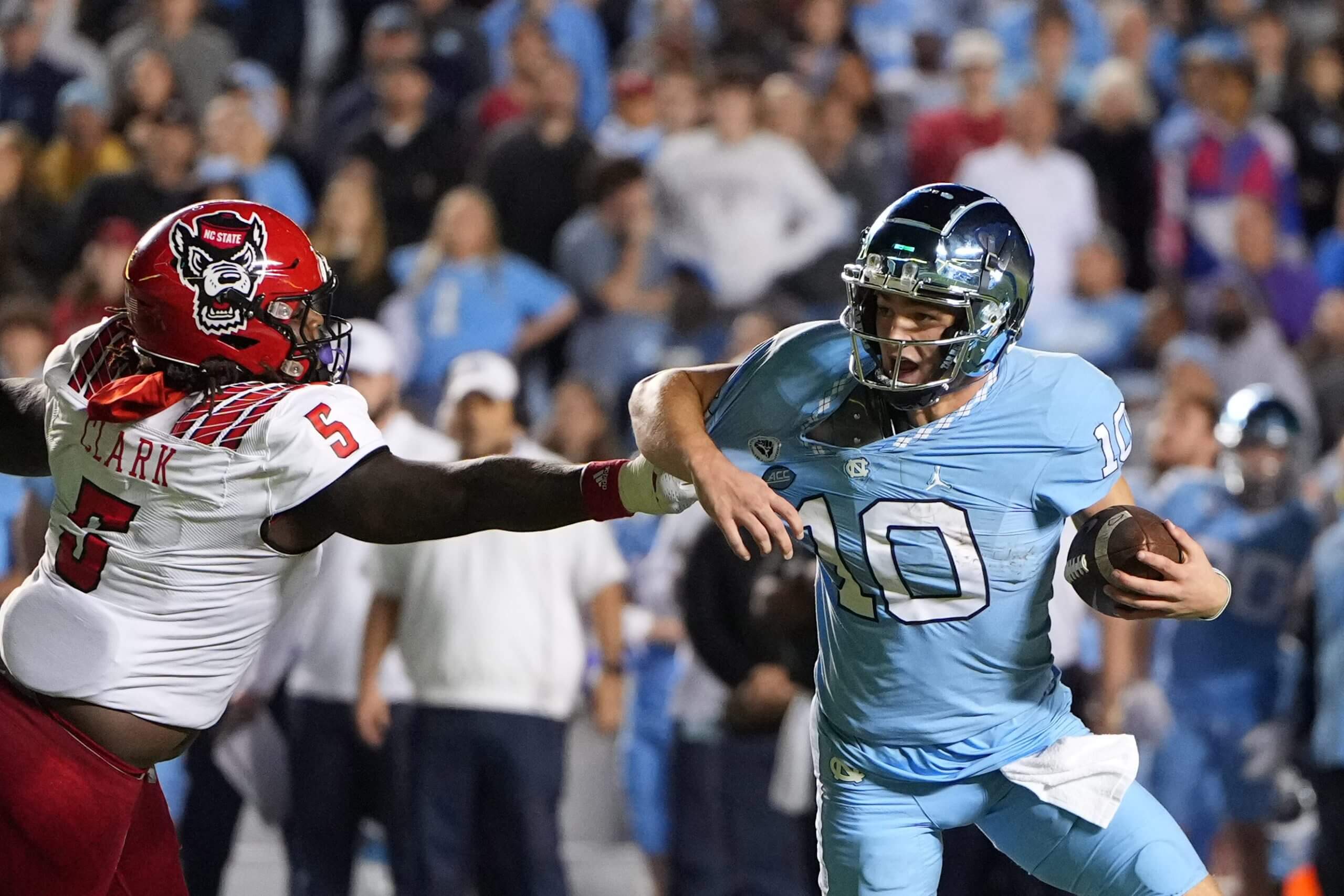

What to know: Few rivalries reached a fever pitch like Notre Dame-Miami in the late 1980s. There was legitimate bad blood between the programs, and it spilled over into pregame encounters. If it was played with more regularity, it would be much higher on the list.
- The teams have competed nine times as ranked foes, including six during the 1980s. Notre Dame holds a 5-4 edge in those games. When they meet in the opener this fall, both are likely to be ranked in the top 15.
- When they battled in the 1985 finale, some Notre Dame supporters — but not coach Gerry Faust — accused Miami counterpart Jimmy Johnson of running up the score in a 58-7 win. Faust had already resigned before the game.
- From 1987-90, one of the teams was ranked No. 1 or No. 2 each year. In three of those four, the higher-ranked team lost, including a pair of No. 1 squads.
Biggest game: The buildup for the 1988 matchup between No. 1 Miami and No. 4 Notre Dame remains unmatched nearly 40 years later. Now known for the “Catholics vs. Convicts” T-shirts, the animosity spilled over into a pregame fracas. The game matched the hype with the Hurricanes cutting the Irish’s lead to 31-30 with 45 seconds left. On a 2-point attempt, Notre Dame CB Pat Terrell deflected Miami QB Steve Walsh’s pass to give the Irish a one-point win that propelled them to their most recent national title.
Photo:
Jonathan Daniel/Getty


What to know: This ranking is based strictly on prominence. They were the two best football programs of the 2010s and their battles are worthy of more mention as some of the best games in college football history.
- From 2015-18, Clemson and Alabama met each year in the Playoff, including three times for the national title. They split those games 2-2 with two dramatic finishes and two blowouts.
- Outside of the CFP, their shared history is sparse. They’ve played five times over the past 50 years, all at a neutral site. Their only non-CFP game took place in the 2008 opener in Atlanta.
- Clemson won the first three games from 1900-05, then the Crimson Tide won 13 straight until the 2016 national title game.
Biggest game: Their CFP championship battles following the 2015 and 2016 seasons tie in this category. In a fourth quarter that produced 40 combined points, Alabama’s Derrick Henry punched in the game-clinching touchdown in a 45-40 win for the 2015 title. In the CFP rematch in 2016, Clemson QB Deshaun Watson completed a 2-yard TD pass to Hunter Renfrow with 1 second left for a 35-31 win.
Photo:
Christian Petersen/Getty
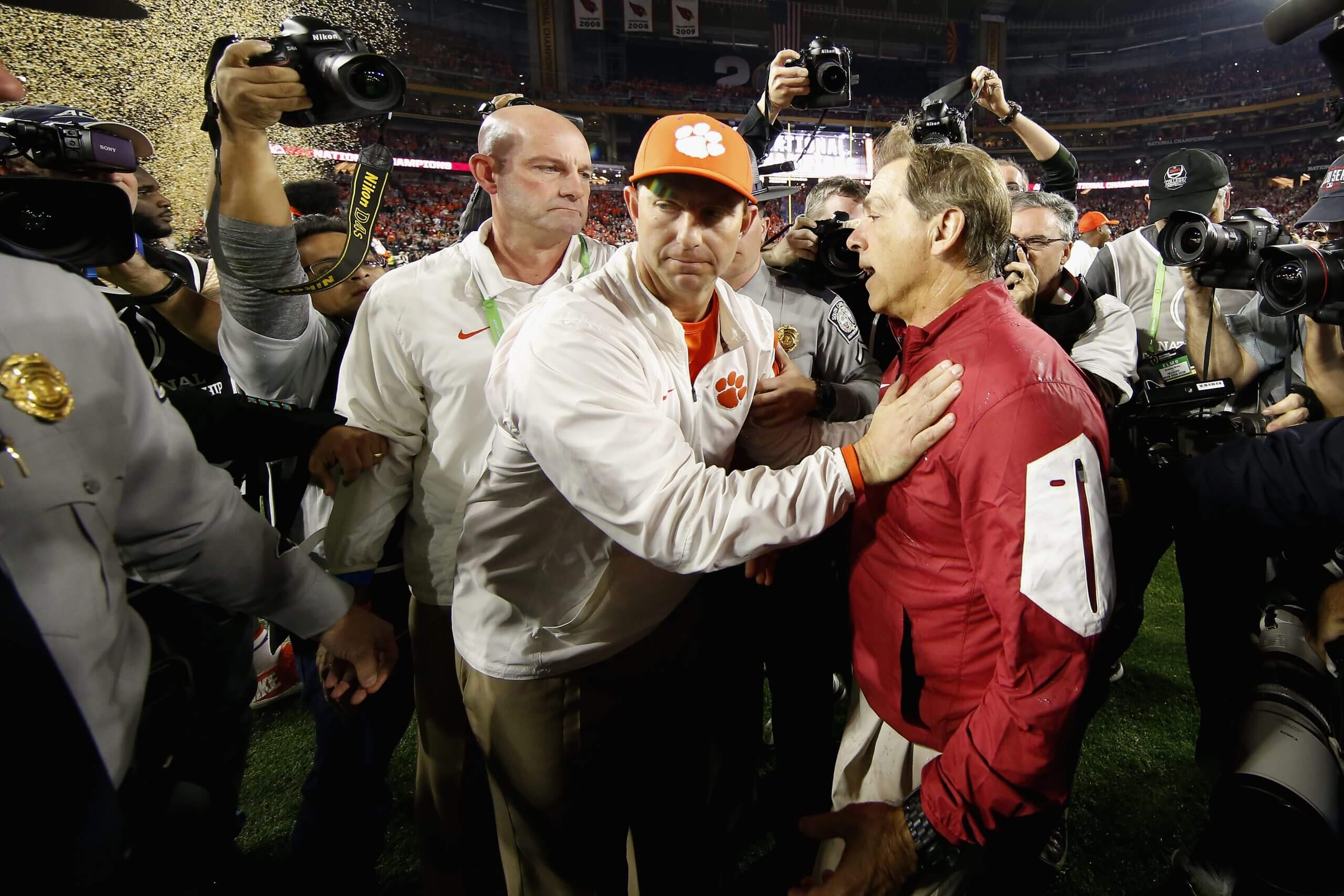

What to know: The Sun Devils and Wildcats form a red-hot in-state rivalry no matter their records. They’ve rarely had games impacting more than the series ledger, but after moving to the Big 12, there’s a chance it climbs the list.
- The Territorial Cup between Arizona and Arizona State is considered the oldest traveling trophy series in the FBS. Arizona State won the original Territorial Cup in 1899, but it was lost and eventually found in a vault at a Tempe church. The Cup was reestablished as the official trophy in 2001.
- In what’s known as the “Duel in the Desert,” the teams have played four times as ranked opponents with a 2-2 split.
- The teams joined four conferences in tandem over the last century. They were charter members of the Border Conference from 1931-61, then joined the WAC in 1962. They bolted for the Pac-8 (and later iterations) in 1978, where they resided until 2024, when they joined the Big 12.
Biggest game: In 2014, the rivals engaged in a winner-take-all Territorial Cup in Tucson for the Pac-12 South title. With a 42-35 lead in the final two minutes, Arizona forced an errant Arizona State pass on fourth down to earn a Pac-12 title game invitation.
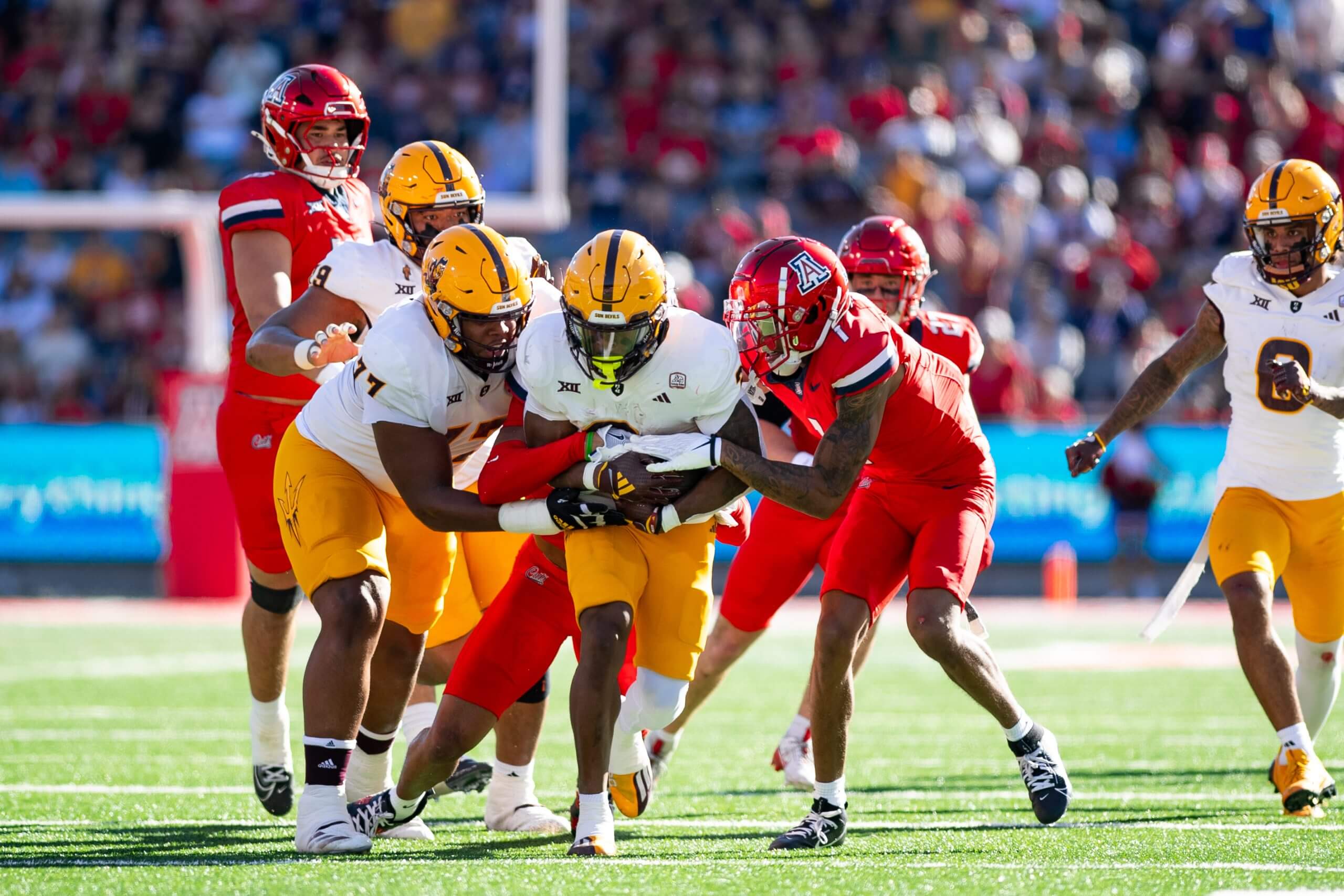

What to know: After they had little shared history before the SEC expanded to 12 teams, this has become one of the league’s most important series. Depending on how often they play in the future, it could soar into a top-30 rivalry or fall back.
- Barely 200 miles separates Athens from Knoxville, but the teams rarely faced one another before they were paired in the SEC East in 1992. They didn’t even play from 1937-68 and after that met just eight times until divisional play began.
- The Bulldogs and Vols have still met 19 times as ranked opponents. That’s tied for 20th among FBS series.
- The teams claim a combined 13 national titles (Georgia 7, Tennessee 6) but they met in only four of those seasons, all from 1980 onward.
Biggest game: In the first No. 1 vs. No. 2 matchup in Sanford Stadium history, the top-ranked defending national champion Bulldogs and second-ranked Vols met while 8-0 in 2022. Georgia’s all-world defense produced six sacks and held Tennessee’s high-flying offense to 289 yards in a 27-13 rout. The Bulldogs later won their second straight national title.
Photo:
Todd Kirkland/Getty
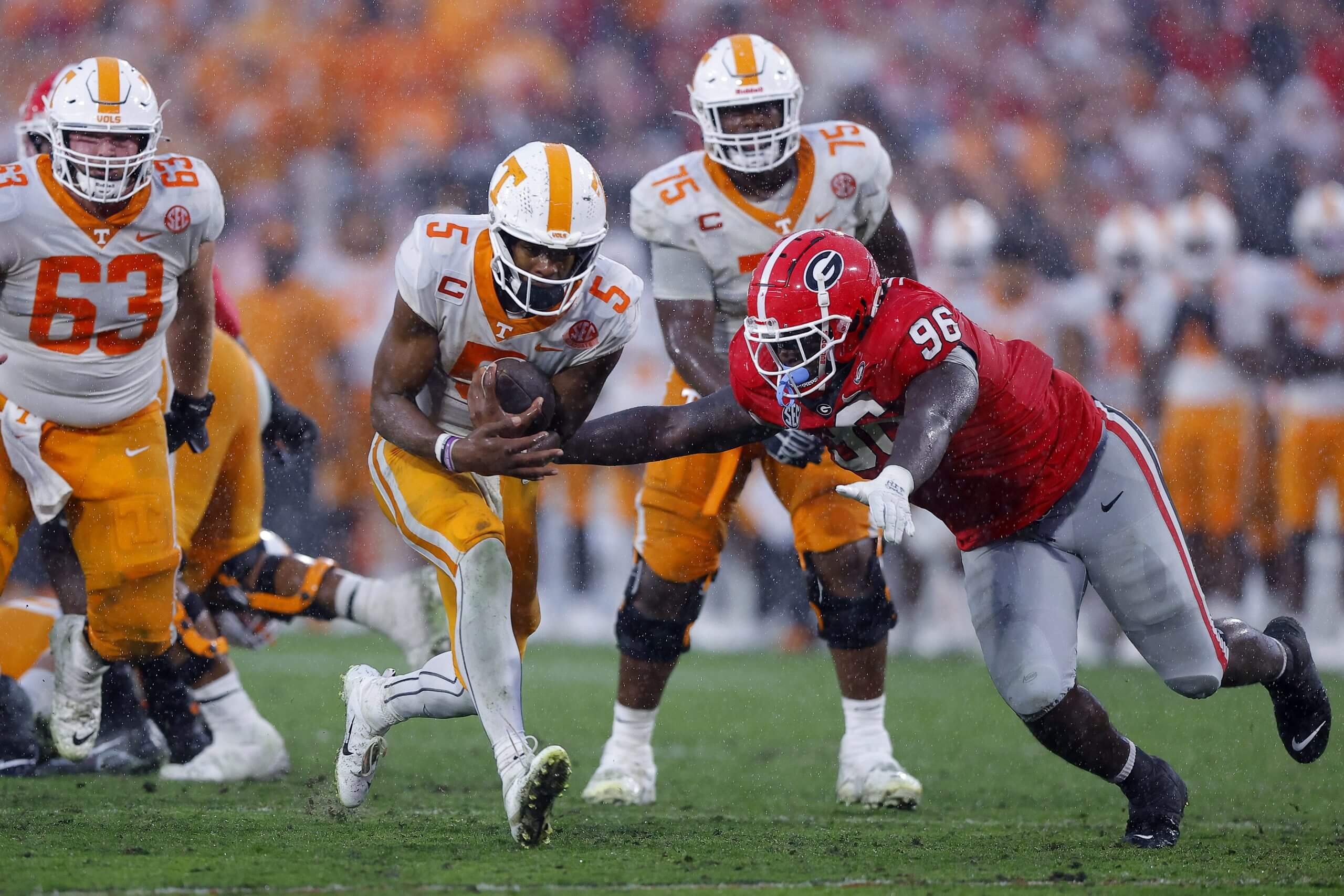

What to know: Clemson-Florida State has developed into the ACC’s most prominent series with the teams claiming 13 of the last 14 conference titles. Yet they rarely have outstanding seasons concurrently.
- Both competed in the ACC Atlantic from 2005 until 2022 so they have never faced each other in the ACC title game. Now that hurdle is lifted, which could lead to bigger games with higher stakes.
- The teams have met 12 times while both ranked since 1988, which was four years before the Seminoles joined the ACC. FSU is 8-4 in those games. The only significant upset between the teams took place in 2003 when unranked Clemson popped No. 3 Florida State 26-10.
- In the ACC’s division-less structure, Clemson and FSU are protected rivals scheduled to play annually through 2030.
Biggest game: No. 3 Clemson and No. 5 Florida State entered their prime-time showdown in 2013 unbeaten with the winner stamping itself as a true national title contender. That’s exactly what FSU did in an epic 51-14 beatdown. Heisman winner Jameis Winston threw for 444 yards and led the Seminoles to the final BCS title.
Photo:
Streeter Lecka/Getty
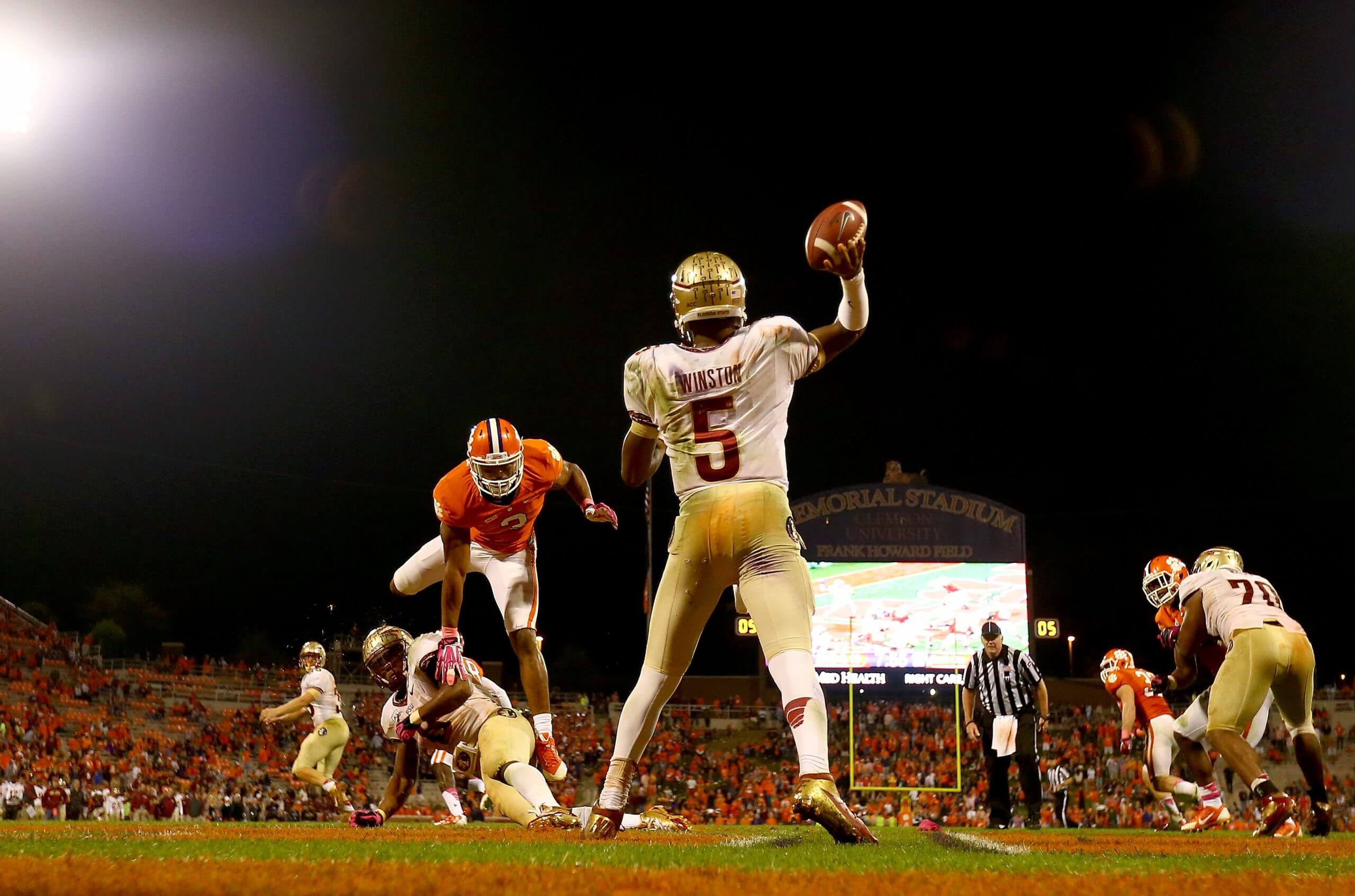

What to know: In the Big Ten’s first five decades, Michigan-Minnesota was its most prominent rivalry. Although both schools had more heated border foes, these programs played every season and often for the Big Ten title.
- In 1903, Michigan coach Fielding Yost brought a 28-game winning streak and an oversized jug to Minnesota for a Halloween battle. After a 6-6 tie, Yost left his jug behind. He asked for its return but Gopher officials told him, “If you want it, you’ll have to win it.” Michigan won it back in 1909 and the Little Brown Jug became the Big Ten’s first traveling trophy.
- The programs dominated the Big Ten from its inception in 1896 through the end of World War II. Over that 50-year period, Michigan and Minnesota each won 16 Big Ten championships. Michigan claims eight national titles and Minnesota has six over that span.
- Minnesota-Michigan was a permanent Big Ten rivalry from 1919-98, skipping just one year (1928).
Biggest game: The Big Ten and national titles were at stake when No. 2 Minnesota and No. 3 Michigan met in 1940 in Minneapolis, and the game did not disappoint. Minnesota’s Bruce Smith, who won the Heisman in 1941, scored on an 80-yard run to hold off 1940 Heisman winner Tommy Harmon in a 7-6 victory. It was the signature win in the Gophers’ fourth national title run in a seven-year span.
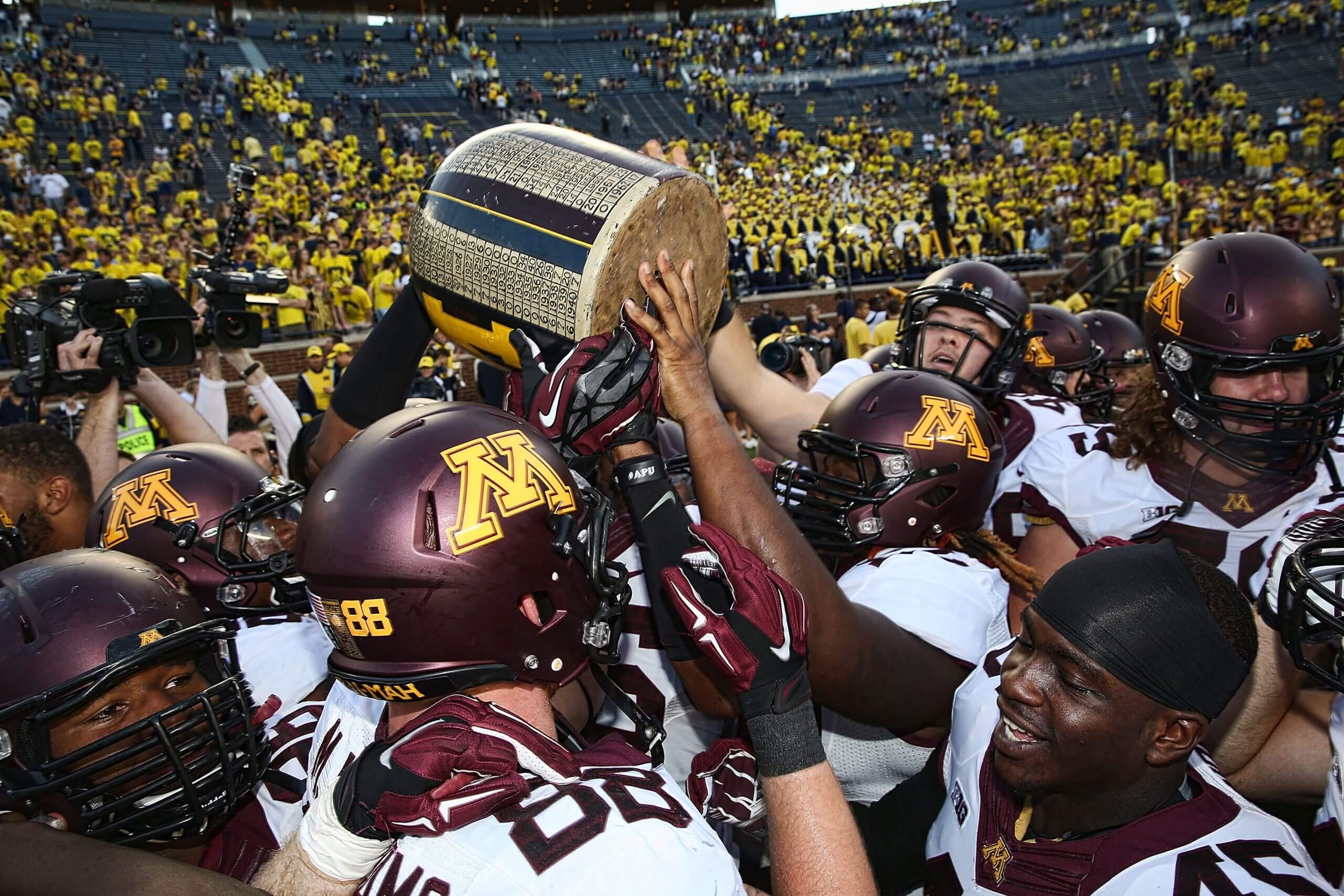

What to know: If this were an annual series, it easily would soar into the top 10, perhaps the top five. The teams don’t play regularly enough to count it as a true rivalry, but they are the SEC’s top programs and every time they face off there are national implications.
- Since 2008, they have played nine times while both ranked in the top 10. Four times they competed in the SEC championship game (Alabama won all four) and twice they battled for the CFP title (Alabama won in 2017, Georgia in 2021).
- An insurance salesman listened to a phone call between Alabama coach Bear Bryant and Georgia AD (and former coach) Wally Butts in 1962, and the information led to a story alleging a fixed outcome between the teams. Butts sued the Saturday Evening Post for libel and won.
- They met each year from 1944-65 but have played sporadically in the regular season the last six decades. Since 2008, they’ve played just three times in the regular season.
Biggest game: It doesn’t get bigger than what they faced in 2017 and 2021 national title games. The Bulldogs took the second matchup 33-18, but it’s the first that goes down in history. Down 13-0 at halftime, Alabama coach Nick Saban benched Jalen Hurts in favor of Tua Tagovailoa. The game went into OT, where Tagovailoa hit future Heisman winner DeVonta Smith for a 41-yard TD on second-and-26 for the 26-23 victory.
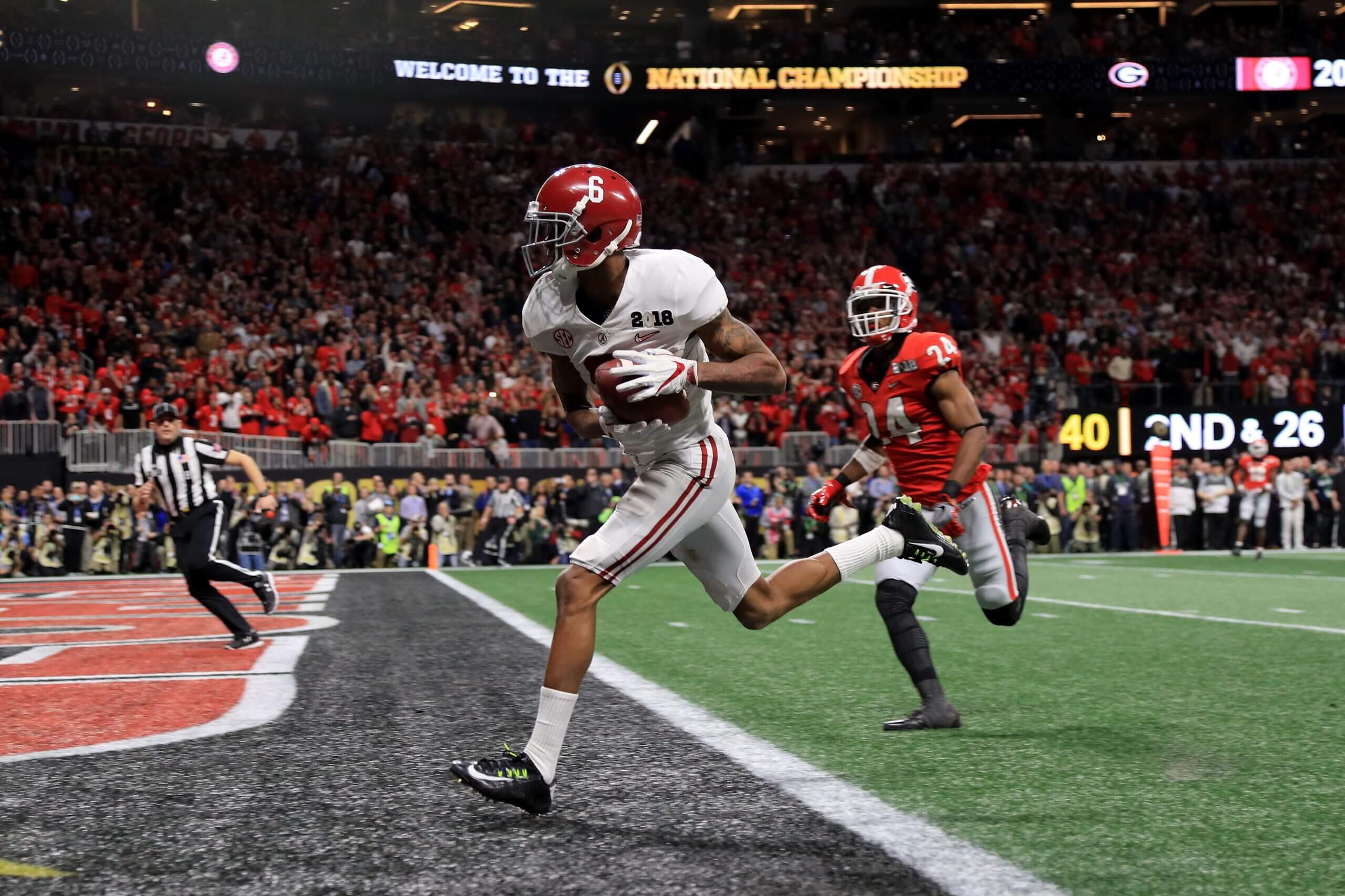

What to know: With 126 meetings, Indiana-Purdue ranks second in games played among Big Ten rivalries, behind only Wisconsin-Minnesota. It’s a historic series, but its impact has limited reach.
- Since 1925, the teams have competed for the Old Oaken Bucket. The idea was created through a committee, which felt that a bucket was “the most typical Hoosier form of trophy.” The bucket was found on a southern Indiana farm and its estimated age is 180 years old.
- The teams played 100 consecutive games from 1920-2019 before the series was interrupted by COVID-19. They rescheduled their game multiple weeks in a row, but the infection numbers were too high and it was canceled.
- The teams have played just once as ranked opponents, in 1945. Overall, Purdue has been ranked 14 times (mostly recently 2003) entering the Bucket game, while the Hoosiers have been ranked just six times, including in 2024.
Biggest game: A Rose Bowl bid was at stake for the 1967 finale between No. 3 Purdue and unranked Indiana (the AP ranked only 10 teams that year). The Hoosiers kept the Boilermakers out of the end zone multiple times in the fourth quarter and held on 19-14. The teams finished tied at 6-1 alongside Minnesota atop the Big Ten, and the Hoosiers earned the trip to Pasadena. Indiana finished No. 4 in the final poll while Purdue was ninth.
Photo:
Justin Casterline/Getty
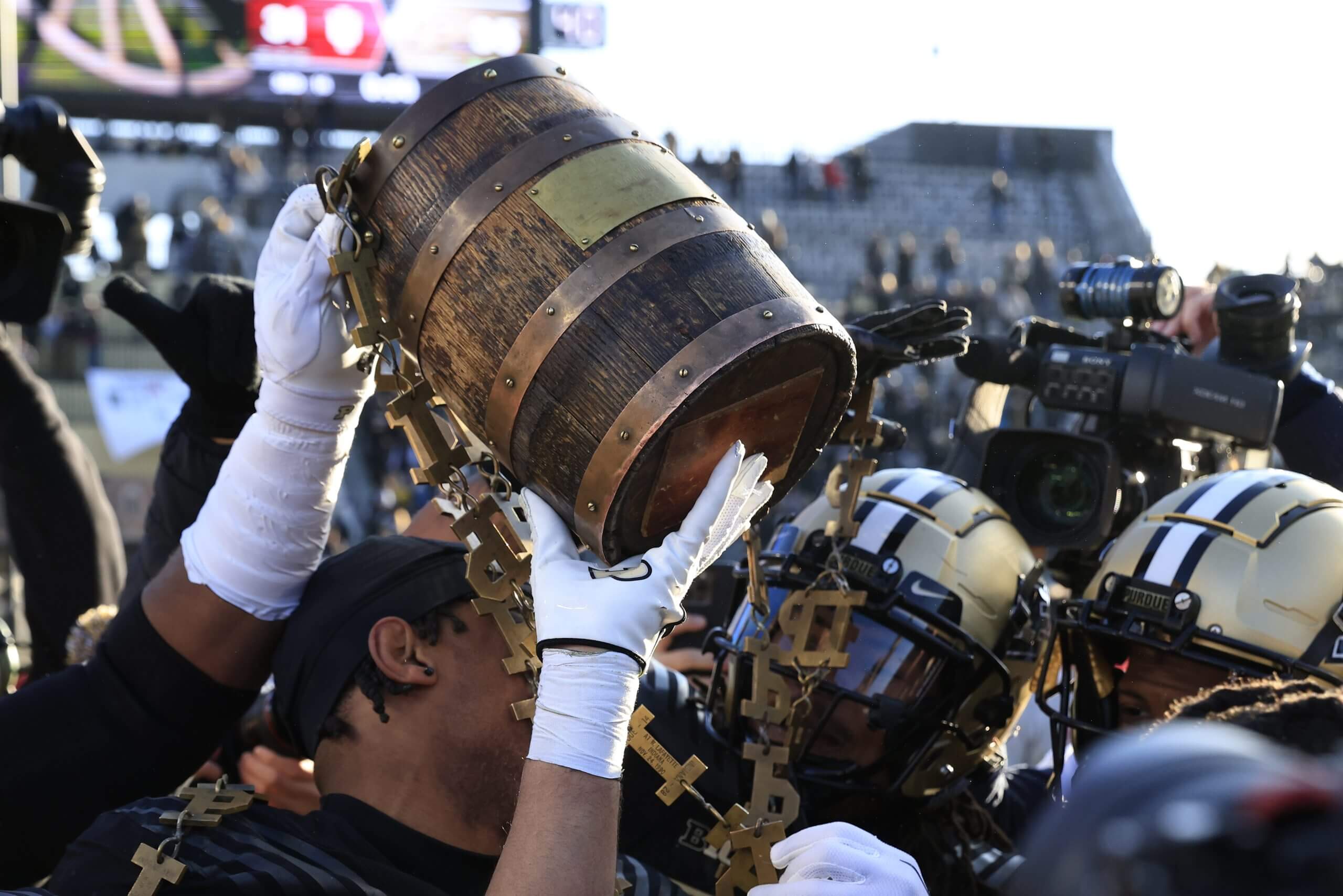

What to know: LSU-Arkansas may have an uncertain future as an annual series in the SEC, which perhaps knocks it back a few spots, but over the past 24 years, these teams have played 15 one-score games and seven were upsets. It has developed into a true rivalry.
- The teams compete in the “Battle for the Boot,” a 24-karat gold, 200-pound trophy that stands 4 feet tall and is shaped like the states of Louisiana and Arkansas. It’s the heaviest traveling trophy in college football and first began in 1996.
- From 1913-36 (save for 1918), the teams met every year in Shreveport, La. Then, outside of a four-game series in the 1950s and two Cotton Bowls, they didn’t play again until Arkansas joined the SEC in 1992.
- Arkansas-LSU became either a Black Friday or Thanksgiving Saturday staple from 1992-2013 before the SEC switched the regular-season finales to Texas A&M (LSU) and Missouri (Arkansas in 2014) through 2023.
Biggest game: In a series marked by thrilling games and finales, nothing compared to their 2007 Black Friday matchup in Baton Rouge. Top-ranked LSU faced a rushing juggernaut in Arkansas and the teams battled into triple OT before the Razorbacks pulled out a 50-48 upset. The loss initially seemed to knock the Tigers out of the national title chase, but LSU survived and eventually claimed the BCS championship.
Photo:
Chris Graythen/Getty
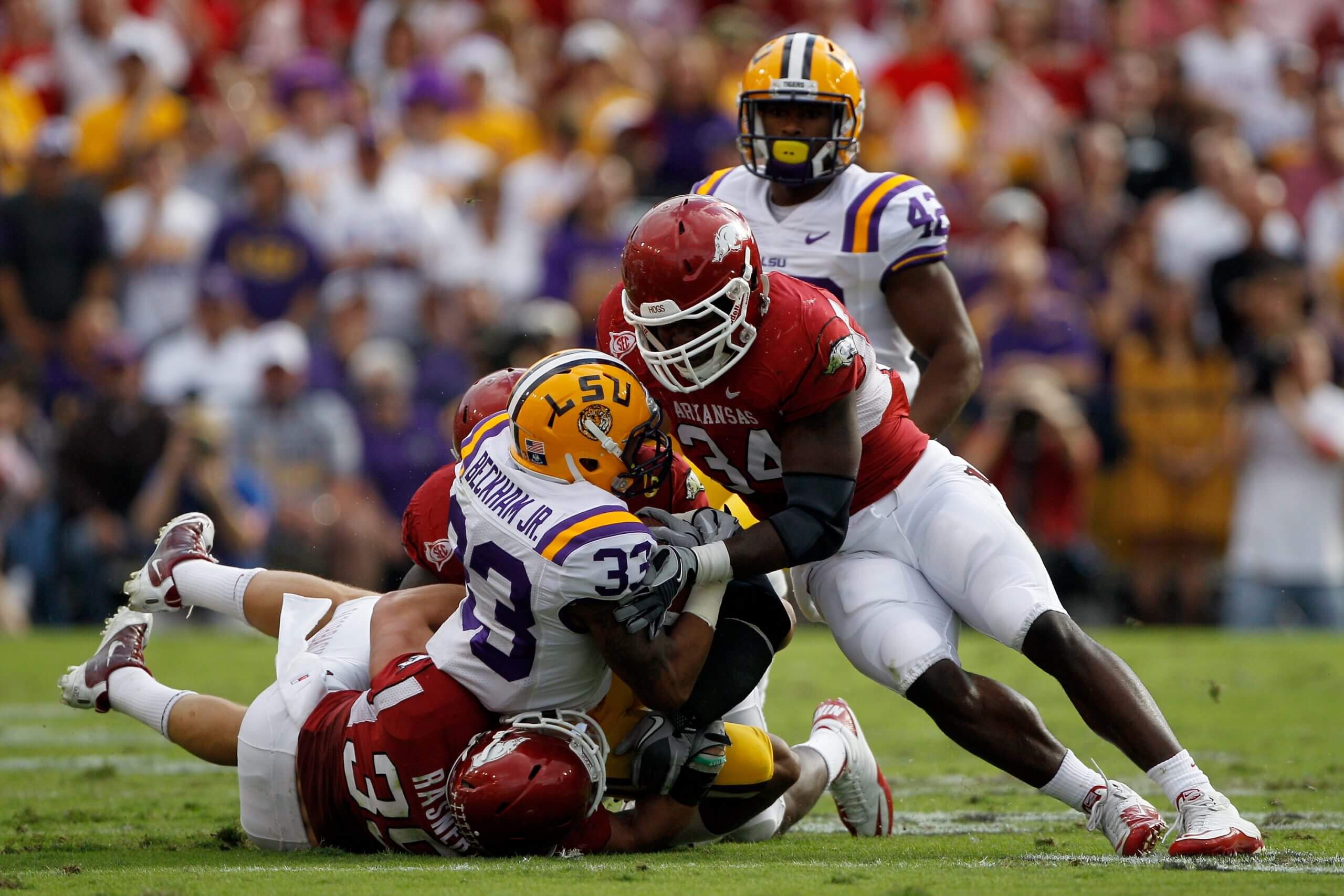

What to know: The first major round of realignment in the early 1990s created this series, and it quickly developed into a rivalry. They have combined for 12 Big Ten titles since Penn State’s Big Ten inaugural season, and they boast the nation’s two largest stadiums. When the Wolverines and Nittany Lions play, it regularly becomes one of the season’s most-viewed games.
- The teams never met until 1993. The Big Ten’s policy of no bowl games outside of the Rose Bowl until 1975 was a big factor.
- Longtime Michigan coach and AD Bo Schembechler was against Penn State joining the Big Ten. Schembechler’s outspoken criticism nearly swayed Big Ten colleagues with Penn State’s entry passing by one vote, 7-3.
- Both teams were ranked in their first seven matchups and 14 of 27. Four times both were in the top 10, and Michigan has won three of those.
Biggest game: In 2005, unbeaten Penn State rallied from a touchdown deficit to lead Michigan by four points inside the final minute. The Wolverines stormed down to the Penn State 10-yard line with 1 second left. On the next snap, Michigan QB Chad Henne found Mario Manningham on a slant for a touchdown to hand the Nittany Lions their only loss that season, 27-25.
Photo:
Brian Bahr/Allsport
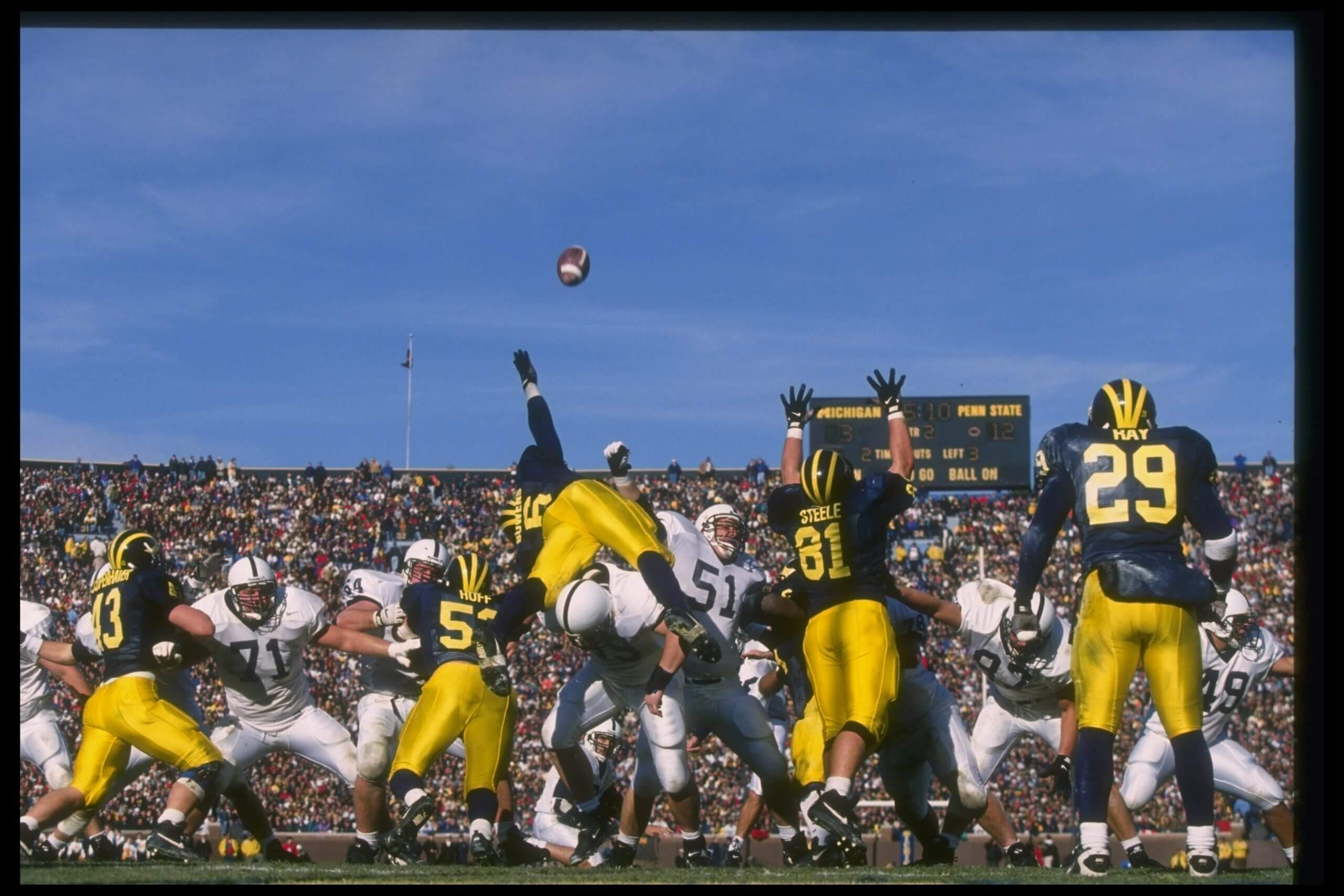

What to know: Familiarity breeds contempt. TCU and SMU are in the Dallas-Fort Worth metroplex and compete for everything from athletes to fans to media attention. The disdain the programs have for one another adds spice, no matter their records.
- Known as “The Battle for the Iron Skillet,” this Metroplex rivalry has survived multiple conference switches to remain intact. TCU, however, chose to end the series after this season’s matchup.
- From 1925 through this fall, the Horned Frogs and Mustangs will have played 97 times, missing games only during SMU’s program suspension (1987-88) and in 2006 when TCU left Conference USA just as SMU arrived.
- TCU and SMU have never met as AP-ranked opponents, though their biggest game happened one season before the AP poll began.
Biggest game: Their 1935 showdown received “Game of the Century” distinction and lived up to the billing. With the score tied 14-14 in the fourth quarter and SMU facing fourth-and-4, the Mustangs’ Robert Finley connected with Bobby Wilson for a 37-yard TD. SMU (12-1) won the Southwest title, landed in the Rose Bowl and claimed a piece of the national title. Behind superstar QB Sammy Baugh, TCU (12-1) played in the Sugar Bowl.
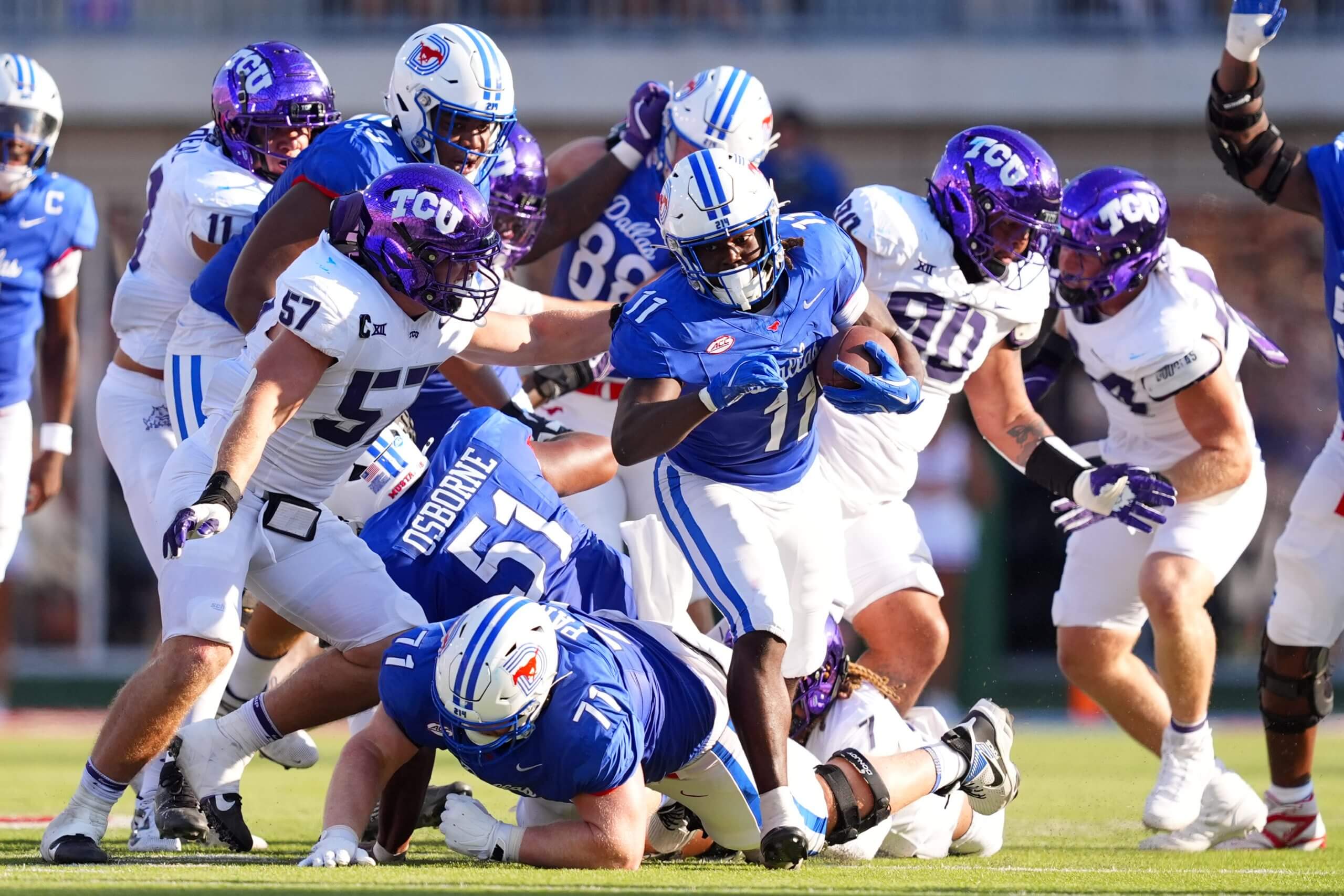

What to know: Michigan State and Notre Dame sit about 145 miles from one another, and that proximity made this a series of convenience. But their battles in the 1950s and 1960s and the constant swirl of upsets became legendary.
- From 1948-2013, this became an annual series, save for four seasons. The teams never played at a neutral site and their game served as an early-season barometer.
- The teams have 14 ranked matchups with the Spartans holding an 8-5-1 lead. Four of those games qualified as upsets.
- As one of the most unpredictable rivalries, ranked teams lost 10 times to unranked foes. Michigan State won eight of those, including five when Notre Dame was in the top 10. Those upsets occurred in five different decades.
Biggest game: Their 1966 battle between No. 1 Notre Dame and No. 2 Michigan State at East Lansing was one of many labeled “Game of the Century,” but the 10-10 tie lacked satisfaction. Notre Dame coach Ara Parseghian chose to run out of the clock on the ground rather than go for the win. It worked for the Irish, who won the AP national title over the Spartans.
Photo:
Jonathan Daniel /Allsport
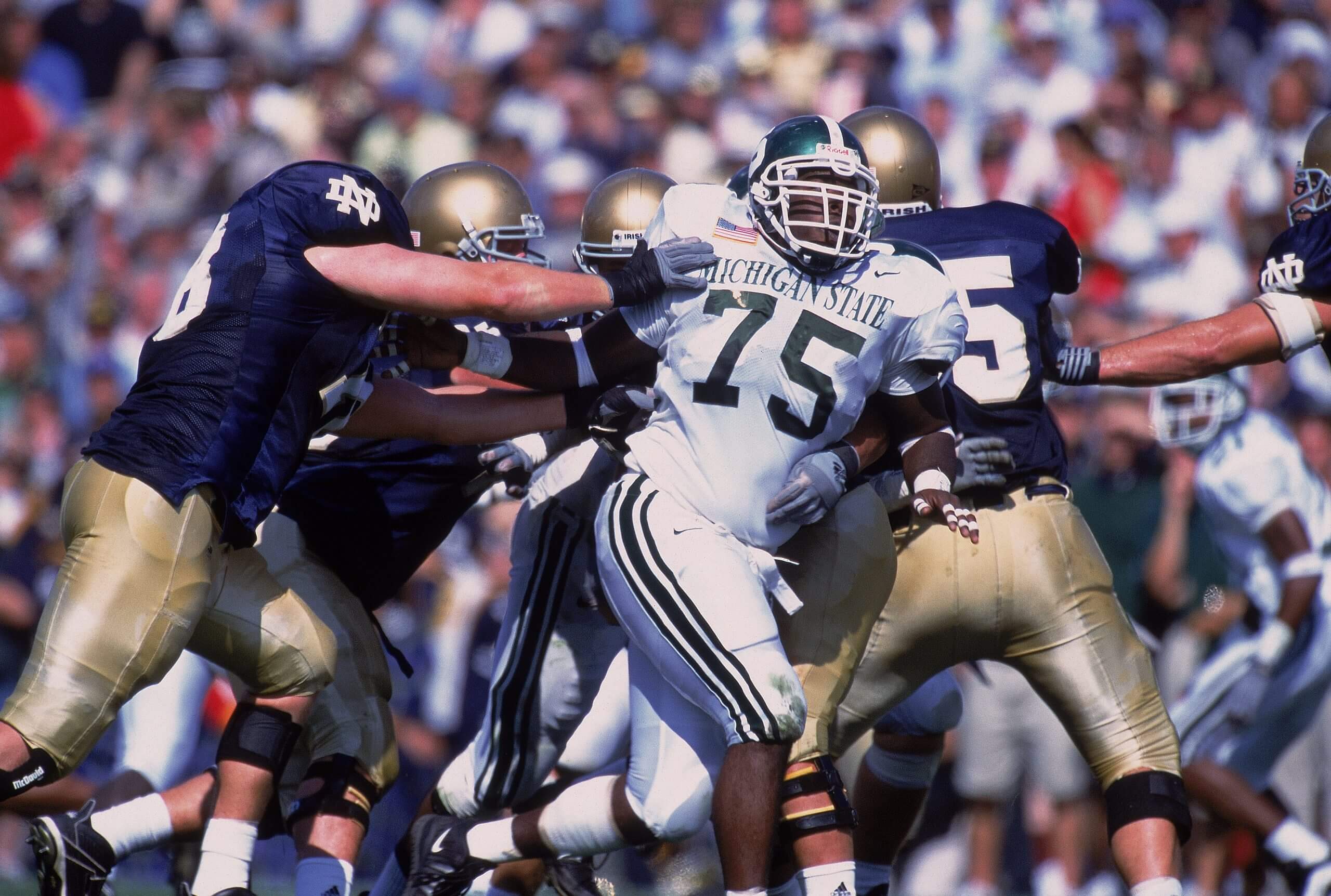

What to know: Of all the series forged in realignment over the last 15 years, this one has emerged as the fiercest. It pits two passionate fan bases from border states that didn’t know they disliked one another until they started playing every year.
- The programs compete for the “Heroes Trophy,” of which each state nominates a citizen hero and has his or her name etched on the trophy. Among the heroes include a high school principal who died directing students away from an active shooter and people saving lives during car accidents.
- When Nebraska joined the Big Ten, the schools petitioned to have their game moved to Black Friday, where it has appeared annually since 2011.
- The last seven meetings were decided by one score with Iowa winning four by a walk-off field goal.
Biggest game: One year after Nebraska blasted Iowa 57-0, the Hawkeyes hosted the No. 7 Huskers on Sept. 12, 1981. Iowa pulled off a 10-7 stunner that catapulted the Hawkeyes to a Big Ten championship season and ended a streak of 19 consecutive non-winning seasons. Nebraska won the next five meetings in the series, including the final three nonconference matchups by a combined 99 points.
Photo:
Steven Branscombe/Getty
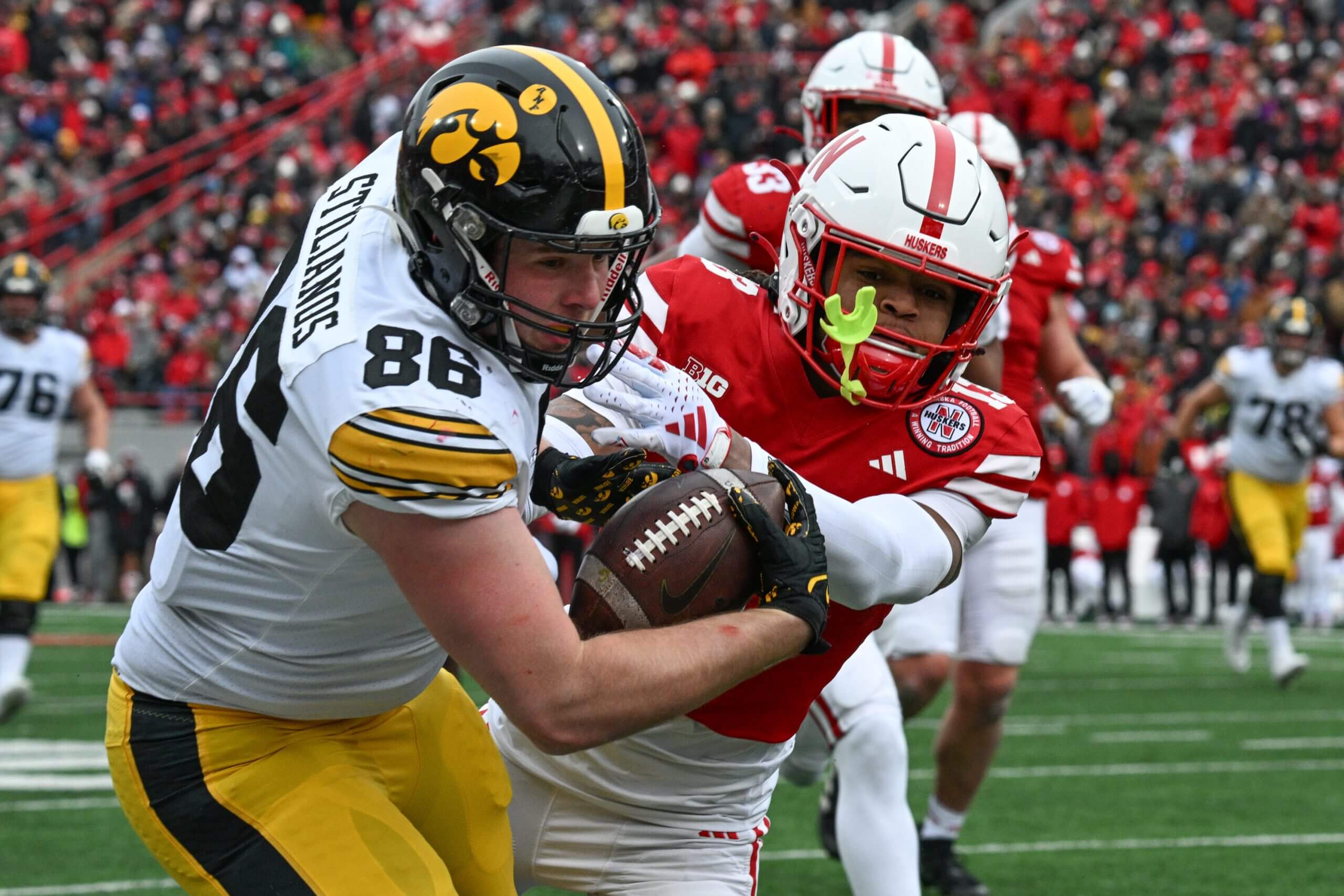

What to know: A staple of Deep South football, these teams have played annually since 1935 (save for World War II) and have competed for the Magnolia Trophy since 2008. It’s a series deeply embedded in the cultures of both fan bases.
- They have met 12 times as ranked foes, including a top-10 showdown in 2024 that LSU won in OT.
- Ole Miss’ 24-22 upset on Oct. 30, 1971 in Jackson, Miss., marked the final game played between two all-White SEC teams.
- The teams faced off in the 1960 Sugar Bowl, in which the No. 2 Rebels beat the No. 3 Tigers 21-0. It was a rematch of a game two months earlier that produced one of the most iconic moments in SEC history.
Biggest game: On Halloween night in 1959, No. 3 Ole Miss led No. 1 LSU 3-0 with 10 minutes left at Tiger Stadium. LSU’s Billy Cannon fielded a punt at his own 11, broke seven tackles and raced 89 yards for one of the greatest TDs in college football history. It nearly became a footnote until the Rebels were stopped for no gain on fourth-and-goal at the Tigers’ 1-yard line to preserve a 7-3 LSU win.
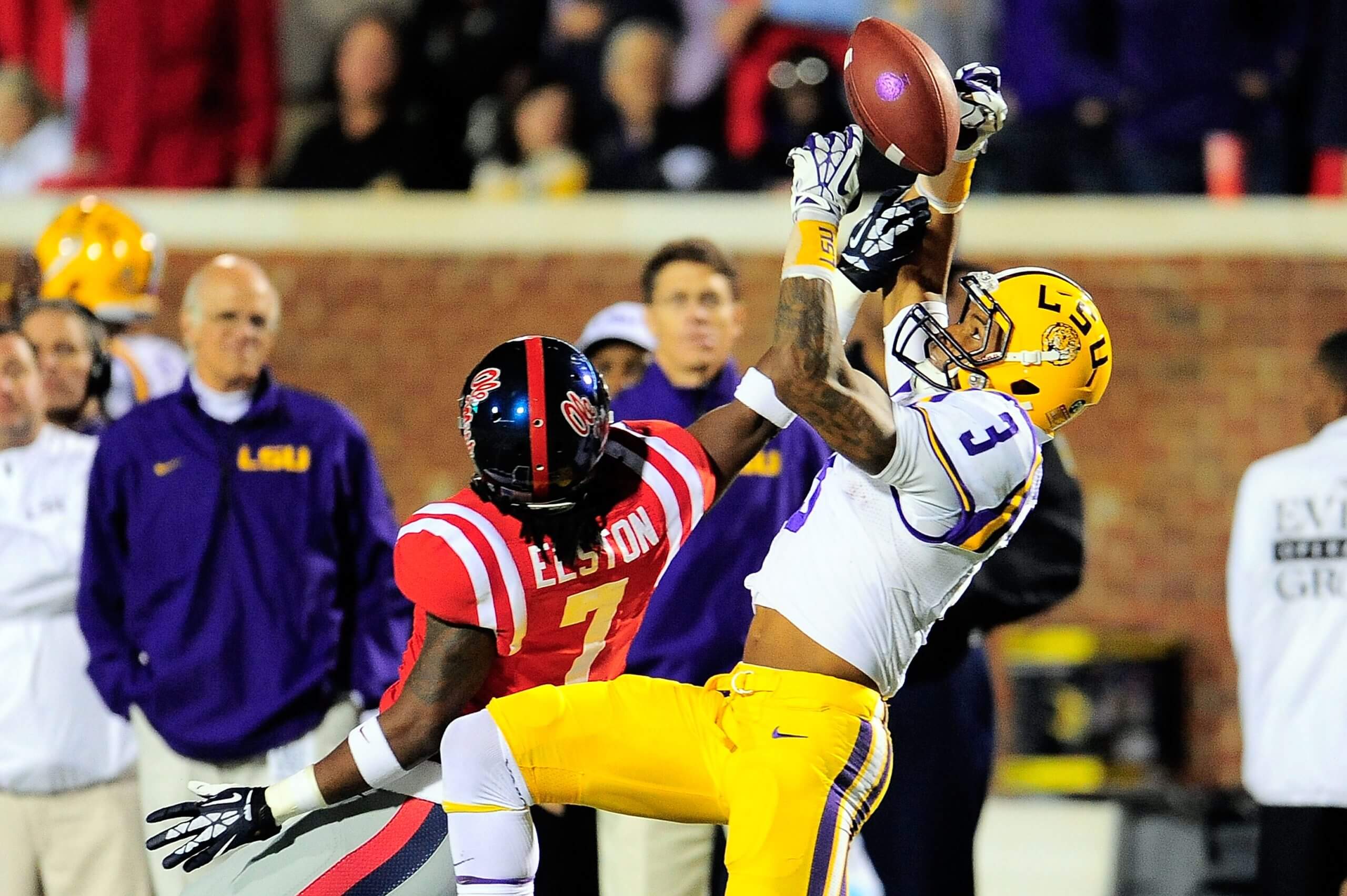

What to know: In “The South’s Oldest Rivalry,” Virginia and North Carolina have faced off 129 times, which is tied with Georgia-Auburn for the second-most in FBS history. Although it’s rarely relevant nationally, it’s historically significant.
- President Calvin Coolidge attended the Virginia-UNC game in Charlottesville on Thanksgiving in 1928.
- Despite a series lead in victories, North Carolina lost 14 straight at Charlottesville from 1983-2010.
- Virginia fans labeled quarterback/point guard Ronald Curry as “Benedict Ronald” after he flipped to UNC on signing day in 1998.
Biggest game: On Nov. 16, 1996, No. 6 North Carolina led 17-3 with the ball at No. 24 Virginia’s 9-yard line. Cavaliers DB Antwan Harris intercepted a third-down pass and returned it 95 yards for a TD with 10:02 left. The ’Hoos scored twice more, including the winning field goal with 39 seconds left to hand the Tar Heels their second and final loss of the season.
Photo:
Doug Pensinger/Allsport
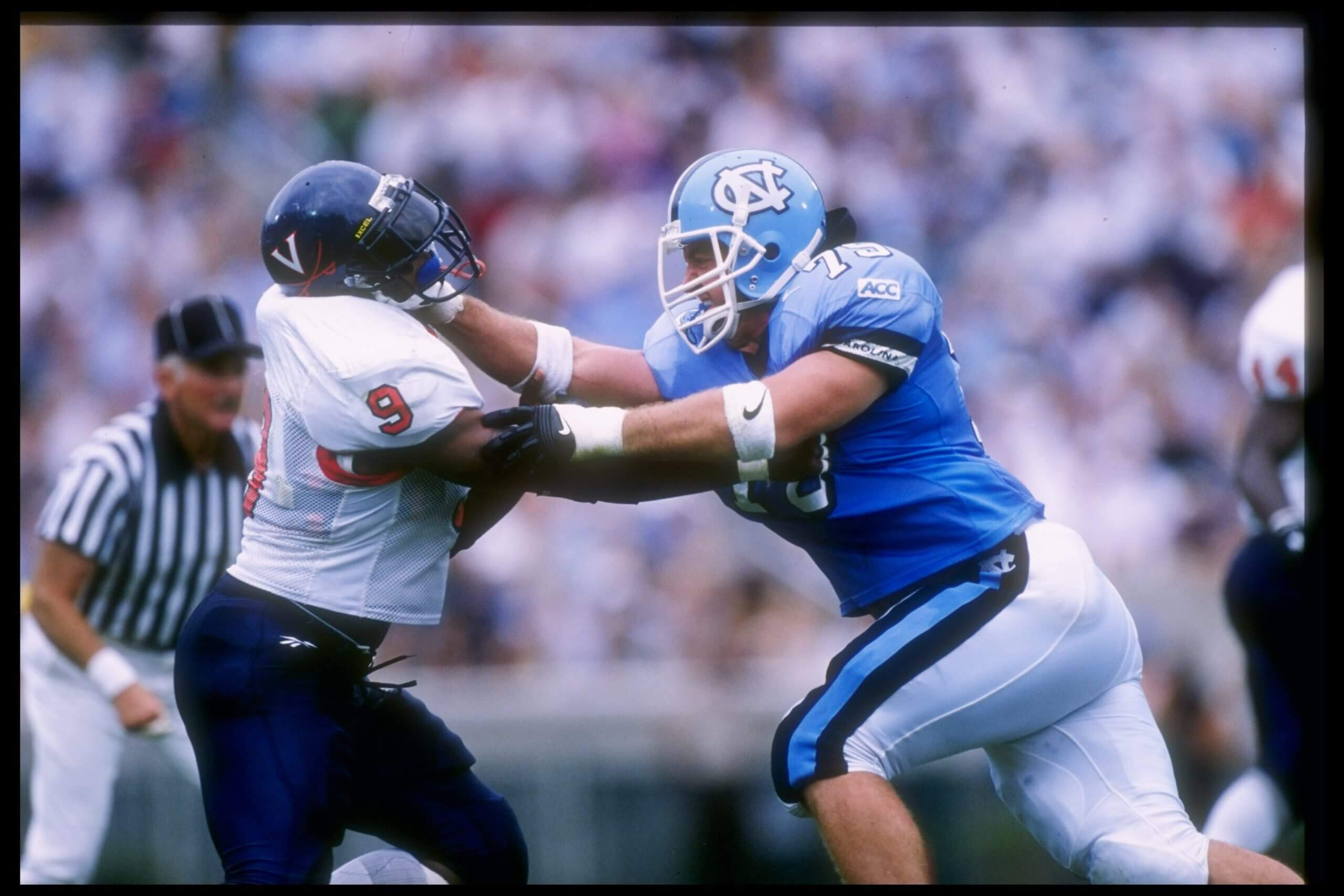

What to know: These teams have played more games against one another than any other series in college football history, often meeting twice per year in the late 1800s. In 2024, they completed their 160th edition. The next most-played series is Yale-Princeton, which is 14 games behind.
- Known simply as “The Rivalry,” Lehigh and Lafayette have met every season since 1897. They moved their 2020 meeting to spring 2021 when the Patriot League canceled the fall season during the COVID-19 pandemic.
- For years the home school would replace their normal goal posts with wooden versions before their matchup because the home students would tear them down almost every year. Only 10.8 miles separates the campuses.
- The teams played winner-take-all games for the Patriot League title and an FCS playoff spot in 2004 and 2006. In 2023 (Lafayette) and 2024 (Lehigh), the winner clinched the league title and a playoff spot.
Biggest game: No other rivalry has celebrated a 150th meeting, so it was special when these teams reached that milestone in 2014. The game moved to Yankee Stadium — the first time it relocated to a neutral site since 1891 — where it was sold out. Behind running back Ross Scheuerman’s 304 rushing yards, Lafayette won 27-7.
Photo:
Lafayette Special Collections


What to know: They are different series with different trajectories, but they carry equal importance. Perhaps both rivalries aren’t competitive, but they provide a window to early Americana. That history matters.
- The Irish and Midshipmen have met every year (except 2020) since 1927. The mutual respect and reverence the schools have for one another was born in World War II when the Navy kept Notre Dame afloat financially by training commissioned officers at the campus. Notre Dame plans to play the game in perpetuity, and the schools have a contract through 2032.
- The Irish own the longest winning streak over a single opponent with 43 consecutive wins against the Midshipmen from 1964 to a triple-OT Navy win in 2007.
- Notre Dame-Army is loaded with college football lore, including Gus Dorais and Knute Rockne taking the forward pass mainstream in a 35-13 rout in 1913, sportswriter Grantlant Rice’s legendary “Four Horsemen” opening paragraph after a 13-7 Notre Dame win in 1924 and Rockne’s “Win one for the Gipper” speech when Notre Dame upset Army in 1928.
Biggest game: On Nov. 10, 1946, top-ranked Army entered on a 25-game win streak and featured 1945 Heisman winner Doc “Mr. Inside” Blanchard and 1946 Heisman winner Glenn “Mr. Outside” Davis. The No. 2 Irish boasted future Heisman winners Johnny Lujack (1947) and Leon Hart (1949). Despite the scoreless tie, the lore surrounding the “Game of the Century” at Yankee Stadium trumps the result.
Photo:
Jonathan Daniel/Getty
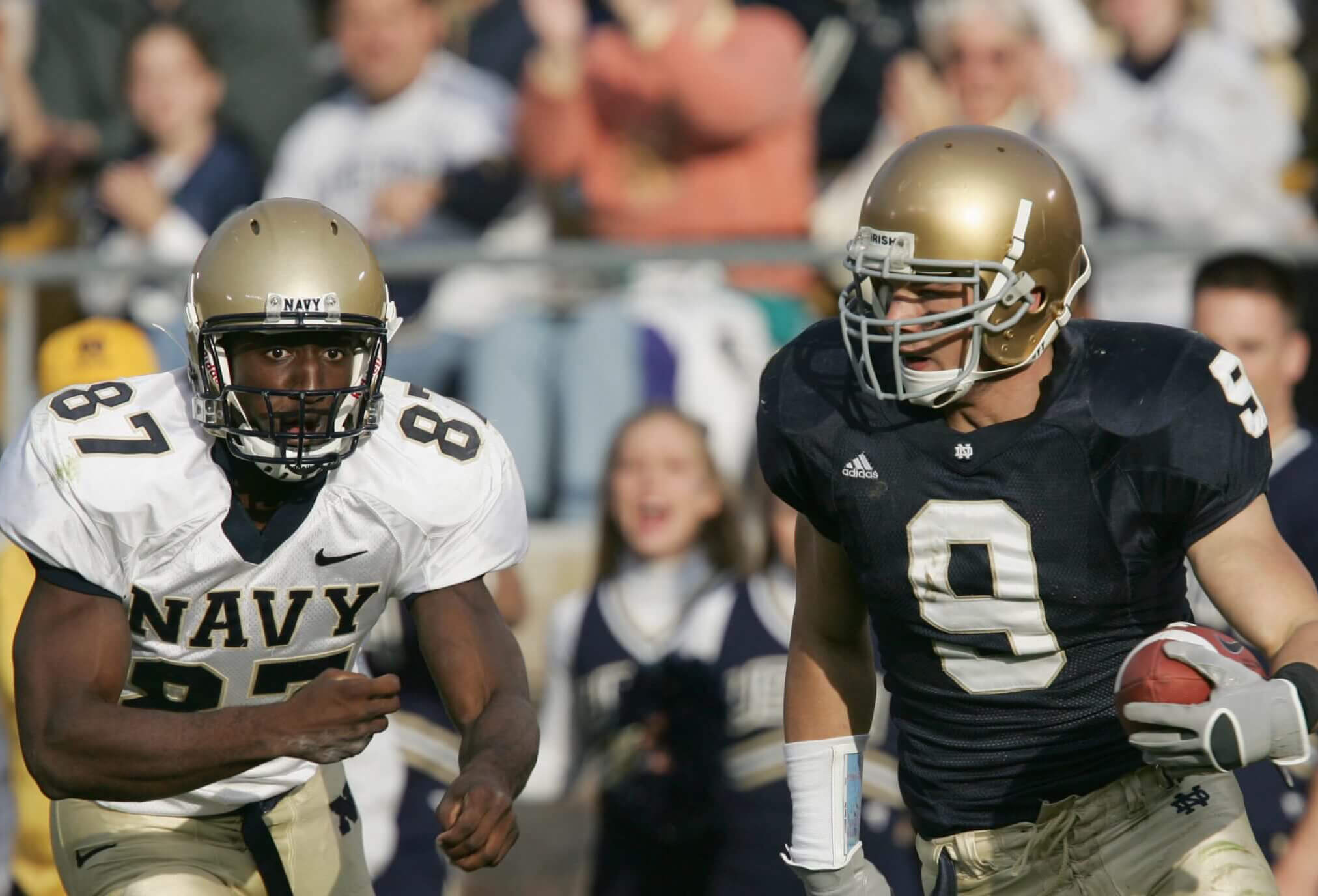

What to know: It’s unfair sometimes to compare FCS and FBS rivalries, but this rivalry can hold its own with the best in the sport at any level. It has become FCS’ premier on-field rivalry.
- Both schools have long-standing rivalries with in-state foes that carry similar importance locally. The distinguishing characteristic of NDSU-SDSU is its prominence nationally. The teams have played six times in the FCS playoffs, and the Bison lead 5-1 in those rematches. The postseason winners all claimed the FCS championship.
- The separation of these schools from North Dakota and South Dakota took place in 2004 when North Dakota State and South Dakota State left Division II for FCS. The other two followed in 2008.
- Since 2004, the Bison and Jackrabbits have played for the 75-pound Dakota Marker, which serves as a replica of the quartzite monuments that marked the border between the states. That’s up for grabs only in the regular season.
Biggest game: It’s difficult to look past the 2022 FCS championship game, which South Dakota State won 45-21. But the 2024 FCS semifinal in Fargo added legacy to the scorching-hot rivalry. Top FCS quarterbacks Cam Miller (NDSU) and Mark Gronowski (SDSU) went toe-to-toe with the Bison pulling out a 28-21 win over the two-time defending FCS champs. North Dakota State then claimed its 10th FCS title.
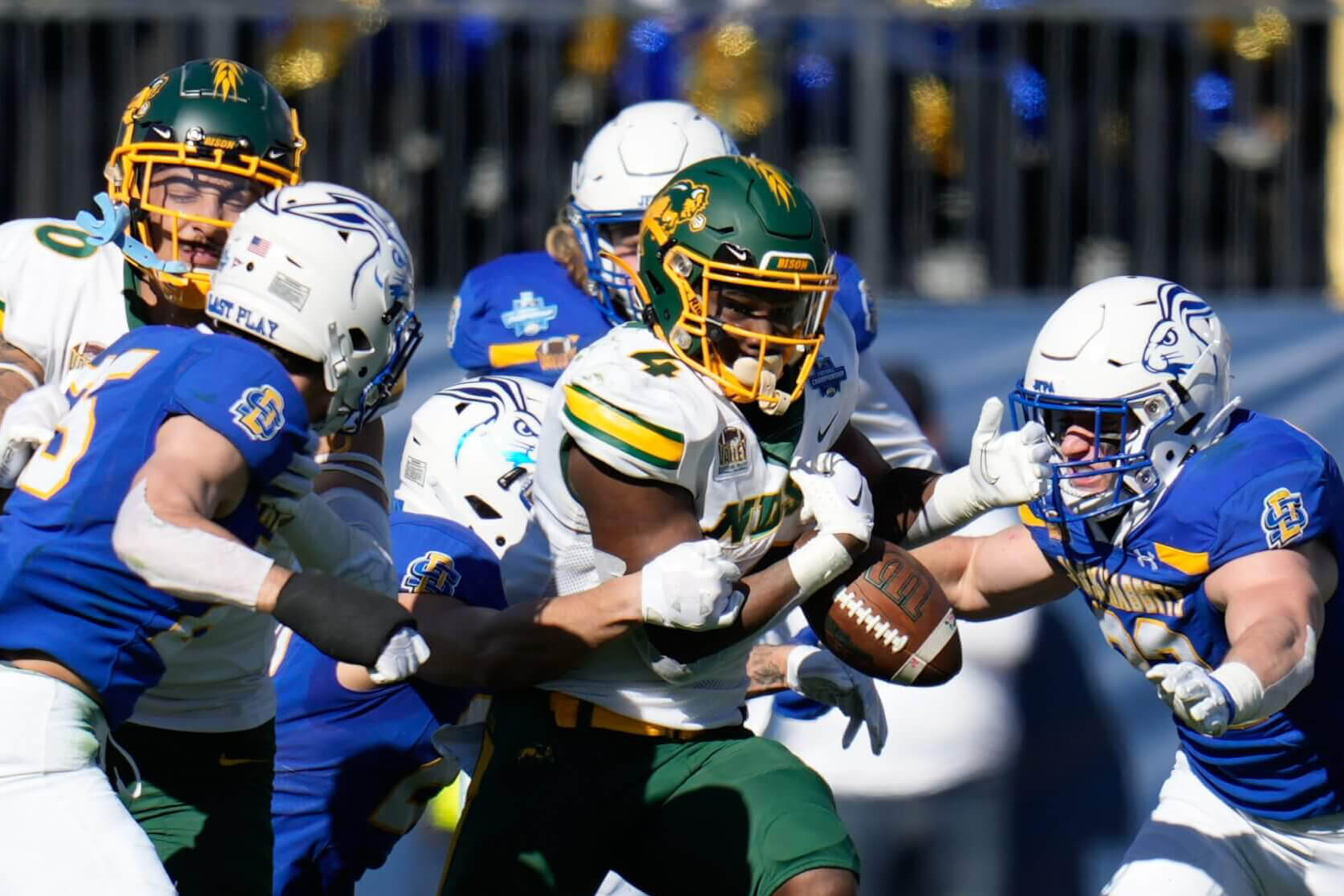

What to know: When Arkansas joined the SEC in 1992, this was a top-15 rivalry. It has a chance to inch upward now that they’re in the same conference again, but it’s unlikely the stakes will be as high annually as they were in the Southwest Conference. The SEC competition is too fierce and too much time has passed.
- From 1925 through Arkansas’ departure, the Razorbacks were the only non-Texas team in the SWC, which added to the saltiness between the programs.
- They’ve met 18 times as ranked opponents, and it was the nation’s best series from 1959-72, when both were ranked in 10 of their 14 matchups. Six of those games were top-10 matchups and four were decided by four points or less.
- Arkansas’ 42-11 win against Texas in 1981 remains the largest defeat by an AP No. 1 team against an unranked opponent since 1942.
Biggest game: No. 1 Texas faced No. 2 Arkansas in a “Game of the Century” on Dec. 7, 1969, in Fayetteville, and it lived up to the hype. The schools agreed to move their game back to have a larger national platform, and the Hogs took a 14-0 lead into the fourth quarter. Texas rallied for 15 points and clinched the SWC title with an interception at its 21 with 1:13 left. President Richard Nixon attended the game and declared Texas the national champion.


What to know: Once the primary rivalry in the East and a Thanksgiving weekend staple, Pitt-Penn State conjures nostalgia of a bygone era. If a rivalry ranking took place in the mid-1980s, this easily would have made the top 10. But with infrequency and the programs’ uneven status, no other great rivalry has fallen more over the last 40 years than this one.
- From 1973-82, Pitt and Penn State were ranked in the top 20 each year and three times it was a top-10 showdown. Penn State won seven of those games.
- Outside of that 10-year block, the Panthers and Nittany Lions played just one ranked matchup, No. 22 Penn State’s win vs. No. 19 Pitt in 1989.
- The old foes have played just two four-game series since Penn State joined the Big Ten in 1993.
Biggest game: On Black Friday in 1982, a year after Penn State spoiled No. 1 Pitt’s ’81 title hopes with a 48-14 thumping, the winner between No. 2 Penn State and No. 5 Pitt would meet top-ranked Georgia in the Sugar Bowl. Behind Dan Marino, the Panthers led 7-3 until the third quarter when the Nittany Lions moved ahead on a touchdown pass and stretched it with multiple field goals to win 19-10. Penn State went on to beat Georgia to claim its first national title. Pitt instead went to the Cotton Bowl and finished No. 10.
Photo:
Rick Stewart/Allsport
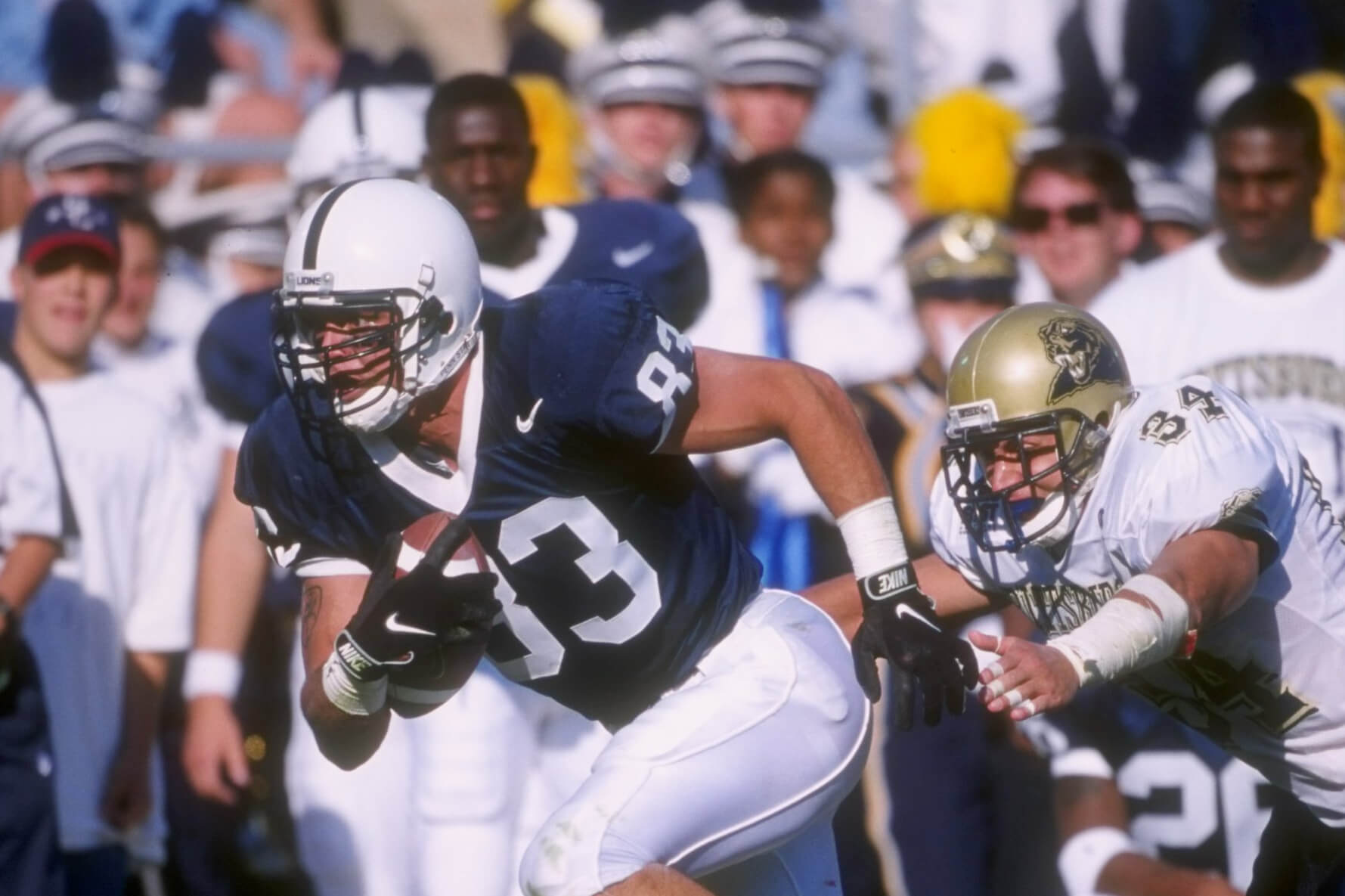

What to know: Tennessee and Florida barely resonated for either fan base until they were forced to play one another every year in the SEC East. Once they did, the series sizzled and became the SEC’s most competitive rivalry in the 1990s. It doesn’t measure up when compared alongside these teams’ historical feuds, but it’s on the map.
- From 1916-89, they played only 19 times. Since then, they have played 35 consecutive years and both teams were ranked in the AP poll in 22.
- Most of their meetings have taken place in September to set the tone in many SEC seasons. Ten times from 1990-2002, both teams were ranked in the top 10.
- No rivalry was livelier when Peyton Manning led the Vols and Steve Spurrier coached the Gators in the mid-1990s. After four straight series wins, which relegated Tennessee to the Citrus Bowl three times, Spurrier told a room of supporters before their 1997 meeting that “You can’t spell ‘Citrus’ without U-T.”
Biggest game: After five straight top-15 losses to the Gators, No. 6 Tennessee hosted No. 2 Florida in 1998. The Vols picked up a 20-17 OT win when Florida’s game-tying attempt said wide left. The win propelled Tennessee to the first BCS championship.
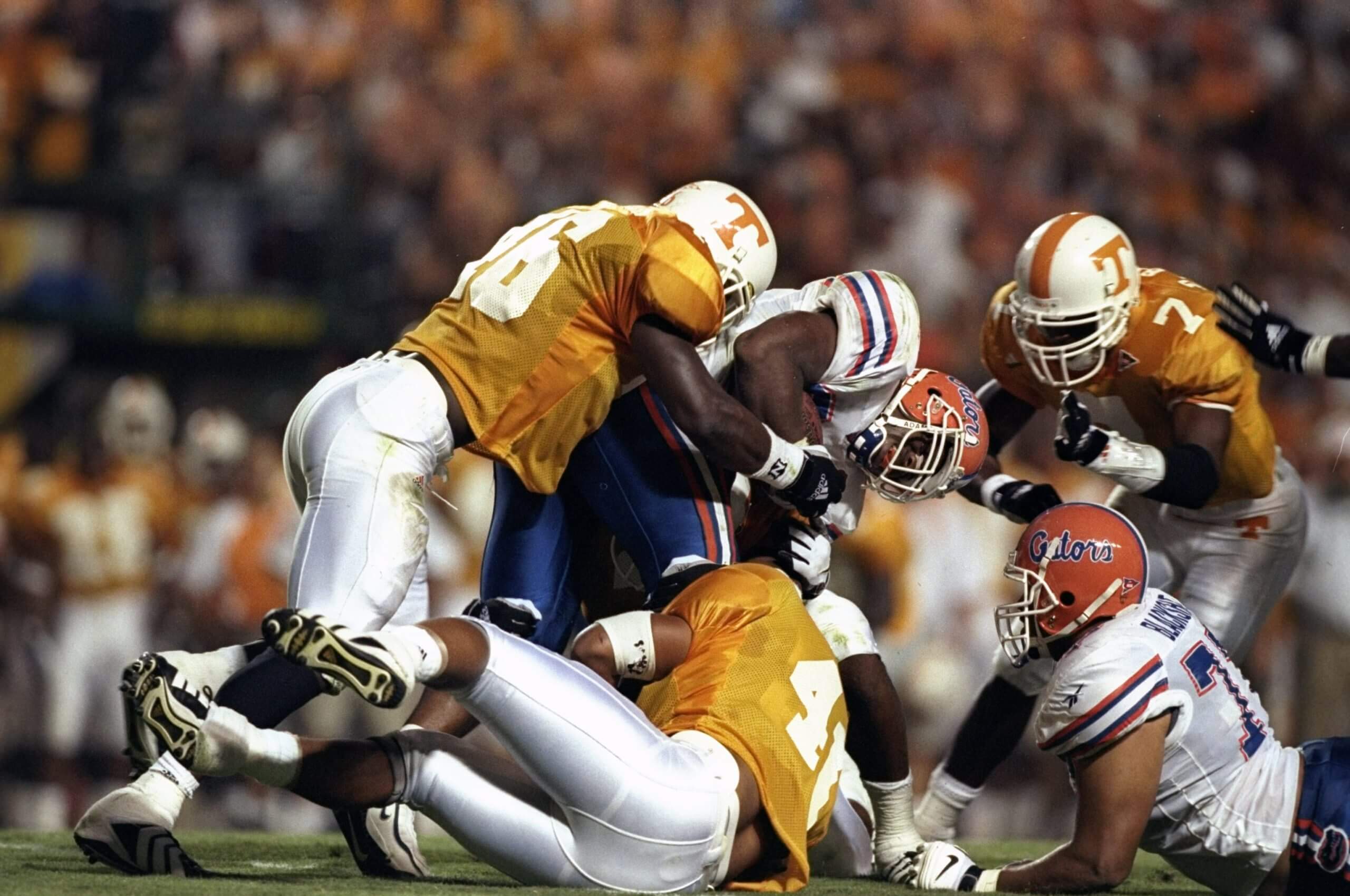

What to know: Baylor and TCU have asserted themselves as factors in the Big 12 over the past decade-plus and elevated their now-annual series. They both are well-positioned to contend for league championships and their rivalry has steadily moved up in importance since TCU joined the Big 12 in 2012.
- With 120 meetings, Baylor-TCU has slipped past Texas-Texas A&M as the most-played rivalry in Texas. It’s odd because there are significant gaps in their schedule. They played only twice after the Southwest Conference breakup following the 1995 season through 2009. But they met 24 times from 1901-10. TCU was located in Waco with Baylor from 1895-1910.
- The series is one of four protected Big 12 rivalries, joining Kansas-Kansas State, Utah-BYU and Arizona-Arizona State. Baylor-TCU has been christened as “The Bluebonnet Battle” with an accompanying trophy.
- At least one team was ranked in 29 of their meetings, but in only two of those were both teams ranked. The teams split their 2014 and 2015 meetings when both were in the top 15.
Biggest game: Few regular-season games this century can match the entertainment and ramifications of TCU-Baylor in 2014. No. 9 TCU led 58-37 inside of 11 minutes to play before No. 5 Baylor scored TDs on three straight possessions to tie the score. The Bears then won with a field goal as time expired. The teams tied for the Big 12 title, and without a championship rematch, Ohio State passed both for the final spot in the first CFP.
Photo:
Tom Pennington/Getty
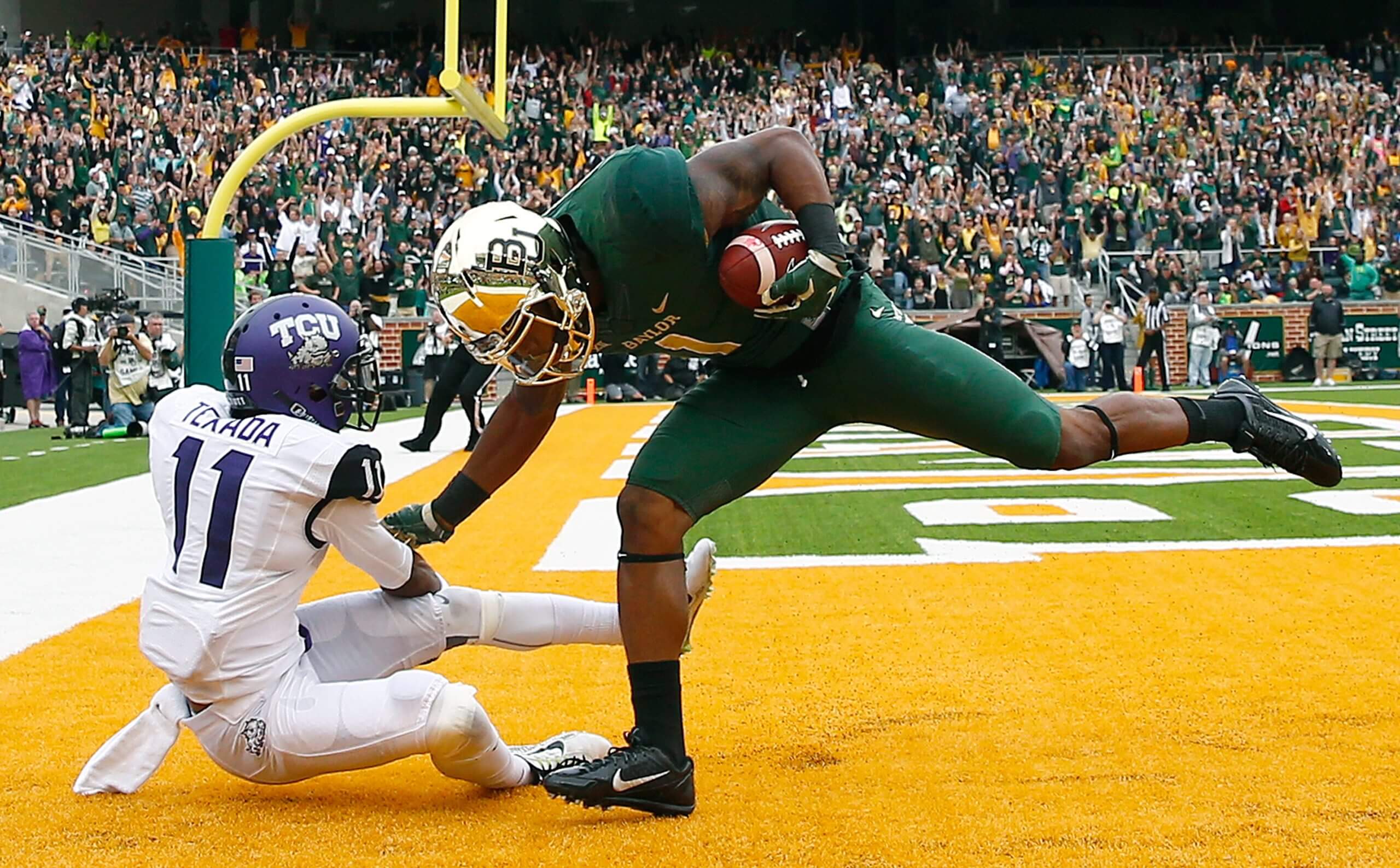

What to know: Tied for the fourth most-played rivalry in Big Ten history, few Midwestern series boast more vitriolic moments than Iowa-Minnesota. Although it doesn’t often determine championships, they play for one of the nation’s most recognizable trophies.
- Since 1936, they have competed for the Floyd of Rosedale. Weighing 98 pounds, Floyd is a replica of a live hog the governors wagered during their 1935 game. The bet came after Iowa’s governor allegedly said, “If the officials stand for any rough tactics like Minnesota used last year, I’m sure the crowd won’t.” Minnesota won peacefully the next day, and a live hog was transported to Minnesota a few days later.
- Known as “Hate Week” when these rivals clash, Minnesota fans chant “Who Hates Iowa, We Hate Iowa” during most sporting events, no matter who the Gophers play.
- The foes have battled 36 times with at least one team ranked — seven with both in the poll — but since 1962, the Gophers have been ranked just three times when facing the Hawkeyes.
Biggest game: In 1960, No. 1 Iowa traveled to No. 3 Minnesota (ranked second by coaches) for the highest-ranked matchup in Big Ten annals to that point. It also marked the first top-10 battle between Black starting quarterbacks (Sandy Stephens for Minnesota, Wilburn Hollis for Iowa). A litany of Iowa second-half mistakes led to the Gophers’ 27-10 win, which enabled Minnesota to claim its most recent national title. Despite the loss, Iowa also earned national title distinction.
Photo:
Matthew Holst/Getty
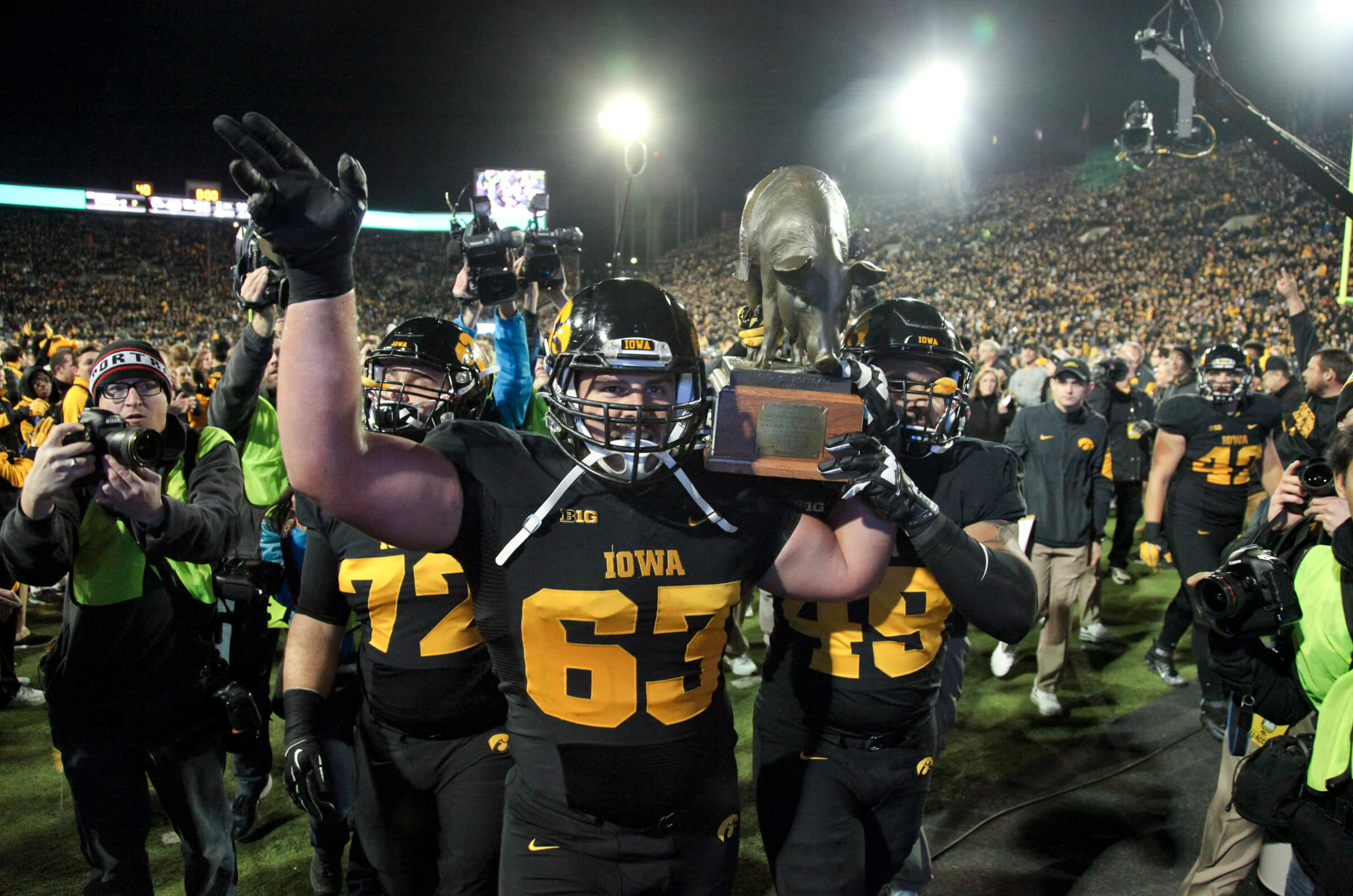

What to know: The programs have uneven histories, but when Colorado became a national title contender in the late 1980s, this series took off as the pivotal Big Eight/Big 12 game. They’ve played only four nonconference games since splitting into different leagues in 2011, but a healthy disdain remains between fans.
- When Colorado and Nebraska competed in the Big Eight, the Huskers had one true rival in Oklahoma and the Buffaloes didn’t have any. In 1982, Colorado coach Bill McCartney wrote “Nebraska” in red for his players to see with the goal of turning the Cornhuskers into a rivalry. He partially succeeded.
- From 1988-2001, the teams met 10 times as ranked opponents, including six times in the top 10.
- After the Big 12 formed in 1996, the teams moved into the North Division and the series shifted to Black Friday. They combined for 10 of the North’s 15 title-game appearances.
Biggest game: Several of the teams’ most important games were blowouts, but the first time this became a rivalry was in 1989. Two long punt returns that led to scores helped No. 2 Colorado edge No. 3 Nebraska 27-21 in Boulder. It’s an infamous result in Nebraska, where it’s known more for a phantom pass interference call negating an interception and a non-clipping call on a punt return.
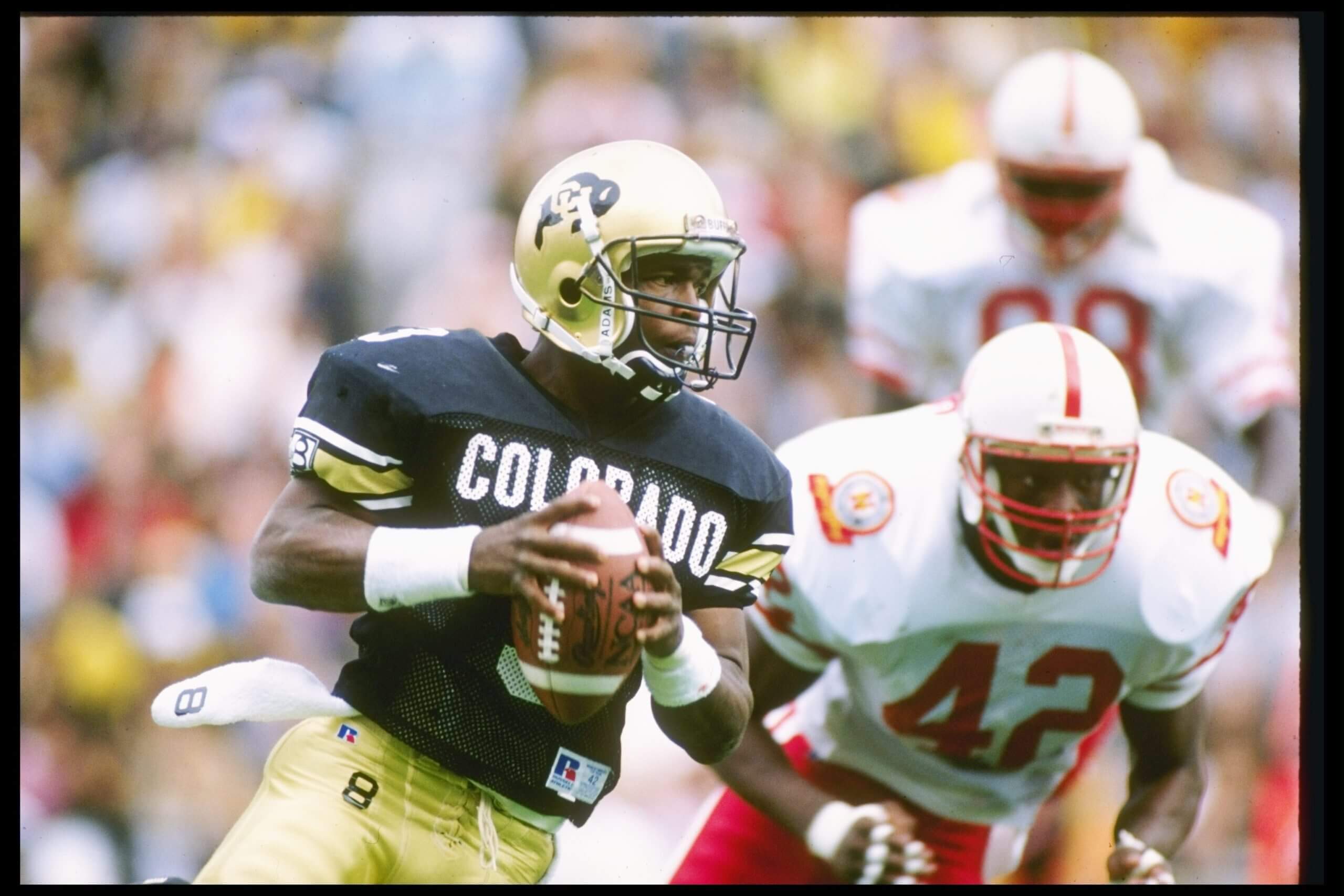

What to know: A lack of ranked matchups keeps the Cy-Hawk from climbing into the top 25, which is where the fan passion lies. Known as the state’s Super Bowl, up to 30,000 extra fans gather at the host site simply to tailgate before and during games. In a state without pro sports, nothing generates more conversation year-round than the Cy-Hawk result.
- The in-state foes have a history of disdain for one another, highlighted by a 43-year pause beginning in 1934. The sides required arbitration to force Iowa to honor a contract with Iowa State starting in 1977, and they’ve played every year but 2020.
- Since 2011, the visiting team is 11-2. Each side has had major winning streaks with Iowa capturing 15 straight from 1983-97, then the Cyclones winning five in a row from 1998-2002. The Hawkeyes also claimed six straight from 2015-21.
- Iowa has been ranked 15 times against Iowa State, while the Cyclones were in the Top 25 just twice. Iowa State upset ranked Iowa in 2005 and 2024.
Biggest game: The 2021 matchup featured ESPN’s “College GameDay” at Jack Trice Stadium and marked the only time the rivals met as ranked opponents. In a top-10 showdown, No. 10 Iowa’s stifling defense intercepted three passes and returned a fumble for a TD to beat No. 9 Iowa State 27-17.
Photo:
Jeffrey Becker/Imagn
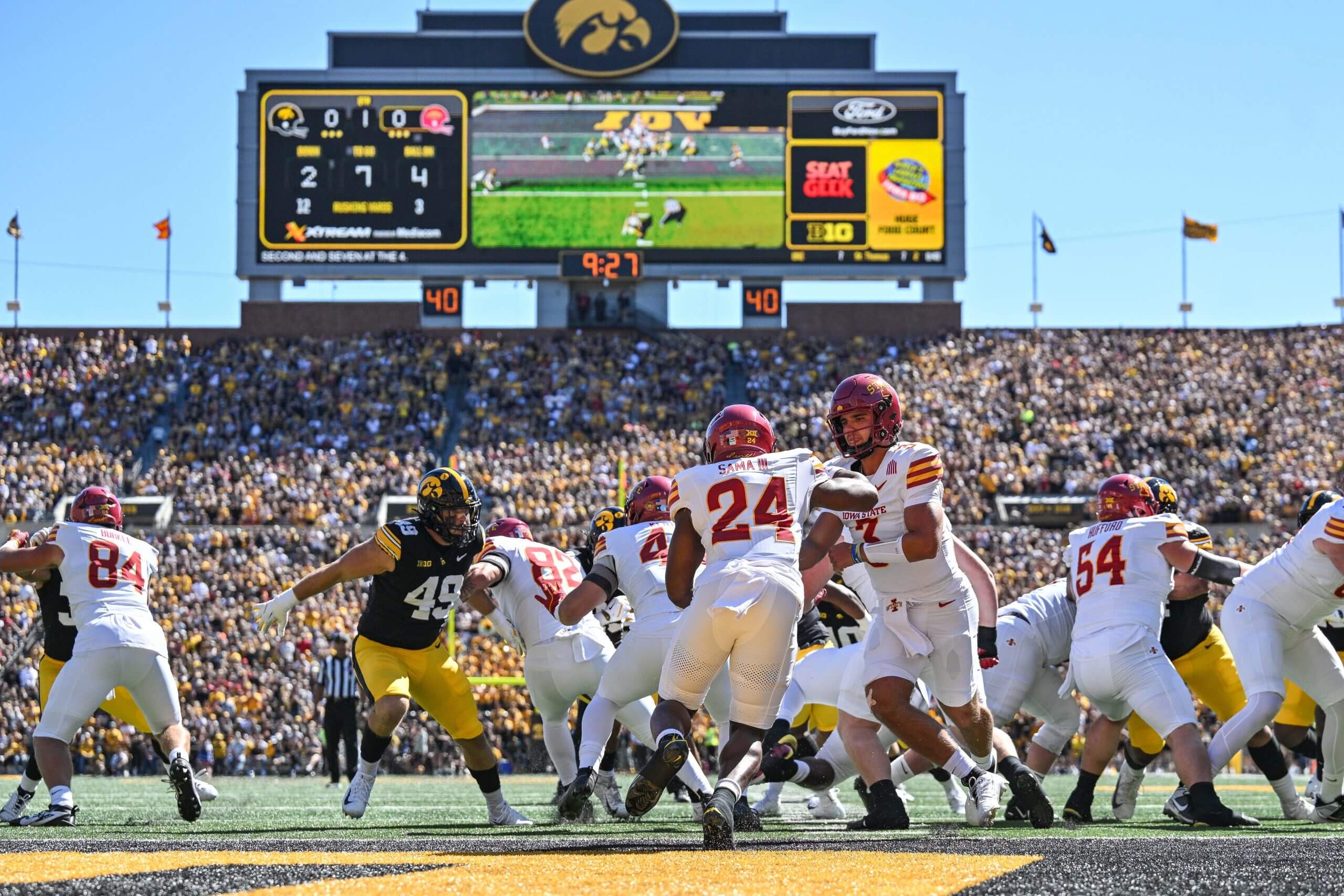

What to know: This series has survived conference shakeups to endure as a Thanksgiving weekend staple. Georgia Tech was the better program until the 1970s, but Georgia has owned the series since then and carries a much higher profile.
- Known as “Clean, Old-Fashioned Hate,” this series has been the regular-season finale for both all but two years since 1941.
- Disagreements over scholarship allocation led Georgia Tech to bolt the SEC after the 1963 season, but the rivalry survived.
- At least one team was ranked in 54 of their matchups, and both teams were ranked 11 times. Georgia is 30-2 when it is the only ranked team.
Biggest game: For only the second time, Georgia-Georgia Tech kicked off on Black Friday in 2024, and the rivals put on an unforgettable show. The Yellowjackets led by two TDs late, but Georgia rallied to force OT. The teams battled for eight OTs before Georgia converted the final 2-pointer to win 44-42.
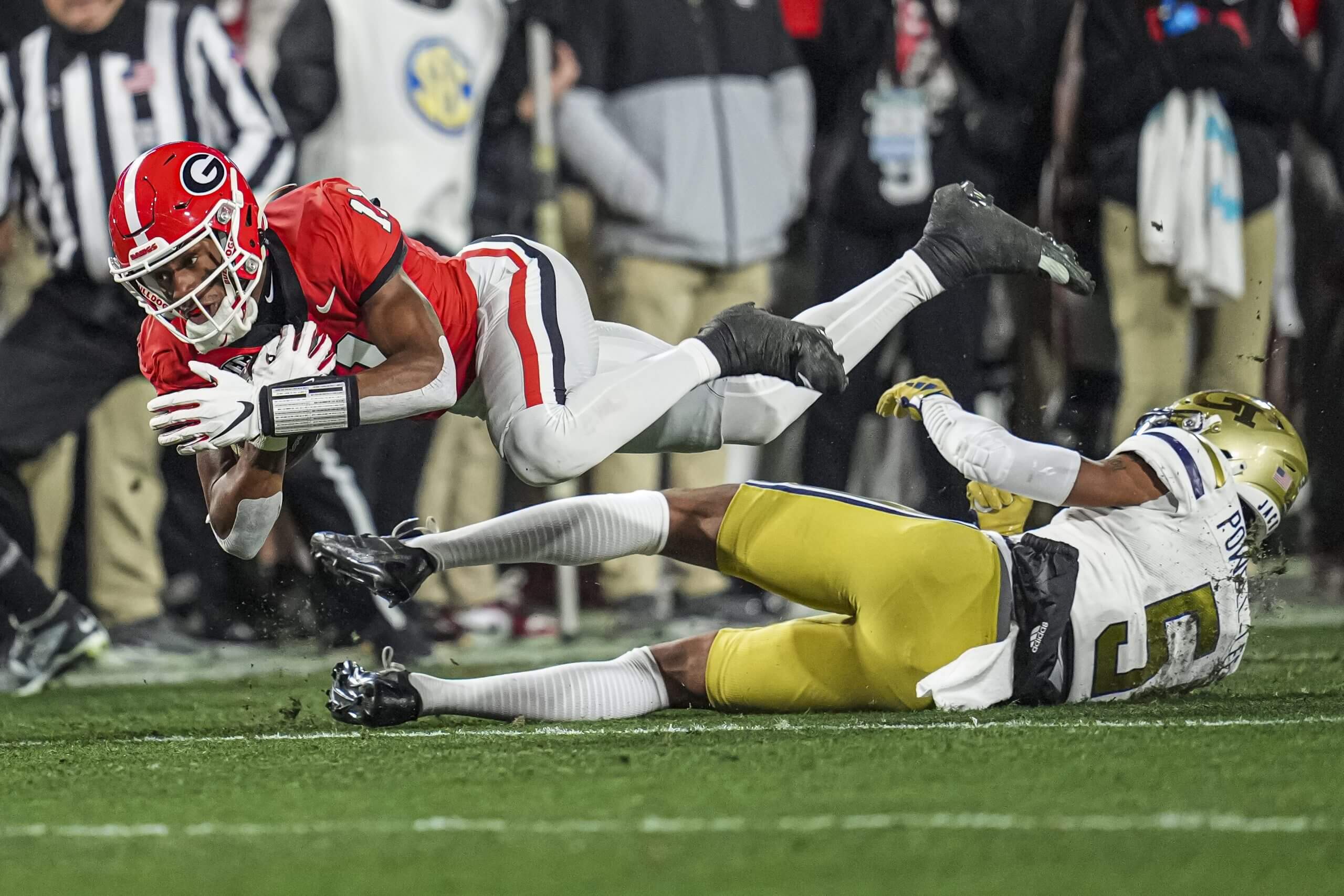

What to know: These teams represent vastly different parts of the state, and that culture clash adds a little spice to the Apple Cup. Unfortunately, what made this a special series has the potential to wane over time with the Huskies now in the Big Ten.
- Since 1963, the teams have played for the Apple Cup. It replaced the original Governor’s Trophy, which lasted from 1931-62.
- The teams have matched up nine times as ranked opponents and at least one team has been ranked 34 times. The Cougars are just 4-9-1 in the Apple Cup when they are ranked in the AP poll.
- When Washington joined the Big Ten, the teams agreed to play nonconference games through at least 2028.
Biggest game: When the Apple Cup kicked off in 1981, Wazzu had its eyes set on the Rose Bowl for the first time in 51 years. Washington sought to make its third trip in five years. In a winner-take-all showdown, the teams were tied 10-10 in the third quarter before an avalanche of six turnovers buried Wazzu, and the Huskies headed to Pasadena thanks to a 23-10 victory.
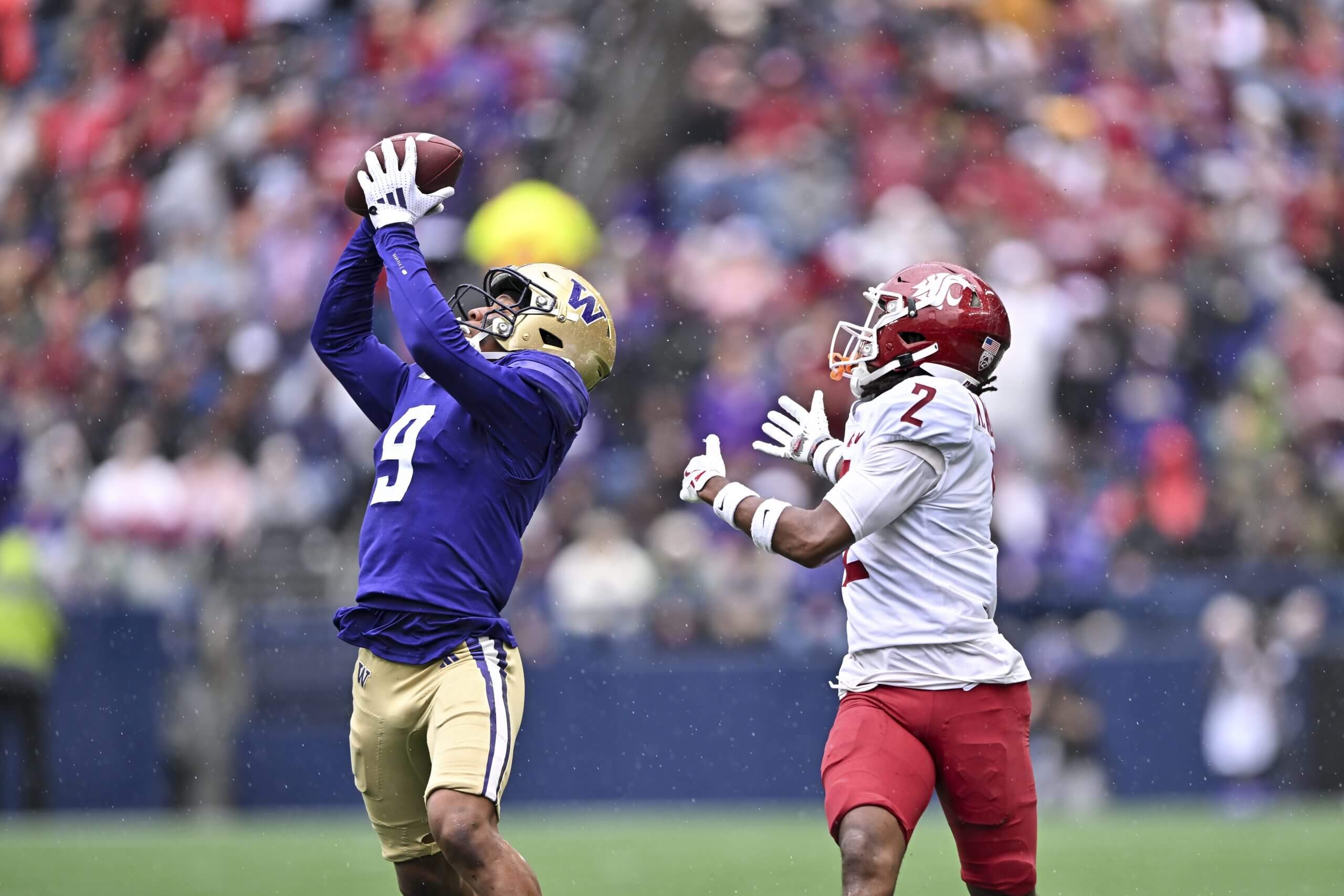

What to know: Known as “The Big Game,” Stanford-Cal in some ways feels like the FBS version of Harvard-Yale. It rarely strays into national relevance with only one ranked matchup over the past 73 years, but “The Play” elevates it in the public consciousness.
- The teams compete for the Stanford Axe, which debuted during a baseball game between the schools in 1899. After winning, Cal supporters transported the Axe across the bay in a ferry. It became the rivalry’s symbol of victory in 1933.
- They’ve met four times as ranked foes (1937, 1949, 1951, 1991) and Cal holds a 3-1 edge.
- From 2021-24, the home team averages 51,639 fans for The Big Game. The average attendance for both schools combined outside of this rivalry is 34,464 over the same span. That includes Pac-12 and ACC games.
Biggest game: Behind John Elway’s final drive heroics, Stanford took a one-point lead with 4 seconds left that seemingly was going to send the Cardinal to the 1982 Hall of Fame Bowl. But on the ensuing kickoff, Cal lateraled the ball five times, with Kevin Moen collecting it first and receiving it last. Moen burst through the Stanford band gathered near the end zone and crossed the goal line for perhaps college football’s most incredible ending in a 25-20 Cal victory.
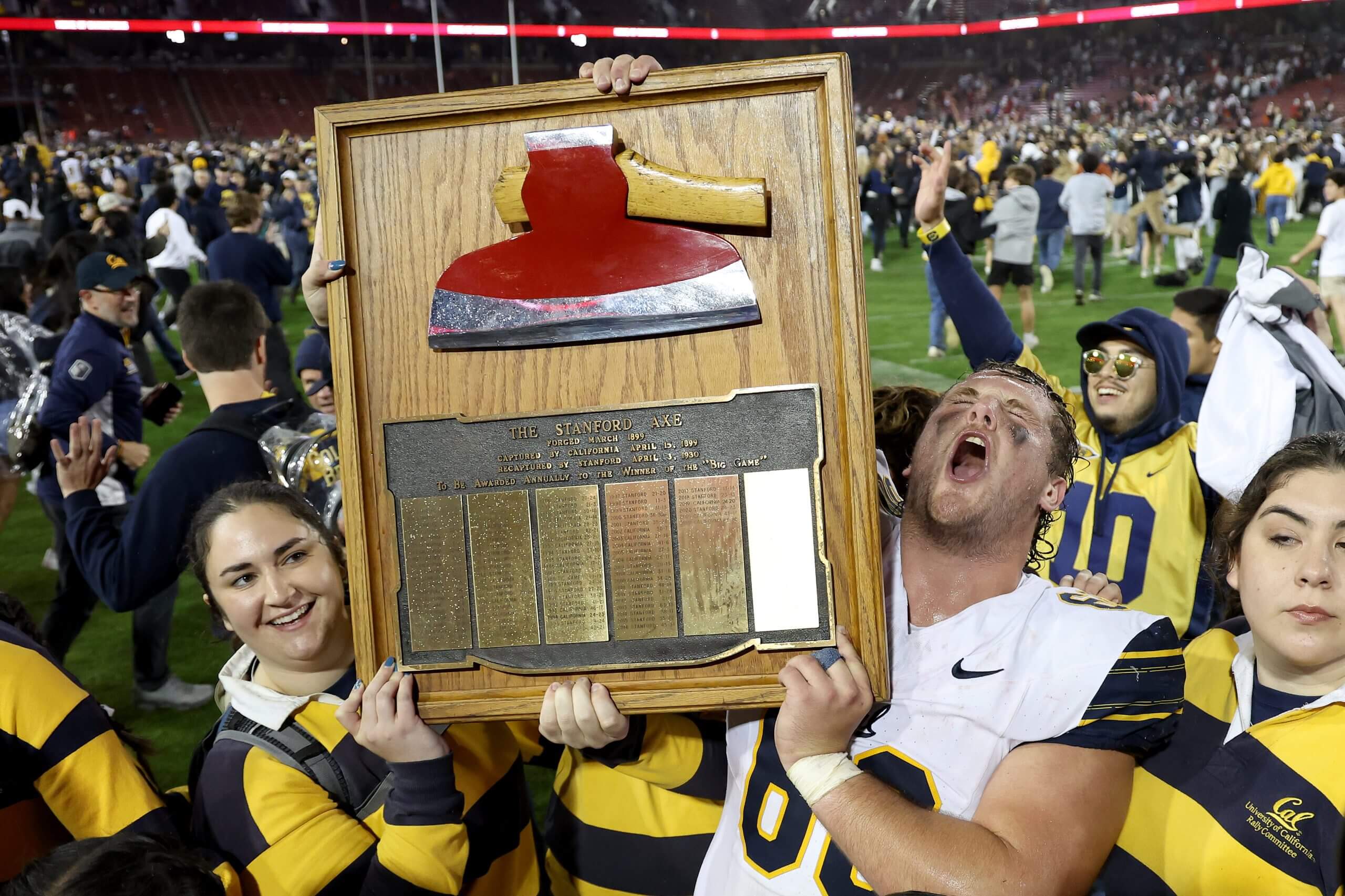

What to know: With the relatively new moniker of “Holy War,” Utah and BYU has long endured as the signature rivalry in the Rocky Mountains. Only 40 miles separate the campuses and their mutual upward trajectory has elevated it into a major power-conference series. Its profile has grown over the past two decades and it could become even more impactful with both in the Big 12.
- A record-book discrepancy only adds to the rivalry. Utah lists six games played against BYU from 1896-98. BYU’s program officially started in 1922. The Utes’ games (3-3) were against BYU Academy, which BYU doesn’t recognize.
- The rivals previously were members of the Rocky Mountain (1922-37), Skyline (1938-61), WAC (1962-98) and Mountain West (1999-2010). Utah entered the Pac-12 in 2011, while BYU went independent until joining the Big 12 in 2023. Utah joined the Big 12 in 2024.
- The teams have met only three times as ranked opponents (1994, 2008, 2009), but the recent history is loaded with thrilling games. Twenty of the past 24 have been decided by single digits.
Biggest game: There were plenty of impactful games between the rivals, but their most recent battle in 2024 was a classic. BYU entered the first Holy War since 2021 unbeaten but trailing 21-10 at halftime. The Utes led by two points when BYU started its final drive inside of two minutes. The Cougars converted on fourth down because of a controversial defensive holding call and hit a field goal with 4 seconds left to win 22-21.
Photo:
Chris Gardner/Getty
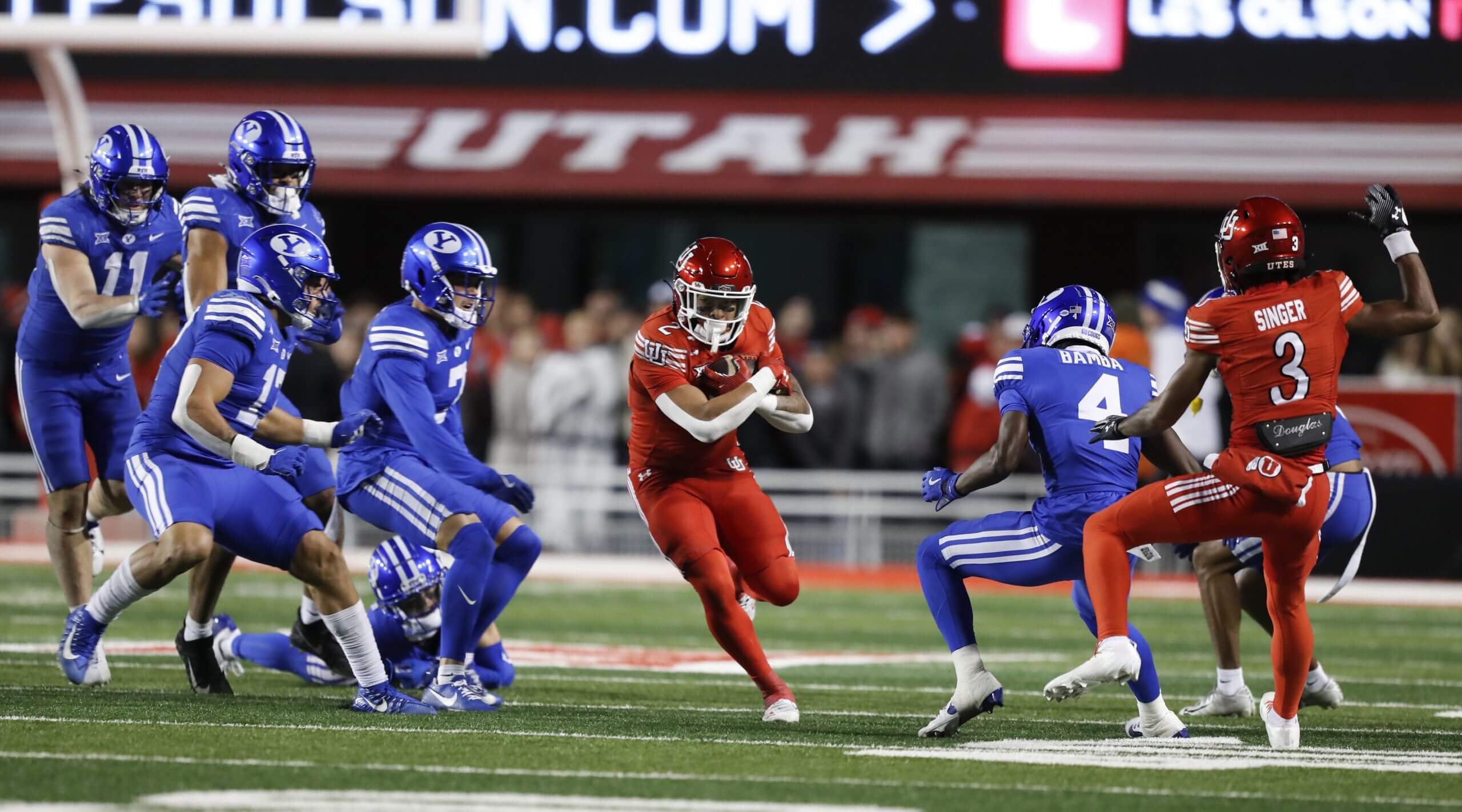

What to know: No offense to the Apple Cup, but this is the best former Pac-12 rivalry in which the programs no longer share a conference. Several games the past two decades decided league and divisional titles. With only 40 miles separating the campuses, this rivalry has a chance to maintain its intensity even with Oregon moving on to the Big Ten.
- These teams have met 128 times, tied for the fourth most in FBS history. After this year, it will be in sole possession of fourth and sits just one game behind Auburn-Georgia and Virginia-UNC for second.
- Known as “The Civil War,” Oregon-Oregon State has featured 31 games with at least one ranked team, including six matchups with both in the AP poll. The Ducks hold a 4-2 lead in those games.
- Unlike other rivalries that went on hiatus following conference realignment, officials at both schools deemed this as a critical series. They have a contract through the 2025 season and are working on a longer-term deal.
Biggest game: A year removed from similar stakes, a Rose Bowl bid and the Pac-10 title were at stake when the Ducks and Beavers clashed on a Thursday night in December 2009. The teams exchanged leads six times entering the fourth quarter, then Oregon kept the ball for the final 6:09 to preserve a 37-33 win.


What to know: “The Backyard Brawl” regularly boasts close competition and has a heavy dose of upsets. A top-10 team has been beaten four times in this series. Its impact nationally is limited but it’s a throwback rivalry that could move up if it becomes an annual series.
- Only 75 miles separate the campuses, and Pitt-WVU is the most-played FBS rivalry in the Northeast at 107.
- The teams previously played annually from 1943-2011 as independents and members of the Big East. In 2012, Pitt left for the ACC and West Virginia joined the Big 12. They reignited their series in 2022 with a pair of four-game contracts.
- They have played six games as ranked opponents with West Virginia holding a 3-2-1 record. Of the 22 games with one team ranked, the unranked team has won eight times.
Biggest game: A BCS title game berth was at stake when No. 2 West Virginia hosted Pitt in 2007. The Mountaineers averaged 41.6 points per game, while the Panthers had a losing record and were 28.5-point underdogs. Behind LeSean McCoy’s 148 rushing yards, Pitt pulled off one of the most stunning upsets of the decade in a 13-9 win and knocked WVU out of the BCS race.
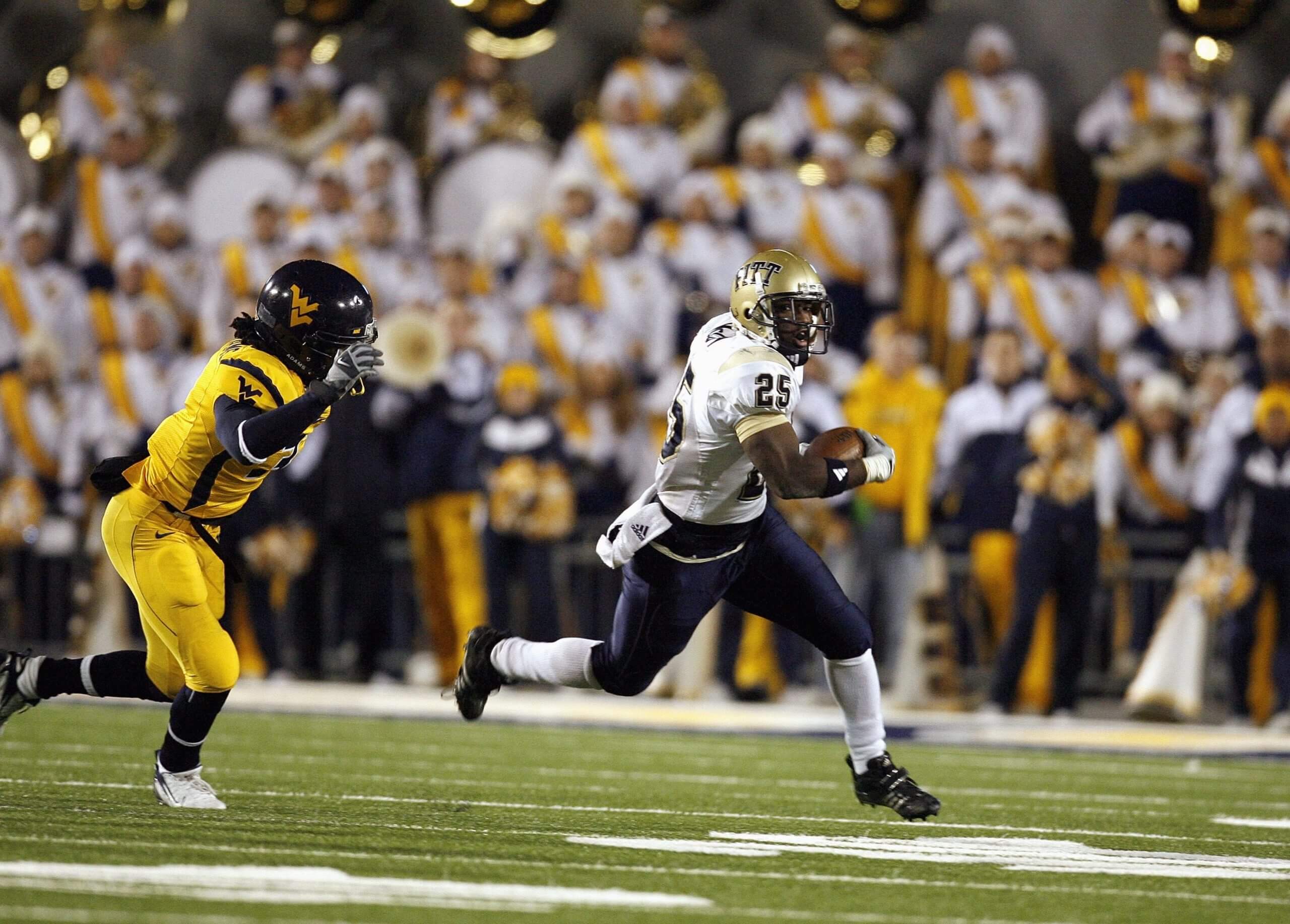

What to know: With Oklahoma State’s rise this century, “Bedlam” became one of the most entertaining games every season. And with several competitive games, the win disparity is surprising. Now a dormant series, it’s likely Bedlam’s importance will wane outside of Oklahoma.
- The Cowboys-Sooners rivalry endured for 114 consecutive years from 1910-2023. Oklahoma left for the SEC in 2024 and there are no future games on the docket.
- The rivals have played 19 games while both ranked, with the Sooners holding an incredible 17-2 advantage. Oklahoma State has seven total wins against ranked Oklahoma teams.
- The Sooners’ 71-win advantage (91-20-7) is tied for the second-most among FBS programs, trailing only Oklahoma’s 73-win spread (80-7-2) over Iowa State. Oklahoma’s 91 wins are tied with Nebraska (over Kansas) for the most over a single opponent.
Biggest game: No. 2 Oklahoma and No. 3 Oklahoma State met in the 1984 season finale with national title hopes and an Orange Bowl bid at stake. Although the Sooners dominated the statistics, the Cowboys held tough until a fumbled fair catch led to the Sooners’ game-clinching score in a 24-14 win. Oklahoma ended the year ranked No. 6 and Oklahoma State finished No. 7. It’s one of two times both teams finished in the AP top 10, along with 2021.
Photo:
Brian Bahr/Getty Images
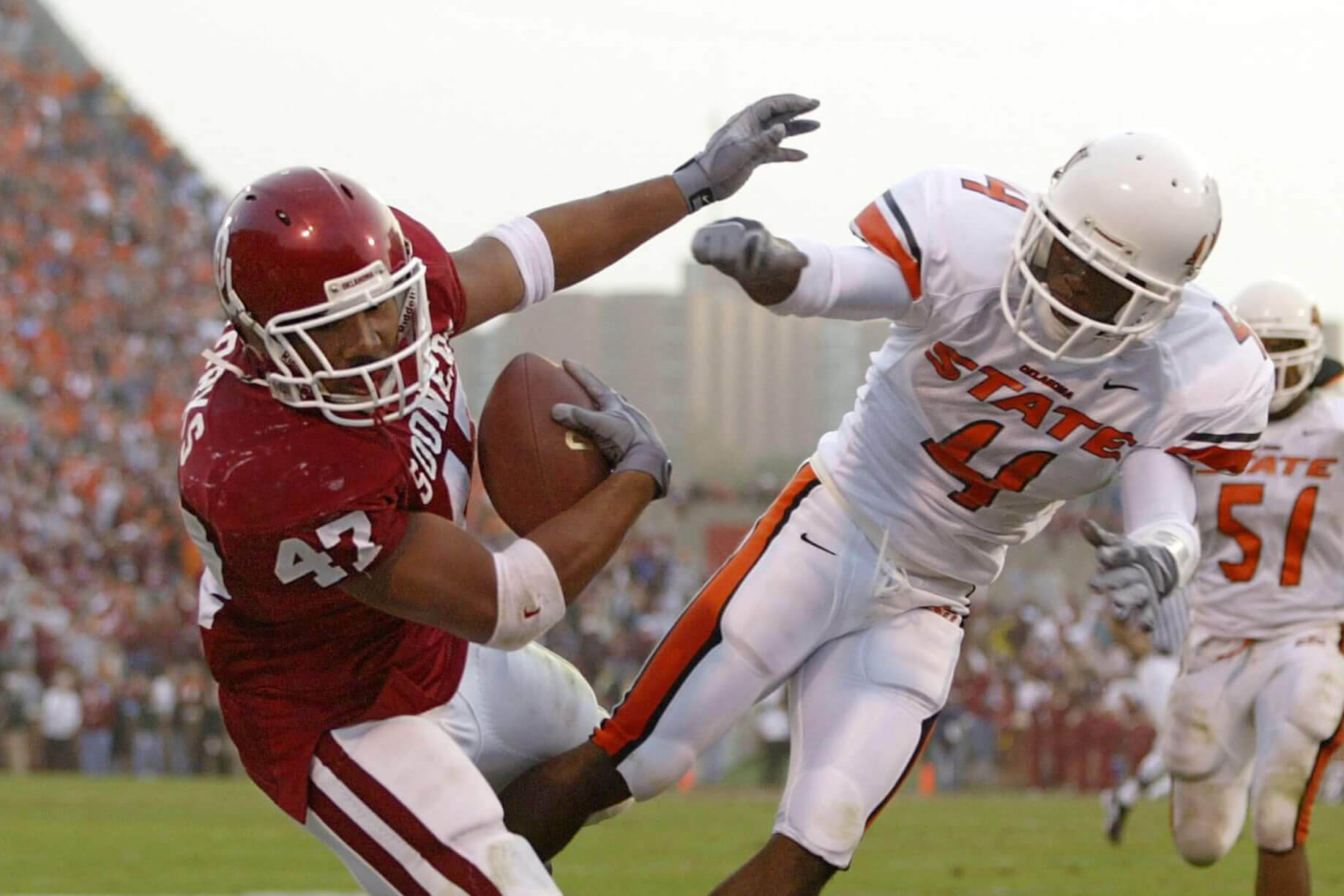

What to know: The Palmetto Bowl ranks among the more vicious in-state rivalries. The teams were ACC charter members in 1953 and competed there until South Carolina left in 1971. The nonconference nature makes the stakes local, although they’ve had several impactful games over the past 15 years.
- The schools played every year from 1909 until the pandemic in 2020. They began competing in the season’s final week in 1962 and continue that tradition today.
- They’ve met seven times as AP-ranked opponents, with South Carolina winning six. But when only one team is ranked, Clemson is 25-6-2 and was the sole team ranked in 30 games.
- The teams engaged in an ugly brawl at the end of their 2004 game, which Clemson won 29-7. The schools chose not to accept bowl bids as punishment for what took place.
Biggest game: In 2013, the rivals met for the only time as top-10 opponents and they entered the fourth quarter tied. No. 10 South Carolina went ahead 24-17, then No. 6 Clemson imploded with turnovers on four consecutive possessions. The Gamecocks took advantage of one mistake for the game-clinching score in a 31-17 win. South Carolina finished No. 4 while Clemson was ranked No. 8.
Photo:
Isaiah Vazquez/Getty
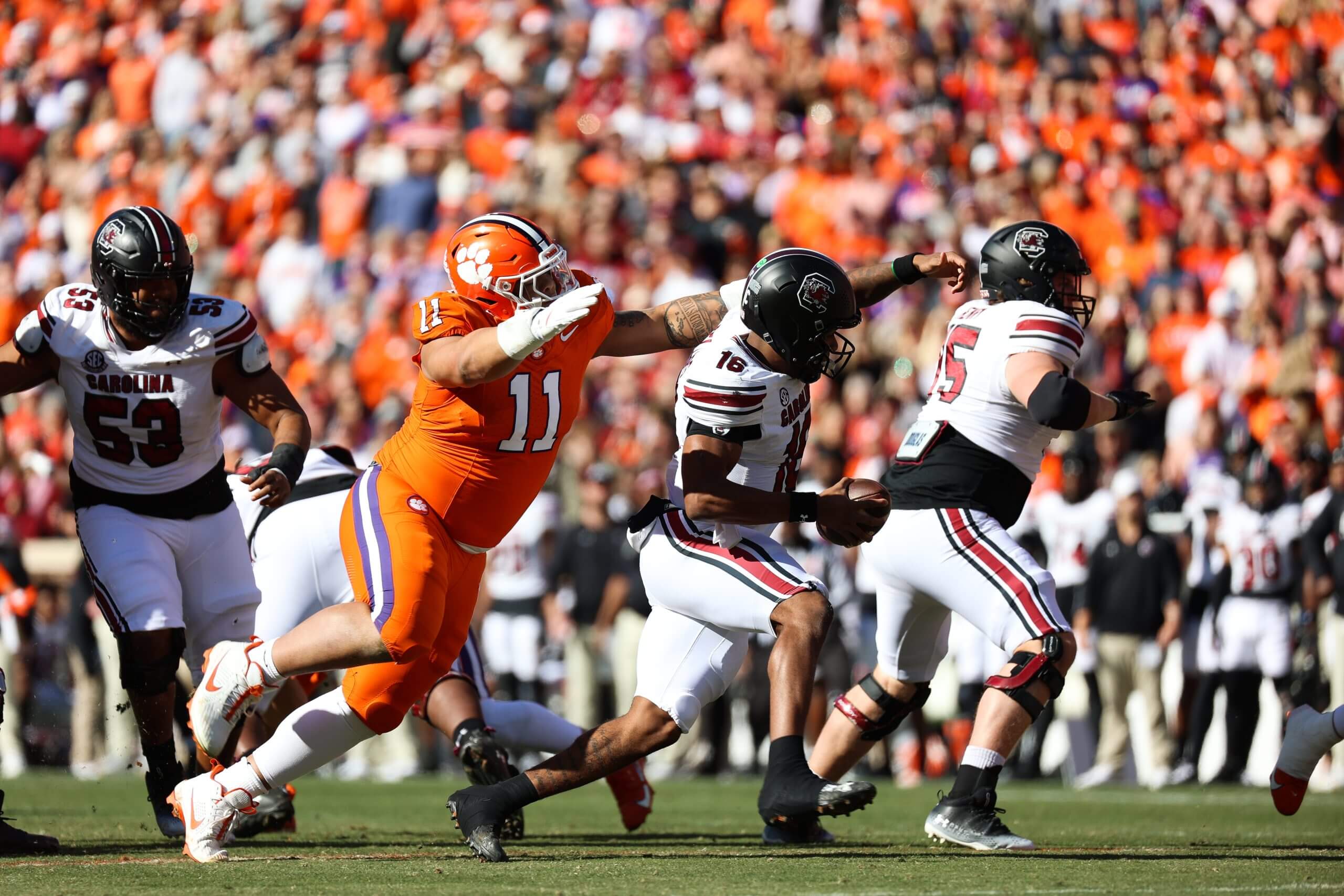

What to know: Every in-state rivalry has a distinguishing characteristic, and this one is no exception. The history, longevity and the willingness to move the game to Jackson for nearly two decades to accommodate more fans makes it a true people’s rivalry. It may be the best current rivalry without regular championship implications.
- The “Egg Bowl” is so-named for the Golden Egg Trophy given to the winning team. Initially designed to look like a football, the trophy is shaped more like an egg. It was born in the aftermath of an on-field melee between the teams in 1926 and commissioned for 1927.
- This rivalry ranks second in games played among SEC programs at 121, trailing only Auburn-Georgia. Ole Miss-Mississippi State has been played every year since 1914.
- Both teams have been ranked in the AP poll for six meetings, with Ole Miss holding a 3-2-1 advantage.
Biggest game: In 2014, No. 4 Mississippi State eyed an at-large berth in the inaugural College Football Playoff entering the season finale against Ole Miss. But the No. 18 Rebels relished playing spoiler with quarterback Bo Wallace outdueling counterpart Dak Prescott in a 31-17 Ole Miss win. Both teams qualified for New Year’s Six bowls with the Bulldogs in the Orange and Rebels in the Peach.
Photo:
Streeter Lecka/Getty
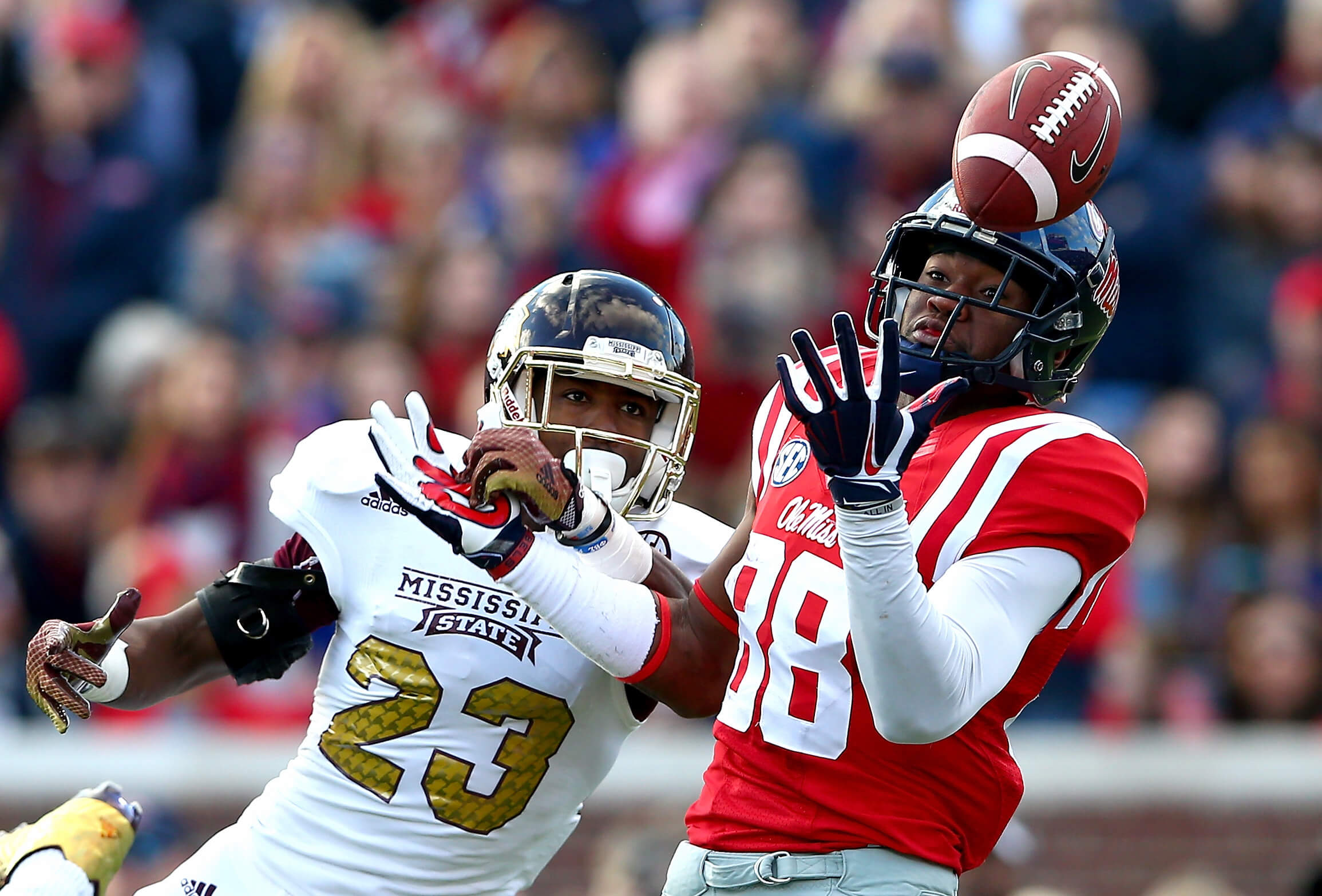

What to know: In perhaps the most overlooked great rivalry, these Upper Midwest programs combined for seven division titles and nine 10-win seasons over the Big Ten West’s 10-year existence. They are built with the same tenets of physicality and power, which make for some of college football’s hardest-hitting games.
- Iowa and Wisconsin are located 175 miles apart and have played 41 games in which at least one team was ranked. That includes nine times they faced off as ranked opponents, with Iowa holding a 5-4 advantage.
- Big Ten expansion twice sidelined this rivalry (1993-94, 2011-12) but each time the league reconfigured its alignment to allow it to continue. The battle for the Heartland Trophy is one of 12 protected rivalries in the 18-team Big Ten.
- Either an unranked or lower-ranked team has beaten a top-10 squad six times. One outside of that category was their 2004 season-ending clash. With a share of the Big Ten title at stake, No. 9 Iowa blasted No. 17 Wisconsin 30-7.
Biggest game: In 2010, top-15 teams collided in Iowa City with 30 draft picks (15 on each side) and battled through eight lead changes. A fake punt, a twisting TD by Wisconsin’s Montee Ball and a blocked PAT from J.J. Watt led to a 31-30 Badgers win. The victory propelled Wisconsin to a share of the Big Ten title.
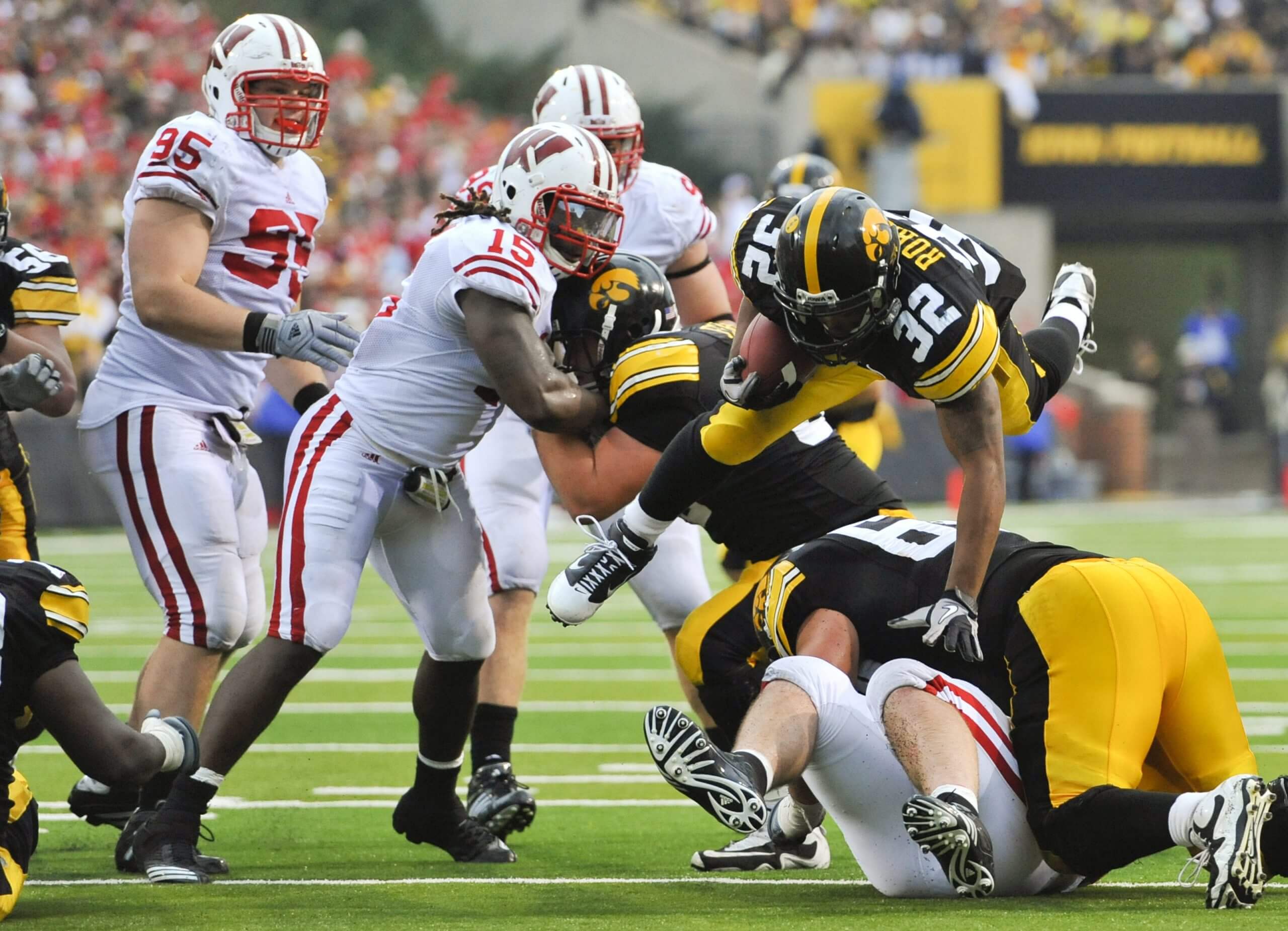

What to know: These border foes have engaged in a different type of rivalry with one another than with their in-state foes, and this one has especially gained prominence the last 15 years. This Pacific Northwest series has the highest growth trajectory of any current rivalry.
- Washington and Oregon have played 116 times, which is tied for the Huskies’ most-played rivalry and ranks second for the Ducks. Washington’s first game with Oregon took place just two days after it played Washington State for the first time.
- They’ve played 10 games with both in the AP poll, seven of which have happened since 2012. In 2023, they played two classics with both ranked in the top 10. With their new Big Ten affiliation, their series has moved to Thanksgiving weekend.
- The teams have competed in the same conference every year since 1915 except for a five-year block from 1958-63. The Pacific Coast Conference imploded after 1958, then reformed in piecemeal until 1964. The teams still played one another those years.
Biggest game: With the final Pac-12 championship serving as the backdrop, No. 3 Washington and No. 5 Oregon played a rematch that goes down as a legacy-defining game. Behind All-American QB Michael Penix, Washington led 20-3, before Bo Nix and Oregon took the lead with three TDs. The Huskies rallied with 10 points, then ran out the clock for a 34-31 win and CFP berth.
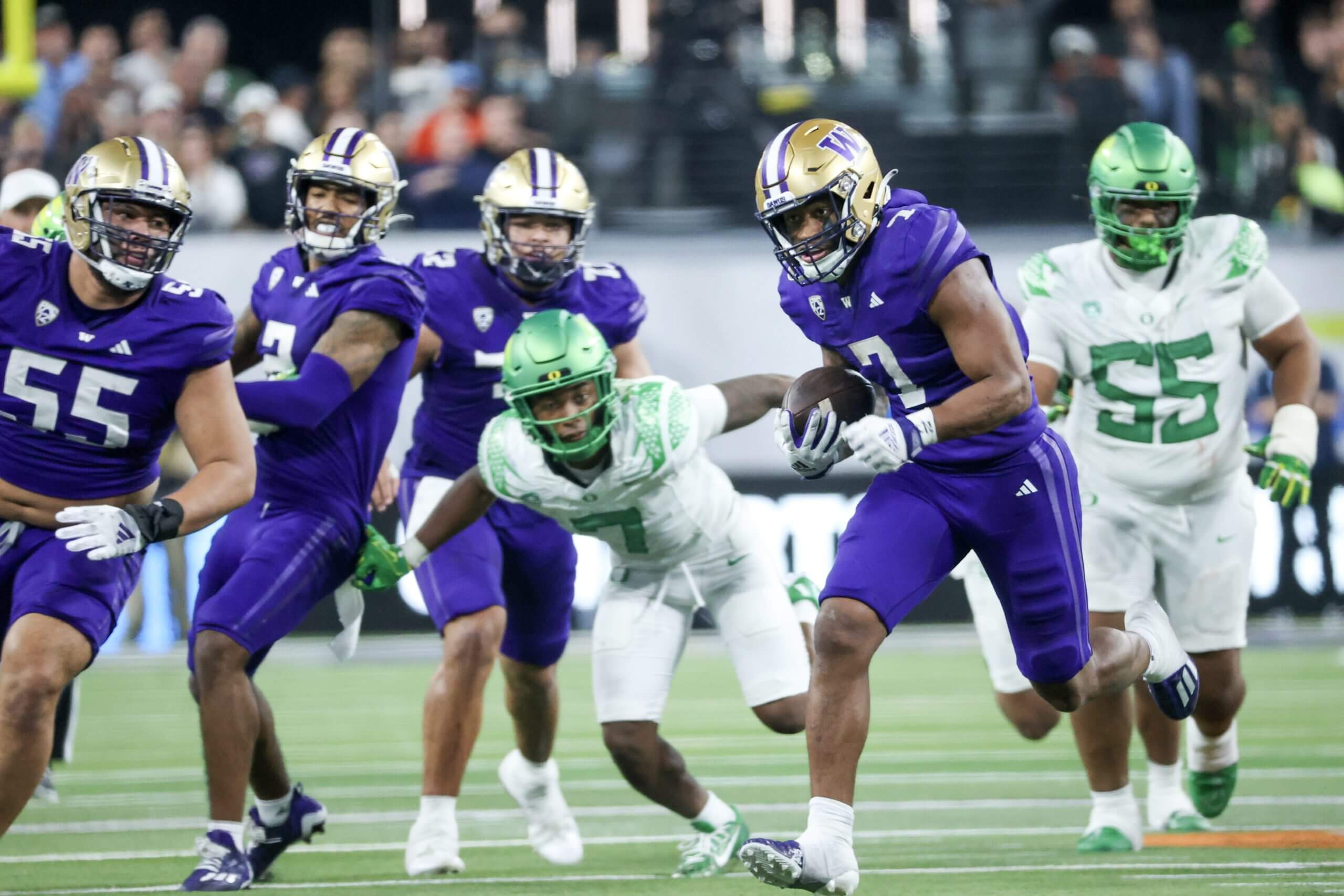

What to know: U.S. presidents have coached in and attended “The Game,” and some of the nation’s most impactful leaders have donned Harvard jerseys and Yale helmets. Harvard-Yale doesn’t determine a national champion, but its legacy is so tethered to college football history that to extract it would be to remove the entire sport from its existence.
- Harvard-Yale boasts the third-most games played behind Lehigh-Lafayette and Yale-Princeton.
- A brawl in 1894 sidelined the rivalry for two seasons and football’s perpetual rough play led Theodore Roosevelt to bring in officials from Harvard, Yale and Princeton to the White House in 1905 and demand changes or he would ban the sport.
- Both teams have won 18 Ivy League outright league titles. Harvard has one more shared crown (nine) but Yale prevented the Crimson from an outright league title last fall with a 24-19 upset.
Biggest game: In 1968, Yale entered “The Game” on a 16-game winning streak and both teams were 8-0. The Bulldogs led Harvard 29-13 midway through the fourth quarter before the Crimson cut its deficit to eight points with a TD and 2-pointer with 42 seconds left. Harvard recovered the onside kick and scored a TD and a 2-pointer with no time left for the tie. The headline in The Crimson student paper said it all: “Harvard beats Yale 29-29.”
Photo:
Frank O’Brien/Getty


What to know: Other rivalries are more prominent but perhaps only Michigan-Ohio State features the same level of contempt for the other side among interstate series. It was long known as the Border War, in part because of the guerilla war that raged on both sides of the Missouri River from 1854-65. The sides tried to soften it by calling it the Border Showdown, but only school officials use that term.
- When Missouri and Kansas met for the final time as conference foes in 2011, this rivalry sat one game behind Minnesota-Wisconsin as the most-played series in major college football. When Missouri bolted for the SEC in 2012, it wanted to retain its rivalry with Kansas. The Jayhawks had no interest in reciprocating until this fall.
- In actual games played, Missouri leads the series by one game. In 1960, No. 11 Kansas knocked off No. 1 Missouri, but it later was ruled a forfeit because the Jayhawks used an ineligible player. Missouri counts the tally as 57-54-1.
- They’ve met only three times while both ranked in the AP poll, with Kansas wins in 1968 and 1973 and a Missouri win in 2007. Unranked teams have 10 wins over ranked opponents in the series.
Biggest game: There was never a bigger Border War than in 2007 when No. 2 Kansas faced No. 3 Missouri at Arrowhead Stadium. It was the first time they met as ranked opponents since 1973 and a Big 12 North Division title was at stake. The Tigers scored three early touchdowns and held off Kansas’ furious second-half rally to win 36-28 and vault to No. 1 in the next poll before a Big 12 title loss to Oklahoma knocked it ouf of the national championship chase.
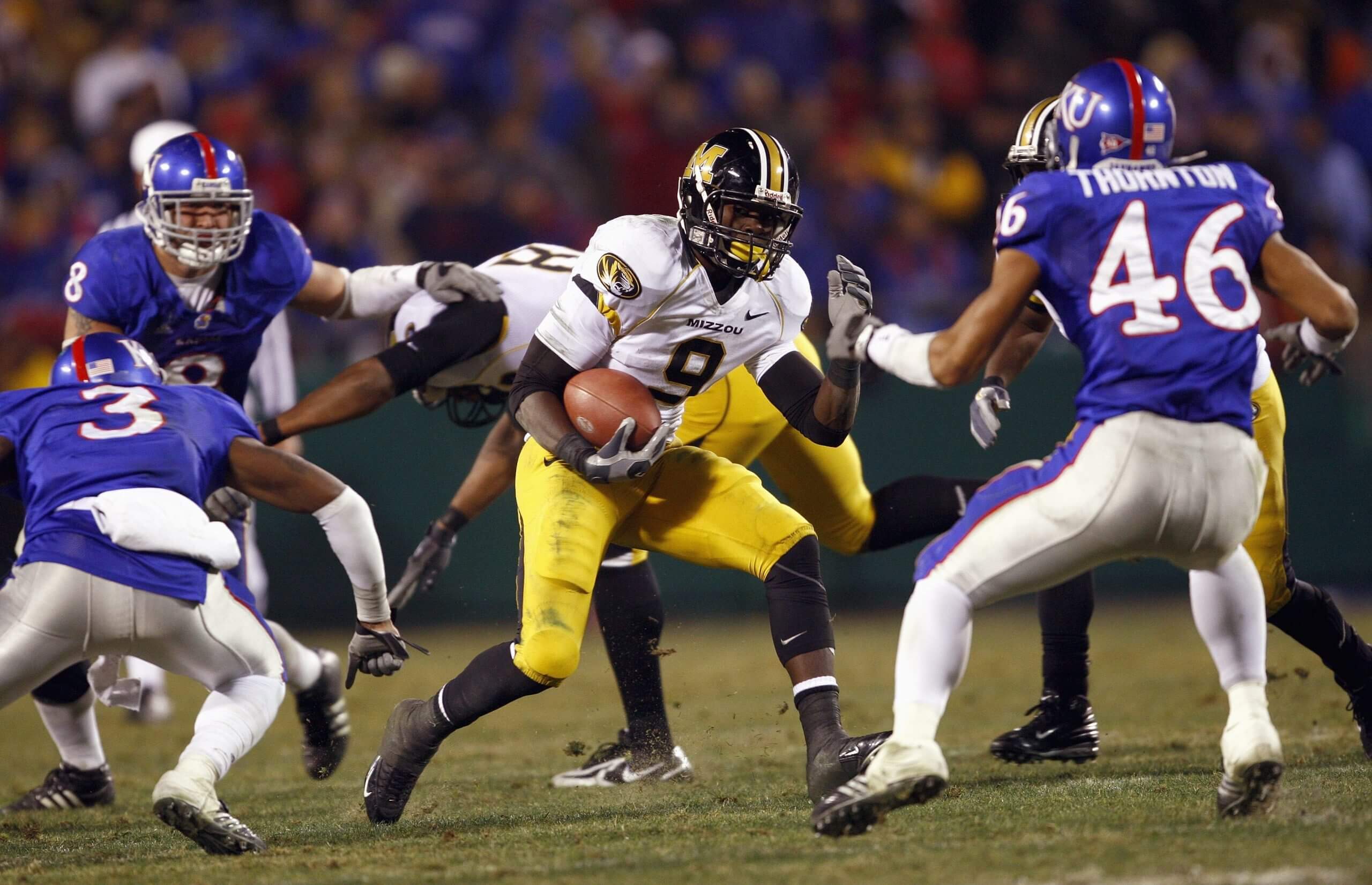

What to know: This has almost every element of a tier-one rivalry. It has mutual dislike, history, geography and prominence. They are the two winningest programs in college football history with a combined 23 national titles (12 Michigan, 11 Notre Dame) with the two most iconic fight songs. If it ever returned to annual status, it’s easily a top-10 rivalry. But the infrequency knocks it down a few spots.
- The rivalry became a feud early when Michigan’s Fielding Yost refused to play Notre Dame or allow its entry into the Big Ten and pushed for league teams to avoid scheduling the Irish. Fritz Crisler employed a similar strategy, which is why between 1909-78, they met only twice.
- For more than three decades, Notre Dame-Michigan served as college football’s first litmus test every September. From 1978 through the most recent meeting in 2019, both were ranked in 23 of their 33 games.
- They’ve faced off eight times as top-10 foes, and the Irish hold a 4-3-1 edge. Notre Dame’s 1943 win was the AP poll’s first No. 1 vs. No. 2 matchup.
Biggest game: Defending national champion and top-ranked Notre Dame traveled to No. 2 Michigan in September 1989 for the Wolverines’ opener. Irish speedster Raghib Ismail returned the second-half kickoff for a 92-yard TD, then brought back another 88 yards for a score to lead Notre Dame to a 24-19 win.
Photo:
Jonathan Daniel/Allsport
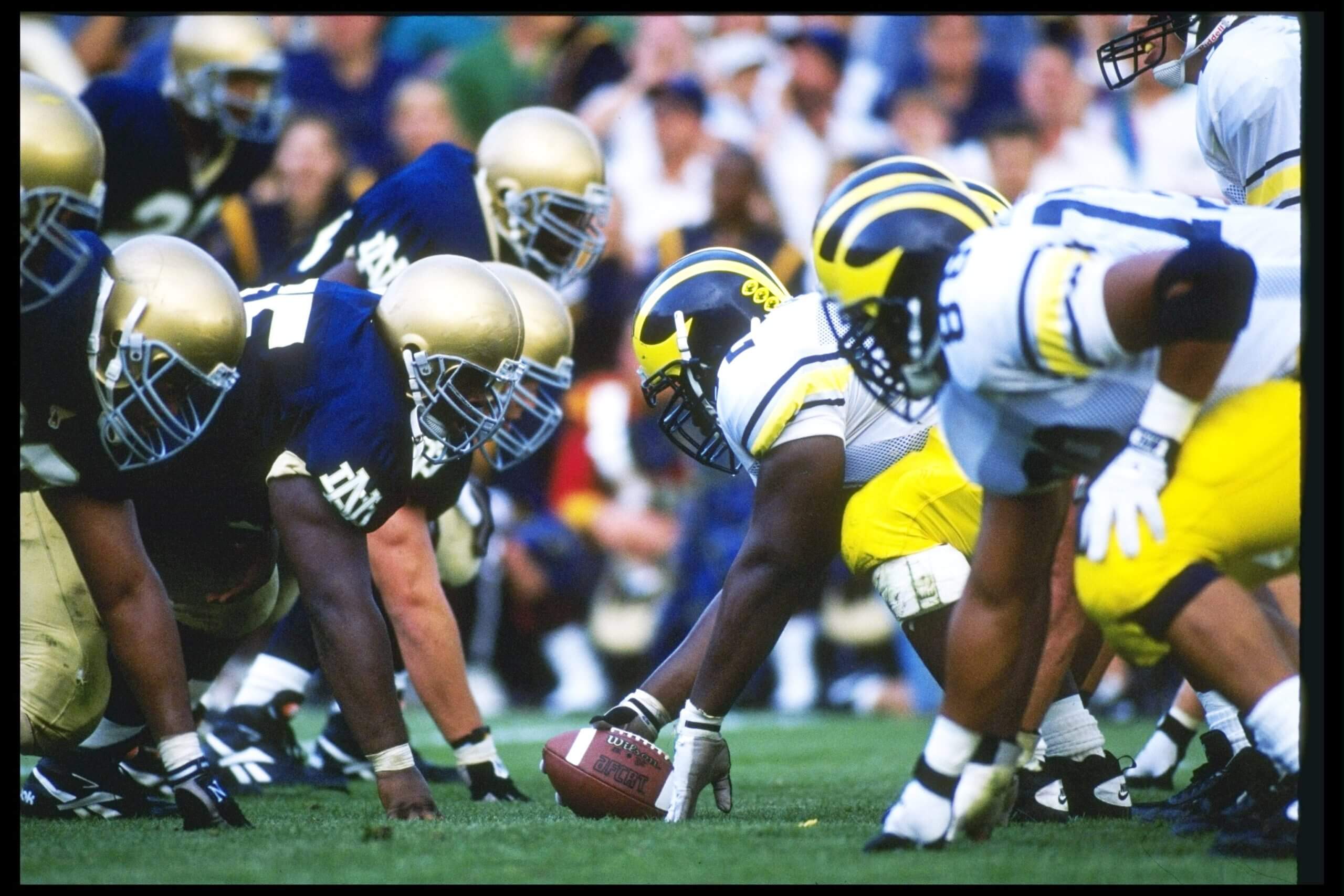

What to know: Each team has another rival that brings out a bit more passion, but the history, proximity (175 miles) and competitiveness make this an annual marquee matchup in both the SEC and nationally.
- Known as “The Deep South’s Oldest Rivalry,” its 129 games rank tied for second with Virginia-UNC in FBS history.
- Competitively, this is one of the closest high-level rivalries. They have 24 ranked matchups (14-10 Auburn), including six top-10 battles (4-2 Auburn).
- From 1992-2023, Auburn-Georgia was a protected SEC cross-divisional rivalry. Often there were efforts to end East-West protected series, but both schools (along with Tennessee and Alabama) thwarted efforts to do away with them.
Biggest game: The first of two improbable victories for No. 7 Auburn in 2013 took place at home against No. 25 Georgia. With the Bulldogs leading 38-37, the Tigers faced fourth-and-18 with 36 seconds left. Nick Marshall launched a pass down the middle that was tipped into Ricardo Louis’ hands for a 73-yard TD and a 43-38 win. It’s known as “The Prayer at Jordan-Hare.”
Photo:
Scott Cunningham/Getty Images
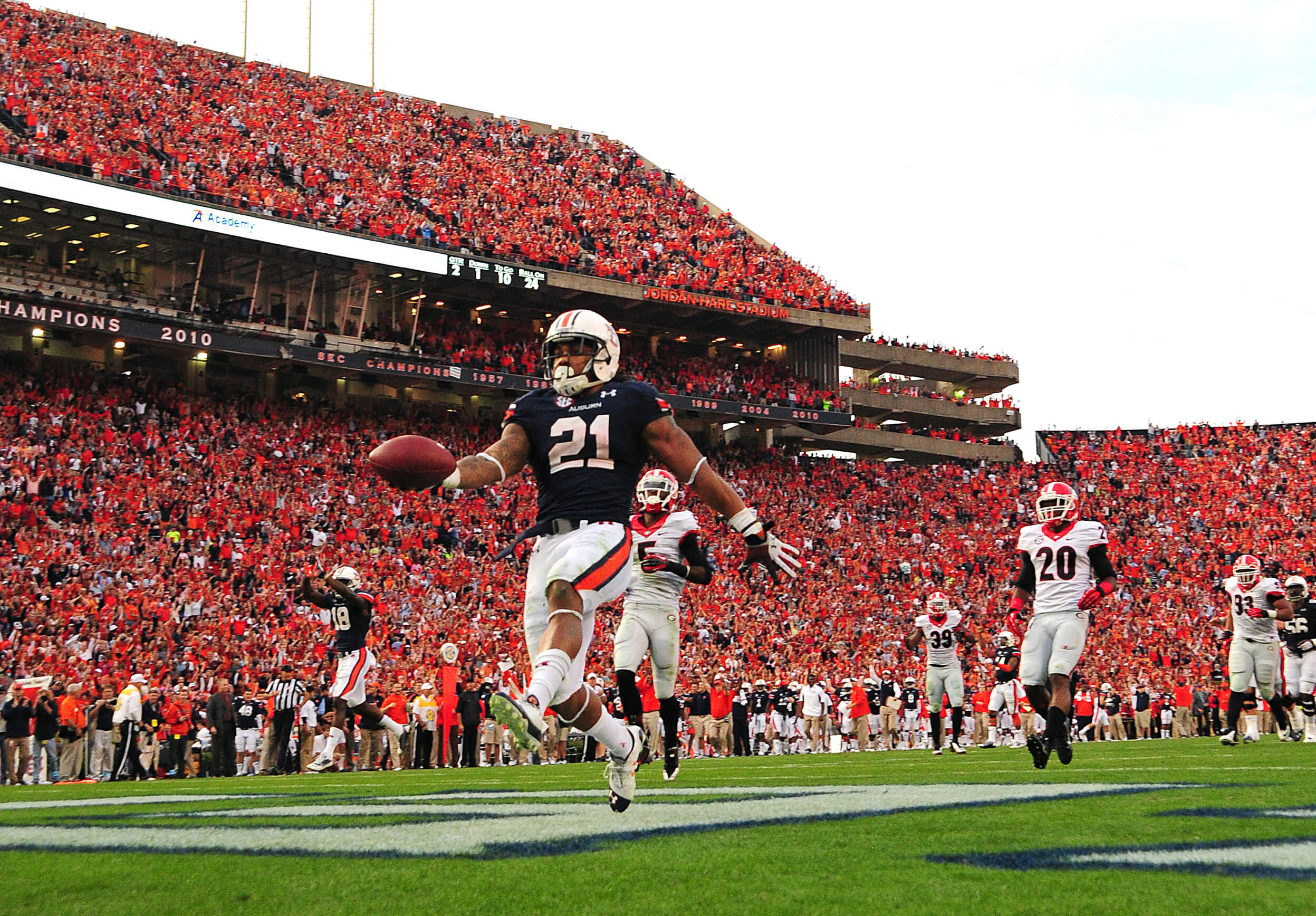

What to know: Every in-state rivalry has passion and intensity, but this one often boils over the top. It’s probably the most vicious in-state rivalry with pregame and postgame altercations between players, some of which have led to player arrests. It’s also a competitive series involving two of the Big Ten’s better programs, which is why it outranks most in-state rivalries.
- Unpredictability elevates Michigan-Michigan State into one of the nation’s best. The Spartans have 11 wins against the Wolverines when they’re ranked in the top seven, including an upset of No. 1 Michigan in 1990. And despite Michigan’s overall edge in the series, Michigan State is 11-7-1 when both teams are ranked.
- Michigan running back Mike Hart called the Spartans “little brother” in 2007, and the slight fueled Michigan State and coach Mark Dantonio for the next decade. The Spartans then won eight of the next 10.
- The programs compete for the Paul Bunyan Trophy, donated by former Michigan governor G. Mennen Williams when Michigan State joined the Big Ten in 1953.
Biggest game: About a dozen games could qualify but none rates as high as their 2015 encounter. No. 12 Michigan led No. 7 Michigan State 23-21 with 10 seconds left. A bobbled snap on a punt led to a mid-air scoop by Michigan State’s Jalen Watts-Jackson, who returned the fumble for a touchdown with no time remaining. The victory led the Spartans to the Big Ten title and a Playoff berth.
Photo:
Danny Moloshok/Allsport


What to know: When it comes to pure passion, few can match this one. But the win-loss column is fairly uneven and there aren’t nearly as many ranked matchups as other rivalries. Its fierce competition, however, keeps it as a top-15 rivalry.
- Both universities mention the other in fight songs. The opening lyric to “Texas Fight” begins “Texas fight, Texas fight, and it’s goodbye to A&M.” The second verse of “Aggie War Hymn” starts with “Good-bye to Texas University. So long to the orange and the white.”
- Their rivalry has spanned three leagues. Both competed as Southwest Conference members from 1915 until it dissolved after 1995. The Longhorns and Aggies (plus Baylor and Texas Tech) merged with the Big Eight to form the Big 12 in 1996, and their mutual association lasted until 2012, when Texas A&M left for the SEC. Texas and Texas A&M reunited in 2024 when the Longhorns joined the SEC.
- Both teams have been ranked in 11 matchups, with Texas holding an 8-3 edge. They’ve met in the top 10 twice (1941, 1975) with each team winning one.
Biggest game: It was only fitting that No. 6 Texas and No. 16 Texas A&M met with the final Southwest Conference title at stake in 1995. Behind Ricky Williams’ 164 rushing yards and a defense forcing six turnovers, the Longhorns won 16-6 at Kyle Field to clinch their 19th outright SWC championship.
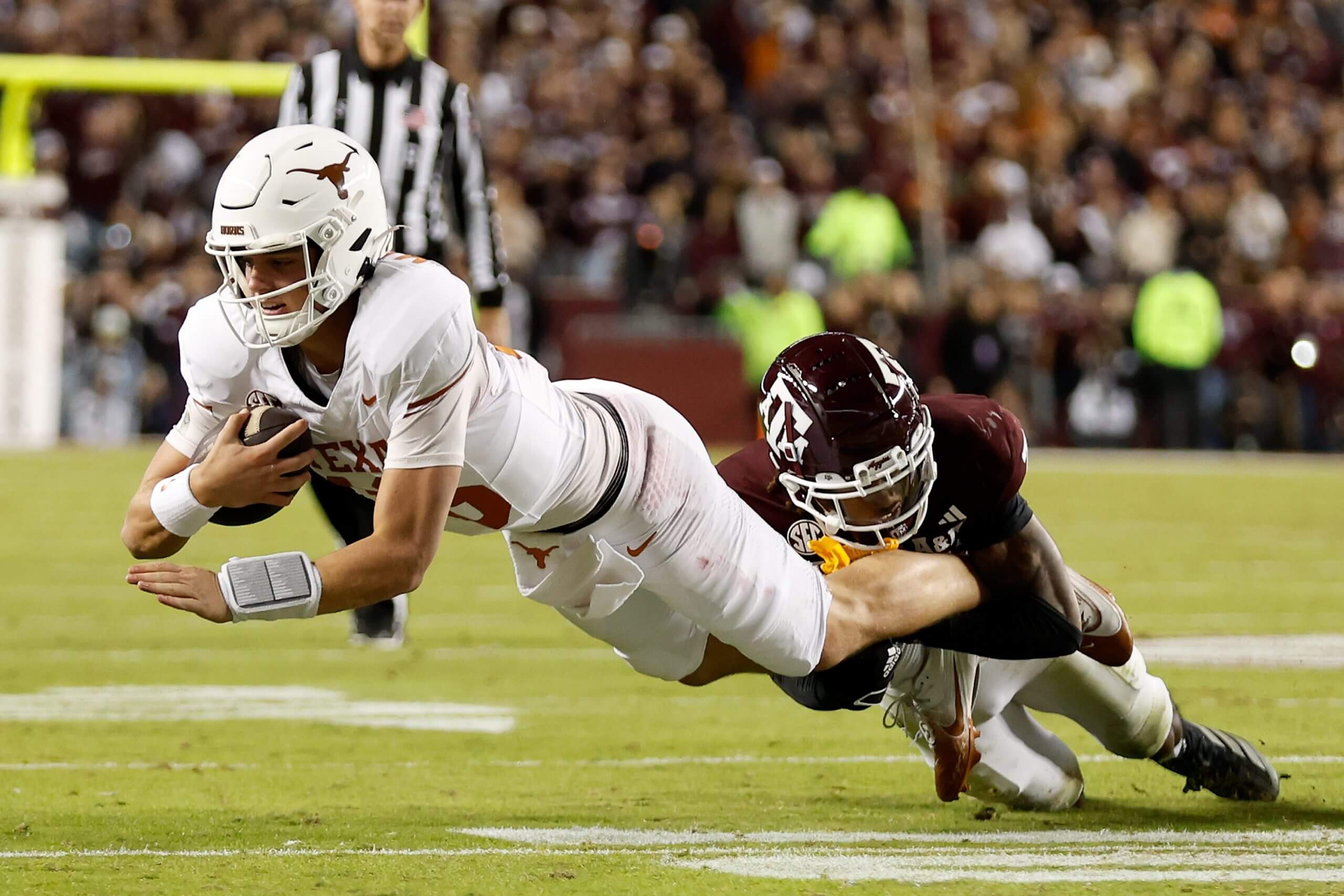

What to know: The battle of Los Angeles sometimes gets overlooked on rivalry weekend, but it not only harbors the same intensity of other key rivalries, it also brings out the stars.
- USC leads the series comfortably in overall games won, but when these foes go head-to-head as ranked foes, it’s an even matchup. They’ve faced off 27 times as ranked opponents with the ledger tied 13-13-1. The teams have split the 11 meetings when only UCLA is ranked 6-5, while USC holds a 17-7-2 advantage when it’s the only team ranked.
- By rivalry standards, this series arrived fashionably late. The teams played only twice before 1936 but have played every fall since, including in various iterations of the Pac-12 and now in the Big Ten.
- If there’s such a thing as a perfect jersey game, it’s when these teams compete in either the Coliseum or the Rose Bowl. Both wear their home jerseys, which previously netted penalties on the visiting team for not wearing white.
Biggest game: No. 1 UCLA faced No. 4 USC with the Rose Bowl on the line in 1967, and two players made strong cases for the Heisman. UCLA QB Gary Beban, who won the award, threw for 301 yards and led the Bruins to a six-point advantage in the fourth quarter. Three snaps later, 1968 Heisman winner O.J. Simpson took a handoff and raced 64 yards for a TD in a 21-20 Trojans win.
Photo:
Sean M. Haffey/Getty
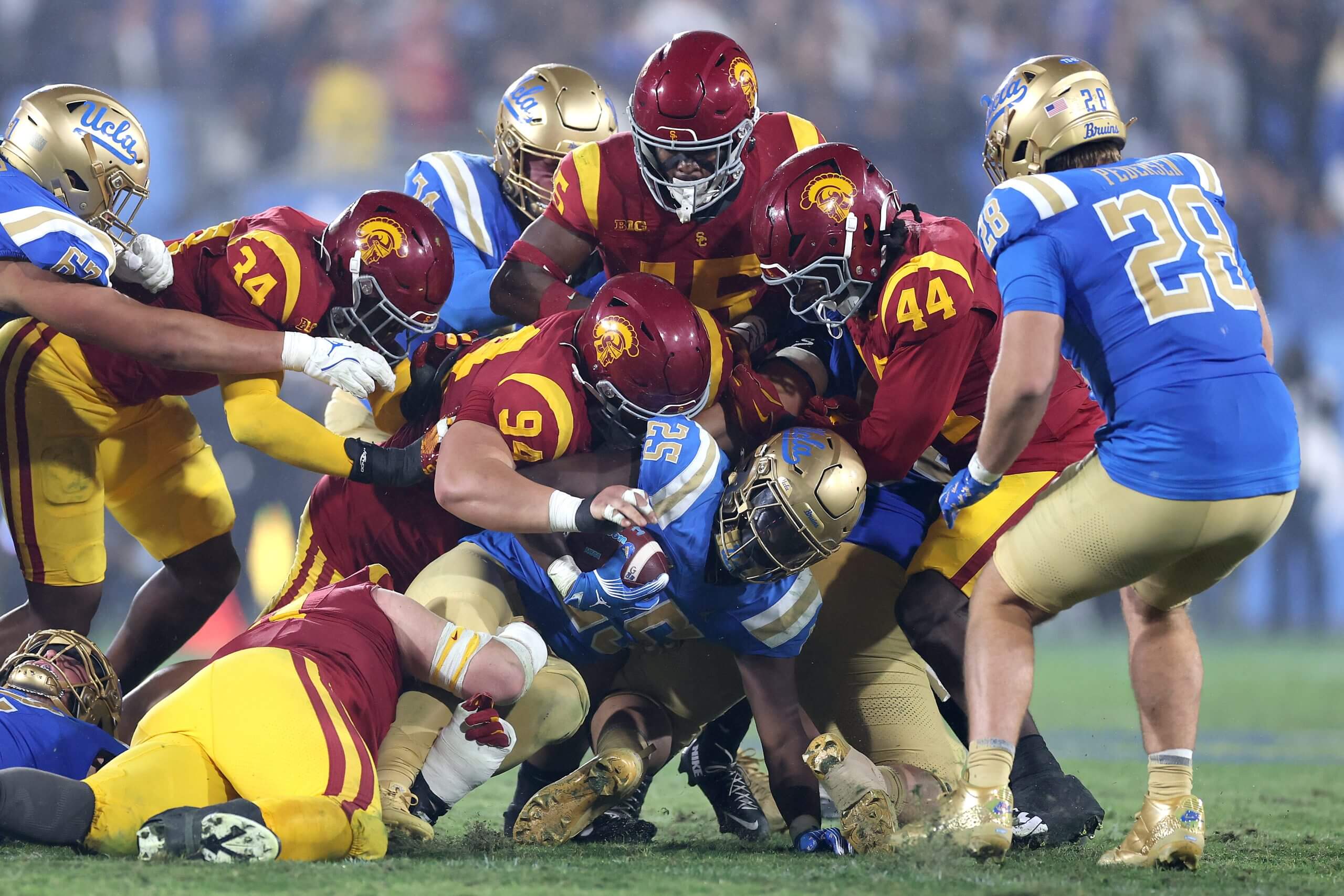

What to know: These teams may not share a border or play for a trophy, but Alabama-LSU is as important and competitive as any SEC rivalry. When the Crimson Tide and Tigers competed in the SEC West, they earned a combined 22 trips to the SEC title game. All the series lacks is a clever nickname.
- Over the past 22 seasons, they have combined for nine national championships. Alabama has won six (2009, 2011, 2012, 2015, 2017, 2020), while LSU has claimed three (2003, 2007, 2019). Nick Saban won seven of those titles with all six at Alabama and one (2003) at LSU.
- From the moment Bear Bryant became Alabama’s coach in 1958 through the present, at least one team has been ranked in 58 of 63 meetings. They’ve played 32 games as ranked opponents with Alabama holding a 21-10-1 edge.
- Since this rivalry became an annual series in 1964, every meeting but one has taken place in November or later — six times with both ranked in the AP top five.
Biggest game: In 2011, No. 1 LSU beat No. 2 Alabama 9-6 in overtime to claim their regular season matchup. They faced off again with the same rankings two months later for the BCS national title in New Orleans. Like the first matchup, in which nobody scored a touchdown, it was all field goals for the first three quarters. With 4:36 left in the game, Alabama running back Trent Richardson finally punched one over the goal line in a 21-0 win for the national title.
Photo:
Ronald Martinez/Getty
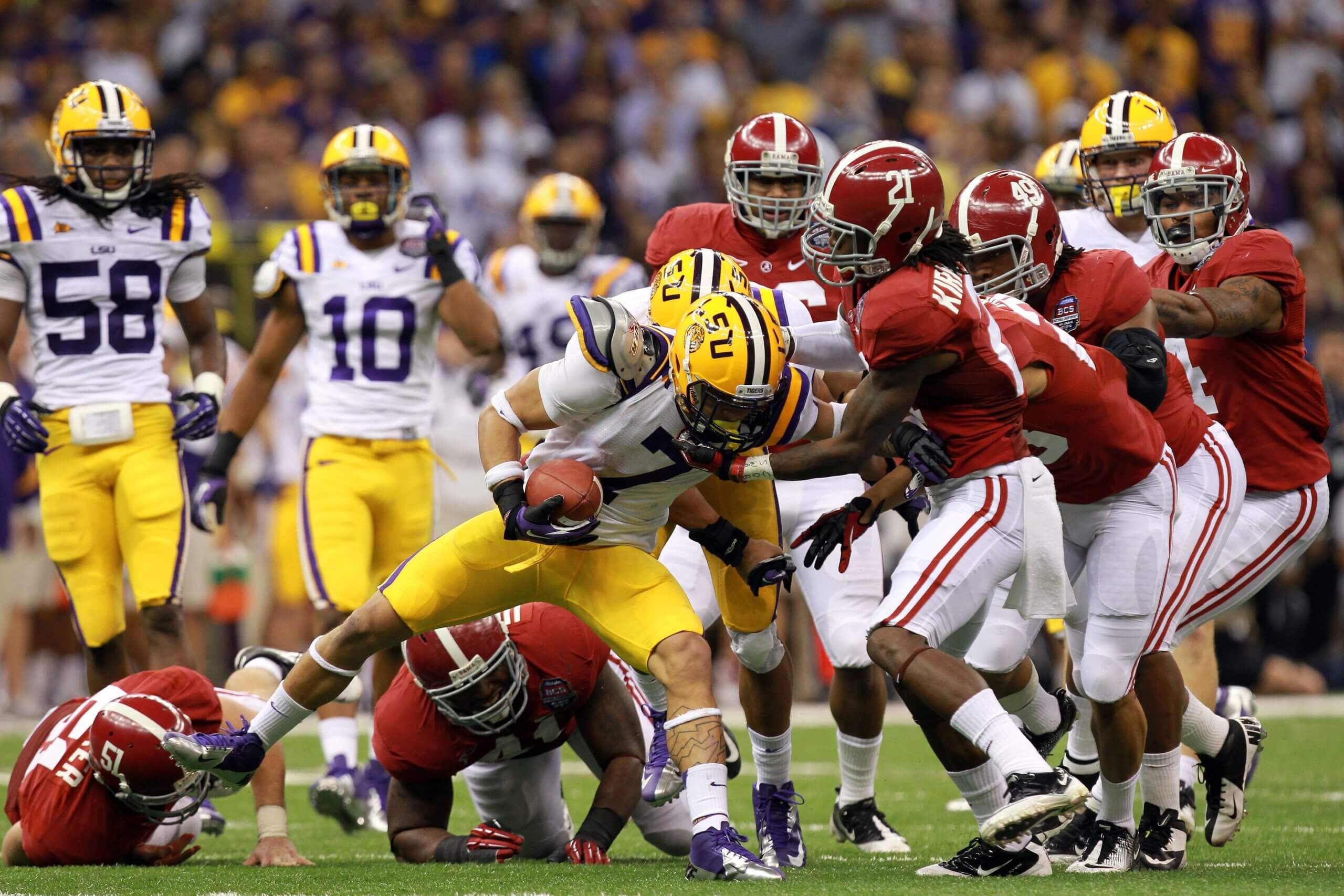

What to know: Each team has important in-state rivalries, but this ranks No. 1 for both programs and their fans. They’ve yet to have a top-five matchup, but the outcomes often lead directly to an SEC championship participant.
- The “World’s Largest Outdoor Cocktail Party” no longer is the preferred moniker to describe the Florida-Georgia game, but old nicknames die hard. The Bulldogs and Gators have met in Jacksonville, Fla., since 1933 (except in 1994-95 for stadium repairs) and they have agreed to a new contract through 2031.
- The teams have played 23 AP-ranked matchups to an 11-11-1 draw. In eight top-10 battles, the schools have won four apiece.
- Since 1992, either Florida or Georgia has participated in 76 percent of SEC championship games. Florida has qualified for 13 SEC title games and Georgia has 12 appearances. In addition, each program has won three national titles since 1980.
Biggest game: No. 2 Georgia’s hopes of an unbeaten season appeared dashed approaching the final minute of its 1980 clash with the No. 20 Gators. Down 21-20 and facing third-and-11 at the 7-yard line, Bulldogs QB Buck Belue rolled right and threw across his body to Lindsay Scott at the 25-yard line. With Georgia announcer Larry Munson shouting, “Run Lindsay!” the receiver outraced the defense for a 93-yard TD and a 26-21 victory. The Bulldogs later won the national title.
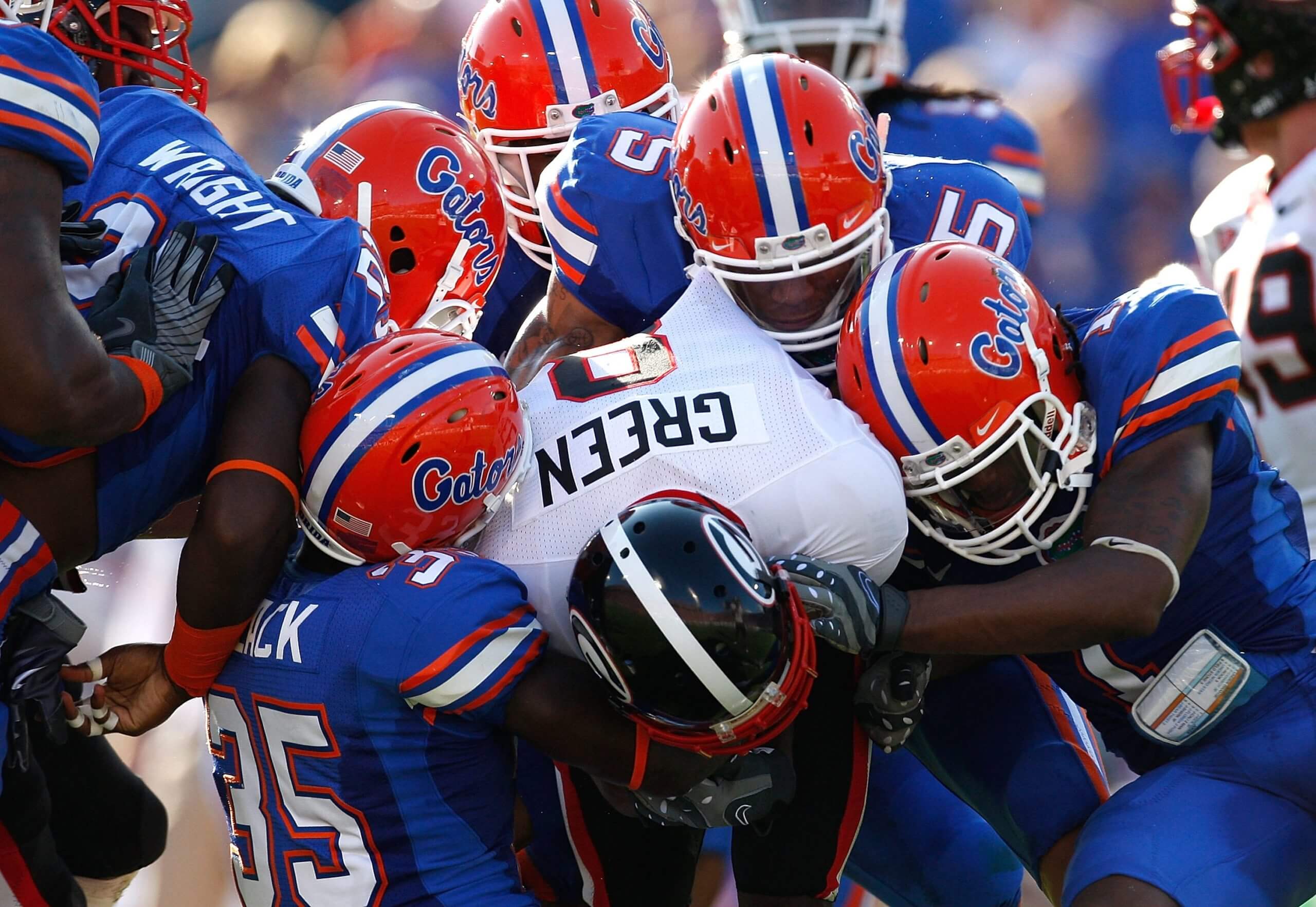

What to know: For more than a century, Alabama-Tennessee has been the SEC’s signature border-state clash. The Crimson Tide and Vols rank first and third in SEC winning percentage and conference titles, respectively. Tennessee’s program woes during Alabama’s unprecedented run under Nick Saban knocks this back a few notches, but it’s still a quintessential SEC rivalry.
- Christened as the “Third Saturday in October” since 1939, Tennessee and Alabama largely have stayed true to moniker, even as the SEC has taken more control over the schedule. Since 1998, their series frequently has drifted to the month’s fourth Saturday but they haven’t played outside of October since 1913.
- The teams have competed every season since 1928 except in 1943 amid WWII. It ranks third among Tennessee’s most-played series behind Kentucky and Vanderbilt, and for Alabama, it’s one game behind Mississippi State.
- The programs have both been ranked in 24 contests with Alabama holding a 13-10-1 advantage. Eleven were top-10 battles. At least one team was ranked in 48 other games.
Biggest game: The rivals entered their 2022 matchup unbeaten for the first time since 1989. The No. 6 Vols built a 28-10 lead, then No. 3 Alabama stormed back and took a 49-42 lead midway through the fourth quarter. Tennessee tied the score on Jalin Hyatt’s fifth touchdown catch. After getting the ball back with 15 seconds left, the Vols picked up a pair of chunk plays, then kicked a 40-yard field goal as time expired for a 52-49 victory.
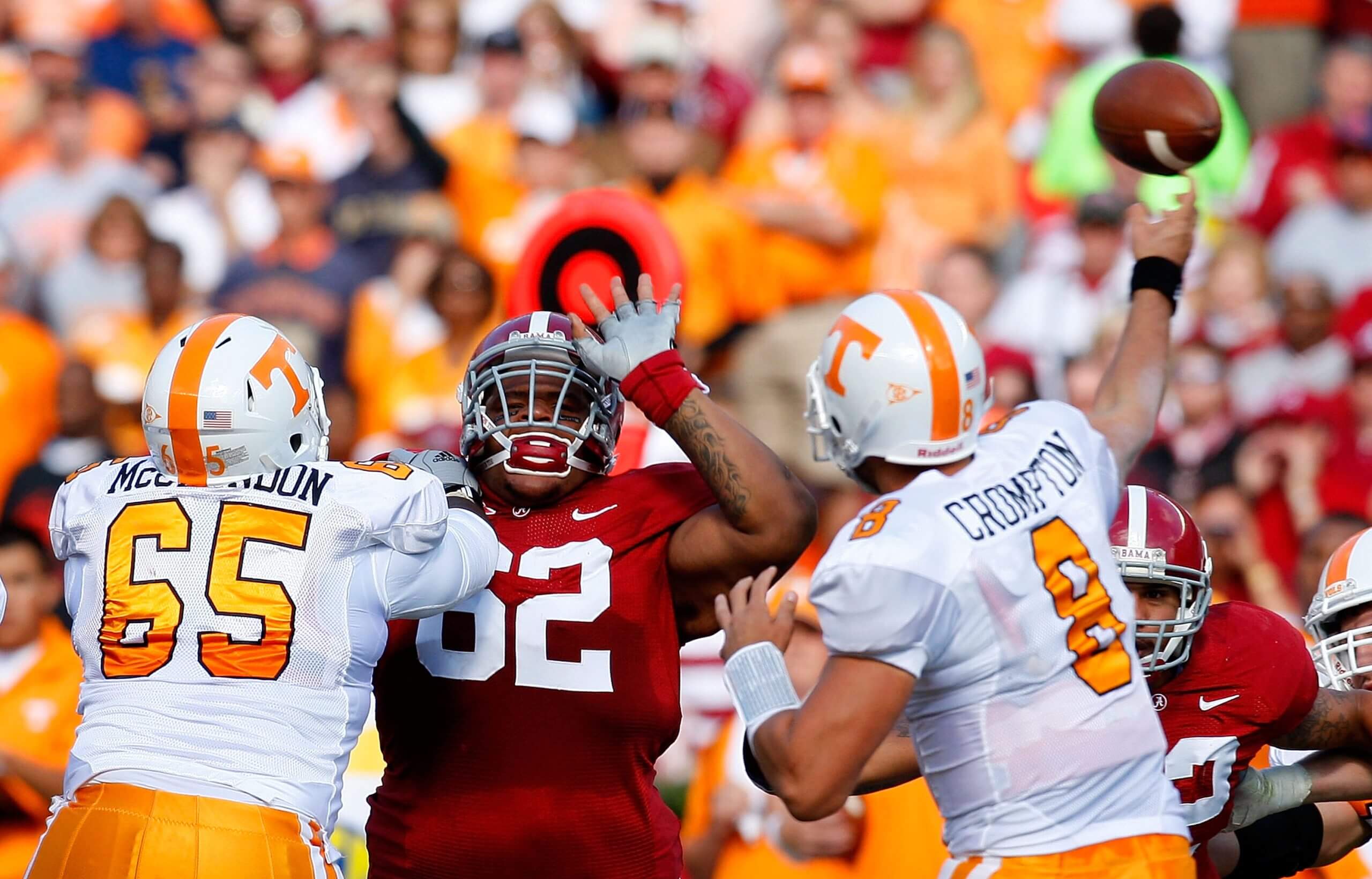

What to know: Perhaps no other border feud contains the ecstasy of victory and misery in defeat like Minnesota-Wisconsin. They are codependent Big Ten rivals in every sense of the word. While the Badgers have been more successful the last three decades, the result of this game impacts how every season is remembered for both teams.
- Wisconsin and Minnesota have played five more games against one another (134) than any other FBS series. In addition, the Gophers and Badgers have played every year since 1907 and have missed just one season on the gridiron (1906) since their first kickoff.
- There are few traveling trophies more recognizable than Paul Bunyan’s Axe. The winners take the Axe to each goal post and make chopping motions. They originally played for the “Slab of Bacon,” but it became lost in the 1940s and was discovered in 1994 at a Wisconsin storage facility. The Badgers refuse to hand it to the Gophers despite Minnesota winning it last.
- The Badgers are 7-0 in meetings in which both teams were ranked. Unranked Wisconsin also upset No. 3 Minnesota in 1961.
Biggest game: In the 1962 season finale, No. 3 Wisconsin hosted No. 5 Minnesota with the Big Ten title at stake. With a 9-7 lead, the Gophers intercepted a pass with two minutes left and appeared ready to close out the game. But a roughing the quarterback penalty followed by a personal foul on Minnesota coach Murray Warmath gave the ball back to the Badgers, who scored the winning touchdown a few plays later. Gophers fans chased down the officials and fought with Badgers players on the field after the game.
Photo:
Hannah Foslien/Getty
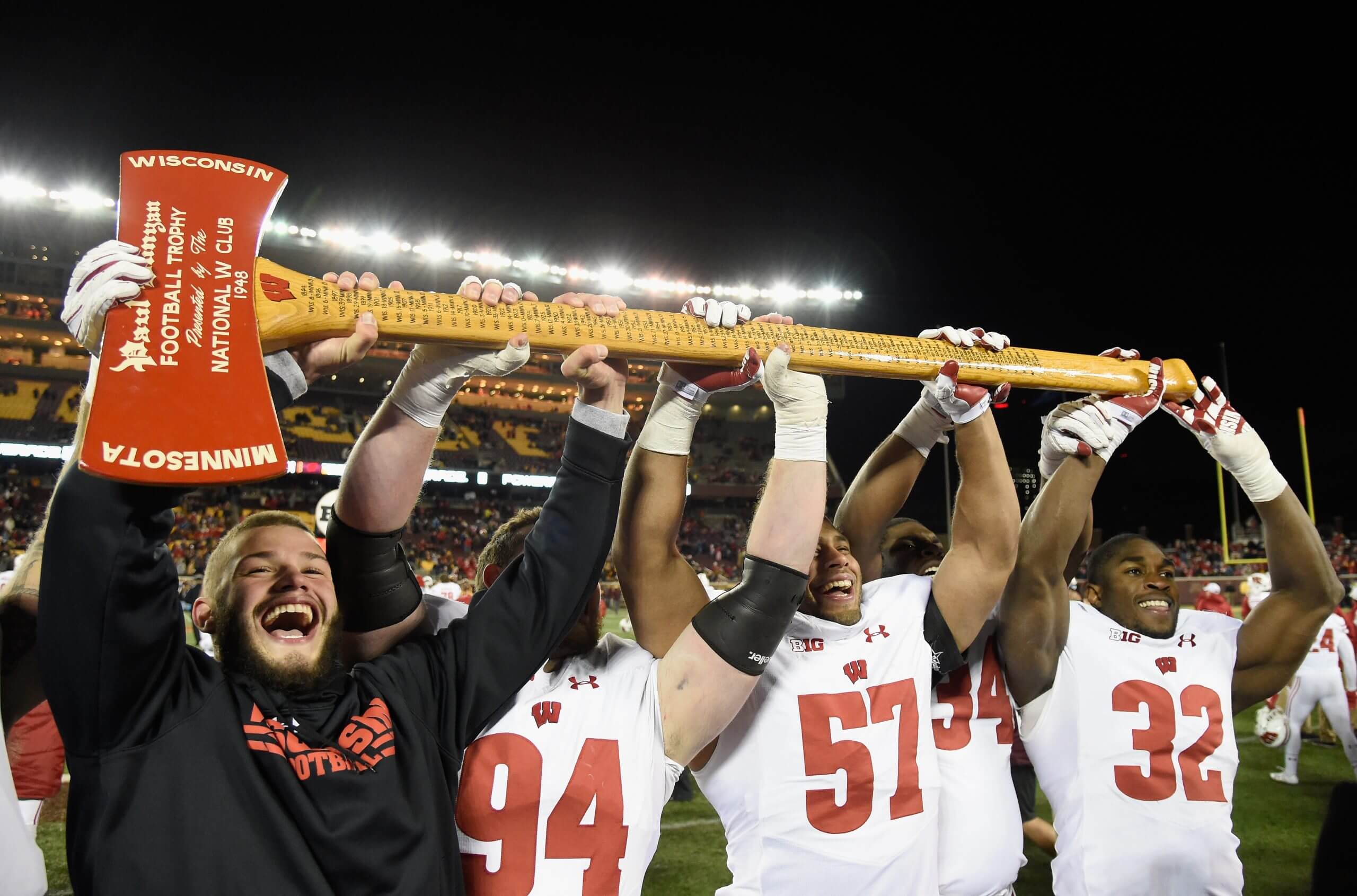

What to know: What was a nice in-state nonconference series turned into one of national consequence during the 1990s. With coaching legends Steve Spurrier and Bobby Bowden on opposite sides, Florida-Florida State set the table for many postseasons. Its annual importance may have diminished, but it’s still the most prominent SEC-ACC Thanksgiving weekend feud.
- This rivalry began relatively late with the series’ first game taking place in 1958. But the teams have played every season outside of 2020 and twice in bowl rematches.
- The teams have battled as ranked opponents 23 times (FSU leads 12-10-1) and at least one team was ranked in 75 percent of their matchups. They have played 14 games as top-10 opponents, which is tied for fifth among all rivalries.
- Following their infamous “Choke at Doak” tie to conclude the 1994 regular season, the Sugar Bowl invited both teams for a rematch. The Seminoles pulled off a 23-17 bowl win after rallying from 28 down in the fourth quarter to tie a few weeks earlier.
Biggest game: In the 1996 regular-season finale, No. 2 Florida State edged No. 1 Florida 24-21 and the quarterback hits rankled Spurrier. After Florida won the SEC title game, the Bowl Alliance lined up the No. 1 Seminoles and No. 3 Gators for the fifth time over a three-year span, again in the Sugar Bowl. Florida led by four points in the third quarter, then scored four second-half touchdowns in a 52-20 win. The Gators won the national title while Florida State fell to No. 3.
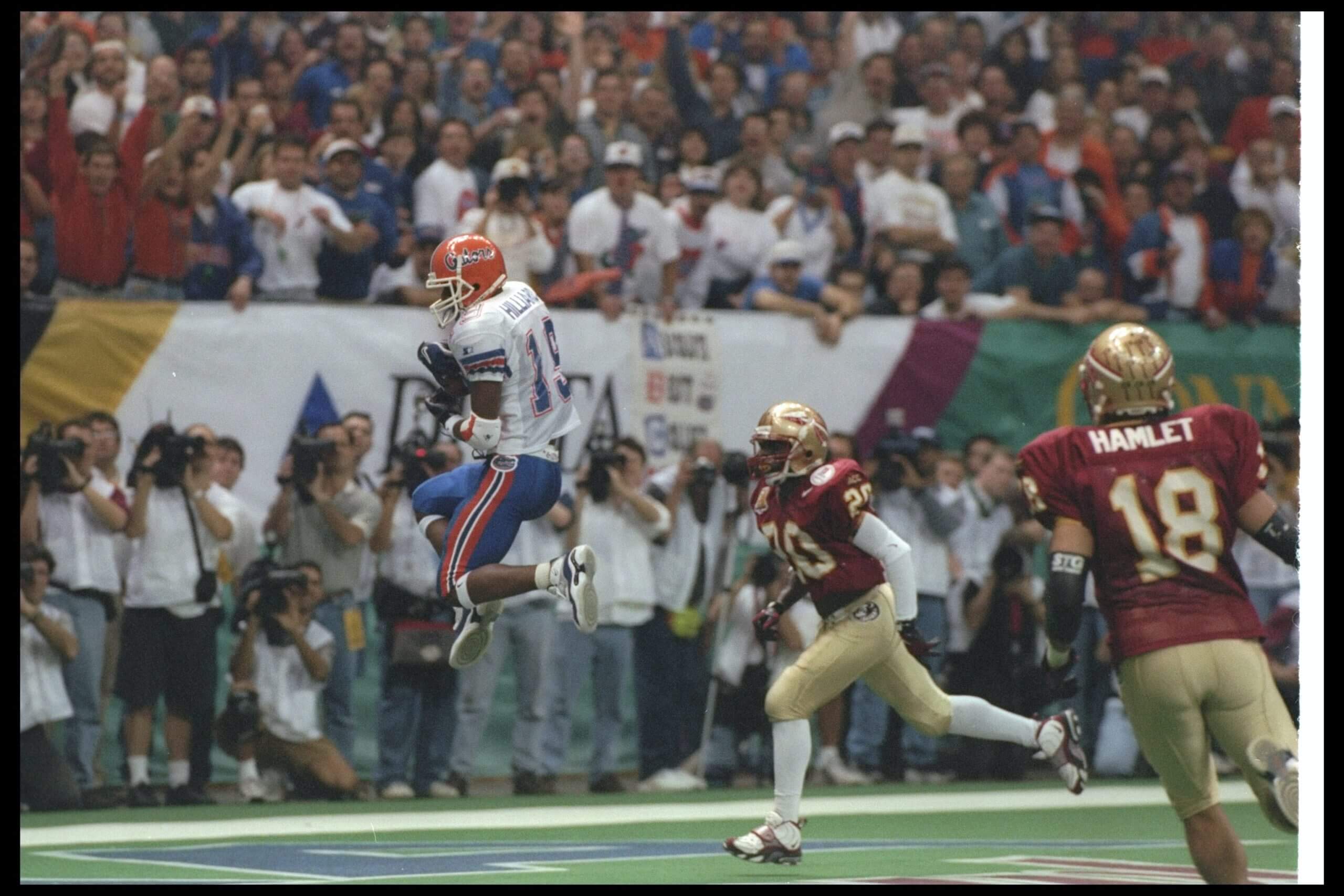

What to know: From the moment Penn State joined the Big Ten in 1993, this competition has vaulted into the league’s No. 2 annual game. Although the Nittany Lions revel in their “Unrivaled” moniker, this series is the epitome of a rivalry. It features two border-state programs that see themselves as national title contenders, which creates organic friction.
- In the series’ 39 games after the AP poll was introduced, both teams were ranked in 25 of their meetings and at least one team was ranked in 12 others. Ohio State holds an 18-7 advantage in ranked matchups.
- Perhaps most astounding, both teams have been ranked in the top 10 in 12 games — or 30 percent of their contests. Ohio State has won nine of those 12 games.
- This is the only series either team has played every season from Penn State’s inaugural Big Ten campaign. They were paired in the Nittany Lions’ first two years, then designated as protected foes from 1995-2010. From 2011-23, they were placed in the Leaders Division, then the Big Ten East. They no longer are considered annual opponents and the series rotates off their schedules in 2026.
Biggest game: In a 2017 showdown in Columbus that decided the Big Ten East title, No. 2 Penn State and RB Saquon Barkley led No. 6 Ohio State 35-20 with under 11 minutes left. In the fourth quarter, Buckeyes QB J.T. Barrett completed all 13 passes for 170 yards and three TDs in a shocking 39-38 comeback.
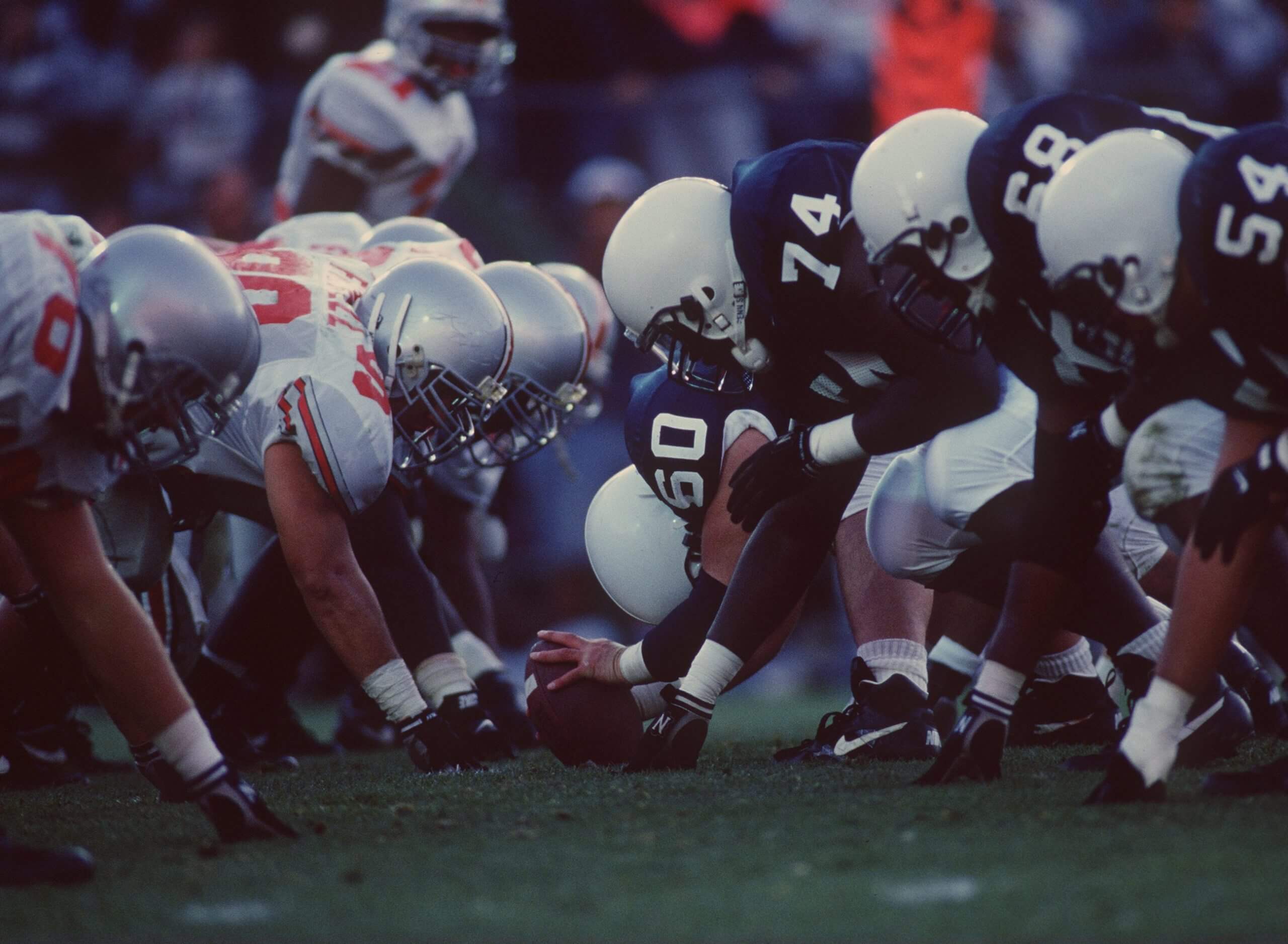

What to know: FSU-Miami became college football’s must-see event just as TV networks were allowed to show games without restriction in the 1980s. The series dripped with talent and it set the tempo for an entire generation of college football fans. It has somewhat flat-lined over the past two decades, however. They were expected to dominate the ACC when Miami joined in 2004 but have not yet met for the league championship. Still, it remains one of the most competitive rivalries in college football history.
- All seven matchups from 1987-93 were top-10 battles and four were in the top five. From 1987-2006, there were 13 top-10 showdowns.
- The Hurricanes won five national titles from 1983-2001 while the Seminoles claimed championships in 1993, 1999 and 2013. The national champion won the head-to-head battle in each season except 1989, when FSU upset Miami.
- The programs battled as independents until 1991 when the Hurricanes joined the Big East. Florida State entered the ACC a year later. They became conference foes in 2004 when Miami jumped to the ACC.
Biggest game: In a 1991 clash of unbeatens, No. 1 Florida State and No. 2 Miami had winning streaks of 16 and 14 games, respectively, and the winner had the inside track on a national title. The Seminoles led by nine in the fourth quarter before the Hurricanes’ comeback gave them a 17-16 lead. In what has been called “Wide Right I” as the first in a string of dramatic games that came down to kicking problems, Florida State missed a 34-yard field goal with 25 seconds left to hand the game — and ultimately the national title — to Miami.
Photo:
Andy Lyons/Allsport
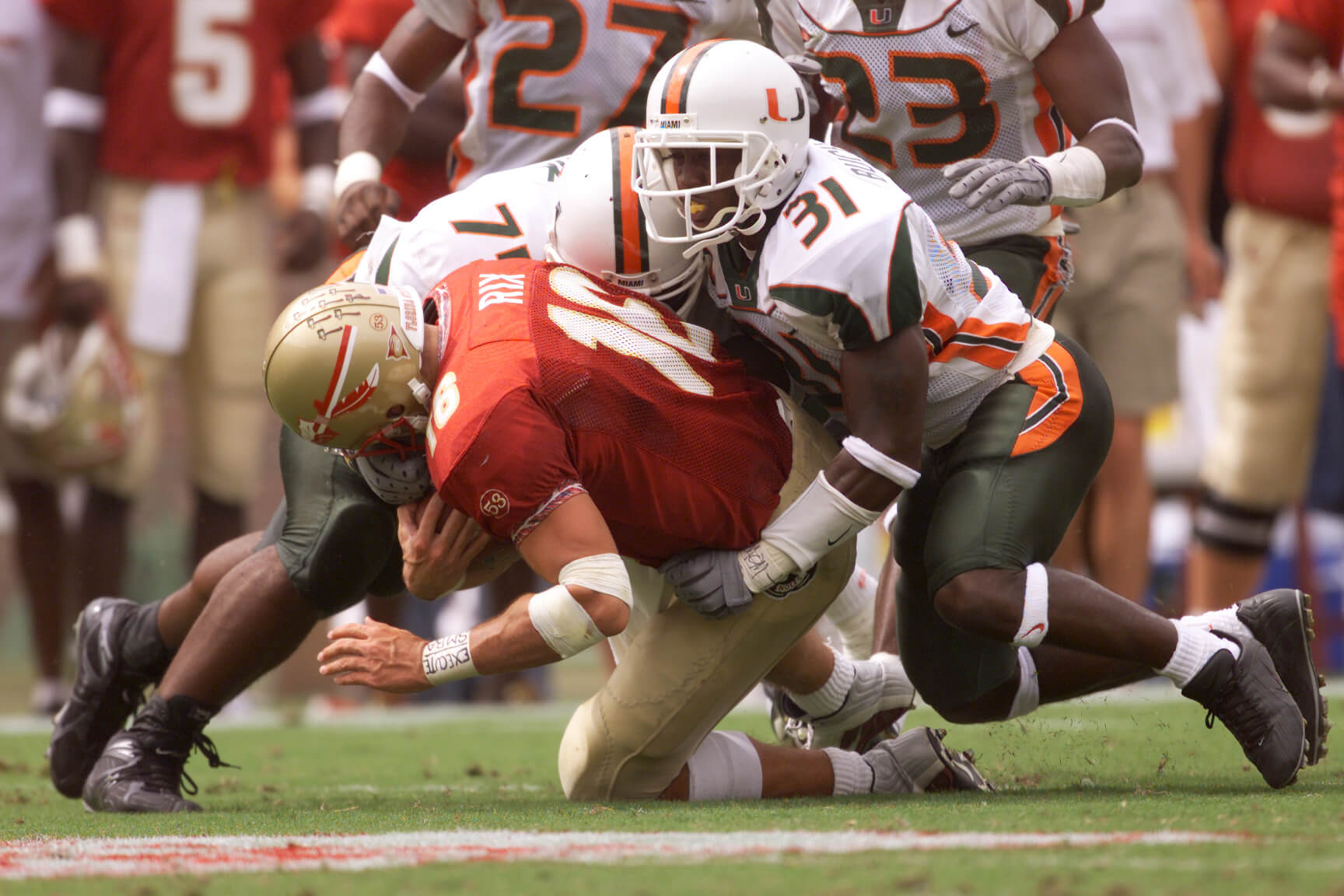

What to know: This was the preeminent rivalry of the Great Plains throughout the 20th century. There was a healthy respect among the programs and fan bases, but the games were spirited and hard-nosed. In conference realignment, Oklahoma-Nebraska became the first major casualty when they split into opposite Big 12 divisions. Then, the Huskers moved to the Big Ten, and the teams have played just twice since the 2010 Big 12 title game.
- Oklahoma and Nebraska have combined for 96 conference titles, and from 1962-95, only twice did neither claim a share of the Big Eight title.
- At least one team was ranked in 63 of their 72 matchups after the AP poll was introduced in 1936. Both teams were ranked 25 times and in the top 10 in 18 games — that includes 16 top-10 matchups from 1971-88, 12 of which were won by the Sooners.
- Five times the Sooners handed the Huskers their only regular-season loss (1964, 1966, 1975, 1979, 1987), while Nebraska gave Oklahoma its only regular-season loss twice (1971, 1978). In 1959, Nebraska upset Oklahoma 25-21 to end the Sooners’ 74-game conference unbeaten streak and 16-game win streak in the rivalry.
Biggest game: The rivals met twice in No. 1 vs. No. 2 battles, and the first was labeled a “Game of the Century.” Of all the games tagged with that moniker, the 1971 matchup in Norman might deserve it the most. No. 1 Nebraska led the nation in total defense, while No. 2 Oklahoma paced the country in total offense. Twice the Huskers built 11-point leads only to have the Sooners rally to retake the lead. Late in the fourth quarter, Nebraska RB Jeff Kinney burst in for his fourth TD of the day to claim a 35-31 Thanksgiving win en route to the national title.
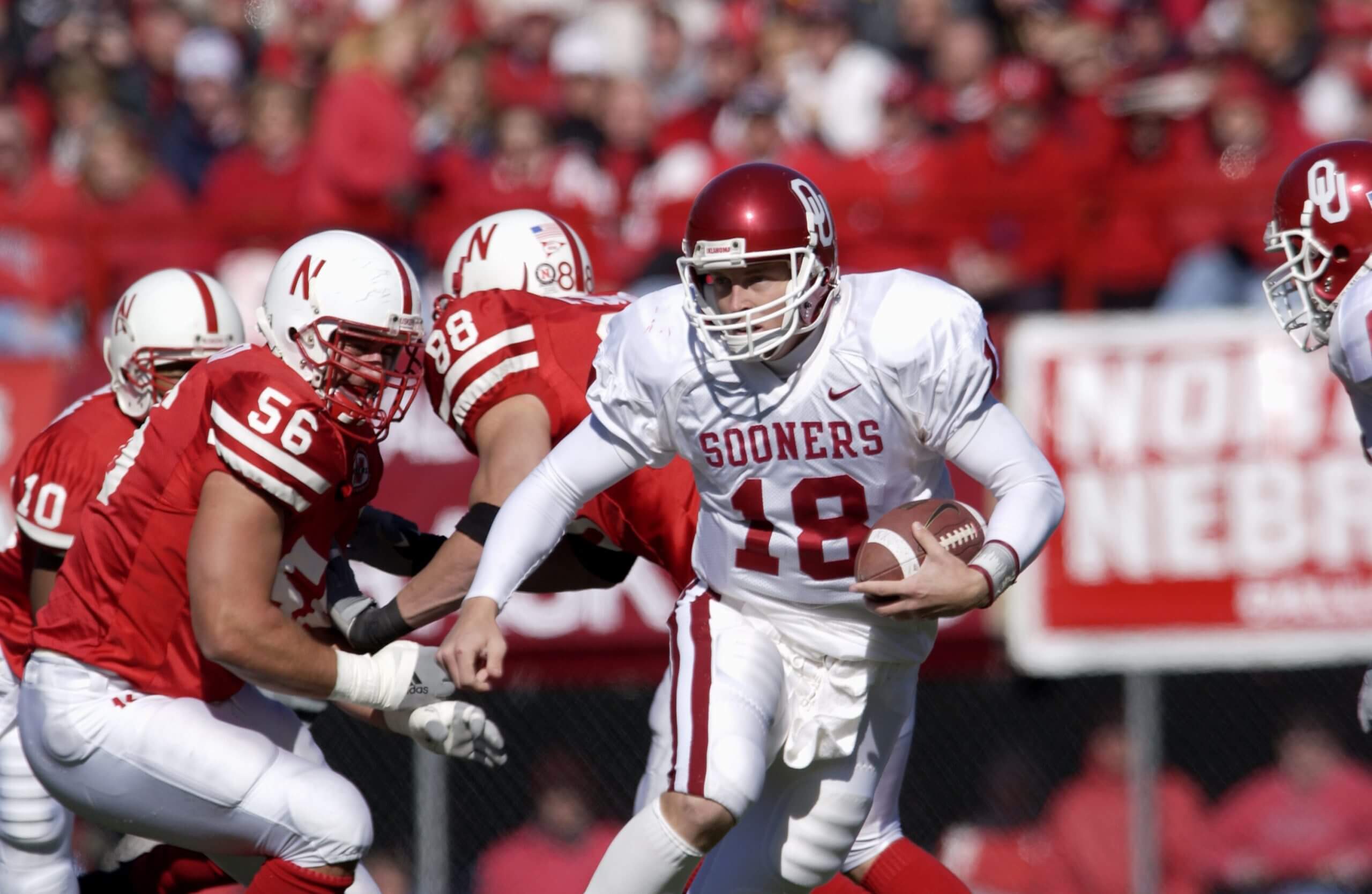

What to know: USC-Notre Dame might seem like an unnatural rivalry, but that’s the biggest reason why it’s listed in the top five. It’s a cross-country trip with no conference allegiance, yet these renowned programs have battled almost yearly for a century.
- Rumors persist about how Notre Dame and USC set up their series, including a conversation between the wives of Irish coach Knute Rockne and USC AD Gwynn Wilson. Originally scheduled as a five-game series, the Trojans and Irish have played every fall outside of World War II (1943-45) and 2020 (COVID-19).
- In 13 games, either the Irish (eight) or Trojans (five) were ranked No. 1. The teams have battled 35 times while ranked in the AP poll (18-15-2 Notre Dame) and faced off 18 times as top-10 foes (10-7-1 USC). The most prominent matchup took place in 1988 when top-ranked Notre Dame beat second-ranked USC 27-10 en route to the national title.
- The teams do not have a contract beyond 2025 and face an uncertain future after USC’s move to the Big Ten.
Biggest game: In 2005, top-ranked USC had won 27 straight games, including the last two national titles, and had beaten No. 9 Notre Dame three consecutive years by 31 points. With hype matching “Game of the Century” environments, the Irish wore green jerseys and led 31-28 inside of two minutes. With seven seconds left and no timeouts, USC QB Matt Leinart attempted a sneak from the Notre Dame 1-yard line and was stood up short of the goal line. Then, star RB Reggie Bush shoved Leinart from behind and into the end zone for a 34-31 win on a play known as “The Bush Push.”
Photo:
Andy Altenburger/Getty
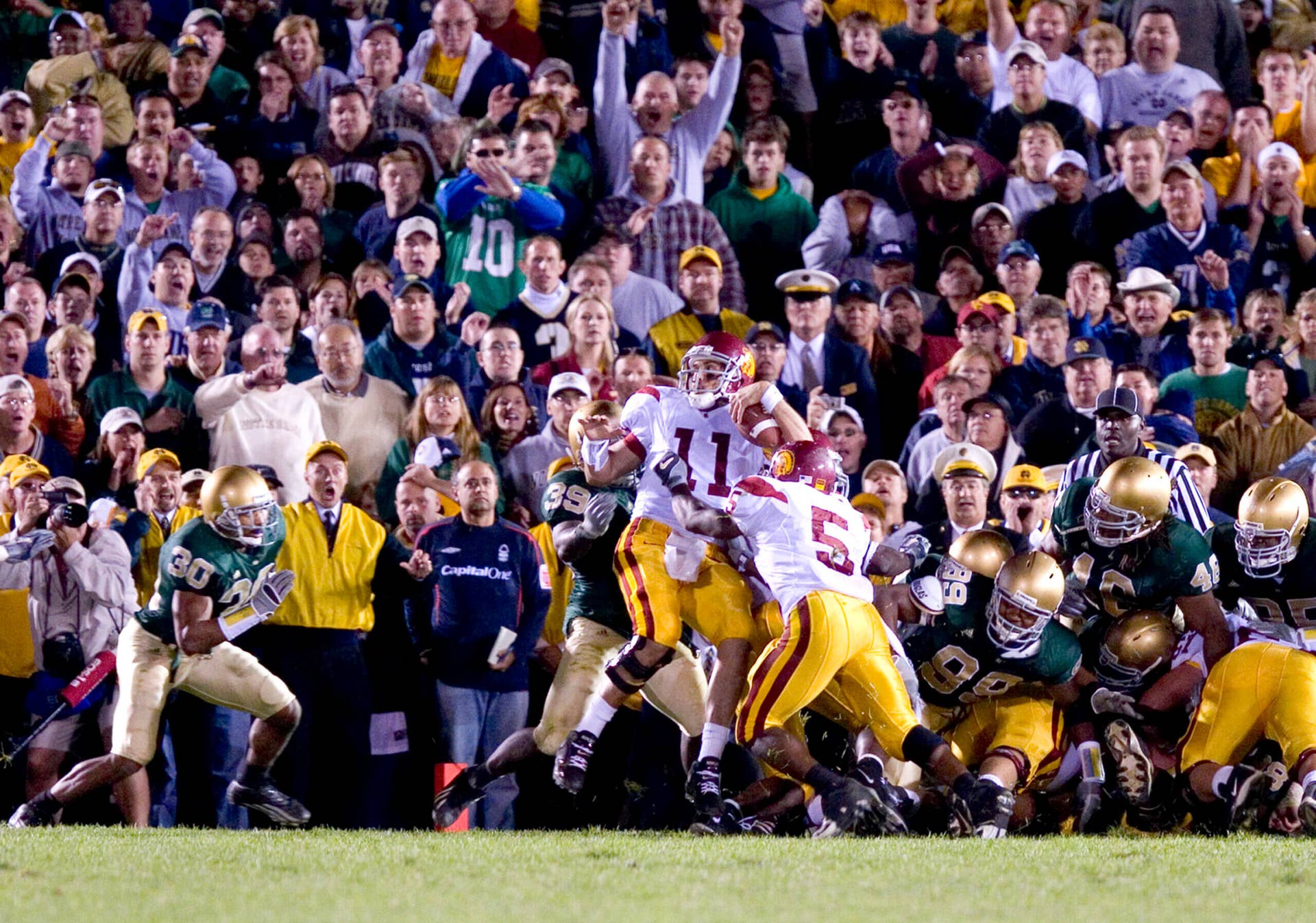

What to know: There’s no sporting event more American than Army-Navy football. Presidents and dignitaries regularly take in the festivities, as do the Cadets in gray and Midshipmen in their dress blue when they “March On” the field. The end-of-game alma maters to “Honor the Fallen” instantly provide goosebumps to millions watching on television. And for the participants, nothing compares to singing the alma mater second.
- This great rivalry has taken place every year since 1930 and has called 10 different cities home over 125 games. Philadelphia has hosted Army-Navy for 90 years. It largely kicks off in the Northeast but Chicago and Pasadena each hosted Army-Navy once. Their home campuses in Annapolis and West Point have held it just seven times.
- A major TV network has aired the Army-Navy game every year since 1945 with CBS taking over in 1996. In all, 63 different men and women have called the game on TV with Gary Danielson (17) leading the way as the analyst. Keith Jackson has served as play-by-play in 10 Army-Navy games, while Tracy Wolfson (six) has the most sideline appearances.
- Army-Navy has been an AP-ranked matchup five times (Navy 3-2) with the most recent in 1957. Twice they met in 1-2 showdowns in 1944-45.
Biggest game: Three months after World War II ended, No. 1 Army and No. 2 Navy battled in 1945 before 102,000 at Philadelphia’s Municipal Stadium. President Harry Truman spent the first half on the Army side and the second with Navy. The game itself was not close. Army took this battle and the national crown from the outset, 32-13, behind Heisman Trophy winner Doc “Mr. Inside” Blanchard’s three TDs. Glenn “Mr. Outside” Davis’ two scores helped propel him to the 1946 Heisman.
Photo:
Damon J. Moritz/Getty
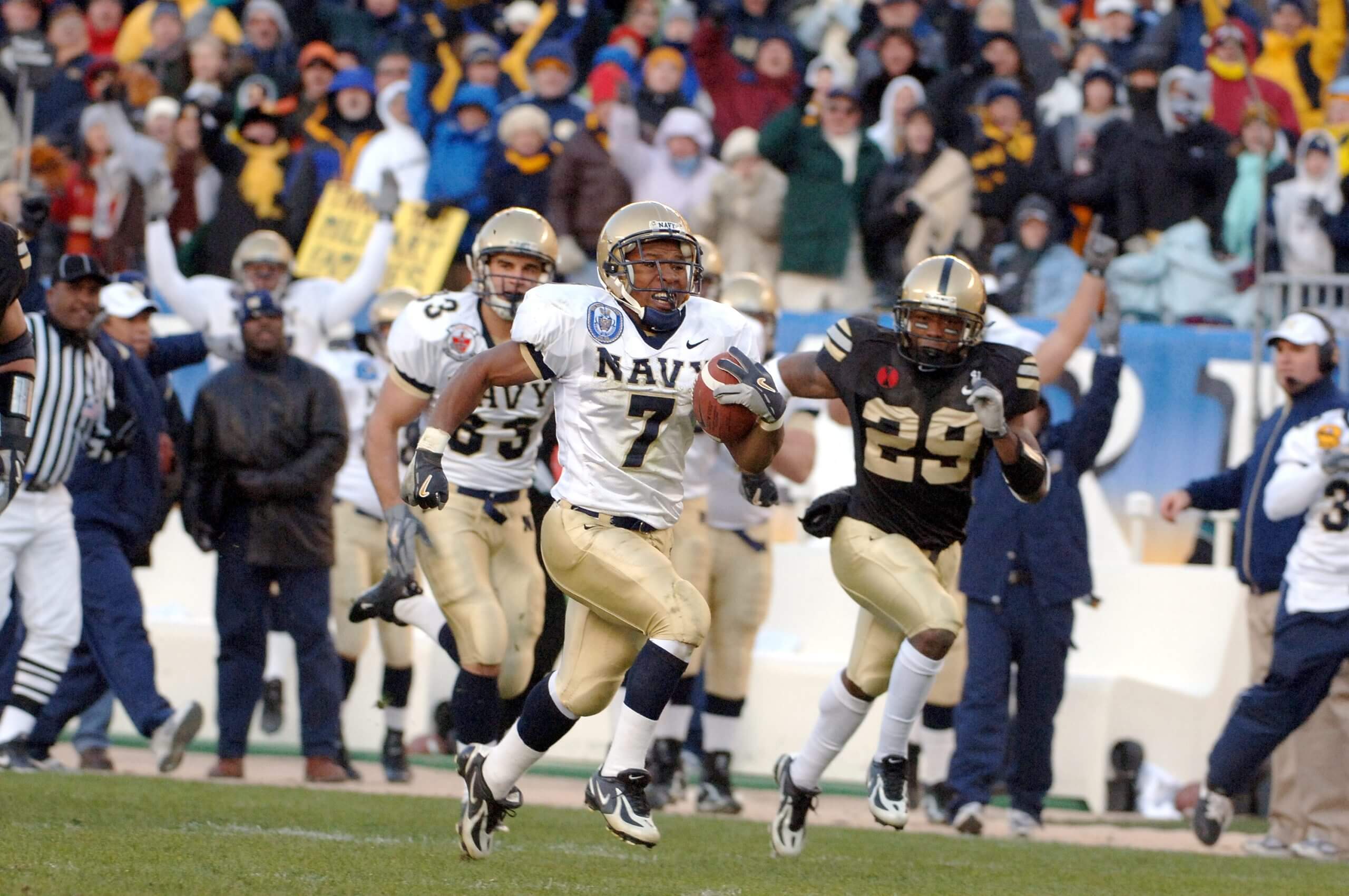

What to know: With two of the nation’s winningest programs, the Oklahoma- Texas result regularly impacts the national title hunt and, for the last three decades, conference titles. They’ve had 10 top-five collisions (Oklahoma leads 5-4-1) in five different decades, and the No. 1 team has played 13 times in this series. “The Red River Rivalry” is a legacy-defining game and often produces unpredictable outcomes.
- Oklahoma-Texas has called the Cotton Bowl in Dallas home since 1932. The seating arrangement splits at the 50-yard line with crimson and burnt orange circling opposite sides of the field.
- Oklahoma-Texas has an unusual trajectory among rivalries. They briefly competed together in the Southwest Conference (1915-19), then battled as nonconference foes from 1920 until their leagues merged into the Big 12 in 1996. In 2024, they joined the SEC together.
- The rivals have played 44 times as AP-ranked foes (Oklahoma 24-17-3) and 17 times as top-10 foes (Oklahoma 9-7-1).
Biggest game: Of their 10 top-five matchups, the 1975 clash at the Cotton Bowl had the biggest national title impact. Texas rallied from a 10-point deficit to tie the score in the fourth quarter, before Oklahoma FB Horace Ivory burst up the middle for a 33-yard TD with 5:31 left to win 24-17. The Sooners finished 11-1 and claimed the AP national championship. Texas finished 10-2 and sixth in the final poll.
Photo:
Ronald Martinez/Getty
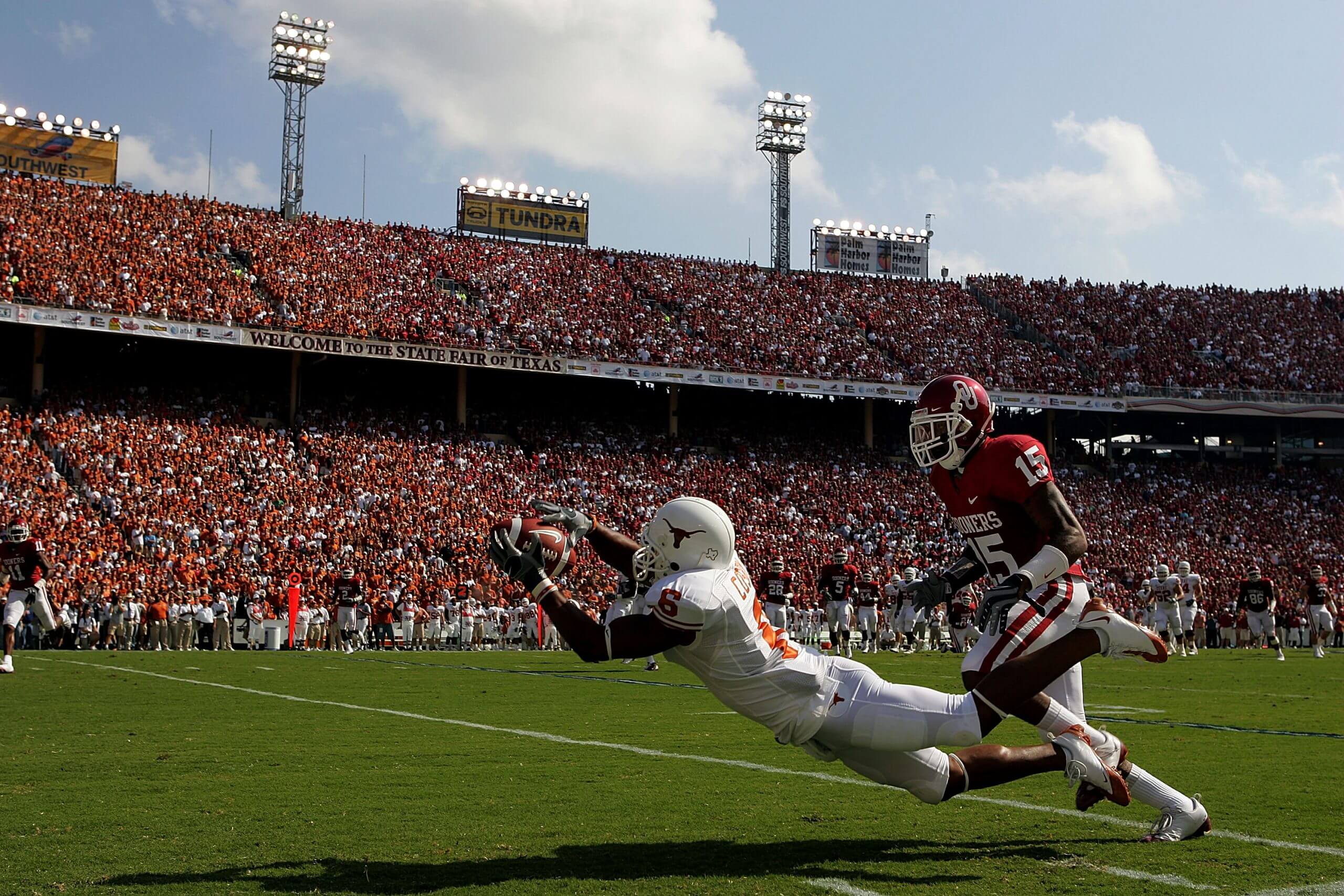

What to know: Every traditional in-state rivalry is filled with emotion. Then there is Auburn-Alabama. No college sports rivalry consumes an entire state like this one. The Iron Bowl permeates nearly every aspect of life in Alabama, and its national impact regularly exceeds its hyper-local importance. That’s why it’s greater than every rivalry save for one.
- The Iron Bowl has produced more legendary moments than any other in-state rivalry. In 1972, Auburn blocked two punts and returned them for touchdowns in the fourth quarter to win 17-16. That’s known as “Punt, Bama, Punt.” In 2010, Auburn QB Cam Newton led the “Camback” from a 24-0 deficit to win 28-27. On fourth-and-goal from the 31-yard line in 2023, Alabama’s Bryce Young completed a TD pass to Isaiah Bond on a play called “Grave Digger.”
- The schools broke off relations from one another after their 1907 game and didn’t meet again in football until 1948. The Alabama state senate threatened to reduce appropriations to both universities if they didn’t restore the football series. They now have played 77 straight years.
- The schools have 24 ranked meetings (Auburn 14-10), including eight in the top 10 (5-3 Auburn).
Biggest game: With a spot in the SEC championship at stake in 2013, No. 1 Alabama traveled to No. 4 Auburn. With the score tied at 28-28, Alabama kicker Adam Griffith attempted a 57-yard field goal on the game’s final snap. It was short and Auburn’s Chris Davis caught it in the end zone. Davis darted up the middle, then bent to the left. He raced up the sideline for the game-winning touchdown in a 34-28 win. Perhaps the greatest play in college football history, it’s forever known as the “Kick Six.”
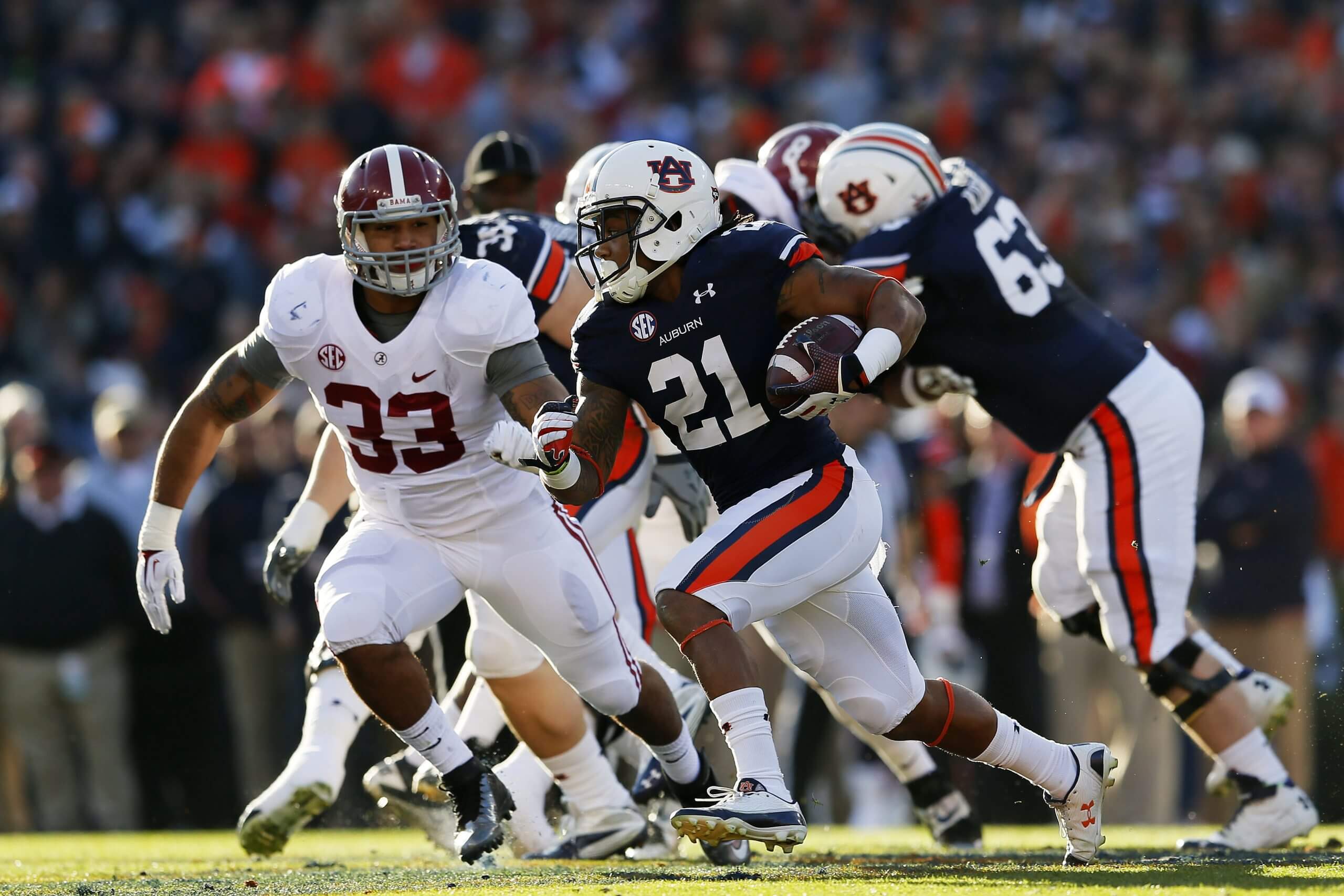

What to know: Arguably, Michigan-Ohio State football is the greatest rivalry in American sports. It unquestionably holds that status in college athletics. Their co-dependence deepens the intensity, both in victory and in defeat. There’s history from the territorial conflict over Toledo in 1835-36 that led to Ohioans referring to Michiganders as “Wolverines.” There’s proximity, prominence, moments, stakes, frequency and longevity. There is nothing like it.
- One cannot name every great moment in this series, but there’s the 10-year war (1969-78) between Woody Hayes and Bo Schembechler, the 1950 Snow Bowl, the Buckeyes losing four years in a row while ranked No. 2 (2021-24) and Hayes going for a 2-point conversion while up 48-14 in 1968. Then there’s “The Spot” in 2016, flag-planting in 2024 and “Tiebreaker” in 1973. That’s just a start.
- No teams have engaged in as many ranked matchups (49), top-10 clashes (26) or top-5 showdowns (13). Michigan owns a 23-22-4 advantage in ranked duels, the teams are tied in top-10 showdowns (12-12-2) and Ohio State has the edge in top-five (7-5-1) matchups. At least one team has been ranked in 79 of 88 games since the AP poll debuted in 1936.
- The teams have met in the regular-season finale every year since 1943, save for 2020 when Michigan’s high COVID-19 numbers forced a cancellation. Michigan-Ohio State has aired 68 times on TV, including the past 57 seasons.
Biggest game: In the second No. 1 vs. No. 2 battle in Big Ten history, top-ranked Ohio State hosted fellow unbeaten Michigan in the 2006 regular-season finale, and “The Game” exceeded the massive hype. Great players traded blows all game, led by Ohio State’s Heisman-winning QB Troy Smith and Michigan RB Mike Hart. A controversial late hit on third down kept a pivotal Buckeyes’ drive alive, and the Buckeyes held on for a 42-39 legacy-defining win.
Photo:
Gregory Shamus/Getty
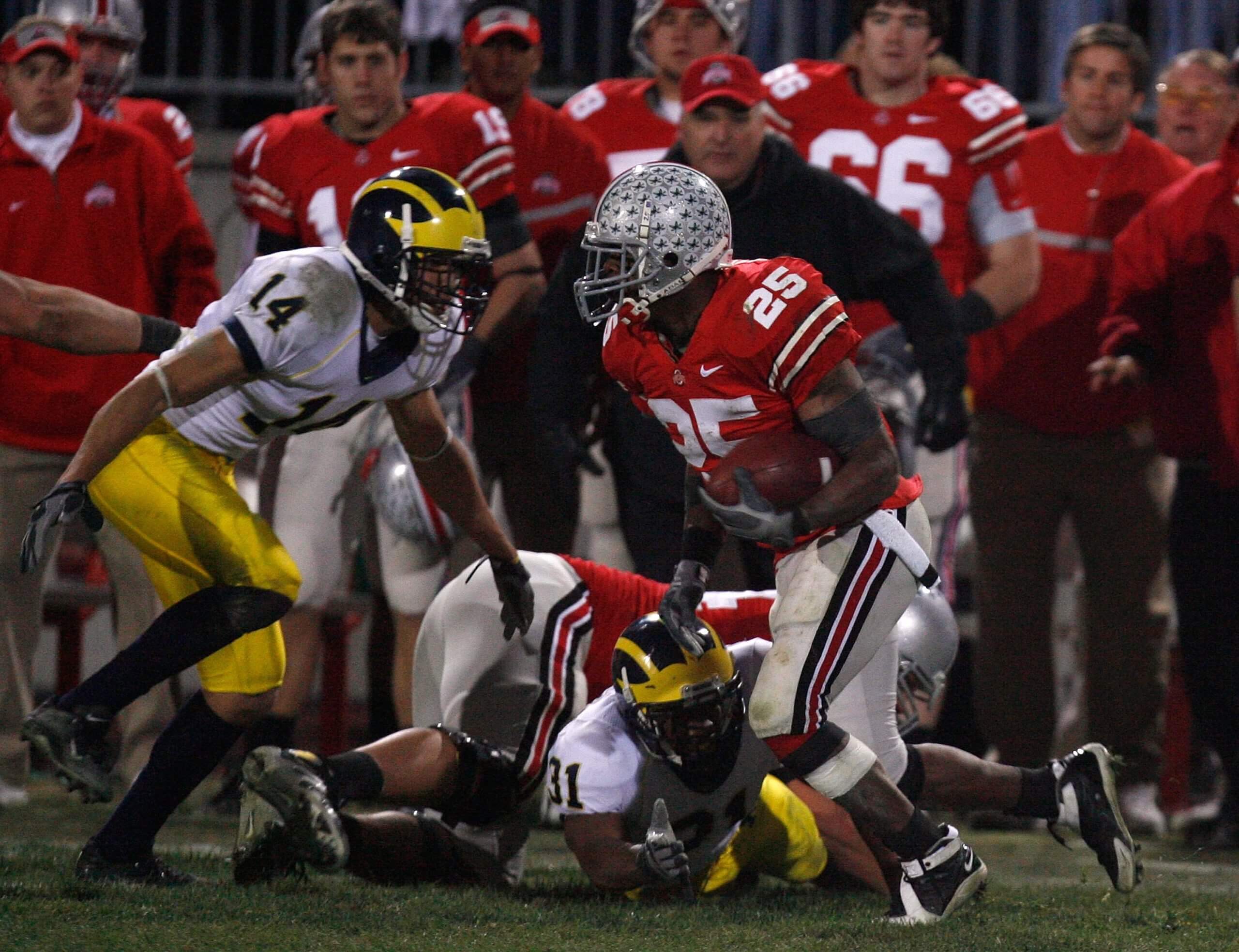

(Illustration: Will Tullos / The Athletic; photos: James Black, Rich Von Biberstein, Barry Chin, Richard W. Rodriguez, Brandon Sumrall, Damien Strohmeyer / Getty Images)
